Travel Europe on a Budget
The Savvy Backpacker

City Guides .\33 a132798-3f3b-4585-954d-7e70cf863447{fill:#231f20}
Ultralight travel packing list — carry on packing guide.
Tips and advice for how to pack for ultralight one-bag travel.
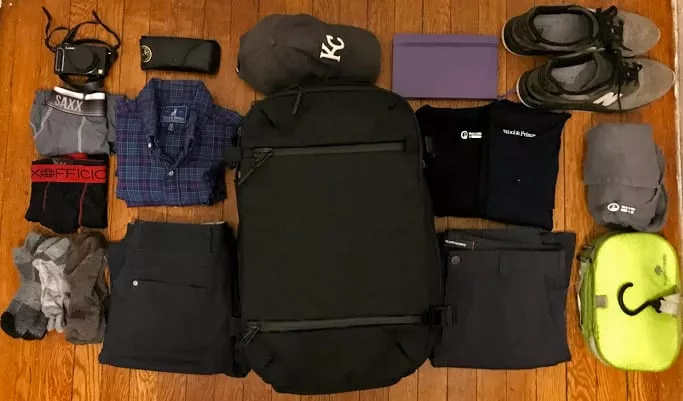
We love traveling light.
But ultralight travel takes it to the next level by limiting yourself packing everything into a small carry-on size backpack. It requires discipline. It forces you to be smart about what you pack. But it’s also one of the most freeing ways to travel.
In this guide, we’ll tell you everything you need to know about truly traveling light and we’ll talk about our favorite clothing and gear that’s perfectly suited for one bag travel.
Ultralight Travel Guidelines
- One Bag: You only need one carry-on sized backpack. 45L is the max size that most budget airlines will allow but experienced one-baggers opt for around 22L-40L.
- Keep Weight Down: 22lbs (10kg) is the max carry-on weight for most budget airlines. However, 22lbs is kind of heavy for a small backpack so we suggest keeping your load to around 15lbs.
- Be Picky: Everything you bring should be used multiple times. If you think you might use something then you probably don’t need it.
- Neutral Color Clothes : Every piece of clothing should look good when paired with any other piece of clothing. Essentially, you should be able to get dressed in the dark.
- High Tech Fabrics: High-tech fabrics (both natural and synthetic) let you wear your clothes longer without needing to be washed. This is essential for ultralight travel.
- Backpack Size Does NOT Equal Trip Size: Remember, you can wash your clothes as you travel. So packing for five days is really no different than packing for 30.
- Fewer Better Items: Quality over quantity is the name of the game. Choose fewer high-quality items over multiple cheap things.
The golden rule of ultralight travel is only using one backpack. And we’re not talking a huge hiking backpack. We’re talking a small backpack that’s carry-on size.
The maximum carry-on sized backpack seems to about 45L — but we’re talking about ultralight travel so we’ll focus on traveling with 20L-35L backpacks.
Remember, the smaller the bag the more you force yourself to pack light.
What we love about small backpacks:
- Never pay checked luggage fees.
- Never worry about airlines losing your luggage.
- Never have to wait for your bags at baggage claim.
- Easily navigate train, bus, and plane aisles.
- Easily walk through crowded streets and busy train stations.
- Easily store your bags above your seat on trains (so you don’t lose sight of them).
- Handsfree travel.
- Fast and nimble travel so you can hit the ground running
- Navigate stairs with ease.
- You don’t look like a tourist (well, you at least blend in better)
- Less weight = happy back.
Backpacks We Recommend
One bag travel has exploded over the past few years so there are now a handful of great travel backpacks built specifically for ultralight urban travel. We’ve listed the best backpacks below (in no particular order) — each has its own pros and cons so take a little time researching which features are most important to you.
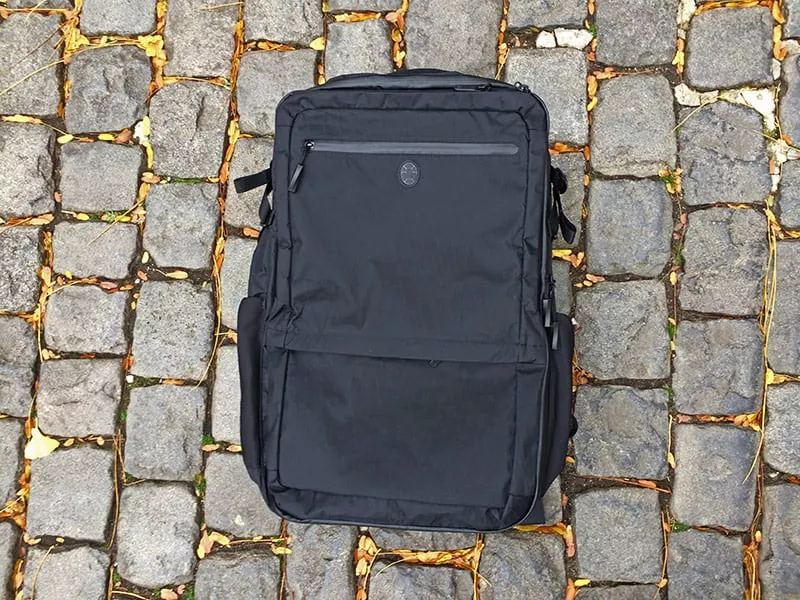
Tortuga has two backpacks we really like — the Outbreaker 35L ($269) and the Setout 45L ($199).
The Outbreaker 35L is a heavy-duty and full-featured bag with plenty of storage/organization options. It’s a little boxy but it’s sleek-ish and has minimal branding. It has thick padded shoulder straps and a hip belt so it’s comfortable to wear. The material is also waterproof. But all these features add to the weight (4.6lbs.) and it’s a little expensive ($269).
Note: See our Outbreaker Review
The Setout 45L is a bit bigger than the Outbreaker and it’s designed as a “maximum-sized carry on for city travelers” — which means it’s as big as possible without going over the carry-on size limit. It’s basically a more scaled-back version of the Outbreaker so it has thinner shoulder and hip belt padding, fewer organization pockets, and fewer features. It’s also lighter at 3.3lbs and less expensive ($199).
Available from the Tortuga website .
AER Travel Backpack
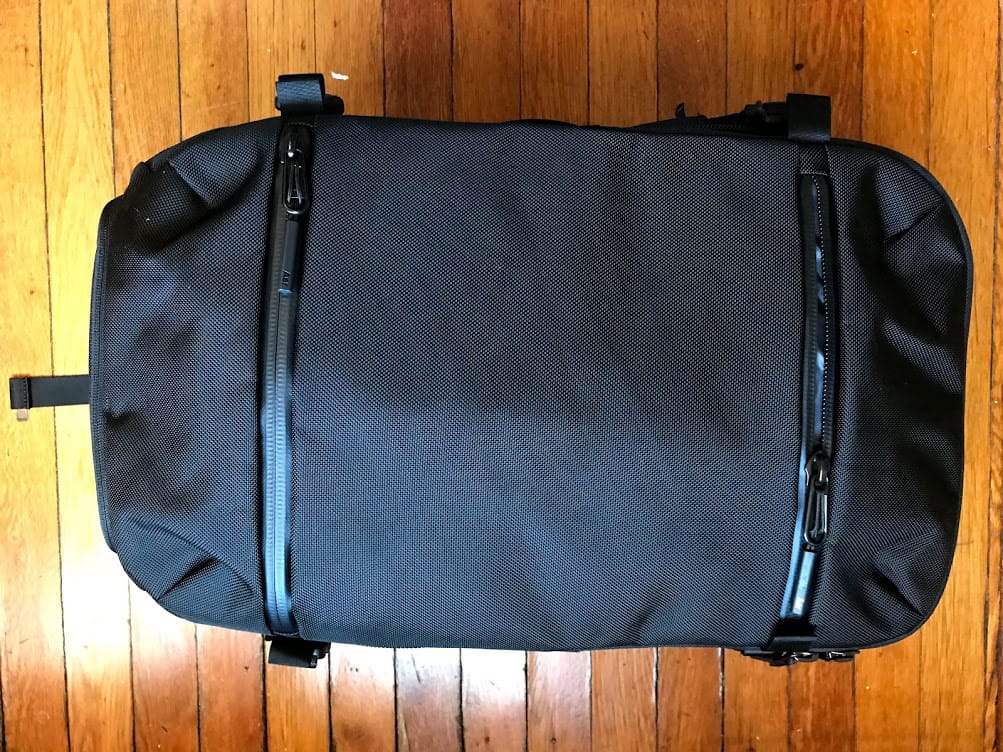
The Aer Travel Backpack is another great option that gets a lot of love from the ultralight travel community. This 33L bag weighs in at 3.7 lbs so it’s big enough to carry your stuff while not being too heavy or bulky. There is a decent amount of padding on the shoulder straps, plenty of pockets to keep your stuff organized, and the bag is made really well.
We also think the bag looks nice and doesn’t immediately scream “tourist!”
Note: See our Aer Travel Backpack Review
The Aer Travel Backpack is $220 from the Aer Website .
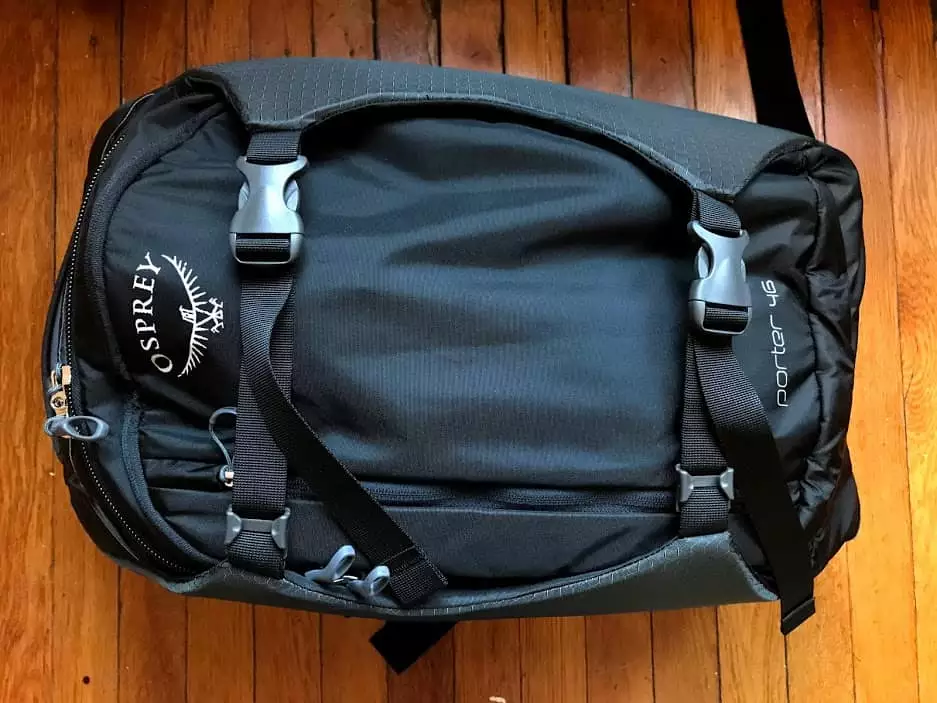
Osprey has been making excellent hiking backpacks for over 40 years and they currently make a few great travel backpacks — namely the Porter and the Farpoint.
The Osprey Porter 30L is a full-featured backpack that weighs in at only 2.8lbs. The shoulder straps have a decent amount of padding and there is a modest hipbelt. It is one of the smaller bags on our list but they also have a 46L version (which is a little large). We like how the Porter doesn’t have any loose straps but it does have a bit of turtle shell shape so it’s not the most “stylish” backpacks (it’s not too bad though).
The Porter 30 costs around $100-$120. Check latest prices on Amazon and Zappos .
The Osprey Farpoint 40L is Osprey’s more robust travel backpack. The shoulder straps and hip belt are comfortable and there is plenty of space for your stuff. Again, the bag isn’t the most stylish but it’s not too bad — especially the black color. The Farpoint 40 weighs 3.1lbs so it’s fairly lightweight. Ohh, and it comes in S/M and M/L sizes so that’s a nice feature.
Note: See our Farpoint 55 Review
The Farpoint 40 costs around $120-$160. Check the latest prices on Amazon and Zappos .
Minaal Carry-On 2.0
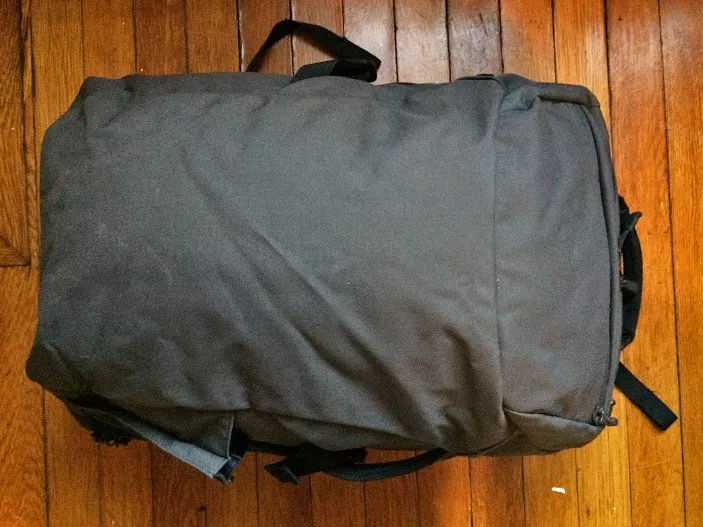
The Minaal Carry-On 2.0 is a sleek and sexy backpack. The material feels really nice and the overall bag is well designed and smartly laid out. In our opinion, it’s the best looking backpack but it’s also expensive at $300.
We’d say that the Minaal is truly geared toward ultralight travelers. Minaal doesn’t list its liter size but its dimensions are LxWxH: 55cm x 35cm x 20cm (fully packed) / 21.6in x 13.7in x 7.87in. Basically, you’re forced to be picky about what you pack (but that’s the whole point about ultralight travel).
The straps have modest padding but they’re comfortable. Plus, the shoulder straps have load-lifters, which is rare in smaller backpacks. There isn’t a hipbelt but you don’t need it since you’re forced to pack light. It has a separate laptop compartment which is super helpful at airport security. The Minaal Carry-On 2.0 only weights 3.12lbs so it’s one of the lightest bags on our list.
Available from the Minaal website
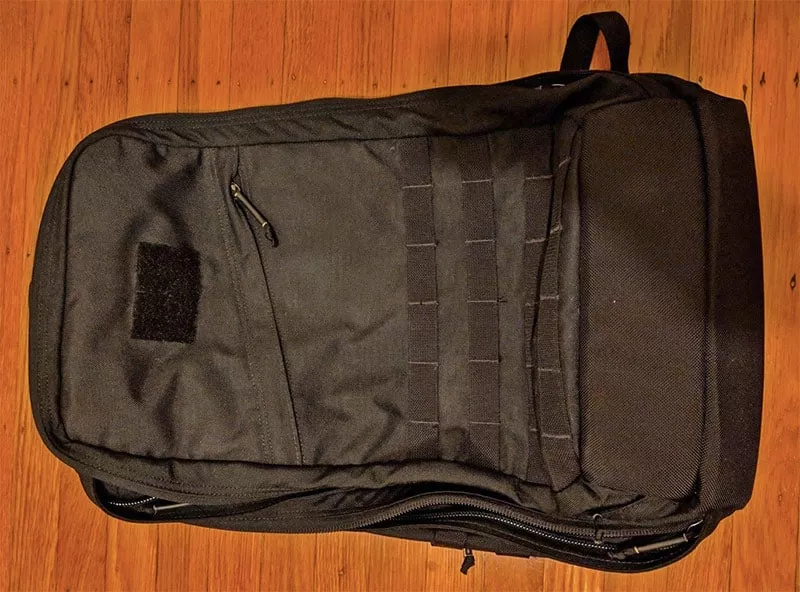
GORUCK backpacks have created a cult following — and rightfully so. Their bags are built in the USA and they’re crazy tough… like literally battle-tested by the US Special Forces tough. It’s basically a backpack that should last forever (it even has a lifetime warranty). On the other hand, they’re also expensive and relatively heavy.
First, we have the GR1 — which comes in 21L and 26L versions. They both cost $295. The 21L bag weighs in at 3.2lbs. We love the minimalist/military/industrial/badass look. Again, this is a compact big bag so you’ll need to fully subscribe to the ultralight travel philosophy.
The GR2 is a bigger version of the GR1 and it comes in a 34L and 40L version. Personally, we think the 34L is just about the perfect size for ultralight travel (the 40L is too bulky and heavy unless you’re a really tall dude/lady). The GR2 has plenty of pockets and it’s big enough to carry whatever you have. The 34L version is 4.35lbs and costs $395 (whew).
Available from the GORUCK website
Clothing Packing List

The key to packing light is limiting the amount of clothing you bring — which means you need to be smart about what kinds of clothing you choose. That’s why ultralight travelers tend to buy clothes that are specifically designed for travel.
It’s All About The Fabric
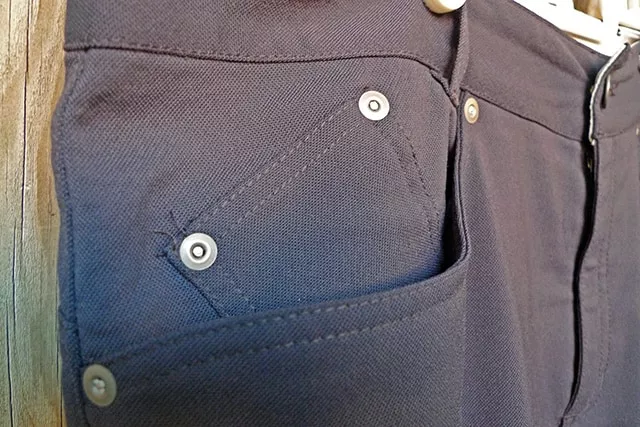
Here’s the deal: you need to limit the number of clothes you bring so that means you have to wear things multiple times before washing — which is why you need fabrics that won’t smell.
The two best fabrics for multi-day wear are merino wool and synthetic high-tech performance fabrics.
Merino Wool naturally blocks odor, dries quickly, moisture-wicking, and is breathable — which makes it an excellent option for underwear, socks, shirts, and base layers. Yes, lightweight merino works well in the summer, and no, it isn’t itchy.
But there are some downsides… Merino Wool is expensive, it requires special washing (washed in cool water and air dry), and it’s not always super durable.
High-tech synthetic performance fabrics are very durable, breathable/moisture-wicking, and they’re usually more affordable. However, many synthetic fabrics hold on to smells. Luckily, most high-end fabrics have anti-bacterial coatings — which helps prevent smells.
These days you’ll see a lot of Merino Wool/Synthetic blends — which gives the fabric characteristics of both materials.
Quick Note About Travel Clothing
These days there are a number of companies making amazing travel clothing that is both fashionable and functional. These use high tech fabrics (either natural or synthetic) that are durable, have stretch which gives you a greater range of motion, resist odors, dry quickly, resist wrinkles, and some even repel stains and liquids.
However, these clothes tend to be expensive — partially because of the quality fabrics used and partially because most of these companies are small businesses.
That said, we’ll do our best to include more budget-friendly options in this guide because we realize not everyone wants to drop a lot of money on new clothes.
Our Travel Clothing Criteria
We look for a few characteristics when choosing the ideal travel clothes:
- Fashionable: We only buy travel clothes that we’d actually wear anytime — this is mandatory. Cargo pockets? Weird zip-off legs? Plastic feeling? Unflattering cuts? NOPE! Save that for the mountain. We only wear things that would look perfectly normal on the streets of Paris.
- Durable: You’re going to be wearing your clothes a lot so they need to withstand some abuse.
- Odor Resistant: It’s easy to work up a sweat but it’s not always easy to find the time to wash your clothes — which is why odor-resistant fabrics are a must.
- Comfortable: You want to be comfortable while traveling so we look for clothes that are breathable and flexible.
- Quick Drying: You might find yourself washing your clothes in your sink so you want fabrics that will air-dry overnight.
- Neutral Colors: If all your clothes are neutral then everything will match. Plus, dark colors help hide stains.
Underwear: 3-4 Pairs
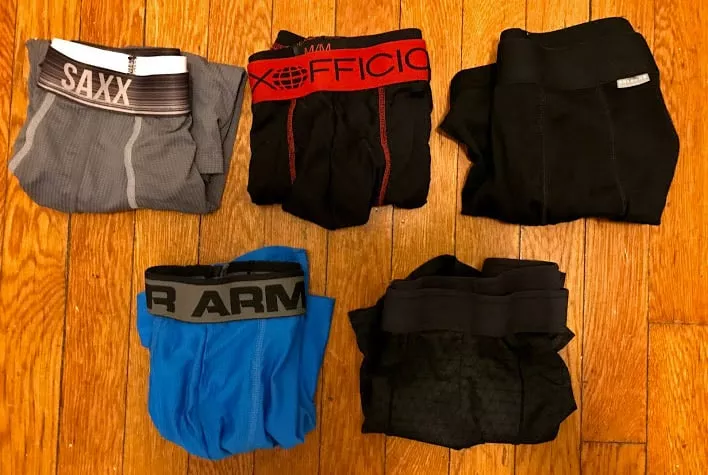
We like to bring three or four pairs of underwear. You can probably get away with two pairs by washing one pair while wearing the other… but underwear takes up virtually no space so we bring a few pairs. You can read more about why we love travel underwear but basically, we love them because they’re quick-drying, moisture-wicking, breathable, odor-blocking, lightweight, and comfortable.
The best travel underwear is either made from special synthetic materials or lightweight merino wool (well, it’s usually a merino/synthetic blend). Synthetic is usually cheaper and more durable but merino has better odor protection but is more expensive.
Our Favorite Travel Underwear
- ExOfficio (Synthetic): ExOfficio is the most popular travel underwear brand — they practically invented travel underwear. We personally have multiple pairs and we wear them even when we’re not traveling. They’re not too terribly expensive — usually around $18/pair (prices fluctuate often). ExOfficio has multiple cuts and styles for both men and women. Available on Amazon and REI
- SAXX (Synthetic): I’ve been wearing SAXX Quest 2.0 for a few months and I’m very impressed. In fact, National Geographic called them the “ultimate travel boxer” (if that means anything). They’re quick-dry, anti-stink, ultra-light, and have a nice pouch in front (that’s SAXX’s thing). They’re normally priced around $30/pair. Available on Amazon or SAXX website .
- Uniqlo Airism (Synthetic): Uniqlo is one of the few large brands that actually make decent high-performance clothing at a low price — normally $10/pair. Their Airism underwear is popular in the travel world because they’re super lightweight (especially the mesh ones), quick-drying, and have anti-microbial/anti-odor properties. I own a few pairs of Airism and they’re pretty good — they’re not super odor resistant and the cut might not be right for everyone. That said, they’re only $10 so there is no harm in trying them out. Available from Uniqlo .
- REI Co-Op Boxer Briefs (Synthetic): REI has their own brand of travel underwear that gets fairly good reviews. They’re normally priced around $22/pair but they’re sometimes on sale for under $15. Available at REI .
- Under Armour (Synthetic): UA is another popular brand that makes a wide range of synthetic underwear that works well for travel. They make various cuts/styles for both men and women and they’re available on Amazon .
- Wool&Prince (Merino/Synthetic Blend): Wool&Prince is a small company that blew up after raising a bunch of cash for merino wool shirts on Kickstarter back in 2013. They now also sell 78% merino wool, 22% nylon boxer briefs that get a lot of love from the ultralight travel community. However, they are expensive at $38/pair. Available at Wool&Prince .
- Wooly (Merino): Wooly is one of the few brands that make a 100% merino wool underwear. They’re also fairly affordable as well. Search on Amazon and you can sometimes find them around $25-$30/pair. However, some people report that they start to develop holes after a few months. Available at Amazon
Socks: 4-5 Pairs
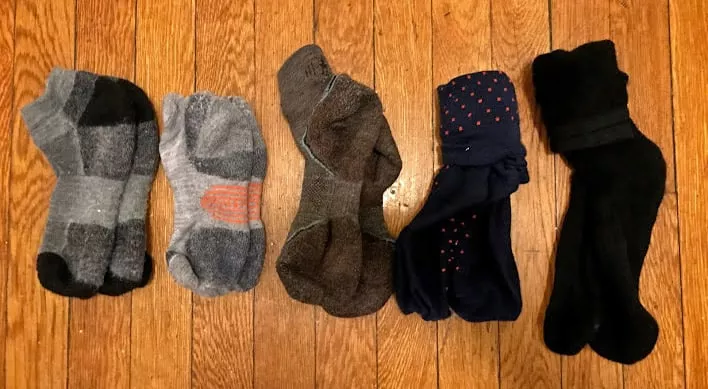
Socks are other things we don’t like to skimp on. Just like underwear, the best socks are either made from special synthetic materials or lightweight merino wool (well, it’s usually a merino/synthetic blend). Synthetic is usually cheaper and more durable but merino has better odor protection but is more expensive. Avoid cotton.
You could probably get away with around three pairs, but we prefer four or five pairs so we don’t have to worry about wearing dirty socks. Then again, I know people who wear a pair for about a week before washing (alternating days between wears).
Pro tip: carry an extra pair of socks during the day and switch them out if your feet start to get sweaty — it’s a great feeling.
Our Favorite Sock Brands
When it comes to socks we tend to stick to a few brands. From there, you pick which weight and cut best fits your travel style. Here is an extensive guide to our favorite travel socks .
Here are some brands to check out:
- Darn Tough Vermont : We love Darn Tough socks (and so do many travelers) — especially since they offer a lifetime warranty. Almost all DT socks are merino/synthetic blend.
- Smartwool: Smartwool is one of the most popular brands of merino wool blend socks. They make a ton of different styles so take a look at the various options.
- Outlier: Outlier makes a pair of really nice merino wool socks (47% Merino) that use super high-quality wool. They are fairly expensive at $25/pair.
- Wigwam : Wigwam is a good quality budget option. Most of their socks are a wool/synthetic blend.
- Thorlo : Thorlo makes quality synthetic blend socks that are very affordable.
- Balega : Balega gets a lot of love — especially because they make quality no-show socks (which is kinda rare). All their socks are synthetic and they’re affordable.
Pants: 1-2 Pairs
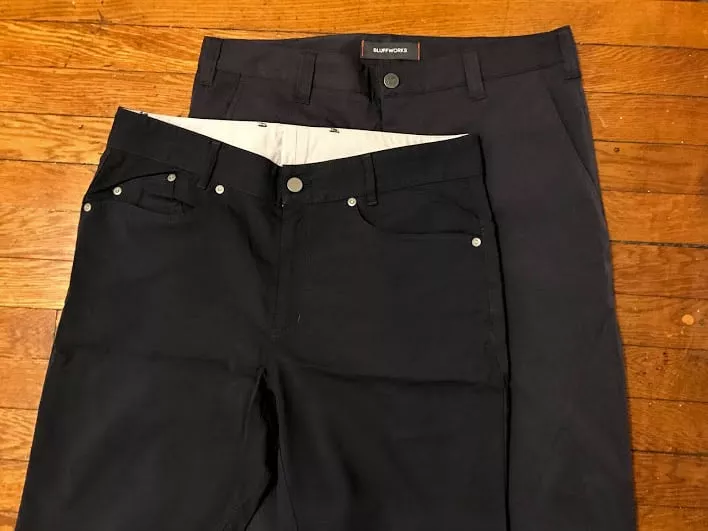
There are plenty of travelers who only bring a single pair of pants. Truth is, you can wear the same pair multiple times and they’re not going to smell. That said, two pairs should be your max.
A high-quality pair of travel pants is a good investment because you want something that is comfortable, stylish, and durable enough to put up with everything you throw at it. Plus, we only buy travel clothes that we’ll also wear after the trip is over so they have to look good.
Synthetic materials are really the only option because they’re light, durable, and dry quickly. Luckily, there are a lot of really solid options when it comes to travel pants… unfortunately, the best ones are expensive.
What’s the difference between expensive and less expensive travel pants? Basically, the top-of-the-line pants look and feel just like normal everyday pants but perform like technical pants. Cheaper pants start looking a lot more “technical” so they’re a lot less fashionable.
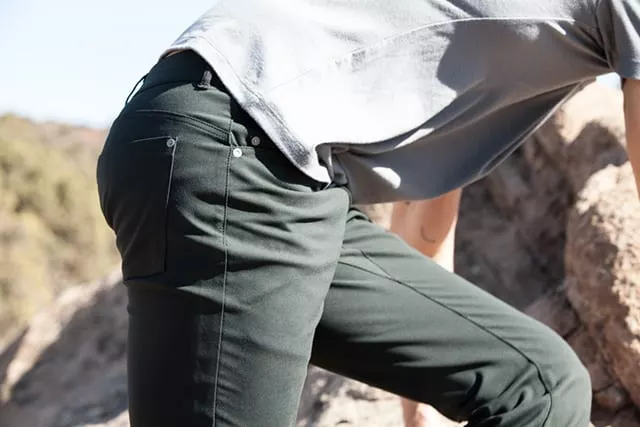
Outlier has really nailed it with their Slim Dungarees — some even say they’re the perfect travel pant. The material is stretchy so it’s comfortable but it’s also super rugged and tough. They’re also breathable, moisture-wicking, quick-drying, and they even have a coating to help them repel liquid. You can basically wear these things for months without needing to wash (plus, they can be machine washed and dried). Ohh, and the fabric feels and looks like normal pants — which is great because everything we wear must pass the “would this look good in Paris” test… and these pass with flying color.
The main downside is the cost — $198 per pair. But, I guess that’s the price you pay for made in USA clothing constructed from high-performance Swiss fabric. And, to be honest, I would have no qualms about packing these as my single pair of pants.
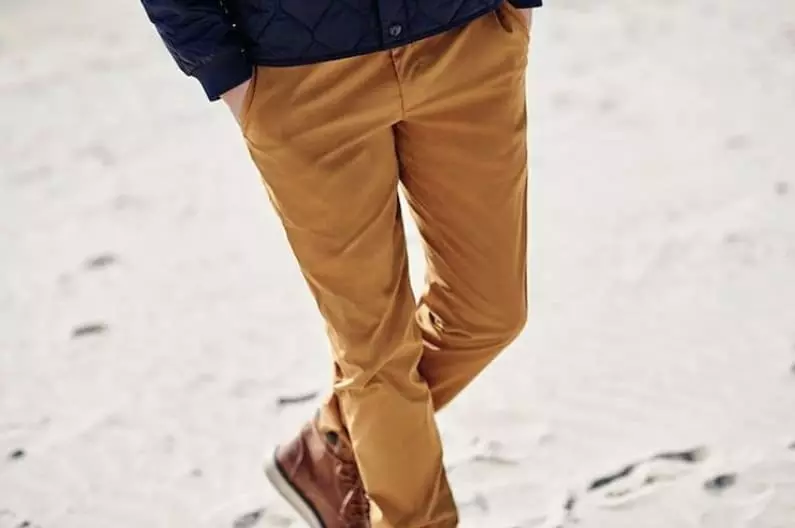
Bluffworks is the other go-to travel clothing company that many travelers really love. They have two main travel pants — the Original ($98) and the Chino ($125). Both pants are super tough, breathable, moisture-wicking, resist wrinkles, and they’re lightweight. The Originals are the most lightweight but the fabric doesn’t stretch and looks a bit more synthetic. The Chinos use a more stretchy fabric that’s softer, more casual, and looks/feels like cotton. Available at Bluffworks
Western Rise
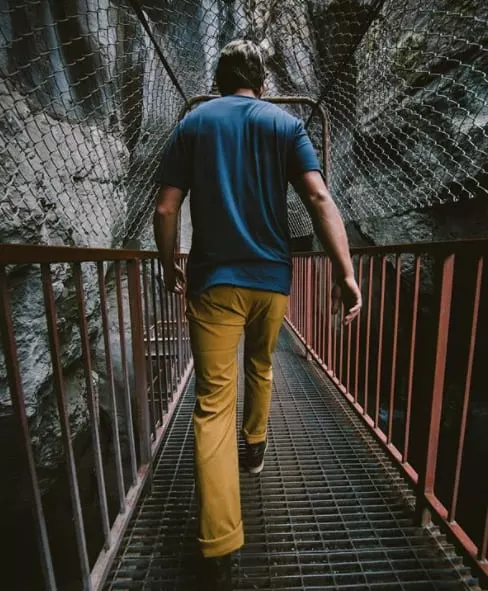
Western Rise is an outdoor-inspired clothing company that makes functional and fashionable clothes that we would describe as “outdoor-chic.” We’re really digging the AT Slim Rivet Pant (available in men’s and women’s). They look like normal slim-fitting pants but they have the benefits of technical fabric. The fabric has a nice structure, texture, durability, and stretch but it does have a slightly synthetic feel (which is virtually unavoidable).
AT Slim Rivet Pant retails for $129 and is available from Western Rise . Click here to get $20 off your first purchase .
Ministry of Supply
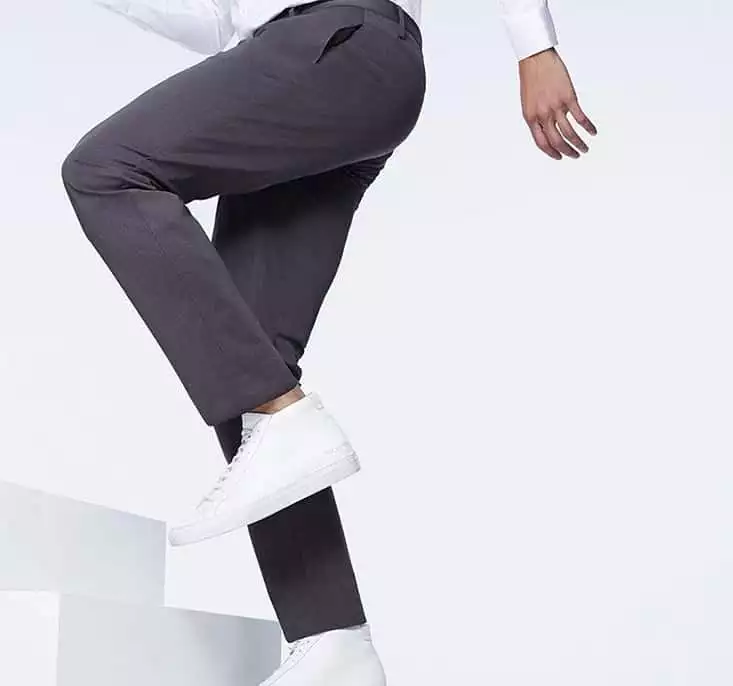
Ministry of Supply makes the most dressy travel clothing we’ve ever seen. Their pants basically look like dress slacks and chinos but the high-performance fabric has stretch, is wrinkle-resistant, wicks moisture, and repels water. These clothes are a little too dressy for our travel style but this is a great option if you need to look extra snazzy.
They offer a few different styles and cuts but they’re all priced around $145. Available at Ministry of Supply .
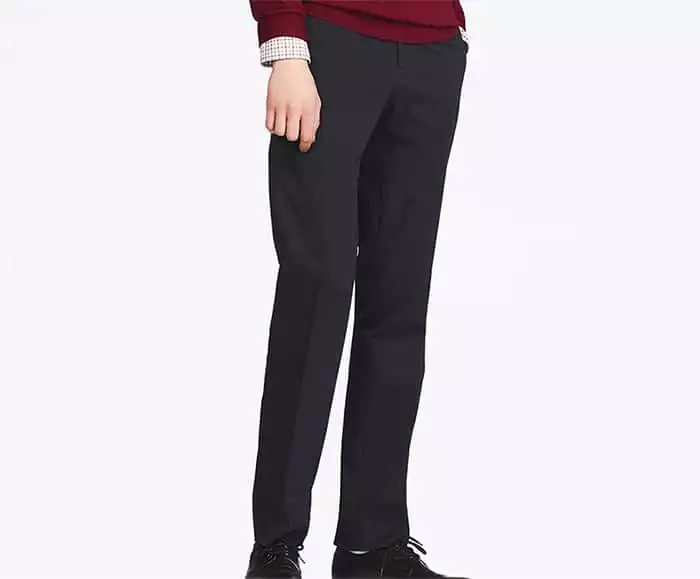
Uniqlo is your go-to place for cheap clothes that are made from high-tech fabrics. Of course, you’re not going to get the same quality from Uniqlo as you will from other brands on this list but we suggest checking out their offerings if you’re on a really tight budget. We also suggest trying on their clothes before buying as we’ve found that sizing can be a little inconsistent.
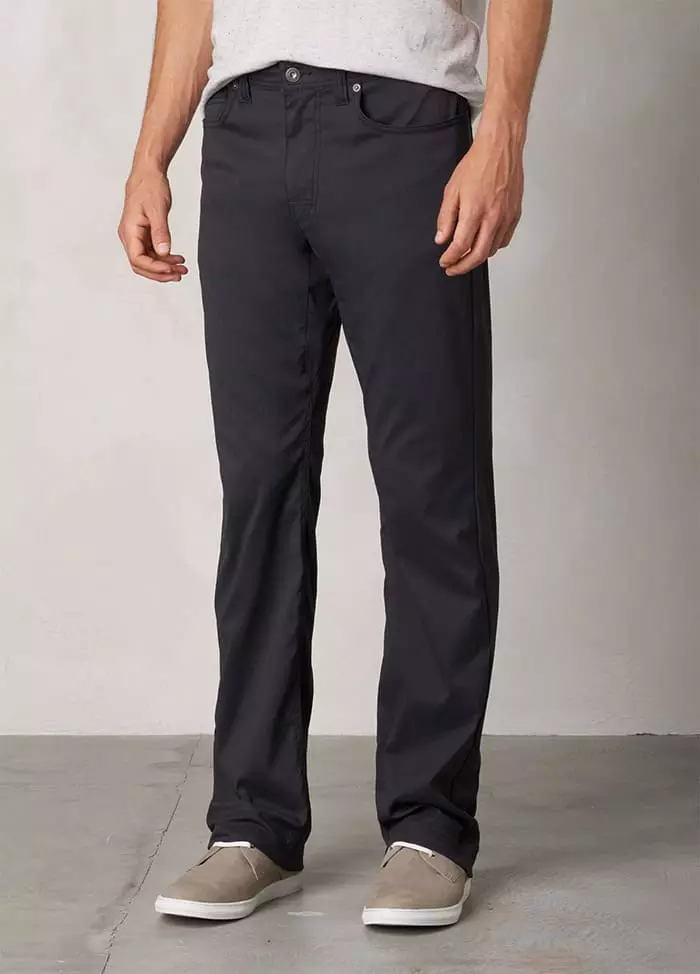
Prana is one of the more fashionable “outdoor” brands and their Brion pants are their most popular item. The fabric is durable, soft, has 4-way stretch, dries quickly, and repels water. Personally, we think the pants are cut a little too wide/loose so they still give off a slight outdoorsy/techy vibe… but you can always get them tailored for $20-$30. They retail at $75 but you can often find them on sale. Available at Prana .
We’re not the biggest fans of jeans for ultralight travel but we still love the look of denim. These Newton Jeans from Rohan are made with a blend of cotton and quick-drying Coolmax polyester. They won’t dry as quickly as other pants on this list but they do dry 30% quicker than normal cotton jeans.
Button Up Shirts: 1-2 Shirts
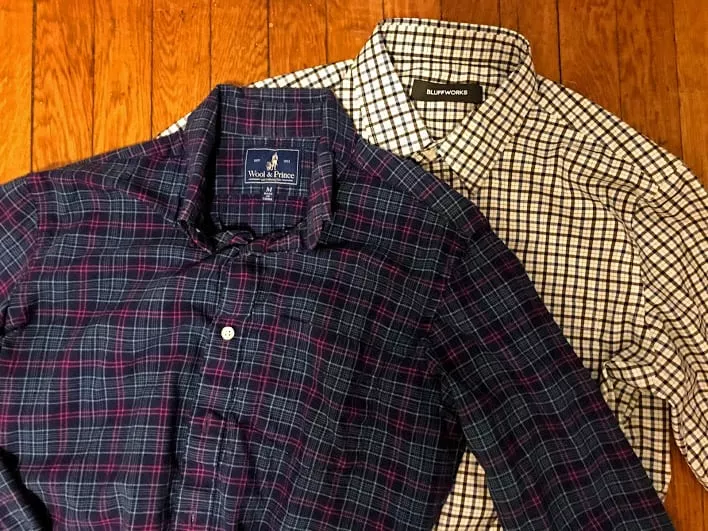
Most ultralight travelers only pack one or possible two long-sleeve button-up shirts. The key is versatility so you want something that looks presentable at a restaurant but is also casual for everyday wear. Button-ups are also nice because you can roll up the sleeves when it’s hot or roll them down when you need more warmth or a more polished look.
Stick with dark fabrics because those hide stains better and wrinkle-resistant fabrics are a big plus. You’re also going to wear your shirt multiple times before washing so merino wool and high-tech synthetic fabrics come in handy here.
Wool & Prince
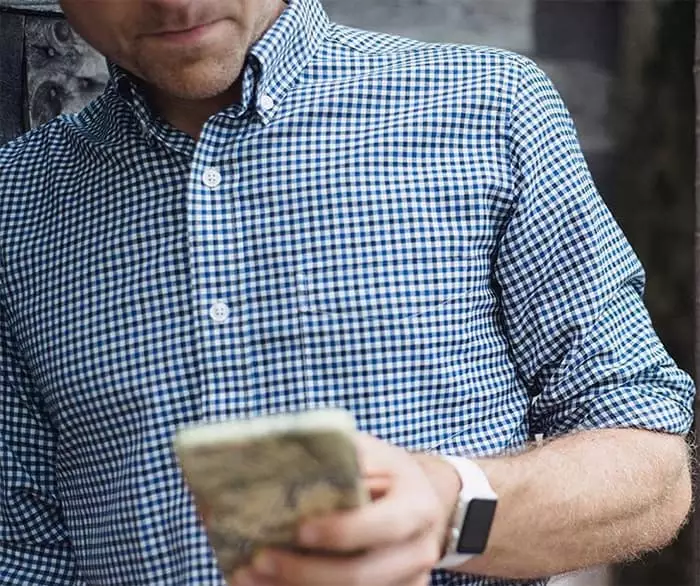
Wool & Prince makes excellent merino wool button-down shirts in multiple colors. As you can see, these are great looking shirts. The fabric feels nice, looks great, is durable, and is fairly soft. I own two and have worn them for multiple days and never had any issues with any odor. In fact, the owner wore his shirt for 100 days without ever cleaning or ironing so you could easily wear this shirt every day of your travels. The only real care instruction is that it can’t be machine dried.
The main downside is the price. Each shirt is $128. But, they should last for years with proper care. Available at Wool & Prince .
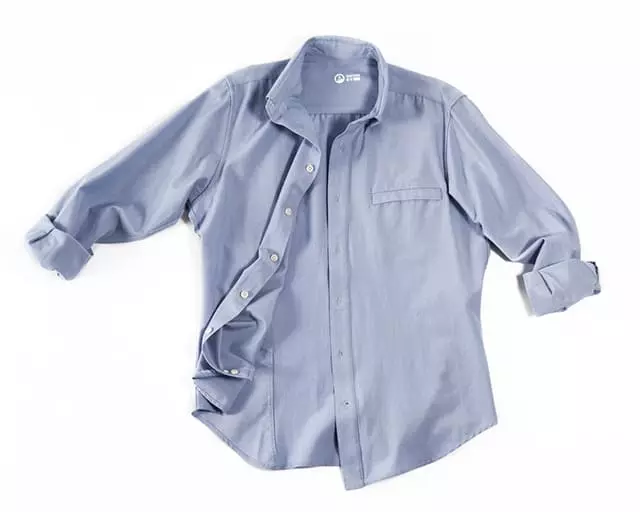
Outlier is our other top choice when it comes to fashionable and functional travel shirts — especially their NYCO Oxford ($120). The NYCO Oxford is 76% cotton, 24% nylon so it breaks our “avoid cotton” rule but I still really like this shirt. It uses a special weave and a special coating that helps repel water surprising well. Like all Outlier gear, it ain’t cheap… but the quality is top-notch. Available at Outlier .
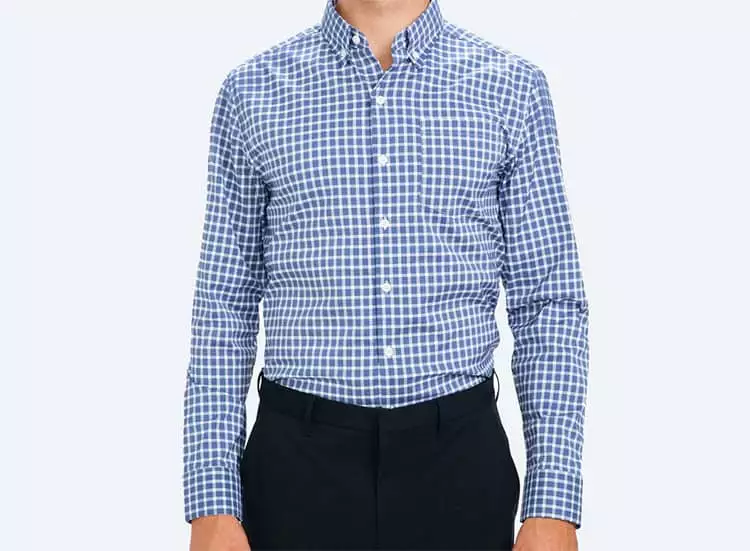
Ministry of Supply is your go-to brand for high-tech dressy travel clothes. Their Apollo 3 Dress Shirt is super breathable and flexible (the fabric was developed by NASA). Plus, the wrinkles fall out after you wear it for about 10 minutes and the shirt is machine washable. Their Aero Button Down is similar but it’s a bit more casual but it’s still certainly “dressy” looking. Both shirts are $115. Available at Ministry of Supply .
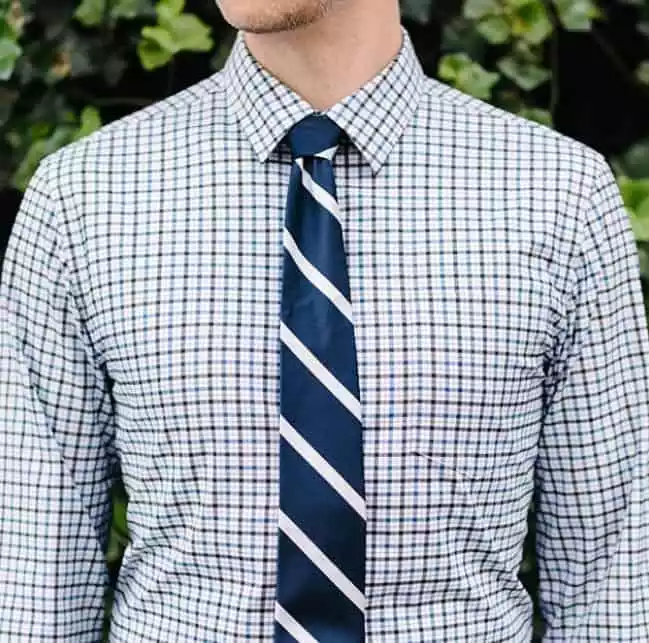
Bluffworks makes a nice looking high-performance shirt that’s super lightweight and breathable. It’s made of two-way stretch synthetic fabric that doesn’t wrinkle and has antibacterial properties. It comes in three different colors and we also like how it comes in both classic and slim fit. We also like how it can be dressed up or worn more casually. Their Meridian shirt costs $125. Available via Bluffworks
T-Shirts: 2-4 Shirts
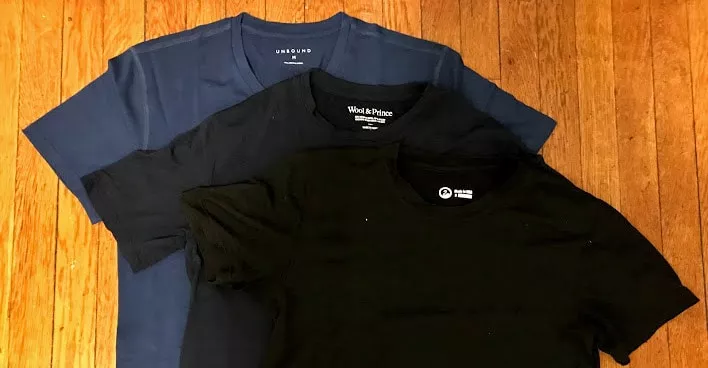
We always travel with a few neutral color t-shirts. You can certainly get by with as little as two t-shirts but we personally prefer to pack three of four. Our top choice is merino wool (or a wool/synthetic blend) because it tends to look a little nicer than synthetic shirts and they last longer before smelling. Plus, it makes a nice base layer in colder temperatures.
The main downside to merino, other than the cost, is the durability. Merino wool tends to be a bit more fragile when it’s lightweight but higher-quality merino tends to be thicker so it holds up better. Adding in a bit of synthetic material really helps with the durability — which is why you’ll see many companies offering a blend.
Again, merino wool shirts are expensive. Many budget travelers will pick up one nice shirt and then bring a few cheaper synthetic options for when they want to give the merino a break.
Also, synthetic isn’t necessarily bad. It dries quickly, can be super breathable (which is amazing during the middle of summer), is durable, and wicks moisture well. Most synthetic fabrics tend to look “synthetic” so they’re not always fashionable but we’ll try to list a few good options. One note: cheap synthetics will hold on to odor (sometimes even after you wash them) and may require a special detergent to get the stink out.
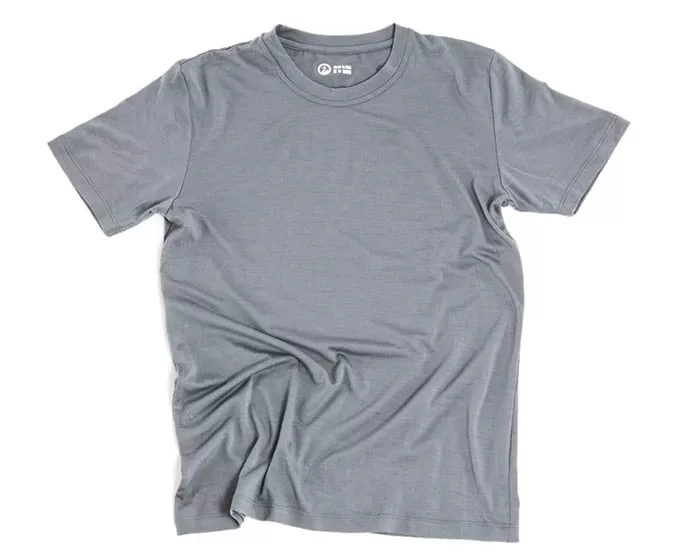
I own two Outlier Ultrafine Merino Wool T-shirts ($110) and they always make it into my backpack when I’m on the road. It’s a nice weight, soft, and constructed really well (mine are three years old and they’re still holding up well). Outlier also has a long-sleeve version ($125). There is also a more lightweight version called the Runweight Merino ($88) that’s s a merino/polyester blend — this is probably better for travel in the dead of summer. But, like everything from Outlier, these are expensive. Available at Outlier .
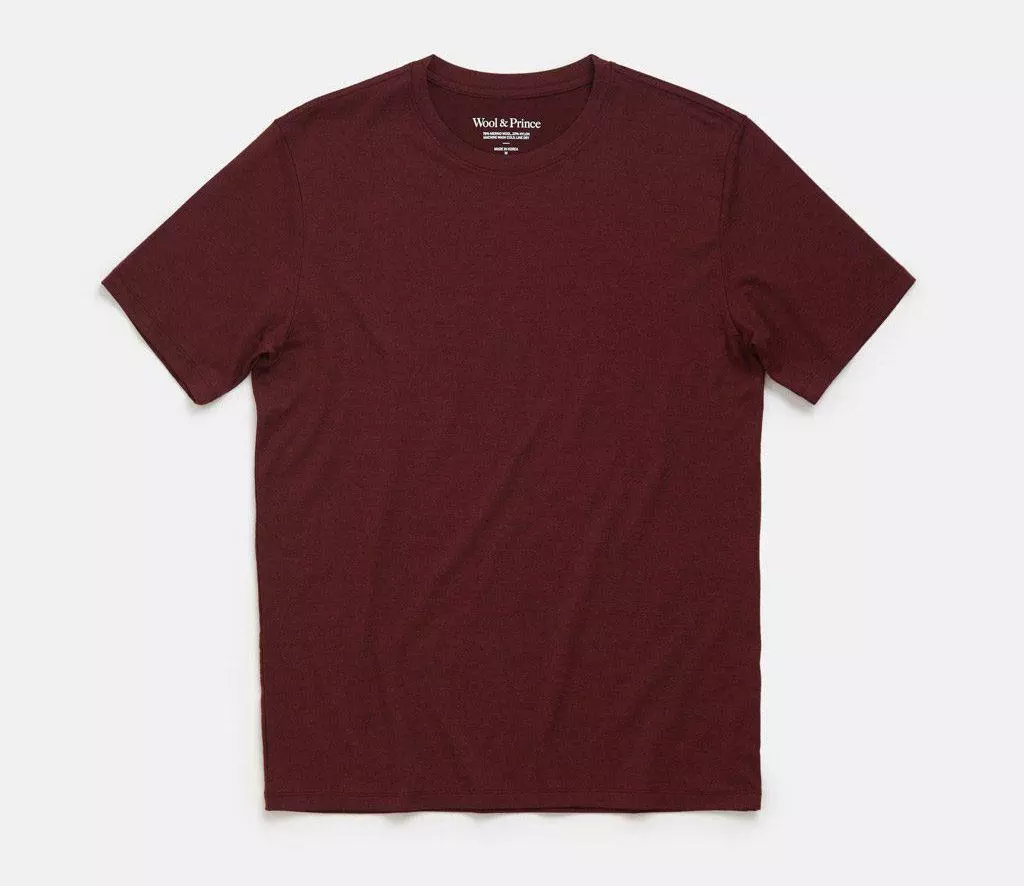
The Wool & Prince Crew Neck is another solid wool/nylon blend t-shirt that we love. Their tees get a lot of praise from the travel community because they’re well-made and they come in a ton of different colors. The short sleeve shirts are $68 and the long sleeve shirts are $84. Available at Wool & Prince .
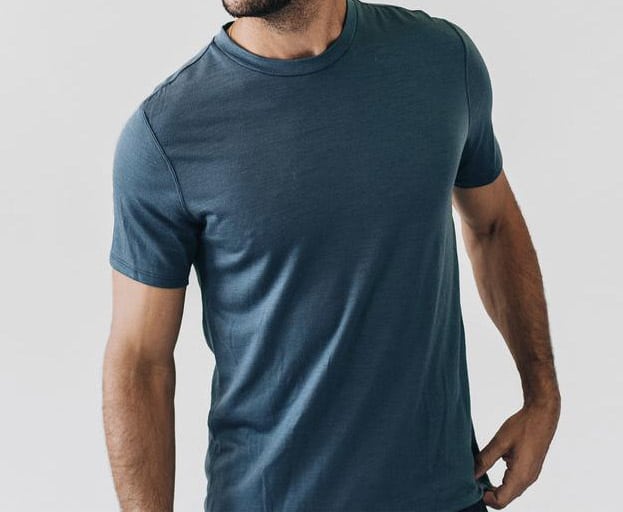
Olivers Convey Tee ($68) is another 100% merino wool option that is popular in the ultralight travel light community. There is also the Olivers Terminal Tech Tee ($68) which is 54% merino, 46% polyester so it’s a little more durable and dries a little quicker. Available at Olivers .
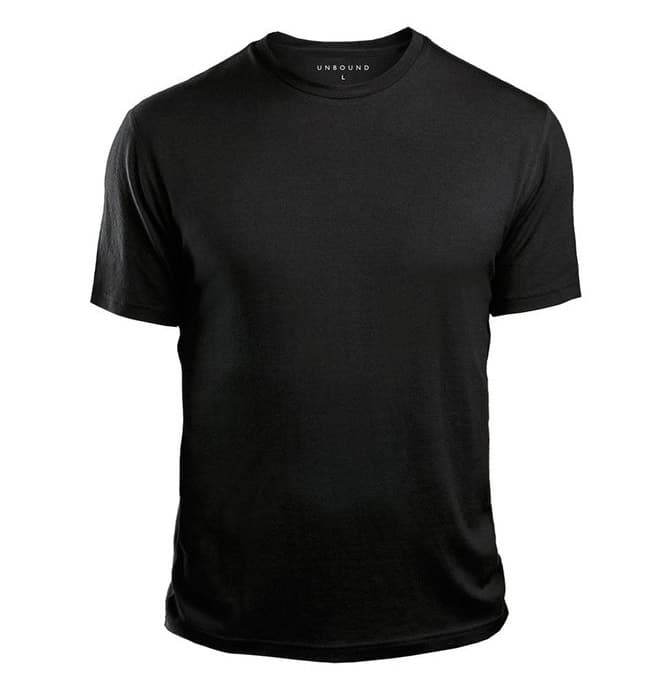
Unbound is another company that makes 100% merino t-shirts. We like that these are just simple, well-made shirts with no branding and they come in black, grey, and navy. Priced at $65 each, it’s a solid merino t-shirt for the price. Available at Unbound .
Duckworth Vapor
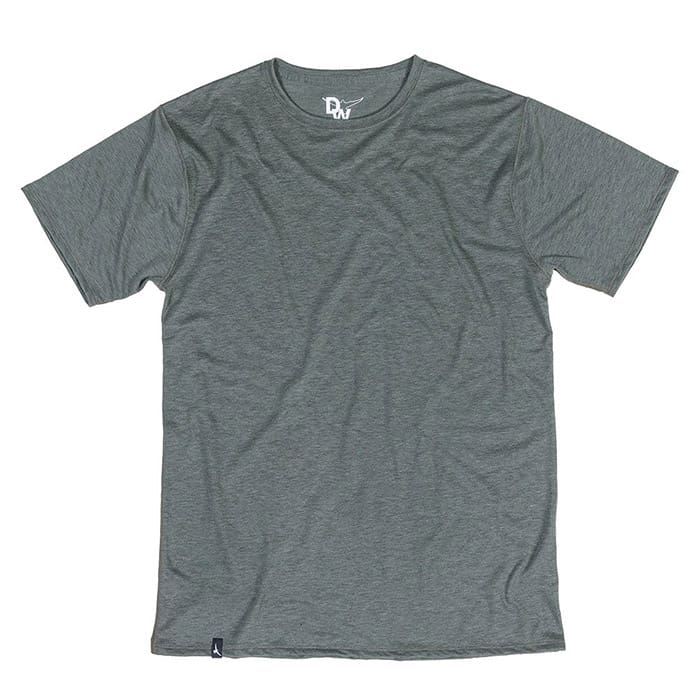
Duckworth is a small company based in Montana that grows its own sheep on their own ranch and the shirts are made on site (which we think is pretty cool). Their Vapor t-shirt is top-notch. It’s made from 38% fine merino, 50% recycled Polyester, and 12% Modal. The Vapor is super soft, naturally odor-resistant, durable, and breathable. They sell for $68 each and come in multiple colors.
Uniqlo makes a handful of synthetic and synthetic/wool blend shirts that are super cheap. Their AIRISM shirts are crazy lightweight, wick sweat, and dry super quickly (their HEATTECH is designed for cold temperatures as a base layer but I find they work in the summer as well). They do have a synthetic look but it’s not too bad. They also have poly/cotton blends that look closer to a standard t-shirt. Uniqlo’s construction isn’t amazing and sizing can be a little inconsistent but their t-shirts only cost $6 to $15 so it doesn’t hurt to give them a try. Available at Uniqlo .
Shorts: 0-2 Pairs
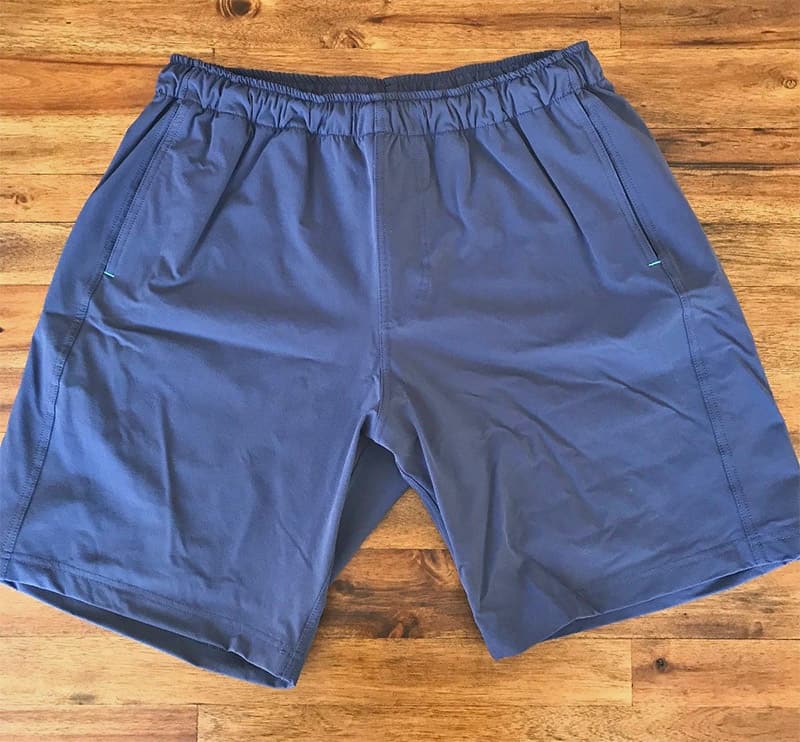
We tend to not wear shorts unless we’re traveling in Southern Europe but more and more Europeans are wearing shorts during the summer so you won’t really “stand out” if you have shorts on. That said, we suggest a nice looking pair that is a little more fitted if you want to blend in — i.e. don’t wear gym shorts or anything with cargo pockets.
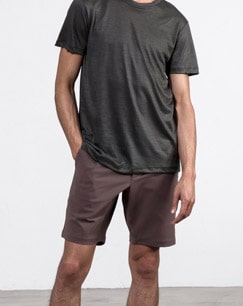
Outlier makes two nice looking and high performing technical shorts — OG Free Ways ($175) and the New Way (comes in long for $130 and short for $120). These are both great shorts but they’re expensive. But, if you have the cash then go for it. Available at Outlier .
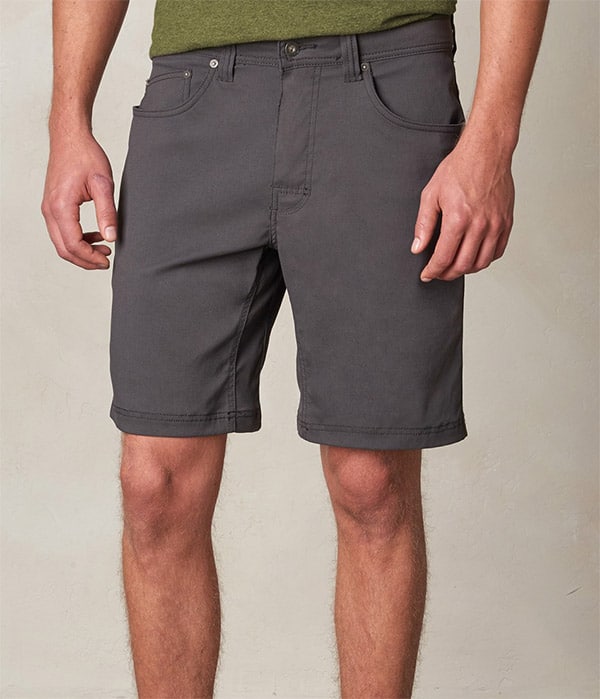
The Hybridizer Short is a nice looking pair of 96% Polyester / 4% Spandex shorts that are moisture-wicking and quick drying. I wish they were an inch or two shorter but you can always roll them up. They cost $75.
Another great option is the Brion Short. We think they look nice and they’re 97% Nylon / 3% Spandex so they’re dry quickly. They normally cost $65. Available at Prana .
Myles Apparel
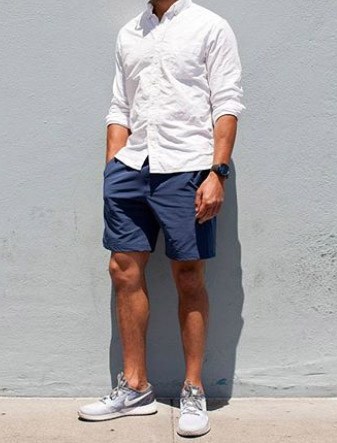
The Myles Everyday Shorts are the most “athletic” of the shorts we recommend but they still manage to look like normal shorts. We love the four-way stretch and their ability to repel water as well. Available for $58 at Myles Apparel .
We don’t have any specific recommendations because Uniqlo changes up their offerings each season but they should have a few options.
Golf Shorts
Multiple athletic brands make golf shorts that use performance fabrics. Try a few on to see if any work for you.
Footwear: 1 Pair (Maybe 2 pairs)
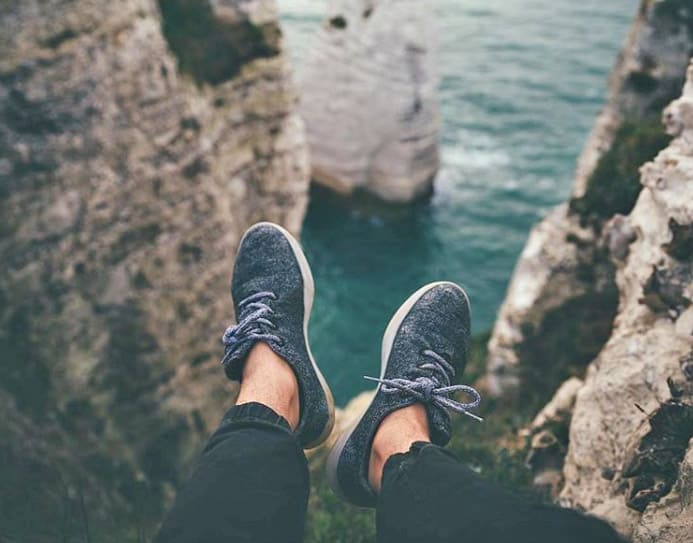
The goal of ultralight travel is only bringing one pair of shoes. Of course, that’s easier said than done.
For us, we tend to wear comfortable sneakers. “Fashion” sneakers are popular in Europe so don’t feel like you’ll look out of place by not wearing fancy Italian leather shoes. Cool Nikes, New Balance, Adidas, Allbirds, etc. will all work
Waterproof footwear comes in handy if you’re traveling in the spring, fall, or winter. Consider a sturdy pair of boots in the winter.
If you do bring more than one pair, make sure it’s a lightweight pair because you’re not going to have much room in your backpack.
Need more tips for buying shoes? Check our guide to the best travel shoes .
Rain Jacket (Optional)
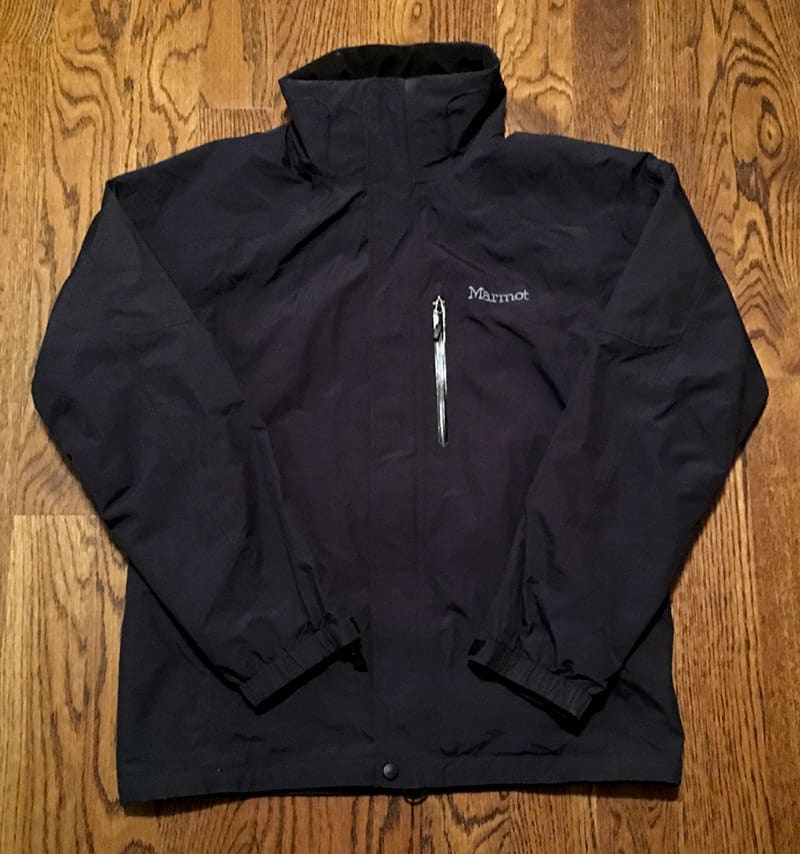
You can probably get away with not bringing a rain jacket in the summer but it’s wise to bring one in the fall/spring/winter. The key is finding one that’s super lightweight and packs away into a tiny ball when not being used. We’ve listed our favorites below.
Patagonia Houdini
The Houdini jacket is crazy light at 3.6oz (that’s basically a deck of cards). And, of course, it packs down into a tiny ball. It’s a great option because you can throw it in your bag and forget about it until you need it. Plus, we also dig the simple styling. However, this jacket isn’t designed for sustained heavy downpours — but it’s great for city travel since you probably won’t be walking for hours at a time in the rain. It’s a solid summer jacket. The Houdini usually costs around $99. Available via REI and Amazon
Outdoor Research Helium II
The Outdoor Research Helium II gets a ton of love because it’s insanely lightweight at around 6oz and it packs down to the size of an apple. It’s a great summer jacket. It usually sells for $140-$170 so it’s a little pricey. Available via REI and Amazon .
Outdoor Research Helium HD Rain Jacket
The Helium HD Rain Jacket is similar to the Helium II but it’s a little heavier at 9oz (which is still crazy lightweight). It does have a few extra features like front pockets and pit zips. It’s also expensive at around $200. Available via Amazon .
Marmot PreCip Jacket
I’ve owned the PreCip Jacket for about a year and it’s gotten me through rainy days in Rome, Barcelona, Florence, and NYC. Sure, it’s not the lightest jacket on the list (it weights respectable 11oz) but it’s still plenty light and it feels durable. The PreCip usually sells for about $100. Available via REI and Amazon .
Patagonia Torrentshell
The Torrentshell weighs in at 12.1 oz so it’s a little more robust than other jackets on this list but it’s still very lightweight. It’s a true rain jacket and will keep you dry all day. It’s priced around $130. Available via REI and Amazon .
It doesn’t hurt to check Uniqlo’s offerings because they usually have a few cheap jackets. They’re definitely not going to be as light or high-quality the other jackets on this list but they’ll be a lot cheaper (usually $40-$50).
Packable Puffy Jacket
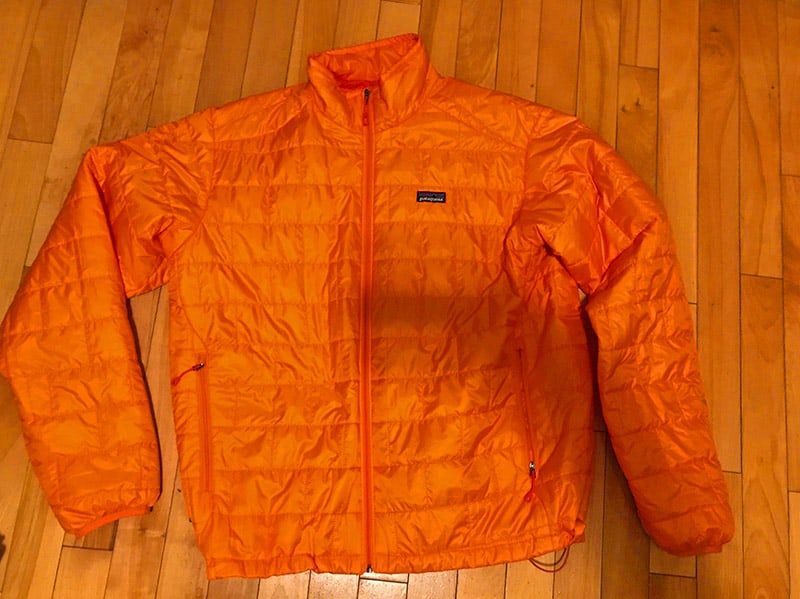
A light down jacket is impossible to beat for cool/cold weather travel. Down is crazy lightweight but it provides a ton of warmth. On cool days down jackets work well as an outer layer and on really cold days it makes an excellent insulating layer when paired with a heavy coat.
It can also be compressed super well so you can smush your jacket down to the size of a shoe so it’s easy to pack away.
One thing to consider is whether you want a hood. We prefer no hood if you’re using it as a mid-layer or not in really cold weather because the hood adds a little extra bulk.
However, there are a few downsides to lightweight down jackets. First, they can be expensive. And second, the fabric can be fragile so it can tear if you get it snagged on something sharp.
NOTE: Down is made from duck or geese feathers. Some cheaper brands source their down feathers from inhumane suppliers who force-feed and live-pluck their birds. We urge you to buy brands who get their down from humane and sustainable sources (like Patagonia). Or you can choose a jacket that uses synthetic down.
Patagonia Down Sweater
The Patagonia Down Sweater Hoody isn’t the most lightweight jacket on our list (it’s still really light at 13.1 oz) but it’s a great looking jacket that will keep you toasty. There is also a hoody version if you want a hood. Priced at $229 — via Amazon and REI .
Montbell Plasma 1000 Down Jacket
The Plasma 1000 is insanely light at only 4.8 oz. (it’s the lightest we’ve ever seen) Yet, it uses 1000 fill down which helps provide a lot of warmth (considering how light it is). This jacket is truly ultra-minimalist so it has no extra features (i.e. pockets or hood). This is an expensive jacket so expect to pay around $330 for this bad boy.
Montbell also sells the Ex Light which is slightly “heavier” at 6.2 oz. and it’s a little “cheaper” at $270. Available at Montbell
Patagonia Micro Puff
The Micro Puff is really light at only 9.3 oz and it provides a surprising amount of warmth for its weight. It is pricey at $299. Available via Amazon and REI .
Patagonia Nano Puff
The Nano Puff (11.9 oz) is a bit heavier than the Micro Puff but it provides a little more warmth. It’s also more affordable at $199. Available via Amazon and REI .
Mountain Hardwear Ghost Whisperer Down Jacket
With a name like “Ghost Whisper” this jacket has to be light. And at only 7.2 oz they’re not lying. This jacket gets a lot of love because it is water-resistant and has pockets. The Ghost Whisper can often be found for under $180 so it’s slightly more affordable than other jackets. Available via Amazon and REI .
Uniqlo always has a few synthetic down jackets available for very reasonable prices — usually around $60-$70. Don’t expect crazy feature or ultra-lightweight but it’s a good budget-friendly option.
Packing Cubes
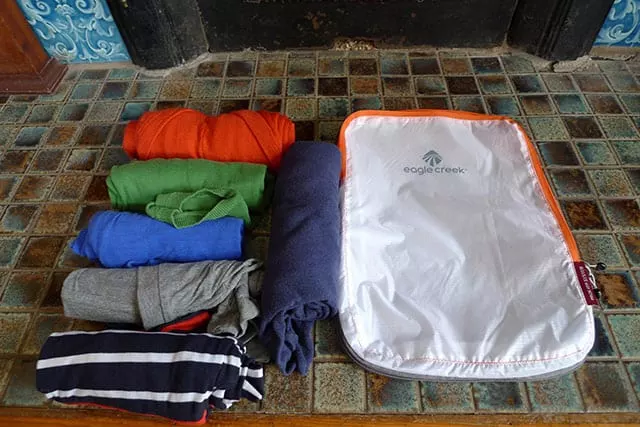
Traveling with a small backpack poses a little more difficulty with it comes to packing all your clothing — which is why packing cubes come in handy. They make it easy to separate all your clothing so you know exactly where to find things. It also makes packing and unpacking your backpack easier since everything is contained in its own space.
Almost all packing cubes are fairly lightweight so one brand isn’t that much different than the other. But if you really want to cut the weight then the Eagle Creek Specter system of packing cubes is the most lightweight cubes we’ve come across. We use them and they’re crazy light and water-resistant. Check out Amazon for packing cubes — there are multiple brands and they largely function the same so read the reviews.
Toiletries / Personal Care Items
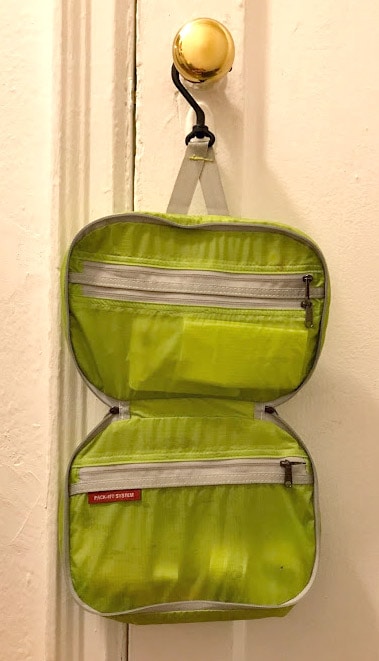
Alright, let’s dive into toiletries. It’s important to limit what you bring since liquids, gels, creams, etc. are super heavy.
Toiletry Bags
First, you need a toiletry bag . Some people just use a plastic Ziploc bag (makes going through airport security easy) but we prefer a small, lightweight toiletry bag — ideally one with a hook (European bathrooms are tiny) and water-resistant.
- The Sea to Summit Travelling Light Hanging Toiletry Bag is great because it’s compact, lightweight, and had a hook — buts its kind of expensive at around $35 ( via Amazon )
- The Eagle Creek Pack-It Specter Quick Trip Toiletry Bag is small, super lightweight, and affordable but doesn’t have a hook ( via Amazon for around $20 ).
- The NeatPack Compact Hanging Toiletry Bag has a hook and it’s affordable but might be a little big for hardcore ultralight travelers ( around $18 at Amazon )
- The Osprey UltraLight Zip Organizer is another option that’s light and has a hook (via Amazon for around $35).
- We use the Eagle Creek Pack-It Specter Wallaby but it’s often unavailable… maybe it’s being discontinued, not sure. You might be able to find it at REI for around $30.
First, you need something to hold your liquids. The Humangear GoToob line of travel containers are the best because they don’t leak — shampoo-covered clothing is never fun. Check Amazon to see the full Humangear line but we suggest the GoToob 3-Pack – Large .
We pack pretty minimally when it comes to personal care items. Here is what we use:
- Travel-size toothpaste
- Travel-size sunscreen (we buy more upon arrival)
- SPF-30 lip balm
- Dr. Bronner’s for handwashing laundry (in a 100ml Gotoob ) — if there is no washing machine.
- Bodywash (in a 100ml Gotoob )
- Shampoo/Conditioner (in a 100ml Gotoob )
- Moisturizer (in a 100ml Gotoob )
- Normal deodorant (we don’t bother with travel-sized)
- Normal toothbrush with Steripod Clip-on Protector (helps keep the brush clean)
- Nail clippers
- Shaving supplies (razors and cream/foam)
- Basic makeup products (stick with the essentials as this can add a lot of weight)
- Cologne/perfume samples
- Pain medicine
- Pepto tablets
- Anti Monkey Butt powder
Of course, your needs might be a little different but you can always buy stuff when you arrive.
Travel Towel
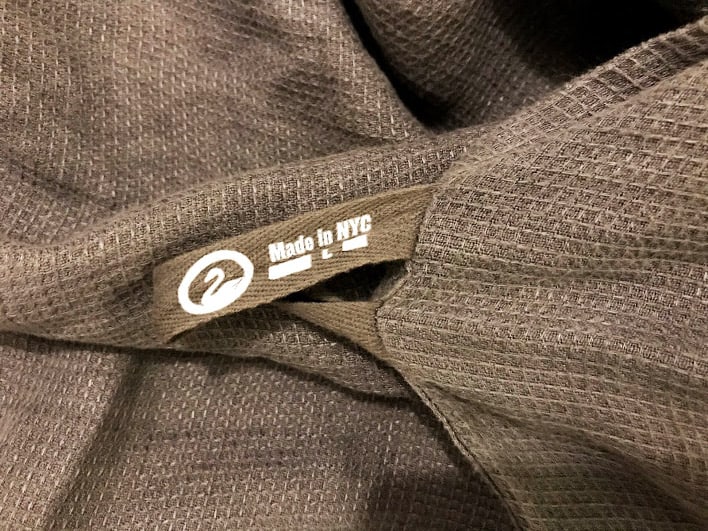
We recommend packing a travel towel if you’re staying in hostels. That said, some hostels will provide towels but many don’t or they’ll charge extra for them.
What’s the difference between a travel towel and a normal towel? Simple: Travel towels are lightweight, highly absorbent, dry within a few hours so you don’t have to worry about packing a wet towel — which will smell musty and make all your clothes smell bad. Normal towels take multiple hours to dry and are very bulky.
Travel towels come either synthetic microfiber and natural linen. Most towels are made from microfiber but some people get really irked by the feel of microfiber — especially the cheap stuff. If that’s you, check out linen. Linen doesn’t quite perform as well but it does feel a lot better on your skin.
- Packtowl Personal Packtowl is a microfiber towel that’s a favorite among travelers. It absorbs 4x its weight in water, dries quickly, and it’s affordable. It’s also pretty soft. It’s usually around $25 at Amazon .
- Rainleaf Microfiber Towel is a great budget option that costs around $15 at Amazon .
- The Outlier Grid Linen Towel is a personal favorite. This 100% linen towel is made from quality fabric and we’ve used it multiple time. That said, it’s also expensive and It doesn’t perform as well as the Packowl — but it “feels” nicer. The large costs $59 and the extra-large is $88.
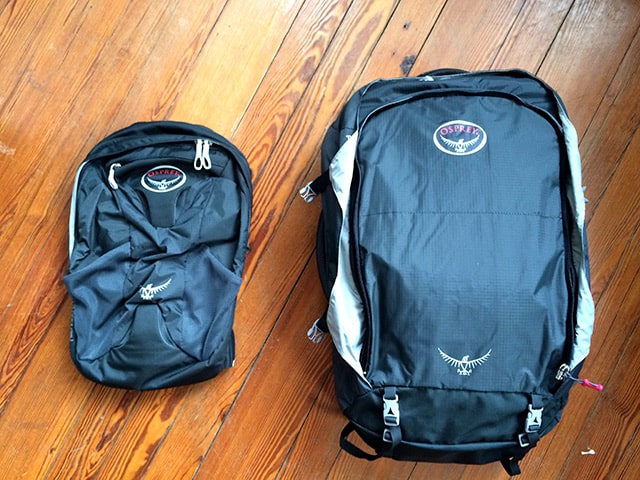
We usually carry a small, lightweight backpack during the day. You just want something big enough to carry a small notebook, a few pens, some snacks, an extra pair of socks, a camera, and maybe a super light rain jacket. You also want the daypack to be small enough to pack away into your main backpack for when you’re traveling.
Note: these ultralight daypacks aren’t designed to hold much weight. Most don’t have much (if any) structure and very little padding — overloading will result in back pain.
- Matador Daylite16 Backpack: Very light at 4.1 ounces. It’s one of the better-looking daypacks. Available for $50 at Matador .
- Matador Freerain24: Very light at 5.5 ounces. Waterproof. Looks pretty decent. Available via Amazon .
- REI Co-op Flash 18 Pack: Weight 10 ounces. The black version looks fairly nice. Available for $40 at REI .
- Sea To Summit Ultrasil Daypack: Crazy light at 2.4 ounces. It is kinda ugly though. Available for around $33 at Amazon .
- Osprey Ultralight Stuff Pack: Super light at 3.2 ounces. The black version looks decent. Available for around $35 at Amazon .
Electronics
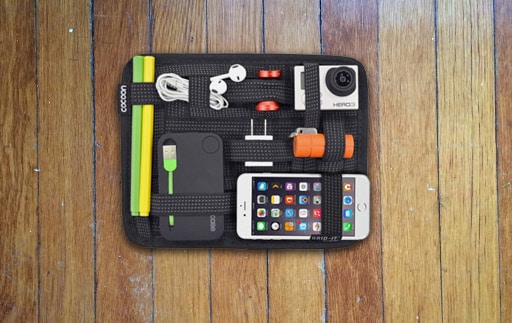
Everyone travelers with electronics these days. For the ultralight traveler, the key is to be smart about what you bring.
A smartphone is the must-have travel gadget. Even if you don’t have data you can still find plenty of free WIFI so you can book tickets, do research sights, and scope out places to eat. Plus, any modern smartphone takes amazing photos. Check out our guide to using smartphones and data plans in Europe .
Don’t forget a portable charger! We love the lip-stick sized Anker PowerCore+ charger ($20 via Amazon ). Fully charged, it has enough juice to charge your iPhone two times. If you need more energy, Anker has multiple options.
Tablet/Laptop
If you’re truly traveling light then we suggest skipping the laptop. Instead, we recommend an iPad. Serious users can pair their iPad with a slim Bluetooth keyboard and you’re set.
Compact Camera
A high-end compact camera is perfect if you want really nice photos — big DSLR cameras are out of the question for ultralight travel. Most average users are happy with photos from their smartphones. We’ve written a guide about our favorite travel cameras but here are our top picks:
- Sony RX100 ($500 via Amazon) : The Sony RX100 is probably the best high-end compact camera on the market. The thing is tiny and takes great photos.
- Panasonic Lumix LX10 ($550 via Amazon ): This is another top contender for the best all-around high-end compact camera.
- Canon GX9 and the GX9 MII ( $380-$430 via Amazon ): These two Canon cameras are excellent and they’re a little friendlier on the wallet.
Don’t forget memory cards !
TRAVEL POWER STRIP
Power outlets are a hot commodity in Europe. We’ve stayed in hostels that only had two outlets in a room with 10 people. And many hotels and rental apartments aren’t much better. The Belkin Travel Power Strip with USB ports is a great compact option that also has USB — which is essential these days (Note: you’ll need a plug adaptor as well – see below).
OUTLET PLUG ADAPTER
You’ll need a few plug adapters . We like the Ceptics USA to Europe Travel Adapter Dual USB because it will fit about any European plug and it has USB. These Ceptics Ultra Compact adaptors are smaller but don’t have USB.
Note: voltage adapters are heavy and bulky and they’re generally not needed (plus, they often malfunction). Read our guide for traveling with electronics to find out more information about using electronics in Europe.
Travel Accessories
Here are a few random things that will come in handy as you’re traveling.
- Keychain Flashlight: We love the Streamlight 73001 Nano Light Miniature Keychain LED Flashlight
- Small Notebook : We always carry a Moleskine Notebook or a Field Notes Notebook .
- Woolite Travel Soap: These are perfect for handwashing your nice wool clothes in the sink. Amazon sells single-use packs of Woolite with a sink stopper .
- Clothesline: A rubber braided clotheslines comes in handy when you to dry your clothes.
- Padlock: Staying in a hostel? You’ll need a padlock. We recommend the Master Lock Set-Your-Own-Combination Padlock
- Utensils: The titanium spork is great for those on-the-go grocery store meals.
- ZipLock Bags: Bring a few. They come in handy for all sorts of things.
- Recent Posts
- New York Pass Review | Is It A Good Value or Waste of Money? - May 20, 2024
- Paris Pass Review — A Good Value or Waste of Money? - May 13, 2024
- The Best Travel Backpacks | In-Depth Buyer’s Guide & Backpack Reviews - April 28, 2024

No Funny Business
The Savvy Backpacker is reader-supported. That means when you buy products/services through links on the site, I may earn an affiliate commission—it doesn’t cost you anything extra and it helps support the site.
Thanks For Reading! — James
Questions? Learn more about our Strict Advertising Policy and How To Support Us .
Related Reads
The best travel backpacks | in-depth buyer’s guide & backpack reviews.
A list of my favorite travel backpacks for every travel style.
Backpacking Europe Packing List — My Europe Travel Packing Guide
A comprehensive packing list and advice for budget backpacking and ultralight travel in Europe — including electronics, clothing, toiletries & accessories.
Helpful Travel Tips & Articles , Packing
Fashion Advice: How to Avoid Looking Like An American Tourist In Europe
Fashion advice to help you look like a local when visiting Europe.
Packing , Product Reviews
Best Travel Shoes — Fashionable & Comfortable Shoes for Traveling
The ultimate guide to the best travel shoes that are both stylish and comfortable.
City Guides
Choosing travel insurance, travel packing lists, budget travel newsletter.
The best budget travel tips sent straight to your inbox.
Join My Journey
Europe travel tips, advertising & privacy policies.
TheSavvyBackpacker.com is a participant in the Amazon Services LLC Associates Program, an affiliate advertising program designed to provide a means for sites to earn advertising fees by advertising and linking to amazon.com.
© 2010 - 2024 The Savvy Backpacker
Website Design by FHOKE

Snarky Nomad
Traveling the world, one ridiculous disaster after another
Ultimate ultralight travel packing list
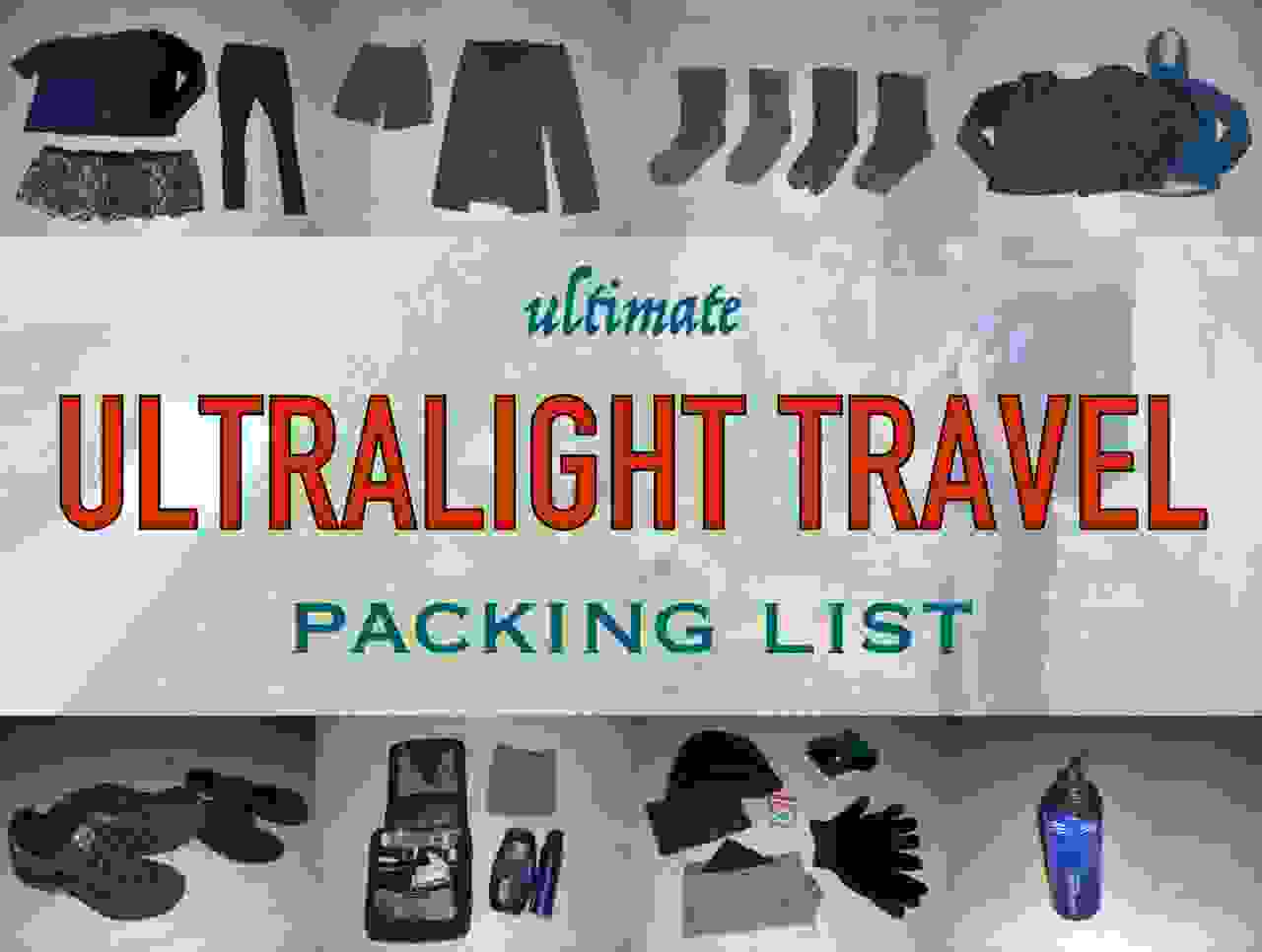
Quite a few times I’ve heard backpackers complain about weight limits or maximum bag allowances on airlines. They haul 40-pound monstrosities that limit how comfortable they are, how fast they can run to catch the train, and how often they have to take a taxi because their bag is too heavy. They end up going a little slower, seeing a little less, and paying a little more. When they look at mine, they ask me where my “real” bag is.

I have traveled around the world on extended trips up to 9 months long with nothing but a 20 liter daypack, through summers, winters, jungles, cities, and everywhere else. It weighs less than fifteen pounds and fits in the overhead compartment on the plane.
I never have to worry about lost bags, check-in times, or waiting by the conveyor belt. I am the first person in line for customs, and stroll right in. I spend nothing on laundry or taxis. I am the first to finish packing every morning. I never spend more than five seconds trying to find something at the bottom of the bag. I wander around for hours with my pack, just because I can . I’ve gotten to the point that I really don’t know how to do it any other way, and my scrawny shoulders continue to thank me.
It’s a fun game I like to play with myself find to be an amusing intellectual challenge, but despite year after year of life on the road, I have met less than half a dozen people who do the same thing, and we are endlessly perplexed. Sadly, I have never been able to convince anyone to follow this plan. But I’ll give it one last try. It’s for your own good.
How to pack for ultralight travel

When thinking of things to pack for a trip, most people bring everything, “just in case,” and end up hauling a bag full of garbage they never use. Don’t do that.
Not a single person I’ve ever met has said “I wish I brought more.” You can spot the seasoned travelers simply by bag size. Instead of thinking about what to add, think about what you can cut . You know who else said that? Oh, just Bruce Lee is all.
Your limit should be the same as the airlines : 22” x 14” by 9”, or 45 liters (though it’s slightly smaller on certain no-frills European airlines). This will keep you in check (and allow you to reap the benefits of carry-on-only travel ), since it’s all you can take, and it’s more than you need. If I got by with 20, you’ll get by with 45. Trust me. Just peruse this page and assume you’ll include twice as much.
1) Shopping for Ultralight Backpacks
For quite some time, the only options available were hiking packs, and while they’re quite good at what they do, a few companies have started designing what I consider travel-worthy backpacks (carry-on size, with a fully opening zippered panel, so you can pack it like a suitcase), which work great when you want to open everything up, instead of traditional top-loaders that need to be emptied completely to find something down at the bottom.
Since travel often requires lots of packing and unpacking, and somewhat less walking, it generally makes more sense to get a backpack optimized for travel, rather than hiking (unless you plan on hiking with it, of course). Check out a list of favorites here .
Wheeled suitcases aren’t a terrible idea, especially if you have back problems, but just remember they add weight and you’ll go crazy on cobblestones.
2) Ultralight Travel Clothing Basics
People constantly ask “how can you have enough in a daypack to travel for a year?” The thing is, you’re not packing for a year. No one is.
The secret is to pack the same gear, no matter how long the trip is . I bring 3 sets of clothes, wash whatever outfit I’m wearing when I take a shower, and hang it up to dry overnight. And you don’t even need to do manual laundry. If you bring a week’s worth of clothing and do laundry once a week, you can travel forever . It’s that simple.
You might get stuck with a sink wash sooner or later, which is why everything should (hopefully) be high-performance and versatile, wicking sweat and drying quickly, which cools you in summer, and warms you in winter. Try not to bring separate clothes for hiking, lounging, and clubbing. Just get clothes that look good and feel good . They should be suitable for any social situation. It’s a tall order, but it can be done.
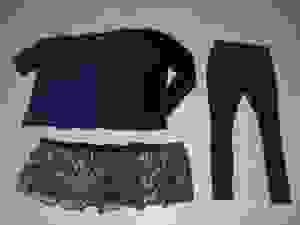
Shirts: No cotton. It soaks up sweat and stays wet all day. Get polyester or merino wool t-shirts (read more about why merino is everyone’s favorite here ), both of which wick sweat and dry quickly. Polyester should have an odor-control treatment if you plan on making any friends. Though I won’t judge you, it’s nice to have a fancy shirt for special occasions. I’d skip warmer thermal underwear. You can only wear them in winter, and you’ll probably bring t-shirts anyway, which dry faster after a sink wash. Leave the insulation to the outer layers, which you don’t need to wash as often.
Underwear: Let me tell you, “performance underwear” feels just as good as it sounds. Spoil yourself. Again, make sure it’s quick-drying, lightweight, odor-resistant, and comfy (take a look at a list of favorites here ). In winter, long underwear works wonders. You’ll only need a single pair if you wear regular underwear underneath, so you won’t have to wash the heavier one as often.
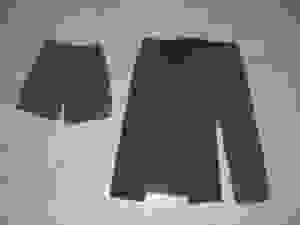
Pants and shorts: Travel pants, ideally, should be lightweight, wrinkle-free, water-resistant, quick-drying, and look completely normal, despite having a few hidden pockets for hiding valuables. There are literally only a few that actually do this (which is ridiculous ), but you can find a list of good travel pants here . Try to find pants that don’t look too silly, so you won’t have to bring extra pants for fancy fun times. If your pants fit, you can skip the belt, and for guys, quick-dry shorts double as swimwear. You can cut some corners here , as cotton pants won’t hold you back so much if you have an umbrella, don’t mind washing rarely, or have laundry facilities. Given the rarity of truly travel-worthy jeans , don’t feel bad bringing regular jeans.

Socks: I bought a pair of merino wool socks and threw out all my white cotton gym socks the same day. Seriously. Merino wool warms in winter, cools in summer, insulates even when damp, dries quickly, resists odor, and is soft and plush and wonderful. I’ve found nothing more comfortable for my feet. Most socks blend merino with polyester and other materials, and work well. I bring two ultralight pairs for summer use, and a warmer pair in winter, worn over the lighter ones so I don’t have to wash the heavy ones as often.
3) Outer layers
Layering is crucial. It’s better to take a few lighter pieces that you can layer together, rather than a heavy one you can only wear in Antarctica. You may have your own comfort system on this, but here’s what I recommend (or check out my winter travel gear list for details):

Inner warm layer: Find the lightest fleece or wool sweater you can find, comfortable when it’s cool, but not cold. I look for close fits to layer more easily, and a high, snug neck so I can skip the scarf.
Outer warm layer: For winter travel, goose down or synthetic insulation jackets (those big puffy ones) are one of the best ways you can shrink things down. Goose down is triple the warmth of fleece for the same weight, and packs down to half the size, meaning a medium-warmth jacket weighs 8 ounces. Synthetic insulation isn’t as warm or packable, but it dries faster and retains its insulating qualities when wet, whereas goose down does not, which is why I have thus far gone with synthetic. Since it is encased in a nylon shell, it works well as a windproof outer layer, while the fleece sweater on the inside will be comfortable against your skin.
Rain jackets: I don’t have much to say here, and umbrellas work well enough anyway. I just look for light weight, comfort, a hood that covers my face, and enough venting to keep me cool (take a look at some ultralight rain shells , some of which are half the weight of standard jackets). Don’t get something insulated that you can only wear in winter. Layer instead.
Wind jackets: Climbing up a windy mountain on a chilly day calls for something windproof that won’t overheat, and a wind shell is the only thing that fits the bill. I wouldn’t call it a necessity, but mine is about 3 ounces, and I wear it all the time.
4) Travel Shoes
I met a guy with separate hiking boots, running shoes, evening shoes, and sandals. Here’s an idea. Why not buy shoes that look good and feel good ?

There’s not much reason to bring serious hiking boots, which are designed to support 50-pound packs, which you won’t have. A nice-looking, tough, comfortable shoe that fits properly and offers good support will be suitable for all occasions. Especially if they’re waterproof.
One pair of shoes, end of story (probably leather, described here ). And one pair of flip-flops or sandals. Comfy but light.
Women’s fashion is less forgiving. If you have to bring a separate pair of evening shoes, just make them small. If all it’s got on top are straps that can lay flat, perfect. Only bring one pair. Anyone who calls you out on repeat clothing will be another scruffy backpacker who will be in no place to make comments.
5) Travel Accessories
Again, anything you stuff in here should add value, not just weight. So far I’ve avoided packing cubes, but they’re not a bad idea.
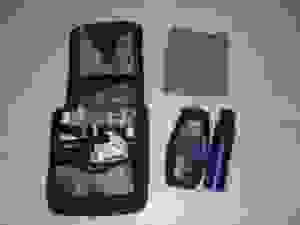
Toiletries: I travel with nothing but airplane-sized bottles (maximum 3.3 ounces, or 100 mL) so I can take them on the plane, and reuse them on each trip. When the bottles run out I buy a larger one, refilling the mini so I can throw the big one away sooner. This way I might have one or two big bottles at any one time, instead of my entire supply being oversized (though an all-in-one bar soap is great for solving this problem). Check out a comprehensive toiletries list for details.
Travel towel: This is another of the most significant ways you can cut size and weight, as huge cotton towels are big, heavy and dry slowly. Microfiber towels are light, small, super absorbent, and wring out 90% dry. You can even get by with a washcloth-sized micro towel which will fold up to the size of a napkin, though it’ll take some extra time to dry yourself off. Definitely get one of these. They’re cheap and enormously efficient (though I’ve recently discovered linen towels are even better ).

Sleeping bags: This is another one of those “surely I must need this” items that people end up never using. 99% of people stay in hostels and never use their sleeping bag. If you’re worried about hostels that require you to rent sheets, I’ve traveled for 15 months and spent maybe $3 on them. It’s not worth the extra weight. If you want to be a little warmer, you can sleep in your long underwear, or you can get a bag liner, which is incredibly lightweight and small, and will keep you warm enough indoors. If you really need a sleeping bag, you can find some that are the size of a 1 liter water bottle and weigh 1 pound. But if you don’t plan on camping, forget it.
Daypack: I try to avoid bringing an extra bag, but now that we have ultralight options that fold up into their own pocket, I’d recommend it. You’ll do a daytrip or climb a mountain and you’ll want to bring a jacket, food, water, maps and whatever. I had one made by Sea to Summit that holds 20 liters, weighs 2.4 ounces, and fits inside a coffee mug.

Other extras: I’d recommend a money belt (unless your pants have security pockets), a deck of cards, a nice small camera (or smartphone), a journal, sunglasses, an outlet converter, hat, gloves, and two books (it’s hard to find a book right away once you finish), or an e-reader. Those are all the extras I ever use. Umbrellas aren’t a bad idea if you don’t want to spend $100 on a rain jacket. Just remember that if you want to add extras, think about how often you’ll use it, and if it’ll be worth it.
Budgeting for ultralight travel

Poor? So was I. Patrol eBay and watch for sales. Besides, you shouldn’t buy more than a minimum of gear. Three backpacking outfits shouldn’t be too expensive, and you might have a few running shirts already, and some warm clothes, and good shoes. Some of it you’ll wear back at home after the trip, especially the socks and underwear.
If you have to cut corners when packing for a trip, regular cotton pants and shorts will be fine, as long as you’re not washing too often and rainstorms don’t ruin your day. You can skip the rain jacket and bring an umbrella, and winter gear can be cut outside of winter. I wouldn’t cut the travel towel, since it’s less than $20 and will save you lots of space and weight, and quick-drying base layers are kind of a necessity for this to work, unless you’re doing machine washes once a week or so, in which case it’ll be fine.

You should now be a thoroughly converted ultralight, minimalist backpacking genius. Once you do this, it’s hard to go back. This method is forced upon all travelers on Rick Steves’ tours, many of whom claim it’s impossible ahead of time, but talk about how great it is after. This strategy has close to a 100% success rate . And whether you’re packing for Europe, or Asia, or India, summer or winter, it’s always the same.
Oh, and by the way, the photos displayed here represent absolutely everything I took on a 9 month trip (except the camera), from temperatures below freezing to body-temperature sunshine. Towards the end of the trip, someone asked if there was anything I would have added. I said no. Someone else asked if there was anything I would have removed. I said no. I was super proud of myself.
Eventually I added a few things : A packable daypack, an ultralight wind jacket, a collared shirt, and swapped the emergency blanket for a sleeping bag liner instead (which is still just optional anyway). Overall weight was almost the same, and these items can be extremely useful.
Hmm. Talking about all this makes me want to go shopping. I’ve been working on getting my year-round pack down to about 12 pounds…
Related Posts

The Wool and Prince Boxer Brief 2.0, reviewed and raved about
February 9, 2019 February 9, 2019

Announcing my first-ever product collaboration!
December 14, 2018 December 14, 2018

The near-perfection of the Uniqlo Blocktech Parka
May 8, 2018 May 9, 2018
About SnarkyNomad
Eytan is a pretentious English major whose rant-laden sarcastic tirades occasionally include budget travel tips and other international nonsense. You can follow his every narcissistic word on Facebook or Twitter .
164 Comments on “Ultimate ultralight travel packing list”
Excellent packing list! Very in depth and extremely light.
Thanks! It’s a game I like to play. I think this is about as minimal as you can go while still being a normal human.
I feel more confident after reading this… I wanted to go super light. Gonna do a 20L for 4 months in Asia. Thanks for the tips!
Has anyone got a packing list/methodology for ultralight 2-4 day business travel?
I had to do a ridiculous amount of business travel for about 10 years and think that you could follow most of the tips in this article but replace the travel clothes with a two pairs of black work trousers (wear one, pack one), splash out on two of those wrinkle free shirts (hang in steamy bathroom whilst showering to help release any stubborn wrinkles) then a couple of ties. If you need a jacket then wear it/carry it on the plane. The problem with business travel is you normally have to carry a company-issued laptop which may be heavy, ditto for the phone and any related power cables, adapters etc. But I still think you can get away with carry on provided they don’t make you carry brochures and product samples. I am female and I followed the same principle (2 x black trousers, 2 x black/grey tops) but carried a couple of bright scarves, dressy earrings to lighten things up and make it seem like I was wearing a different outfit every day – ties can have the same effect! Also I choose black because it is more forgiving if I spill food/drink and easier to spot clean without being noticeable. Females normally want to carry make-up too but it’s amazing what you can do with one bottle of foundation and an eye shadow kit that doubles as blusher and eye liner!
If anyone starts making merino dress shirts for women, you’ll want to pounce on them as quickly as possible. They’re practically impossible to wrinkle.
I am off tomorrow for 10 weeks, work mainly but a bit of sight seeing and walking and commuter type cycling. I’m very close to the recommendations above, and my pack weighs 6kg of which 2.8kg is 15″ work laptop, phone, cables, chargers.
My ideal travel lappy is a Microsoft Surface Pro 4 12″ at under 1kg. I am stuck on windows 10 and linux and am not interested in apple. I need to use Microsoft Office lots, and MS Excel in particular at a high level. So tablets and ultrabooks are out of the question.
Where I think most people miss big weight savings is in the pack. Once you get something with multiple pockets, you are getting up over 800grams and as much as 2kg for 30-40liter pack. Honestly, you don’t need a pack that opens like a suitcase if you pack your stuff into ‘cells’. These cells can be put in a top loading stuff sack or a single compartment duffel bag. You might have a maximum of 5 cells so it isn’t a big deal to top load.
The lightest strongest fabric used today for packs is dyneema. Using this, you can get a 40 liter pack under 0.5kg, such as this one https://www.hyperlitemountaingear.com/summit-pack.html#product_tabs_specs This pack will store 40 liters, despite it saying it’s a 30liter pack, and it only weighs 360grams. There is a similar pack for 190grams that is just a stuff sack with shoulder straps. These are also highly water resistant.
Cutting 1-1.5kg off your pack is a LOT when you are restricted to 7kg total carry-on weight.
personally I use a $9 40 liter duffel bag that weighs 230grams. These things are more prone to failing, but I just buy another one. Usually I get at least 3 months of business travel with them. The handles are long enough to allow me to wear it as a backpack, and I use the shoulder strap to wrap around it longitudinally and compress it firmly. This always reduces it to legal carry-on dimensions. BTW, it is practically impossible to fill a 40 liter bag and keep it under 7kg. The idea of 40 liters is to put stuff in there (that you were wearing) once you have gone through check-in and wherever you are likely to get your pack weighed.
To travel light, you have to go through a paradigm shift. When I was younger it was nothing for me to wear the same shirt every day, week after week…cleaned regularly of course. Same for pants. And I wore a school uniform for years. Same shirts and pants 5 days a week. If someone is going to judge me on my clothes, I am honestly glad to filter them out of my life. They will be third rate thinkers and doers. Interesting people are into ideas and sharing them, and doing stuff, not sitting around posturing in clothes.
The most interesting people do interesting stuff. And usually the smartest and most capable don’t travel to pick up chicks and hang in nightclubs. I’ve been traveling for 40 years, and the most interesting people I’ve met have been on specialist backpacking walks, attending seminars by high achievers in a field. The most interesting and attractive and intelligent members of the opposite sex I’ve met have been at unique health retreats (Thailand, Northern California, Maldives). Quality people care more about what you believe and what you do rather than what image you concoct via clothing.
Outlier pants are excellent travel pants and are acceptable in business and at the beach. They are worth the price.
For warmth, I wear a singlet, t-shirt, l/sleeve fleecy and lightweight vest. I don’t have an outer shell for rain but use a lightweight poncho. I do carry zip off Columbia hiking pants mainly cos they are so light and they look excellent as shorts and not too bad as trousers.
My toilet kit is a zip lock plastic bag for storing stuff in the freezer. My toilet, sewing, and first aid stuff is less than 300grams. Seriously you only need a little toothpaste or powder. Scrap the deodorant (by eating healthy), aftershave etc. If you are going out, borrow some from a mate, or collect stuff from hotels in mini bottles. I only carry small toothpaste tubes.
I don’t carry a camera. My S7 phone is fine and always with me. Most people post pics to the internet and don’t need the resolution of a dedicated camera.
I could go on but will spare you.
Using packing cubes in a top-loading pack is definitely a good way to manage the black hole effect of a big pack. It looks like you’ve got the absolute lightest options of each category, which is pretty impressive. I might go on a trip like that at some point, just to see how light I can go…but occasionally I prefer the functionality of something else, and am willing to handle the extra weight. But of course it adds up.
Everything is dark! I will look like a thief the whole time I’m traveling.
You are a thief. You are stealing all the fun and experiences that people who don’t travel leave laying around all over the place. :)
I also traveled for many years and through dozens of countries. The only problem i have with traveling this light is that no girl will take you serious in a club any where in the world when wearing ultra light zip off pants and mountain shoes. You can also never fit in anywhere ( like a regular tourist or an expat) since the obvious back packer vibe that surrounds you. Unless you don’t mind alone at night this isn’t the way to travel.
I speak from first hand experience that being a poor (looking) backpacker isn’t helping at all when approaching girls in a foreign club. Nice idea but no.
None of the gear on this page fits that description, and although it can be a Sisyphean ordeal finding decent-looking clothing that’ll work as hiking gear, it’s certainly possible. I didn’t have any zip-off pants on this trip, and for nearly the whole time the only shoes I had were nice-looking casual leather shoes. High-tech but logo-free t-shirts look like ordinary t-shirts.
The only “missing” item that I find practical is a collared shirt, which would only add as much size and weight to the setup as…a collared shirt. Swapping out a pair of lightweight pants for a pair of jeans also isn’t such a big deal either, and then you look classy enough for whatever. Very doable.
I also don’t think the end goal of international travel is to impress foreign ladies, but I suppose that’s an aspiration for some.
I guess the objective of international travel vary from person to person. For some, it’s about the people they meet and the girls they hook up with. For others, it’s about the culture, history, architecture, art, food, and the locals (in a non-sexual way). Obviously, what is essential will be very different to both groups.
That said, it’s definitely not going to break your back if you did include a nice shirt and pants in the load, which might add 1 pound of weight but will now allow you to be equally well-prepared for a mountain trail or a night club.
I travel super light too. My trips are usually around 2-3 weeks, but I do my laundry every night, so I could conceivably travel with the same load for months.
Among my clothes are 2 quick-dry T-shirts and a decent collared long sleeve shirt. The T-shirts are for daily wear, and the long sleeved shirts are for dinner or when T-shirts are not appropriate. I wear zip-off pants daily, but I also pack a pair of lightweight black slacks that go with the long-sleeved shirt.
This way, I’m prepared for most situations during my travels.
Chris, How about culture,history,architecture,art,food and the locals AND having an interest in local women?
In fact dating local girls will teach you a lot about the local culture. They will take you places a regular tourist or even a backpacker never comes.
Happy travels
I skipped the collared shirt for that trip since I couldn’t find something I liked, but it’s something I recommend and plan on bringing for the next trip.
My wife bought a silk shirt for me prior to our 7-week bike tour in France. Packs really light and small, doesn’t get smelly, dries fast, and like wool, is warm when it’s cold and cool when it’s warm. I wore this shirt in the camp ground and when we visited the more civilized tourist sites. This was my “dress” shirt for the trip and it served me well.
My experience is completely different! If the girls you approach can not take you serious unless you dress all up, then perhaps go for some girls with a bit more substance? I am currently traveling around the world with a 25 liter bag (and have been doing so for around 5 months now) and I use hiking clothes everywhere, and for everything, since it is all I have. I have only met one who said anything about it but still it wasn’t a problem. I have met a lot who were either inspired, thought it was cool or even said that it is the right way to do it.
I think it has more to do with your own perception on how you need to be and what other people think of you than the clothes you are wearing.
OCDemon. Thank you for a good article. I wonder how you got it all down in a 20 liter. I am going to upgrade because I need winter clothes for some of the next places I am going. I should probably mention that I choose a pack where everything can fit in the main compartment of the bag to protect against thieves in busses and cities etc. Maybe that is the difference between your 20 liter and my 25?
Minor secret: I had to strap the shoes to the outside of the bag, so if you wanted to fit those inside, it would have been maybe a 25 liter. Plus every company has different standards for what constitutes 20 liters, so your 20 and my 20 might be totally different.
I also include in my packing, some good painkillers, antihistamine and a tube of hydrocortisone.Every insect I come across seems to regard me as food hence the above.
The space inside any extra shoes, should be used for small items, such as toiletries / medication or anything else.
I skipped over that in this list because toiletries deserved their own post, which is here .
Hilarious!!! Good luck with the chickies ;-)
You sound seriously creepy. Tell the world where you are, so you can best be avoided. Larus
My last remark was aimed at “Around the World in 80 Girls (more like 80 brain cells in realityl)”. Your blog is first rate and very informative. Larus
Don’t worry, I got it. Thanks for the clarification, though.
Hey! I am a (french) lady and I travel with possibly a little less than OCDemon. So attracting women won’t be an issue, as long as u look good and don’t smell. Woman care more about the fact that u are interesting ;) Tips: the Keirin Cut pants from Outlier are fantastic for traveller and look very good. If you ever need to change you backpack, the Synapse Tom Bihn bag is fantastic while not looking like a hiking bag. Travelling light is a real advantage! Keep going ;)
I have to strongly disagree with you Caro. A man can be the most interesting guy in the world but without the right looks he will be straight up rejected by most girls in clubs. Most women are just equally shallow as men when it comes to looks.
It’s hard to be interesting if a girl doesn’t even give you a chance to talk to her and goes straight into ignore mode. In an ideal world we would judge people on character and personality but unfortunately we don’t live in an ideal world.
No pun intended but most girls don’t have a clue what it’s like for a guy to pick up girls especially in cold/shallow places like clubs.
Yes, it’s surprising how infrequently we women (sorry, girls) really take time out to consider the plight of those desperate backpackers who believe theyre entitled to our attention and hassle us endlessly when we go out. You truly have it harder than anyone else.
OCDemon: thanks for this post, I’m currently midway through a trip and I’ve found myself trying to whittle my luggage down since about the first week in– sometimes it’s easier to know what you need and what you don’t for a particular trip once you’re on the road. People packing as ultra-light as you make me very jealous because I have to carry some camera equipment for my work, but if I can get everything else down to the bare bones hopefully I can still reap some of the benefits of lightening my load further. Cheers!
Yes, that last part is what I tell people, that they don’t have to go nearly as light as I did, but if they manage to go even HALF as light, that’s 40 liters and that’ll pass carryon requirements. I’m probably going to bring more equipment next time than before (I’ve never brought a laptop or a phone), but that’s all the more reason to keep other things in check.
That first part their is so on point. “who believe they’re entitled to our attention and hassle us endlessly when we go out”. Backpackers withstanding, this is what I notice at so many clubs and it’s utterly ridiculous.
You sound really fucking creepy the way you keep going on about wanting to meet foreign girls in clubs.
Wow. That is impressive! I love my travel towel and it’s surprisingly large for how small it packs. I’m going to have to find a way to convert some of these into girl-friendly (i.e. boxers and more than one pair of shoes– I just can’t do it!) options. Thanks for helping me rein myself in on the packing front!
Thanks. I’m sadly going to end up packing more on the next trip (laptop or tablet, and stupidly heavy things to lock them to bed frames), but oh well. I would recommend Travel Fashion Girl for specifically female ultralight travel gear tips, as they actually have lists for small, medium, and large packs. Her Packing List is also helpful.
Skip the books and use a small tablet (with kindle app) or kindle instead. You save a lot of weight and bulk. And a tablet is extremely versatile for traveling. Writing, blogging, reading, emails, book flight tickets, travel guides, storage for pictures (use sd cards), music, movies, dropbox for backup of pictures. The list is endless and all in a small package, less than a pound even with a protective cover. If you carry a charger then switch it for a universal charger or use the same brand as whatever else you need a charger for or get an adaptor. Obviously it is not the same as reading a real book. But I got used to it.
As far as undergarments go, I’d highly suggest looking into Icebreaker. The price you pay is a little (or a lot?) more than what you normally might pay but they are absolutely one of the best options out there. Comfort, style, and travelworthiness, they’re a terrific brand. The true absolute minimalist would be good with just two pairs from them, so I’m sure you’d be great.
The situation with shoes is actually surprising. Even if you bring multiple – though they should all have a specific use – you can definitely find more packable options that still look quite nice from some of the higher end travel companies.
Maybe I’ll give ’em a chance one of these days. I was a little tentative on the idea of having to hand wash them, which requires quite a vigorous scrub, and polyester’s slick and smooth surface usually survives the mangling of a vigorous hand wash a little better than fuzzier fabrics. But if you have access to washing machines, there’d certainly be no problem.
You’d be surprised actually. There’s a fair few tech nomads and hardcore outdoor minimalists out there who just use a lot of Icebreaker. One of them who seems to have a sizeable following and knows what he’s talking about almost solely wears wool and has only two pairs of the Icebreaker underwear. I’d never really thought much of washing things in the shower, but when you’re that minimalist it seems convenient and time saving.
The problem with shower washing is that generally speaking either you’ve washed the clothes badly, washed yourself badly, or your showers are far too long for a lot of situations. Take all of Australia for instance with it’s seemingly chronic condition of permanent drought.
Sink washing is a fair bit nicer to the environment, but if you’re in a hostel just use the machine once a week.
Great list and article. My wife and I have learned to travel with older Deuter 40L Futura Zero packs – pack 20 lbs max – try for about 12-15 if we can. Since we’ve eschewed packs with lots of pockets, we do use packing cubes – Rick Steve’s sells some that are pretty darned light. As a gadget person, I use a small crampon bag (mesh on one side makes it easier for TSA) to hold the 7″ tablet, phone, camera, small mp3 player, flashlight and chargers and cables, etc. Gave up on liquid laundry soap – switched to highly concentrated powdered Charlie’s Soap, and just put it in pill pouches and label them – haven’t been hassled by any customs agents yet. I use an older Black Diamond Magnum for a day pack and my wife uses a Magellan’s Daytripper for the same purpose. Check out Tilley’s Unholey ankle socks sometime – I love mine. Picked up a few tips from you – thanks!
Thanks. I’m thinking of using packing cubes next time, though I’ve always tried to figure out some other way, like rolling up one outfit into a t-shirt, but nothing like that seems to work. I’ve wanted a backpack with a panel loading zipper, but they’re so rare that I can’t find one with all the features that I want, so I think packing cubes will make up for the organizational issues.
I have a multipurpose packing cube, the Tom Bihn Packing Cube Backpack, that, when turned inside-out, doubles as a very handy daypack; In this case, it is sized to fit perfectly into one pocket of my go-to one-bag, the Western Flyer (my review of which is here ).
Since I travel mostly for work, the WF does double duty as a briefcase and a transit backpack, and the PC Backpack makes for a handy daypack for cycling or sightseeing (and since it actually makes the WF easier to pack it is worth the small weight add). It also has the eyelets on the inside to clip accessories, tablet sleeves or water bottles to suspend from the top rather than crumple to the bottom.
I keep all my clothes in an airtight, waterproof stuff sack. This makes it possible to squeeze out all the air and compress the clothes into a tight, flat shape. Downside is, cotton items will get wrinkly. Leaves a lot more space in the bag for other things. Also, the bag is slippy so it’s easy to remove from my pack or slide other things next to it. The bag itself is super light. Outdoor Research makes some good ones.
Great read. I seek out ultralight packing lists to obsession, and this one did not disappoint. My husband mocks me relentlessly for my interest in taking as little as possible when we travel. We have an upcoming week long trip for which I have done a couple packing dry runs. Much to my delight and his amusement, I am taking only enough to fill a medium sized handbag that’s not even big enough to carry a laptop. Just to compare, I put it all in my tiny little Eddie Bauer packable daypack and the bag just flopped over because it wasn’t even half full. Total weight: 6 lbs.
I would love to do an extended trip overseas and challenge myself to do it with a daypack, but unfortunately it’s not in the cards right now. Hopefully sometime soon.
Thanks again for an enjoyable read!
Wow, great job! Definitely inspired to pack lighter for my upcoming trip, although I am moving. I’ll be taking a suitcase & 30L backpack, plus my snowboard… & plan on living in the U.K. for the next 5 or so years. I plan on using the 30L backpack anywhere I travel to within Europe, which I thought would be quite small until I read your post. I actually consider this quite parred down to what I took to France for a year, so very proud this go! But I envy your packing style, great read. x
I always try to point out it’s a lot more doable than people realize. At this point laundry facilities are so common that it’s not absolutely critical to make everything quick-drying, but I think the rule about bringing a week’s worth of clothing and doing laundry once a week is easy, even for people who like looking fancy. Have fun on the trips.
I just want to say I love this blog. I did this exact thing when I traveled to Singapore, Malaysia, Thailand, Cambodia, and Laos a few years ago. Although I was probably closer to 30 liters I was still carry on sized. As stated above I do wish I would have packed less (if I could do it again, I would have only taken two pairs of those zip off pants. One on my body the other in the pack. Would have saved a lot of space. )
The only two things I would add that I found insanely useful and weight practically nothing would be one of those credit card sized magnifying glasses and a good quality AAA flashlight (like the Maratac AAA or the Streamlight MicroStream). I used both of these pieces of kit more than I ever imagined I would on my trip and they weigh practically nothing. The flashlight was probably my most used electrical item of my entire trip and the magnifying glass was especially handy when looking at maps, inspecting the quality of an item you are considering buying, checking gear for damage, or even checking small scrapes and cuts.
Well thanks! I kinda feel lazy, but I might go a little heavier next time. Part of the reason I did this was that it used to be difficult to deal with laundry, but it’s easier nowadays, and if you add maybe 3 extra t-shirts and under layers it’s not so bad. Though I think it’s still good to have a sink-washable outfit or two, since sooner or later it’ll happen. And check out those keychain LED lights. They’re tiny, and some of them are amazing.
I’m one of those rare freaks who has increased their bag size. I spent six weeks in South East Asia with a 45L backpack. It was awesome, and I don’t feel I was missing anything (in fact, there was even stuff I could have left behind, and I had room for lots of souvenirs).
But now I’m planning six months in South/Central America and I’ve got myself a 60L Berghaus Jalan. Why? One word: shopping. I’m probably taking the same amount of stuff with me for six months as I did for six weeks in Asia so I could definitely have avoided upsizing, but I’m going as much for the amazing handicrafts and beautiful colours as for the amazing views and amazing experiences.
It’s all about knowing your own style. I don’t really think many girls would be up for only taking three outfits, but there’s no reason you couldn’t survive on a week’s worth. I’m intrigued to see how much my travel partner is bringing, she is definitely not a minimalist. Before I went to Asia, we both went to spend the weekend at a friend’s house. I was going straight to the airport from there, so brought my 45L pack. Her bag wasn’t much smaller and that was just for the weekend haha.
I actually switched from a 20L to a 45L, though it’s just because those particular packs had the features I wanted. Nowadays I’m much more likely to get something bigger, so stuffing it perfectly isn’t an issue. I also had the shoes strapped to the outside of the 20L pack, but on the inside of the 45L.
I would consider mailing home the souvenirs. I mailed home a couple small boxes of gifts, and it was pretty cheap. If you send a few smaller boxes you won’t worry too much about losing one or another. It’s easy enough to carry them around, but if you’re planning on carrying a whole lot, it’s at least worth looking into shipping rates, especially if the trip is going to be really long.
And I’m always fascinated by people who bring huge bags for just a weekend. If it’s a 4 day trip, you only need clothes for 4 days, right? RIGHT?!?!
Leave a Reply Cancel reply
Your email address will not be published. Required fields are marked *
Sign me up for the monthly newsletter!
Notify me of follow-up comments by email.
This site uses Akismet to reduce spam. Learn how your comment data is processed .

The Ultralight Travel Packing List for Men
By: Author Zachary Friedman
Posted on Last updated: March 3, 2024
Categories Travel Gear , Travel Tips
Home » Travel » Travel Tips » The Ultralight Travel Packing List for Men
By packing lightweight and quality gear with multiple uses, you can greatly reduce the weight and volume of your travel backpack. The end goal in switching to an ultralight style of travel is to pack all of your clothing and gear into a carry-on-size bag without sacrificing anything in terms of functionality, comfort, fashion, or preparedness. One thing I want to clear up is the fact that traveling ultralight isn’t about doing without. It’s about packing in a smart and strategic manner. This ultralight travel packing list is designed to help you achieve that.
Over the past 12 years, I’ve spent about 1/3 of my life on the road. During that time, I’ve developed an efficient and ultralight packing system. In this guide, I will share my experience.
In this guide, I outline every piece of gear that you need to pack and its uses. I will indicate which items are optional and which you’ll want to pack. I’ll talk about some of the best materials and types of clothing to pack. This guide also contains info on camping gear.

Table of Contents
- Backpack or Suitcase
- Electronics
- Camping Gear
- Additional Travel Gear
- Travel Documents
Items to Leave at Home
- Final Thoughts
What Does Ultralight Packing Mean for Travelers?
For hikers, ultralight traditionally means keeping your base weight below 10 pounds (about 4.5 kilos). For travel, we generally need a bit more gear. Mostly clothing. Most airlines allow up to a 22 pound (10 kilos) bags as a carry-on. The bag must measure less than 45 linear inches (115 centimeters). Our goal is to fit within those limits.
Benefits of Ultralight Travel
- No checked bag fees- You save $20-$50 per flight by carrying your bag on rather than checking it.
- Lower likelihood of losing your luggage- Airlines lose checked bags all the time. Air Canada lost my backpack on my first solo trip abroad. I learned my lesson. Now I only pack a carry-on (and I will never fly Air Canada again .)
- Lower likelihood of theft- You can carry your backpack where you can see it at all times. For example, on your lap, above your seat, or at your feet on the flight, bus, or train. You don’t have to store it in a luggage compartment where the risk of theft increases.
- Damage to your belongings is less likely- Baggage handlers are notoriously hard on bags. I cringed while watching African baggage handlers roughly lash my large backpack on top of buses. Now that I travel ultralight, I’m the only one to touch my bag.
- Reduced transit times- You don’t need to arrive at the airport as early to check your bag. There is no need to wait around the baggage claim after your flight. You can get on the bus early and score a good seat rather than waiting for the baggage handler to load your pack.
- You can walk further- I like to walk between the bus or train station and my hotel or hostel. Mainly to save money. Walking is a lot easier and more pleasant with a 20 pound backpack than with a 40 pound backpack.
- You blend in more- With a small backpack, you might be able to blend in with the locals. You don’t automatically look like a tourist. This lowers your likelihood of being targeted by scammers and criminals.
- It’s healthier- Heavy backpacks put a lot of stress on your back, knees, shoulders, and neck. Keep your joints healthy by carrying less weight. Your body will thank you for it in the long run.
Packing Clothes for Ultralight Travel
In this section, I outline each item of travel clothing that you’ll want to pack for lightweight travel and its use. I also provide style and fabric suggestions. I’ll also suggest a few optional items and give some tips to further cut down on weight. Exactly which items you pack depends on the climate of your destination and the types of activities that you plan to participate in.
When selecting the clothes that you want to wear during your trip, look for items with the following characteristics:
- Comfortable- This is the most important factor. Choose travel clothes that allow you to make a full range of motion and feel nice against your skin.
- Quick-drying- Because you’ll be packing so few travel clothes, you’ll have to wash them often. Chances are, you’ll also be sweating a lot. You want items that dry quickly. I recommend avoiding cotton. I generally prefer synthetics like polyester. Merino wool is another good quick-drying fabric if you prefer natural fibers.
- Multi-use- Make sure you can wear all of your shirts and pants mixed together. Try not to pack one shirt that only goes with a specific pair of pants, for example. Choose clothes that can be worn in a variety of social situations and weather conditions. Avoid anything too formal or casual.
- High-tech fabrics- These are generally used for athletic and outdoor clothing. They are durable, pack down small, and dry quickly. Nylon and polyester are good choices.
- Reasonably fashionable- This is a personal preference. I feel like I’m treated better when I’m dressed reasonably well than when I look like a dirtbag traveler. Some people don’t care how they look.
Even if you’re traveling in a hot climate, you need to pack at least one pair of long pants. They protect your legs from the sun during the day and mosquitoes during the evening. You also need long pants for sightseeing in some countries. For example, many religious sites like temples and mosques require that you cover your legs. Many bars and restaurants also require that you wear long pants. In some countries, you should wear long pants at all times out of respect for the local culture.
You’ll also want to pack shorts. Even while traveling in a cold climate. Shorts are great for lounging around in. When choosing a pair of shorts, the most important thing is to make sure they have pockets. You want to be able to carry cash, your phone, and hotel room key with you.
I recommend you look for a pair with a pocket that zips closed. This prevents your phone or wallet from falling out during physical activities and helps to stop pickpockets.

The pants you should pack for minimalist travel include:
1 Pair of Jeans
A nice dark pair of jeans is extremely versatile. You can wear them for sightseeing. They can also work for your going-out pants. They are accepted pretty much everywhere in the world outside of formal occasions. Jeans are also pretty warm which comes in handy if you’re traveling during a cold season.
Some ultralight travelers will disagree with packing a pair of jeans because they are very heavy and bulky. They also take forever to dry. Personally, I always miss having my jeans if I don’t pack them. This is one luxury item that I bring.
1 Pair of Long Pants: Hiking Pants or Travel Pants
These are your daily wear pants. Hiking or travel pants are durable, lightweight, comfortable, and quick-drying. They also allow for a good range of motion. Choose a pair that is made of a synthetic material such as ripstop nylon. You’ll be wearing these a lot so you want them to last.
I like the prAna Stretch Zion Pant. I have been traveling with a pair of these for the past year and they are holding up really well. They still look new.
Space saving tip: To save more space, consider choosing a pair of convertible hiking or travel pants that zips off into shorts. If you really want to travel ultralight, you can just pack one pair of pants and use them as shorts as well. Personally, I don’t like convertible pants because I think they look a bit goofy but they are convenient.
1 Pair of Shorts
Choose whatever style you like. I pack a pair of hiking shorts. They are durable and dry quickly if they get wet. They also allow for a good range of motion.
Some travelers prefer cargo shorts. These are handy because they have large pockets. Basketball shorts are another option. They dry quickly but don’t have secure pockets.
1 Pair of Swimming Shorts
Try to choose a pair that can pass off as regular shorts as well. That way, you can wear them around while sightseeing as well as to the beach and pool. While traveling in tropical or beach destinations, I end up wearing my swim shorts more than my regular shorts.
Tip: If you don’t plan to swim often, don’t pack swim shorts. You can always swim in your regular shorts or underwear. Alternatively, you could just pack swimming shorts and use them as your daily wear shorts. Of course, you could also buy a cheap pair of swimming shorts at your destination if you need them.
2-4 Pair of Underwear
You can get by just fine with 2 pair if you’re serious about going ultralight. Wash one and let it dry while wearing the other.
I like to pack 4 pair so I don’t have to wash as often. I wash my underwear in the sink and then hang them somewhere to dry.
The nice thing about underwear is that you can buy them anywhere in the world. When they wear out, just throw them out and buy some fresh pairs.
Pack whatever style you prefer. I like boxer briefs. They provide more support than boxers and don’t look goofy like briefs. Remember, people will probably see you in your underwear if you’re staying in hostels. You’ll be changing your clothes in the dorm and sleeping. Choose a style that you won’t be embarrassed to be seen in.
When it comes to material, avoid cotton. It’s soft and comfortable but takes forever to dry. Go with Merino wool or synthetic underwear instead. After you wash them, they’ll be dry in just a few hours.
Shirts are kind of a personal preference thing. Some guys prefer shirts with collars. Some prefer long sleeves. Others only wear t-shirts. I recommend you pack 2-4 shirts in total. Make sure at least one shirt has long sleeves and one has a collar.
1-3 T-Shirts
These are lightweight, easy to pack, and go with everything. They’re also so cheap that they’re practically disposable.
I like to pack 2 T-shirts and buy a couple at my destination. They make excellent souvenirs. When they wear out, I just throw them away and buy another one.
Polyester athletic t-shirts work great due to their sweat-wicking capabilities and quick-drying properties. They are also very durable.
Merino wool T-shirts also work well. You can wear them multiple times thanks to their odor-resistance qualities. They are also sweat-wicking and quick-drying. In addition, t hey also stay cool in the summer and provide warmth in the winter.
I recommend you try to avoid cotton T-shirts for travel. They take too long to dry and get smelly quickly if they’re not washed often.
1 or 2 Long-Sleeved Shirts
Your long sleeve shirt will come in handy often. For example, you’ll need it while sightseeing in some conservative countries where you’re expected to cover up your arms. You will also want to wear it to keep the sun off during the day and the mosquitoes off during the evening. It will also work well for going out. A long sleeve shirt can also keep you warmer on a cool morning.
I recommend you carry one collared hiking or travel shirt. These are durable, comfortable, and don’t wrinkle too much. They also look pretty nice. I wear my travel shirt for going out sometimes. I have the ATG by Wrangler.
Also, consider packing a base layer shirt. These are great for adding warmth. They can also protect you from the bugs or sun. Merino wool is a great material for this type of shirt.
Sweaters and Jacket s
No matter where you’re traveling, you need to pack some type of jacket to keep you warm. Even in hot countries, the weather can get cool. You’ll also need a waterproof jacket to protect you from the rain . The 3 best types of jackets to pack for travel include:
1 Sweater or Hoodie
You need a sweater or hoodie to throw on whenever you’re chilly. You’ll wear this on cold airplanes and buses when the AC is blasting. You’ll also need it in the mornings and evenings when the weather is cool.
You can go with whatever style and material you prefer. Some people like pullovers while others prefer zip-ups. Some like a sweater with a hood while others prefer hoodless. It’s up to you.
When it comes to material, I recommend you go with fleece. Fleece is ideal for travel in wet or humid climates because they dry quickly when wet. The biggest drawback to fleece is the fact that it doesn’t pack down very small. Wool is another good option. A Merino wool sweater wicks sweat and dries quickly. It is also odor resistant. You should avoid cotton hoodies because they take forever to dry when they get wet.
1 Down Jacket
A down jacket is a versatile piece of clothing. Down jackets pack down incredibly small, occupying less than a liter of space in your pack. They are also lightweight. Most weigh around 10 ounces. You won’t even notice it’s in your pack. Down also provides a good amount of warmth so they work well for travel in cold climates.
The main drawback is the fact that down doesn’t work when it gets wet. This means down isn’t ideal for wet or humid destinations. You have to keep it dry. If you’re traveling in a wet region, consider a jacket with synthetic fill instead.
For more info, check out my down vs fleece vs wool pros and cons list.
You don’t need both a sweater and a jacket for every trip. If you’re traveling to a hot region, you can get away with just packing a sweatshirt. For travel in a particularly cold climate, you’ll want to pack both a down jacket and fleece. When paired together with a long sleeve base layer, you can stay warm in temperatures well below freezing.
1 Rain Jacket or Poncho
You need to pack some type of protection while traveling. Even while visiting a sunny climate. You never know when it’s going to rain. You don’t want to miss out on a day of sightseeing just because it’s drizzling. The style that you chose is really a personal preference. You can choose either a rain jacket or a poncho.
A rain jacket can keep you relatively dry in even the heaviest storm. A rain jacket can also act as a windbreaker. If it’s cold or snowy, you can wear your rain jacket over your sweater or down jacket.
A poncho is a great choice if you want to save some space. Ponchos can keep your whole body dry including your legs. You can also use the poncho to cover your backpack to keep your belongings dry. This allows you to get away without a pack cover. Some ponchos can also double as a tarp that you can use for shelter or for a ground cover if you want to sit down on the ground. Ponchos are also affordable. You can buy a disposable poncho for $1 and keep it in your pack just in case.
I prefer packing a poncho over a rain jacket in most cases. They offer better protection and have multiple uses. The main drawback is the fact that they aren’t as fashionable. A rain jacket fits in better in the city
To help you decide which is best for your trip, check out my rain jacket vs poncho pros and cons list.
Footwear for Travel : Shoes and Sandals
While traveling, you will spend a lot of time on your feet. You walk around museums, temples, and historic sites. You may walk between your hostel and the train station. On average, I’d estimate that I walk 5-10 miles per day while traveling. Because of this, it’s important that you pack some comfortable, durable footwear.
Footwear is one area of your travel wardrobe where you shouldn’t cheap out. You can buy cheap shirts and pants anywhere on Earth . Finding quality footwear can be a challenge in some parts of the world. Particularly if you have big feet as I do. Sometimes large sizes aren’t available. Sometimes finding genuine name-brand shoes can be a problem. There are a lot of cheap knock-offs out there. I recommend you buy a new pair of shoes before your trip. Here are the shoes and socks that you should pack:
1 Pair of Shoes
Shoes are bulky and heavy. Try to limit yourself to one pair. While shopping for a pair of travel shoes, choose a pair that can do it all. Ideally, you want to be able to wear the same shoes for sightseeing in the city and doing some light hiking. Your shoes need to be supportive and comfortable. Fashion is another consideration. It’s nice to be able to wear your shoes to a bar or restaurant in the evening and not look too out of place.
I like trail running shoes for travel. They offer excellent durability because they are built for use on hiking trails. They are also comfortable because they are designed for walking long distances. Another nice feature is the tread. It could save you from slipping or falling down on a wet floor or icy road. In addition, they look like regular sneakers. They arent big clunky boots. Try to find a pair with a simple, low-key design.
If you don’t plan to do any hiking, regular running shoes also work well. In the past, I always traveled with Converse Chuck Taylors because they are fashionable. I found that I just couldn’t put in the miles that I wanted to. My feet always hurt at the end of the day. I would get blisters as well. I ended up switching to running shoes or trail runners. Now I can walk as far as I like without any foot pain.
1 Pair of Sandals
Regardless of the climate of your destination, you should always pack a pair of sandals. They have many uses. Sandals are great for wearing around your hotel or for short trips to the store. You can also wear them in the shower. Sandals can protect your feet from bacteria. You can also wear them to the pool or beach. They protect your feet from hot sand or cuts from debris. They are quick to put on and comfortable for lounging around in. The style you choose is up to you.
Many travelers wear flip flops. You can buy a pair for just a couple of dollars anywhere in the world. They pack down small and last quite a while.
I used to do this, but I have since changed my ways. The problem with flip flops is that they aren’t good for walking long distances. The flat soles don’t provide support. They can also rub your feet wrong and start hurting after a few miles. They can also slip off causing injury.
These days, I prefer to pack a quality pair of hiking sandals with straps. I wear them almost as much as my shoes so I need a comfortable, supportive pair. I wear Chacos Z2 Classic Sport Sandals . They have thick, supportive soles and they stay on your feet well. The only drawback is that they are a bit bulkier and heavier than flip flops.
Tip: Switch off between your shoes and sandals to give your feet a break. This helps to prevent blisters and allows your feet to air out which prevents athletes foot. Take care of your feet while traveling.
3-5 Pair of Socks
I like to pack 4 pairs so I don’t have to do laundry too often. You can get away with just 2 pair if you are serious about going ultralight. Wash one pair and let it dry while wearing the other.
You can wear whatever style and length you prefer. I like to pack a mix of sock heights. I pack a couple of pairs of no-show socks to wear with shorts. In addition, I also pack a pair of standard white mid-calf-length sweat socks. I also pack a pair of hiking socks.
The nice thing about socks is that you can buy them anywhere in the world. When they wear out, just throw them away and buy some fresh ones.
If you are traveling in a cold climate or plan to do any hiking, I recommend you pack a nice thick pair of wool socks. They wick away sweat to help keep your feet cool and dry in the summer. They also keep your feet warm in the winter.
Additional Travel Clothing and Accessories
After packing your basic day-to-day clothes, consider anything else you like to wear. Most of the following items are optional.
Hats come in handy often. They protect your skin from the sun. They keep your head warm in the winter. Hats keep the rain off your face. They also prevent your hair from blowing around in the wind.
You can pack whichever style of hat you prefer. If I’m traveling to a warm destination, I pack a baseball cap. If you want more protection from the sun, you can pack a large sun hat. In cold destinations, I pack a warm knit cap.
Hats also make for excellent souvenirs. Consider waiting until you reach your destination to buy one. Hats are available everywhere and they’re cheap.
If you don’t like wearing rain jackets or ponchos, you could simply pack an umbrella. It won’t keep you as dry but it works just fine.
Umbrellas are great for traveling in cities. Rain jackets are better for hiking and other outdoor activities. The weight is more or less the same. If I have space, I pack a small travel umbrella with me.
If you’re traveling to a destination with a rainy climate, you may want to bring some rain pants to pair with your rain jacket. Alternatively, you could just wear some quick-drying pants when it rains. Or, you could pack a poncho which acts as a ring jacket and pants.
Clothes and Accessories for Going Out
Everyone wants to look good while going out on the town. Unfortunately, packing a set of nice dress clothes just for going out doesn’t fit the ultralight packing philosophy. Packing ultralight requires that you pack items that have multiple uses. There isn’t really room for a suit.
Luckily, there is a solution. By packing strategically, you can bring a decent pair of clothes to go out in. Pack one collared long-sleeve travel shirt in a solid color. Gray or blue work well. This can pass as a dress shirt if you choose the right style. Also, pack a nice pair of dark blue or black jeans or travel pants. Choose shoes that look more casual than athletic. Try to go with solid black shoes.
You won’t be the most stylish person there but this outfit will look reasonable in almost every bar, club, and restaurant. The idea is to pack multi-use items. All of these items can also be worn day-to-day. If you pack smart, you can dress well enough to get into most clubs and attend most non-formal events.
If you need to pack formal clothing, it will be difficult to pack light. It’s possible to pack dress shoes and a suit as well as all of your normal clothes in a carry-on bag but you will need to leave some other things behind.
A Note About Jewelry
Jewelry is a target for theft. I recommend you leave your diamonds and gold at home with the exception of one item. A watch is a nice piece of travel gear to pack. Look for a cheap one that shows the date and includes an alarm.
I like the Casio Sport Watch. It’s inexpensive, durable, and includes a lot of useful functions for travelers. You can read my full review of the watch here.
Packing for Ultralight Travel in a Cold Climate

If you’re traveling during the winter or visiting a cold destination, you need to be prepared. In addition to the above gear, you’ll need to pack a few extra items to keep you warm. Some items can be swapped out with their hot weather counterparts to cut down on weight. Luckily, with high tech, modern fabrics it is possible to pack ultralight for four-season travel and still stick to a carry-on bag.
The best way to achieve this is to layer your clothes to stay warm. Traditionally, you want to wear three layers. A base layer wicks sweat to help you stay warm. A middle layer traps heat. The outer layer protects you from the elements. Here’s what you should pack:
Thermal underwear or long underwear make for an ideal cold-weather base layer. They wick sweat away from your body and trap heat to help keep you warm in cold climates. Thermal underwear also pack down small and weigh very little.
If you only expect mildly chilly temperatures, you can get away with a base layer shirt only. If you expect extreme cold, you’ll want bottoms as well.
Several materials are available. Many travelers like merino wool. Some prefer synthetics. There are benefits and drawbacks of each in terms of durability, comfort, and odor control.
Middle Layer
You’ll wear your mid layer between your base layer and outer layer. A sweatshirt, fleece jacket, or wool sweater works great as a middle layer.
Alternatively, y ou can also use your puffy jacket as a middle layer. For more warmth, you can pair a puffy jacket with a hoodie or sweater.
Outer Layer
This layer protects you from the wind and rain. Which outer layer you pack really depends on the climate of your destination.
For extremely cold climates, you’ll want to pack a parka to wear for your outer layer. These are waterproof, windproof, and extremely warm. Unfortunately, they are also heavy and bulky. If you’re traveling ultralight, you’ll probably have to carry your parka as your personal item while flying.
For c old but dry climates you can use your puffy down jacket as an outer layer in addition to a sweatshirt or fleece middle layer. This helps you save weight because the only additional piece of gear you need to pack is a warm middle layer.
For cold but wet climates, you can wear your rain jacket as an outer layer over your puffer jacket or fleece. This will keep you dry on rainy or snowy days.
Footwear for Cold Weather
You need to keep your feet warm and dry while traveling in a cold climate. There are a few ways to achieve this.
Most importantly, you should wear warm socks. P ack a thick pair of wool socks or wear two pairs of socks to keep your toes warm. This is the most ultralight solution.
If you plan to spend a lot of time walking in the snow, you’ll probably want some sort of waterproof boots. Unfortunately, these are heavy. Choose a pair that you can use as your only pair of shoes to help cut down on weight.
Gaiters can also help keep your feet warm. These seal the top of your footwear to prevent snow and water from entering. Gaiters are a lightweight solution. The only drawback is the fact that you need to pair them with waterproof shoes or your feet will get wet as snow melts around them.
Accessories: Hat, Gloves, Scarf, etc.
For travel in a cold climate, exchange your baseball cap for a warm knit hat. Also, pack a warm pair of gloves or mittens. I like neoprene gloves because they are lightweight, waterproof, and pack down pretty small. Knit gloves work well if you don’t expect wet conditions.
If you expect extreme cold, you might also consider packing a scarf to keep your neck warm. Also, consider packing a balaclava or ski mask to keep your face warm.
All of this stuff can get pretty bulky. If you’re unsure if you’ll need a particularly accessory, wait until you arrive at your destination and buy it there.
How to Keep Your Lower Body Warm
To keep your legs warm, use the same layering method used to keep your upper body warm. For example:
- Base layer- Thermal underwear. These trap your body heat and wick sweat.
- Middle layer- Jeans or travel pants. These trap heat to keep you warm.
- Outer layer- Rain pants. These keep you dry and protect you from the wind.
If you are traveling to an extremely cold destination, consider packing some down pants. These pack down small, weigh very little, and provide a lot of warmth.
If you’re planning to spend a lot of time in the snow, pack a pair of snow pants. These are bulky but they will keep you warm and dry.
Packing Ultralight While Being Prepared for Cold Weather
It’s difficult to stay ultralight when you need to pack for cold weather. There are a few ways to avoid overpacking and still stay warm.
Layering is key. Choose pieces that can be worn together for added warmth, but also work well on their own in different temperatures. Down is perfect for packing light. It’s warm, lightweight, and packs down compactly. Remember, down doesn’t perform well when it gets wet. It’s also important to have a waterproof layer.
Also, remove any warm weather items that you won’t need in a cold climate- You don’t need warm weather clothing for a ski trip. For example, you could eliminate your shorts and swimsuit. Leave out the T-shirts to make room for warmer shirts. This saves you some space in your pack for warmer gear.
Remember, i f you’re not warm enough, you can always buy more clothes at your destination. The people who live there need to keep warm too. Any cold weather gear that you may need is available locally. Sometimes this is cheaper.
If you save $100 on checked bag fees by traveling with a carry-on, use part of that money to buy yourself a hat and gloves at your destination. You can give them away or donate them to someone before you leave or keep them as souvenirs.
A Note about Fashion While Traveling Ultralight
Everyone wants to look good. While selecting clothing to pack for your trip, put some thought into how you’ll look. Pack neutral colored items that all match each other. You don’t want to pack a shirt that you can only wear with one pair of pants, for example.
Also, try to pack one outfit that you can go out in. You’re not going to get into any high-end nightclubs in your ultralight travel clothes. You do, however, want to be able to get into a nice bar that has a basic dress code. This means, always pack at least one pair of long pants, closed-toe shoes , and a shirt with a collar.
Even if you couldn’t care less about fashion, it is still something to consider while packing. You don’t want to miss out on an experience just because you didn’t pack the right clothes. For example, while visiting Bangkok, I went to a sky bar with a couple of friends from the hostel. Their dress code required that you wear long pants. Any long pants were acceptable. One of my buddies didn’t pack any. He ended up waiting in the lobby and missing out on the spectacular view because he hadn’t packed properly.
Choosing a Backpack or Suitcase for Ultralight Travel

Your backpack or suitcase is one of your most important pieces of travel gear. It needs to be comfortable, lightweight, and the proper size for carry-on use. In this section, I’ll outline exactly what you should look for in an ultralight travel backpack or suitcase .
Luggage Size
Your backpack or suitcase needs to fit within the airline’s carry-on size requirements. These vary from one airline to another.
The most common size limit for a carry-on is 19 inches x 14 inches x 22 inches. In most cases, your carry on must be smaller than 45 linear inches (115 centimeters). If it’s any larger, it may not fit in the overhead bin on smaller planes. The length is the most important measurement. If your bag is too long, it won’t fit. For backpacks, 40-45 liters is a good size. Most fit within the carry-on limits. Some airlines have stricter limits than others.
In my experience, check-in agents won’t measure your backpack unless it’s obviously too large. In fact, I’ve only had my backpack measured once. It was packed completely full and just looked massive. I was asked to place my bag in one of those metal cages to measure. It measured a few inches too long. Luckily, they let it slide as the flight wasn’t full.
Luggage Weight
While shopping for a travel backpack or suitcase, look for a model that is lightweight. That generally means less than 2 pounds (around 1 kilo).
You need a lightweight piece of luggage because the total weight of your bag is limited by the airline carry-on allowance. Most airlines only allow you to carry on 22 pounds (around 10 kg). Some airlines only allow you to carry-on 18 pounds (8 kg). You don’t want to use a 5 pound backpack that takes up ¼ of your entire luggage allowance by itself .
Before your trip, check the airline’s carry-on weight allowance and weigh your luggage so you don’t go over the limit. Some airlines don’t weigh carry-on bags but most do these days.
Luggage Storage Capacity
The ideal storage capacity depends on what you plan to pack and where you are traveling. If you pack camping gear, you’ll need a larger piece of luggage. If you’re traveling to a cold destination, you’ll need more space to accommodate cold weather clothing. Digital nomads who need to pack lots of electrons such as laptops and photography equipment also need a larger backpack. If you’re traveling to a warm destination for a few nights, you can get away with a smaller bag. Travel backpacks come in a wide range of sizes. A few common sizes for ultralight travel include:
- 30-40 liters- This is the ideal size for a true ultralight traveler. This size is great for a traveler who is traveling in a warm climate, not camping, and not packing many electronics. This size fits within the carry-on allowance of almost every airline and bus company.
- 40-50 liters- This is the ideal size for most lightweight travelers. This size allows you to pack ultralight camping gear, small electronics, and be prepared for 3 season weather if you pack smart and strategically. This size fits within the carry-on requirements of most airlines. You’ll probably have to check your bag on occasion. You’ll also have to be careful not to go overweight.
- 50-60 liters- Sometimes you need more storage capacity. This size pack allows you to carry full camping gear, some larger electronics, and cold weather gear if you pack carefully. With this size backpack, you’ll have to check it some of the time. Sometimes you can carry-on. It will depend on the flight and the check-in agent. This isn’t really traveling ultralight.

Travel Backpack Features
Backpacks come in a wide range of designs. When shopping for an ultralight travel backpack, try to choose a bag with the following features:
- Comfortable- This is the most important. You’ll be walking a lot while traveling. Make sure the backpack fits your torso properly. Also, make sure it offers enough breathability so you don’t get too hot and sweaty. It’s important to make sure it’s supportive enough to hold the weight of your gear. Most outdoor stores have weights you can put in backpacks to test them out. Test the bag extensively before purchasing. You need to be comfortable.
- Compression straps- If your backpack is a bit oversized, you can use the straps to make it smaller. When my 44 liter backpack is fully loaded, it’s too big for. The straps allow me to compress it small enough to use as a carry-on.
- Waist belt- You’ll want this for any backpack over 30 liters. A waist strap helps tremendously with supporting the bag. It moves much of the weight from your shoulders to your hips. This makes the bag much more comfortable when walking long distances. If I’m walking for more than 15 minutes or so, I’ll buckle my waste belt.
- Internal frame- Most travel backpacks have an internal farme. An internal frame can give your backpack some structure. It also increases support. For more info, check out my guide to frame Vs frameless backpacks.
- Exterior straps- These come in handy for attaching bulky items to your bag. For example, maybe you get cold so you buy a blanket. You can strap it to the outside. Maybe you want to carry some snacks. You can attach your jacket to the outside to make space inside.
My Travel Backpack
I currently use the Osprey Talon 44 Hiking Backpack. I have found this to be pretty much the ideal size for travel. The bag itself is pretty light at only 2.45 pounds (about 1.1 kilos). It’s large enough to accommodate my ultralight camping gear and a small laptop alongside all of my travel clothing and gear. It’s small enough that I can carry it on most flights. I can also carry it on my lap or by my feet in most buses if I wish. The compression straps allow me to make the bag appear much smaller if I’m not carrying a lot of gear. For more info, check out my full review of the Talon 44 here.

Some travelers prefer to use a suitcase. If you’re undecided, check out my guide, Backpack Vs. Suitcase for Travel: Pros and Cons.
Toiletries and Grooming for Ultralight Travel
This is one area that’s pretty personal. Everyone’s toiletry and grooming kit looks a bit different. Exactly what you pack depends on where you’re traveling, your medical conditions, and your personal preference.
One important thing to remember is that everything you pack needs to be carry-on friendly. That means all liquids need to be in bottles smaller than 3.4 ounces or 100 millimeters. You’ll also want to eliminate any grooming tools with sharp edges from your kit as these may not be carry-on friendly with some airlines. For example, you can’t carry scissors or razor blades.
Toiletries to Pack for Travel
- Toothbrush- Pack any style you like. I use an electric toothbrush.
- Toothpaste- Pack a travel size of less than 100 ml in volume.
- Floss- Pack a roll of your favorite dental floss.
- Body soap and shampoo- Pack travel sizes that measure less than 100 ml in volume. To save space, consider packing one do-it-all soap. You can use this biodegradable soap as shampoo, body soap, laundry detergent, dish soap, shaving soap, hand soap, etc.
- Deodorant- So you don’t stink. Pack a stick-style deodorant. Make sure it’s less than 100 ml. You can’t carry-on aerosol spray deodorants on some flights.
- Sunblock- It’s important to protect your skin. Wear it whenever you go outside.
- Lotion- If you get dry skin, consider packing a travel sized bottle. I like to wear a lotion with some SPF.
- Lip balm- This is particularly important for travel in cold, dry climates where chapped lips are common.
- Insect repellent- Protect yourself from mosquitoes and ticks.
- Q-tips- Pack a small travel sized bag. You can always buy more when you run out.
- Mouthwash, mints, or gum- To keep your breath smelling fresh.

Grooming Gear to Pack
- Mini hair clippers- Consider packing a small pair of electric hair clippers for grooming. You can use them to cut your hair or trim your body hair, facial hair, ear hair, nose hair, etc. As a bald guy, I have to keep my hair trimmed short. I also use my clippers to trim my beard. When picking out a pair of clippers, make sure they are comparable with 110-240v power. This way they can be used anywhere in the world. For more info, check out my guide Getting a Haircut While Traveling: A Men’s Guide.
- Razors- Pack a couple of disposables. You can buy more anywhere in the world. I recommend you don’t pack a razor with replaceable cartridges because you may not be able to find the replacements that you need.
- Nail clippers- Make sure they don’t have a sharp file or airport security may confiscate them.
- A small mirror- This comes in handy while shaving or cutting your hair.
- First aid kit- You need to be able to patch yourself up in the event of an accident. This also comes in handy for helping out fellow travelers who came unprepared.
- Pain reliever- Pack something mild for headaches and minor aches and pains. I like ibuprofen.
- Malaria prophylaxis- If you’re traveling to a high-risk malaria zone like, sub-Saharan Africa, be sure to pack the proper tablets. Consult with a travel clinic to help you choose the correct medication.
- Bandages- To cover minor cuts and scratches. These should be included in your first aid kit.
- Antibiotic ointment- This stuff comes in handy when you get a minor cut or scrape. It can save you from getting an infection.
- Anti-diarrhea tablets- If you travel long enough, sooner or later you’ll eat or drink something bad and end up with food poisoning or traveler’s diarrhea. This stuff can help you recover faster.
- Sunglasses- You need to protect your eyes from harmful rays. Consider purchasing a pair of prescription sunglasses if you wear corrective lenses.
- Glasses- If you wear glasses, I recommend you pack two pair so you have a backup in case one gets broken or lost. Also, pack your prescription. If you lose or break your glasses, you can get a new pair made. For more info, check out my guide: Tips for Travel with Glasses and Contacts.
- Glasses cleaning cloth- Pack a microfiber cleaning cloth and cleaning solution to keep your glasses clean.
- Glasses case- Pack a hard case. This will protect your glasses if your luggage gets thrown around.
- Contact lenses- Be sure to pack a few extras in case some get lost or contaminated.
- Contact lens solution- Make sure your bottle is less than 100 ml. You can always buy more at your destination when you run out.
Space Saving Tip: I know the above list looks like a lot of stuff to pack. Luckily each item is pretty small. To save space, take all items out of their original packaging. If something comes packed in a hard case, repack it in a soft bag so it takes up less room. Only carry the amount you need. If you’re on a long trip, carry a one month supply and re-stock as you run out. For example, if you’re traveling for a year, you don’t need to pack a years supply of sunblock from home. Just pack a small tube. Most of these items can be purchased wherever in the world you are traveling. All of your toiletries, first aid gear, and grooming equipment should only take up around 1-2 liters of space in your pack.
For more help, check out my guide: How to Pack Toiletries into a Carry-On Friendly Bag.
Electronics to Pack for Ultralight Travel
Even though electronics don’t take up much space in your pack, they are heavy. This is one area where you can easily push your pack overweight if you’re not careful. While traveling, you need to:
- Taking travel photos and videos- This one’s obvious. Everyone likes to take photos and videos to remember their travels. Most of us also like to share travel photos and videos with friends and family on social media. You need a camera and some camera gear.
- Navigation- GPS comes in handy when trying to find your way from the bus or train station to your hotel or hostel when you reach a new city. It’s also useful for sightseeing. You can walk around freely in a new city without worrying about getting lost. You need a phone to help you navigate .
- Research and bookings- You need to research your destinations to find things you want to do. You also need some way of making reservations for hotels, hostels, flights, buses, trains, tours, etc. You need a phone or laptop to accomplish this.
- Entertainment- This isn’t necessary but it’s nice to listen to music or a podcast to pass the time. Occasionally, you’ll find yourself on a 20 hour bus journey. Sitting by yourself in silence gets boring after so many hours. A phone, laptop, or eReader is a great way to pass the time.
- Work- If you work while you travel, you need to pack the devices you need for your job.
In the following sections, I’ll outline a few devices you may need to pack.
For shorter trips, a smartphone is the only piece of electronic gear that you should pack. It does everything that you need to do and takes up almost no space in your pack. This is the ultralight option.
Your smartphone is one of your most important pieces of travel gear. You’ll use your phone for communicating with friends and family, navigation, taking photos and videos, entertainment, research, making bookings, budgeting, and more. Pack a quality phone with a decent camera and good battery life. Make sure your phone is SIM unlocked so you can use a local SIM card. Consider buying a phone with eSim functionality. Also, be sure to protect your phone with a case.
These days, it’s also a good idea to consider carrying a backup phone. This could be an old phone or a cheap phone. This way, you’ll still have access to important accounts and 2FA codes if one phone is lost or stolen. You can also bring your secondary phone when going out or when walking through sketchy parts of town. If it gets stolen, it’s not a big deal.
Smartphones are somewhat limited. They are kind of a ‘jack of all trades, master of none.’ The small screens make some tasks difficult. The cameras are good but some people prefer having a dedicated camera with interchangeable lenses.
Travel Camera
When visiting those once in lifetime destinations, you want to pack a decent camera so you can take the best possible photos and videos. These days, smartphone cameras are good enough. Ultralight travelers don’t need to pack a dedicated camera. It just takes up space unnecessarily.
That said, smartphone cameras still can’t match the image quality of a camera with a larger sensor. Cameras also offer better zoom and more settings and features, in general, to help you take better photos.
While traveling ultralight, you’ll want to stay away from DSLR cameras. They’re just too heavy and bulky. They also require that you pack multiple lenses which take up more space in your pack. A modern fixed lens point-and-shoot camera or an action camera offers great picture quality in a pocket friendly size.
An action camera is also a great choice for a travel camera. It allows you to take photos and videos in rugged and wet environments where you can’t take your phone.
In addition, you might have to pack some camera gear such as a tripod, extra battery, extra memory card, a case, etc.
Laptop or Tablet for Travel
For longer trips, it’s nice to carry a proper computer. A full keyboard and larger screen make getting work done much more efficient and pleasant. For example, I pretty much have to carry some sort of laptop to maintain this blog. A smartphone just doesn’t cut it for some tasks.
Unfortunately, laptops are heavy. Even lightweight ultrabooks weigh nearly 4 pounds and take up a significant amount of space in your pack. To stay ultralight, I recommend you limit yourself to a tablet or 2 in one style computer. These small devices usually have a screen that is around 13″ and weigh less than 2 pounds.
This is an optional piece of gear. Most travelers don’t need a standalone GPS. Your smartphone will work just fine. If you spend a lot of time hiking in the backcountry or visiting rural areas while you travel, you may want to consider carrying a stand-alone GPS. These don’t take up much space and give you a backup in case your phone fails. Most run off of an internal battery and AA batteries.
If you like to read like I do, consider packing an eReader . This is a great ultralight piece of gear for entertainment. You can also download travel guidebooks to it. It weighs less than one book at only 6.8 ounces (182 grams) and can store thousands. The e-ink screen is easier on the eyes. The battery life on this thing is incredible. I read quite a bit and only have to charge it once every couple of weeks. This is an optional piece of gear. You can also read on your phone or laptop.
Electronics Accessories
- External battery- These allow you to charge up your phone or camera when you’re not near an outlet. Sometimes, while staying in hostels, I just charge my phone off the battery so I don’t have to leave my phone unattended. If my battery is stolen, I’m only out $20-$30. If my phone gets stolen I’m out a few hundred dollars at least. 10,000 mAh is a good size.
- Bluetooth keyboard and mouse- If you don’t pack a laptop, you can pair a small Bluetooth keyboard to your phone or tablet to type faster and easier. You can also use a mouse.
- Hard drive- It’s a good idea to back up your photos. I recommend using an SSD because it’s smaller and lighter. Alternatively, you could back up to the cloud to save more weight.
- Headphones- So you can enjoy your music and shows without disturbing the people around you. Don’t be that annoying guy in the hostel or on the bus who blasts his music from his phone speakers. Pack a pair of Bluetooth headphones such as EarPods.
- Outlet converters- So you can charge all of your electronic gear.
When I first started traveling in 2011, my electronics took up much less space in my pack. In fact, on my first trip, the only electronic item I packed was a point-and-shoot camera. Even though smartphones and tablets existed, I didn’t travel with one due to the cost. Nowadays, it seems like every traveler carries a laptop, camera, phone, and various accessories.
When packing light, try to stick to just bringing a good smart phone. A high-end smartphone does everything you need. It’s just not as pleasant to use due to the touch interface and small screen. Smartphone cameras are sufficient for most travelers these days. If you’re traveling longer term, consider packing a laptop and a few accessories.
Ultralight Camping Gear to Pack for Travel

Whether or not you need to pack camping gear depends on your destination and style of travel. If you’re only traveling through large cities or developed areas, you can probably do without camping gear. In this case, you can get away with a smaller backpack in the 30-40 liter range.
If you plan to visit any remote areas or participate in outdoor activities such as hiking, you should probably be prepared to sleep outside. Accommodation is available pretty much everywhere but there are some acceptions. You’ll also end up saving money if you have your own camping equipment.
The drawback of packing camping gear is the fact that you’ll have to use a slightly larger backpack. Probably in the 60 liter range. It’s difficult to pack camping gear in a carry-on bag.
Most travelers don’t pack camping gear. I think this is a mistake. To read my reasons why, check out my article Travel With a Tent: Why Every Backpacker Should Check Out of the Hostel and Camp.
If you decide that you need to pack camping gear for your trip, I recommend you go with ultralight gear. A full ultralight camping setup can weigh as little as 5 pounds and takes up just a few liters of space in your pack.
While selecting camping gear for ultralight travel, you also need to make sure that it is carry-on acceptable. Some camping gear isn’t allowed in the cabin of an airplane for security reasons. For example, some airlines don’t allow tent stakes and poles . Trekking poles also aren’t allowed on the plane in most cases.
If you’re careful with your gear selection, you can pack a full set of camping gear and stick to a carry-on size bag. The three main items you’ll need to camp while you travel include a shelter, a sleeping bag, and a sleeping pad . In the following sections, I’ll outline each.
Ultralight Camping Shelter Options for Travel
While sleeping outside, you need some sort of shelter to protect yourself from the elements. You may encounter rain, wind, cold weather, or critters. I recommend you choose the lightest and smallest shelter that will suit your needs. You will need one of the following:
- Tent- This is the classic camping shelter option. Tents are the heaviest and bulkiest shelter, but also the most protective. Tents include bug netting to keep the critters away and a rain fly to keep you dry. They also offer the most privacy. If you plan to camp in campgrounds often, a tent is your best option. I have the Big Agnes Fly Creek HV UL 1. It weighs 33 ounces. Check out my full review here.
- Bivy Sack- This minimalist shelter option is the smallest and lightest. A bivy is basically just a cover for your sleeping bag. These work great for travelers who want to wild camp because they are very low profile. Several variations of bivy exist. Some work as standalone shelters with bug and water protection. Bug bivys only offer protection from bugs and require a tarp to keep you dry. Some bivys leave the face open. For more info on bivys as well as a few recommendations, check out my guide Bivy Sack Vs. Tent: My Pros and Cons List.
- Tarp- This is an incomplete shelter option that can be used on its own for some destinations. A lightweight tarp can keep you dry and protected from the wind. Because it’s open on the sides and bottom, you’ll need a bivy or bug netting to keep bugs and critters away. For more info on tarps as well as a few recommendations, check out my guide Tarp Vs. Tent: My Pros and Cons list.
- Hammock- These work great for warm or dry destinations. Hammocks aren’t really a complete shelter on their own. You’ll at least want to carry a tarp to protect you from the rain while hammock camping. Possibly a bug net as well. If you only plan to camp in warm or dry destinations, a hammock works well on its own. Of course, in order to set up a hammock, you need something to mount it to like trees, for example. For more info about hammocks as well as a few recommendations, check out my article Hammock Vs. Tent: My Pros and Cons List.
- Bug net- This is a great ultralight camping option for buggy environments. Bug nets work great when paired with a small tarp. They can also be used as a mosquito net in hotel rooms.
For complete protection from rain, wind, and bugs, you may need to combine several of the above. After quite a bit of experimenting, I have found that an ultralight tarp and bug net is the lightest and most compact shelter available. This is my current shelter setup. Standalone waterproof bivy shelters are equally lightweight.

Ultralight Sleeping Bag or Quilt for Travel
Your sleeping bag or quilt is probably the most important piece of your ultralight camping setup. It keeps you warm so you don’t freeze during the night. A quality sleeping bag or quilt allows you to camp in cold weather and stay warm and comfortable. You can choose either a sleeping bag or a quilt.
Sleeping bags are the most common option. They are warm and easy to use. They do take up a bit more space in your pack because they have full zippers, hoods, and more material in general.
A quilt is a more ultralight option. Camping quilts save weight by eliminating unnecessary material that sleeping bags have. Quilts are open where your body touches your sleeping pad. This is done because the part of the bag under your body doesn’t provide insulation while it is compressed under your body weight. Quilts also eliminate the hood and zipper. The weight and space savings make quilts perfect for ultralight travelers.
To help you decide which is right for you, check out my guide: Quilt Vs Sleeping Bag: My Pros and Cons List.
Temperature Rating
When selecting a sleeping bag or quilt, you must consider the climate of your destination. Check the average weather for the dates that you plan to travel to help you gauge which type of bag you need. Common temperature ratings include.
- Summer sleeping bag- These have a temperature rating of 32° Fahrenheit or 0° Celsius and higher. A summer sleeping bag is sufficient for camping in warmer climates or low elevations where you know temperatures will never fall below freezing. A good ultralight summer bag weighs around a pound and will keep you comfortable down to around 40 degrees Fahrenheit. This is a good option for travelers visiting tropical destinations or traveling during the summer.
- 3 season sleeping bag- These have a temperature rating from 20° to 32° Fahrenheit or around -7° to 0° Celsius. 3 Season bags are designed for use in the spring, summer, and fall. A 3 season bag will keep you warm in temperatures down to around freezing. An ultralight 3 season bag weighs around 25 ounces (about 680 grams). This is probably the most versatile option. It allows you to camp in a good range of different climates.
- Cold weather sleeping bag- These have a temperature rating lower than 20° Fahrenheit or -7° Celsius. They are designed to keep you warm in below freezing weather for camping at elevation or during the winter. A good cold weather sleeping bag weighs about 2.5 pounds. This is probably overkill for most travelers.

Insulation Material
When it comes to choosing insulation material, there are two options: down and synthetic.
Down insulation is lightweight. It compresses very well, making it ideal for ultralight travel. For example, my summer quilt measures 6” by 8” when compressed and weighs only 1 pound. Down is also pretty durable. A good down sleeping bag will last you many years if you take care of it. Down comes in two varieties: Goose and duck.
Synthetic insulation generally doesn’t compress as well as down. It does perform better in wet weather. The main drawback to synthetic bags is the fact that they don’t last as long as down. The material just breaks down faster and loses warmth.
For more info, check out my down vs synthetic insulation pros and cons list.
Unfortunately, ultralight bags are pretty expensive. Your sleeping bag is one of the more expensive pieces of travel gear that you’ll carry. Warm weather bags start around $120. 20 degree bags start around $200. Quality cold weather bags start around $300.
Ultralight Sleeping Pad for Travel
This is the final piece of your ultralight camping setup. When it comes to choosing a sleeping pad, you have 2 options: inflatable and foam
Inflatable sleeping pads are pads that you simply blow it up with your mouth. These lightweight pads pack down small. The main drawback is the fact that they can get punctured. Inflatable pads are also more expensive.
Foam sleeping pads (CCF) are popular among travelers because they are cheap and durable. The main benefit of these pads is the fact that they don’t suffer from punctures. They are simply a piece of durable solid foam. The main drawback is the volume of space that they take. A small pad takes up around 10 liters of space. Because of this, you’ll need to strap your foam pad to the outside of your backpack.
The other thing to consider when choosing an ultralight sleeping pad is the R-value. This is a measure of the warmth of the pad. Sleeping pads with a higher R-value keep you warmer. For summer camping, an R-value of 1 is fine. For cooler weather, you’ll want a pad with an R-value of 3 or higher.
To help you decide, check out my guide Inflatable vs Foam Sleeping Pad: My Pros and Cons List.
I prefer a foam pad for travel even though it takes up more space. If you decide to use a foam pad, consider waiting until you reach your destination to purchase it. This reduces the bulk of your pack considerably. Foam pads cost around the same everywhere (around $10-$15) and are pretty easily available in most decent sized cities.
Additional Ultralight Camping Gear to Pack for Travel
- Camping cook pot- For longer trips, I like to carry a small titanium camping pot. This allows me to prepare myself a hot meal or drink while camping. I strap my camping pot to the outside of my pack to save space inside.
- Camping Stove- The most ultralight option that I have found is a simple alcohol stove. I made my own out of a tuna fish can. Sometimes I use my camping stove and pot to cook in a hotel room.
- Trekking poles- If you plan to do a lot of hiking during your travels, consider carrying a trekking pole or two. These can also be used to pitch a camping tarp. The drawback to packing trekking poles is that you’ll have to check your bag.
If you really want to travel ultralight, skip the camping gear. You’ll save a considerable amount of space in your pack. Having said that, a tarp, summer sleeping bag, and sleeping pad weigh less than 3 pounds and open up a lot of options in terms of where you can travel. I travel with camping gear most of the time but not always.
A Note About Flying With Camping Gear
Some airlines and airport security organizations don’t allow tent stakes, tent poles, or trekking poles in carry-on bags. This is problematic if you want to travel with camping gear in your carry-on. After all, the whole reason we’re packing light is to avoid checking our bags.
The best solution to this problem is to pack a shelter without poles or stakes. For example, a bivy, tarp, or hammock is carry-on friendly.
Alternatively, you can leave your tent stakes at home and buy new ones at your destination. Pretty much every decent sized city has an outdoor or sporting goods store where you can buy stakes for around a dollar or two a piece. When you need to catch another flight, you can just give the stakes away or leave them at a campground for someone else to use.
You will also have to do without trekking poles as they are not allowed in the cabin of airplanes. You can buy or rent a walking stick at your destination if you choose.
Additional Ultralight Travel Gear to Consider Packing
- Headlight- If you plan to hike or camp while traveling, a headlight comes in handy. You can use it to read or cook while you’re at camp. If you plan to only stay in hostels or hotels, you can do without one of these. Your phone flashlight works fine for navigating a dorm at night. A headlight is nice to have if the power goes out.
- D ay pack- While you’re out sightseeing or on a day trip, you may want a smaller backpack to carry some snacks, water, sunblock, your camera, etc. Your travel backpack is just too big to carry around day-to-day. Look for a packable day pack of around 20-30 liters. If you can’t fit everything into your large backpack, you can carry a regular day pack as your personal item. Store it under the seat in front of you on flights.
- Chargers and cables- Make sure you have the proper chargers and cables for all of your electronic devices. These days, most devices use USB type C. There are some exceptions. You might have some devices that use USB type A or micro USB.
- Padlock- You’ll need a padlock to lock up your luggage or valuables in hostel lockers if you stay in a dorm. I recommend you go with a combination lock so you don’t have to worry about losing a key.
- Luggage lock- It’s nice to have the ability to lock your backpack or suitcase when you have to leave it unattended in a hostel dorm or luggage storage. Luggage locks aren’t very secure but they may deter thieves.
- A pen- Pack a pen with blue or black ink. Keep it handy when crossing borders. You’ll need it to fill out entry and exit forms. You can also use it for taking notes or journaling.
- Money belt- This is one of my favorite pieces of travel gear. A money belt is a hidden pocket that you secure around your waist or around your neck, under your clothes. You can hide your cash, passport, credit cards, and other important documents in it. Wearing a money belt will reduce the risk of falling victim to a mugger or pickpocket. I use the Eagle Creek Silk Undercover money belt. Check out my full review here.

Travel Documents to Pack
While traveling, you want to carry your original documents as well as 2 sets of backups. One set of backups should be in physical form and the other set of backups should be in digital form. D ocuments you should carry include:
- Original Passport- Make sure it will have at least six months of validity remaining when you return home from your trip. Also, make sure it is not damaged. You should also bring at least 2 copies of your passport. Color copies are best. Carry these in separate places in your luggage. You want a copy to show to your embassy in case your passport gets lost or stolen.
- Visas- Research the entry requirements before you leave on your trip. Some visas must be obtained in advance from the embassy in your home country. Some can be obtained online. Many visas are available on arrival.
- Copy of e-visas- Some countries that use eVisas require that you bring a printed copy of the document to present to the immigration officials when entering. It’s a good idea to print your e-visa out if you can.
- Passport photos- Some countries require 1 or 2 passport sized photos to go along with the visa application. Check entry requirements before you leave on your trip. Make sure you have the appropriate sizes. The photos should be in color. They also need to be recent. Print out a few before your trip so you have them just in case. Money saving tip: Take your own passport photos for free.
- Yellow fever vaccine certificate- This is an entry requirement for many countries in Africa as well as some countries in South America. It may also be required if you have been in a country where Yellow Fever is present. Check entry requirements before your trip. Also, carry one copy of your yellow fever vaccine certificate in case the original is lost or stolen.
- Driver’s license- In case you want to rent a car or scooter. In some cases, you may need an international driver’s license. If you plan to drive, check the requirements before you travel. Make a copy of your driver’s license to carry in case you lose the original.
- Credit and Debit Cards- You’ll need a debit card to withdraw cash from ATMs. It’s still necessary to carry cash in many countries. I recommend you at least pack 2 debit cards so you have a back in case one is lost or stolen. It’s also a good idea to carry a credit card or two.
- T ravel insurance policy- Some countries require that you have insurance. They may ask for proof of insurance before they allow you to enter. It’s a good idea to print out your travel insurance policy so you can show proof of insurance. For travelers insurance, I use SafetyWing travel insurance. They offer a range of policies at reasonable prices.
- Bank statement- Some countries require proof of funds before they allow you to enter. They want to see that you have enough cash in your bank account to support yourself for the duration of your stay. Check the entry requirements of the countries you plan to visit before you travel to see if this is required. Print out your last bank statement and bring it with you.
- Proof of onward travel- Many countries require you to show that you have a ticket booked out of the country before they allow you to enter. This is usually in the form of a flight ticket. For more info, check out my guide to proof of onward travel.
Digital Copies You Should Carry
I recommend you take photos or scan all of your important documents and store them on your phone, in the cloud, and email them to yourself. That way, if everything is lost or stolen, you can still print out your documents and have a copy as long as you have access to your phone or a computer. This can come in handy in the event of a catastrophic accident. Documents you should back up include:
- Passport- To show your embassy if you lose the original and your copies.
- Any visas that you obtained before travel- To prove that you’re in the country legally if your passport gets stolen. When you obtain a new visa, take a photo of it so you have evidence of your visa in case your passport is lost or stolen.
- Passport photos – So you can just print more if you run out instead of getting a new photo taken.
- Yellow fever vaccine certificate- To prove that you’ve been vaccinated if you lose the original and copies.
- Driver’s license- If everything is lost, it may come in handy to have a second form of ID.
- You’re travelers insurance policy- To prove that you’re insured if you’re involved in an accident.
- Your glasses or contact lens prescription- In case yours are lost or broken and you need to buy a new pair.
- Proof of onward travel- Save your e-ticket to your phone so you can show it at the check-in counter at the airport or immigration.

While packing for your trip, you may feel tempted to throw in some additional items if you have room in your luggage. When considering adding an item to my pack, I ask myself if I will use the item at least once per week. If the answer is no, I leave it at home. Some items that you probably shouldn’t pack include:
- Anything you know you won’t use- For example, if you’re not a hat guy, don’t pack a hat. If you’re not sure if you’ll go camping, don’t pack camping gear.
- Paper notebook- If you like to journal about your trip, you can save space and weight by just writing on your phone or computer.
- Jewelry- Wearing jewelry makes you a target for theft. Even if it’s not valuable, muggers don’t know that. Leave it at home.
- Guidebooks – I’m personally not a fan but I do recognize that many travelers find value in them. If you want to bring a guidebook, consider purchasing the e-book version and read it on your phone, laptop, eReader, or tablet. The paper versions are just too heavy and bulky.
- Anything with sentimental value- While packing, pretend that you will lose everything that you put in your backpack. It’s a real possibility. Theft is a risk while traveling. Don’t pack anything that you can’t easily replace. Leave irreplaceable photos and family heirlooms at home.
- Large sums of cash- It’s a good idea to pack a few hundred dollars to a thousand dollars in cash for emergencies and visas. Anything beyond that is just too risky. It’s better to just use your credit or debit card when you need to make a purchase or withdraw cash.
- Additional travel clothing- You may be tempted to pack some extra t-shirts or pair of shorts if yo have space in your luggage. You really don’t need more than 3 tops and 3 bottoms at the absolute most. Remember, you can always buy clothes at your destination. They make for great, useful souvenirs.
- Water bottle- It just takes up valuable space. You can’t drink the tap water in most places anyway. It’s easier to just refill plastic disposable water bottles if you have the opportunity.
- Playing cards or games- Someone always has a deck of cards or something to play. If you need a deck of cards, you can buy one for $1 at your destination.
- Weapons- Carrying a weapon is illegal in most countries. If you attempt to fight off a mugger, you’ll either get yourself killed if you lose or spend the rest of your life in prison if you win. It’s a lose-lose situation. Leave any weapons at home. You don’t need them.
- Musical instruments- They’re large and heavy. Definitely not ultralight. They also annoy everyone within earshot unless you’re some kind of musical prodigy.
- Keys- Leave your house and car keys with a friend or family member if possible. You don’t want to risk losing them. They are a hassle to replace.
- Gifts for locals- For whatever reason, some travelers feel the need to give away small trinkets or candy to local people as a gift. This usually ends up doing more harm than good. If you do want to give someone a gift, buy it at your destination.
- Voltage converter- These are heavy and bulky. Only pack electronics that are compatible with 110V-240V power. This way, you never have to worry about voltage.
My Experience With Ultralight Travel
After my first solo trip, I started packing light. These days, I only travel with a carry-on. For most trips, I carry a 40 liter backpack with a 15 liter daypack. I carry my clothes and toiletries in the large backpack. I pack my laptop, camera, and other electronics in the day pack. The larger backpack fits in the overhead bin. I store my day pack under the seat in front of me. This system works perfectly for me. Once in a while, I have to check my larger backpack. Over the past year, I’ve flown over a dozen times. I have only had to check my larger backpack one time.
When I pack camping gear, I use a larger 60 liter backpack. I have to check that pack in most cases. Sometimes, I am allowed to carry it on. In the future, I plan to upgrade some of my camping gear to so I can fit everything into a smaller pack.
It took me some time to learn how to pack light. On every trip, I become more efficient.
Final Thoughts About Ultralight Travel
As you can see, there are a lot of little bits and pieces to pack. Fitting them all into an ultralight carry-on-sized backpack is kind of like piecing together a puzzle. To make everything fit, keep packing and re-packing to find the most efficient use of space. You can pack light and still pack everything you need. You don’t need to do without.
In order to travel ultralight, you’ll need to pack items that are multi-use, lightweight, high-tech, and durable. Consider both the volume and weight of each item. Remember that you are limited to around 22 pounds (10 kilos) and 45 linear inches (115 cm) to stay within the carry-on range. If you can’t fit it in your carry-on luggage, leave it at home if possible.
Consider packing one week before the start of your trip and live out of your backpack. Anything that you didn’t touch during that week, leave it at home. You can live without it.
Do you travel ultralight? Share your packing tips in the comments below!
Pin it for later!

More from Where The Road Forks
- How to Weigh Your Luggage Without a Scale
- How to Meet People While Traveling Alone
- Checked Vs Carry-on Luggage: Pros and Cons
Zachary Friedman is an accomplished travel writer and professional blogger. Since 2011, he has traveled to 66 countries and 6 continents. He founded ‘Where The Road Forks’ in 2017 to provide readers with information and insights based on his travel and outdoor recreation experience and expertise. Zachary is also an avid cyclist and hiker. Living as a digital nomad, Zachary balances his professional life with his passions for hiking, camping, cycling, and worldwide exploration. For a deeper dive into his journey and background, visit the About page. For inquiries and collaborations, please reach out through the Contact page. You can also follow him on Facebook.
Sharing is caring!
Sign me up for the newsletter!
Saturday 13th of January 2024
One of the best articles on this topic I have seen. I hike and also like to travel light. In my region, most budget airlines limit carry on to 7kg! My solution is a 18-20L backpack. I get stuff into it by vacuum packing almost everything compressible into 2 (30x50cm) vacuum bags. One for clean stuff & another for dirty stuff (including my sandals). Plus a small notebook/tablet briefcase sling bag for my electronics. If I need a day pack, I bring my old 5L UD trail runner day pack (300gm empty).
Zachary Friedman
Friday 26th of January 2024
I know, the 7kg limit is ridiculous. Sounds like you have a good system though
Dale, Let's Travel!

Ready? Okay, vamos. Time to have fun!
- Oct 9, 2023
A Packing List Guide for Ultralight Minimalist Travel
Updated: Nov 13, 2023
Welcome fellow adventurers and minimalist travelers! Are you ready to conquer cold and hot climates with an ultralight packing list? Look no further. We have curated the perfect ultralight travel gear list for all your journeys, long or short so you can focus on the experience and not the weight of your luggage.
Disclosure: This article contains affiliate links. Meaning that, at zero cost to you, Dale, Let's Travel! LLC may receive a small commission if you finalize a purchase through the below links. Thank you for supporting the blog!
Cold Weather Essentials
Preparing for colder climates requires strategic packing to ensure comfort and functionality without compromising weight.
Merino Wool Clothing

One of the best materials for this purpose is merino wool, which becomes your best friend in these conditions. Merino Wool is ideal for a range of clothing items such as long-sleeve shirts, long underwear, wool socks, and base layers. Not only does it provide the necessary warmth, but its unique properties also allow for excellent breathability without adding much weight to your backpack.
Outer Layers

In addition to merino wool apparel, it is essential to include appropriate outer layers in your packing list. A lightweight rain jacket is crucial to protect yourself from the unpredictable weather conditions often found in colder regions. Pair this with a down jacket , which is remarkably efficient in providing insulation and retaining body heat. These two pieces together will keep you warm and shielded from the elements.
Versatile Pants and Footwear

When it comes to pants, versatile options like slim dungarees (overalls) and a pair of long pants are highly recommended. They offer not only style but also functionality, allowing you to adapt to various activities and environments seamlessly. For footwear, trail runners are a fantastic choice for walking in cold climates. They strike a balance between support and weight, providing the necessary comfort and grip for traversing different terrains, even in colder temperatures. However, do not forget your wool socks!

Hot Weather Essentials
When gearing up for warmer weather, think minimalism. Here is how you can optimize your packing for a comfortable and lightweight experience in the heat.

Embrace minimalism by opting for garments that are perfect for warm weather. Start with tank tops and lightweight, quick-drying shirts as the foundation of your minimalist packing list. These pieces offer breathability and comfort, essential for enduring the heat. To balance variety and weight, consider packing a single pair of long pants and a pair of shorts , which should suffice for a week's worth of clothing. Ultralight travel pants are an excellent addition, providing comfort and versatility for various activities in warmer weather.

Trail runners continue to be a solid choice for footwear, offering breathability and comfort even in hotter climates. Their design provides the necessary support and airflow to keep your feet cool and comfortable while exploring.
General Tips for Ultralight Travel
Prioritize a Capsule Wardrobe and Natural Materials

Ultralight travel is all about carrying less, focusing on what is essential. A capsule wardrobe, composed of a few versatile and timeless pieces that can be mixed and matched, is a key strategy. A good example of this is a white t-shirt - it can be styled up or down depending on the need and occasion. Opt for natural materials like merino wool and lightweight cotton , which provide excellent functionality while minimizing weight. These materials are breathable, quick-drying, and often have odor-resistant properties, making them perfect for a minimalist and ultralight approach. I would even add a bathing suit or swim trunks in this section as you never know when a great time to dip in the pool or jacuzzi will arise! Plus, bathing suits are typically lightweight and do not take up much space.
Gear Organization and Safety

Packing cubes and stuff sacks are invaluable to organize your gear and save space. Utilize them to keep your clothing and accessories neatly arranged within your bag. Do not overlook the importance of a basic first aid kit containing essentials like bandages , antiseptic wipes , motion sickness tablets , and pain relievers . Additionally, ensure you pack a reliable battery pack to keep your electronic devices charged throughout your long journeys, offering a sense of security and convenience. If you plan to spend a lot of time outdoors on your adventure, consider a solar-powered charger for electronics. It is a sustainable option and an excellent backup power source.
Accessories

Staying hydrated is essential no matter the time of year, but it is crucial in warmer weather, making a reusable water bottle a must-have accessory. Always have it on hand to quench your thirst and minimize the use of disposable plastic bottles. You can also consider a collapsible water bottle . It takes up minimal space when not in use, making it an excellent choice for travelers aiming to save space and weight in their bags. An ultralight backpack or a day pack (like an Osprey Farpoint ) is essential for carrying your belongings during day trips or hikes. It should be spacious enough to hold your essentials but compact and light enough for easy transportation. Include a Sawyer Squeeze or Life Straw for water filtration on the go, ensuring a clean and safe water supply wherever your adventure takes you. They now even sell a Life Straw Water Bottle so you can cross two items off your list in one item!

Opt for Carry-On Luggage

Choosing carry-on luggage is a fundamental strategy in ultralight travel. Not only does this help avoid extra costs associated with checked bags, but it also reduces waiting times at the airport. You can bypass long lines at check-in and head straight to security with your compact carry-on bag, saving precious time and making your journey more efficient. A carry-on bag can be a small roller bag that goes in the overhead compartment of the plane, but it can also be a duffle bag . Deciding which carry-on bag to bring is essential especially when considering where you are going. For instance, if you will be camping and backpacking, a duffle bag will be better to have compared to a roller bag.
Be Mindful of Weight Limits

Regardless of whether you choose a smaller bag or an ultralight backpack, it is crucial to be mindful of the weight limits imposed by airlines or transportation providers. Many airlines have specific weight restrictions for both carry-on and checked bags. Keep a close eye on your bag's weight, especially if you are using ultralight backpacks or traveling with a smaller bag. Staying within these limits ensures a smooth travel experience without unexpected fees or delays. Also, if you are carrying these items on your back or shoulder, you do not want to be struggling or hurting yourself while you are on your adventure.
Financial Management

In terms of finances, credit cards are a convenient option for payments during your trip. They reduce the need to carry cash, making your travel experience more secure and streamlined. Ensure you notify your bank of your travel plans to prevent any unexpected issues with card usage. Are you in need of an amazing travel credit card? Look into getting the Chase Sapphire Reserve Credit Card - for more details on that card, check out our blog post: 10 Reasons Why the Chase Sapphire Reserve Card is Worth the Annual Fee .
Prioritize Travel Insurance

No matter the type or length of your journey, travel insurance is a non-negotiable aspect of your travel preparation. It offers peace of mind and financial protection in case of unexpected events such as trip cancellations, delays, medical emergencies, or loss of belongings. Always prioritize securing a comprehensive travel insurance policy that suits your needs and provides coverage for the duration and nature of your trip. It is an essential safety net that every traveler should have to ensure a worry-free adventure. One of our favorite features of our Chase Sapphire Reserve Card is their travel insurance. It saves us so much money every year when we book travel, as we do not need to purchase a separate plan. Again, for more details on that card, check out our blog post: 10 Reasons Why the Chase Sapphire Reserve Card is Worth the Annual Fee .
Time to Pack for Your Next Adventure!

Regardless of the length of your journey, embracing a minimalist approach and packing smartly with this ultralight travel packing list and tips will enhance your travel experience. Less stuff, lighter gear, and a minimalist travel mindset will make your adventures more memorable. Have an amazing next trip! 🌎✈️
Is there anything you think we are missing in our ultralight minimalist travel packing list let us know in the comments below share this article with the person or people you want to go on your next adventure with also, be sure to subscribe below to learn about other places you should add to your "to visit" list ready okay, vamos. time to have fun.
Did you enjoy and find this blog post helpful?
If yes, subscribe at the end of this page to "Join the Fun 🥳" and receive our weekly newsletter so you do not miss out on a blog post! You can also show your support and rep Dale, Let's Travel! by purchasing our 3x3 inch glossy sticker for $5! Free shipping within the United States. Are you interested in purchasing a sticker or two? Email us at [email protected] with the subject line "DLT! Sticker" or "Blog Sticker," we can finalize your payment method and grab your mailing address there! Thank you for supporting my small business! 😊

* This article is not directly sponsored by Amazon or any other businesses and products mentioned above or their affiliates. However, Dale, Let's Travel! LLC is an Amazon Associate and may receive monetary compensation if you purchase an item using the above affiliate links. Dale, Let's Travel! LLC is not responsible for anything purchased on Amazon. If there are any issues or concerns with the Amazon product(s), contact Amazon directly. Check out our Privacy Policy for more information about our relationship with Amazon Services LLC. *
** the above product images are from amazon and are being used in this article for visual representation only to provide our readers with a better idea of the specific items we recommend including in your packing list. dale, let's travel llc does not claim copyright for any of the images above. **.
- Travel Tips
Recent Posts
9 Fun & Romantic Excursions for Couples near Cancun
20 Activities for a Romantic Washington State Getaway
San Juan, Puerto Rico in December: Weather and Events
Comentários

The Ultimate Ultralight Backpacking Gear List
Alex “GPS” Brown contributed significantly to this ultralight backpacking gear list.
U ltralight backpacking is a polarizing subject. Some think the ultralight movement is a little extra—I mean, what well-adjusted person spends thousands of dollars on gear that’s less comfortable and less durable, am I right?
But those who embrace the ultralight lifestyle know that it doesn’t have to be a wallet-and-soul-crushing exercise in austerity. While some high-end ultralight gear is very expensive (think of all the ounces you could save by getting rid of your extra Benjamins!), it is still possible to go ultralight on a budget. A simple, minimalist setup can actually save you money while freeing you up to focus on the adventure rather than your aching knees or your inexplicably complicated tent setup.
About Our Ultralight Backpacking Gear List
Because going ultralight can be overwhelming, we’ve created a complete packing list with gear options for all budgets and ability levels. We could go on for days about ultralight gear, but to keep it simple, we’ve limited ourselves to just a few options in each category. If we’ve failed to mention your favorite piece of ultralight gear, please drop it in the comments below so we can make this list even more Ultimate.
Popular luxury items and useful add-ons like sleeping bag liners still have a place in an ultralight setup and are mentioned at the end of the packing list—just remember that these items are very much optional and should only be added to your pack if you have enough room in your base weight budget.
Finally, it’s worth noting that some items on the packing list are made ultralight only by the amount you carry (or don’t). For instance, there’s no difference between “ultralight” hiking shorts and regular hiking shorts. Both types of hiker might wear the exact same brand, but the ultralight hiker would limit herself to just one pair.
Weights and Sizing
Weights listed in this article are the manufacturers’ published weights. In practice, it is a good idea to weigh gear yourself using a kitchen scale, as real-world values can sometimes be significantly different from the published weight (and it can be hard to tell what is included in the published weight in some cases). For apparel, listed weights are based on a size medium unless otherwise stated. Footwear weights are for a pair.
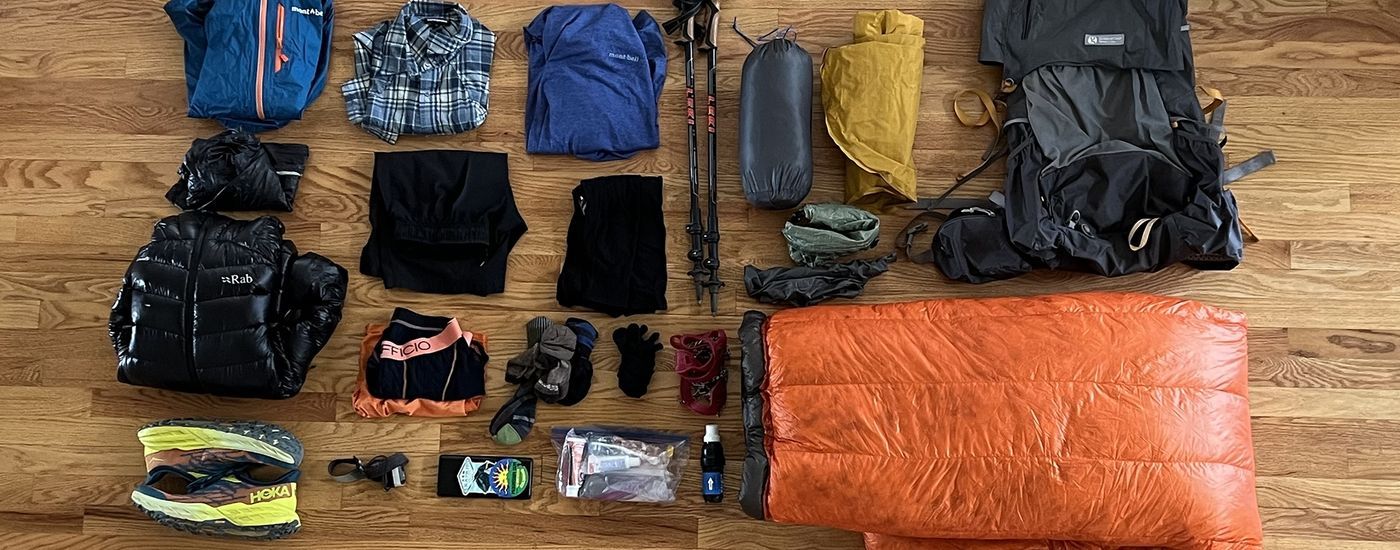
Ultralight Backpacking Gear List Quick Navigation
Shelters Backpacks Sleeping Quilts Sleeping Pads Footwear Base Layers Midlayers Rain Gear Wind Gear Socks and Undies Hiking Bottoms Gloves and Hats Sun Protection Stuff Sacks Cooking Gear (Pots/Stoves/Spoons) Trekking Poles Headlamps Water Purification First Aid Toiletries Navigation Seasonal Gear Miscellaneous Common Luxury Items

Photo by Taylor Bell.
Freestanding vs. trekking pole: If you want to go ultralight, forget the freestanding tents and hammocks. Hammocks must be beefy by definition since they have to support the weight of a full-size human, and the poles that come with freestanding tents add unnecessary weight and bulk to your pack. “Ultralight” freestanding tents are usually small and cramped, whereas tarps and trekking pole tents usually have larger footprints with room to spread out. Ultralight freestanding options also tend to rely on relatively delicate, thin fabrics to compensate for the weight of the poles. As a result, they may not be as durable as tarps and trekking pole tents.
For most hardcore ultralight backpackers, a trekking pole tent or minimalist tarp is the way to go.
Double vs. single wall: Double wall tents have an inner mesh component that is separate from the waterproof rainfly. This type of setup is great for minimizing condensation inside the living space, but all that extra mesh adds weight. Single wall tents have just one layer of waterproof material between you and the outside world, except typically for one mesh wall under the vestibule. They are the lighter option, but you must select your campsites more carefully to minimize condensation and be prepared to wipe some moisture off your sleeping bag some mornings.
One person vs. two person: The lightest one-person tent will obviously weigh less than the lightest two-person tent. Individual hikers sometimes upgrade to a two-person tent, despite the modest weight penalty, due to the increased living space. Most of the tents listed below are one-person models, but a few popular two-person shelters, such as the Zpacks Duplex and Big Agnes Fly Creek, have also been included.
Ultralight trekking pole tents by budget:
- Six Moon Designs Lunar Solo (26 oz)
- Durston X-Mid (31 oz)*
- Gossamer Gear The One (18 oz)
- Mountain Laurel Designs Solomid XL (14-16 oz)
- Lightheart Gear Solo (27 oz)
- Zpacks Duplex (18.5 oz)
- Tarptent ProTrail Li (18 oz)*
- Hyperlite Mountain Gear Ultamid 2 (17 oz)
Freestanding ultralight options (for those who really want dedicated tent poles):
- Big Agnes Fly Creek 2 (36 oz)*
- Zpacks Free Duo (30 oz)
*Weight of this tent includes all stakes necessary to pitch. Note that the non-asterisk tents on this list DO NOT include stakes in the base weight or price, though a few have the option to add stakes to the order.

Photo by Carl Stanfield.
Shaped tarps are like a tent rainfly without the bathtub floor or mesh. They have sidewalls and doors, providing a little more privacy and protection from the elements, but you will still not have protection from insects or the ground beneath you.
More basic, flat tarp configurations keep the rain off you but don’t provide privacy or full protection from the elements. They are simple to set up and are the lightest and cheapest option of all.
For those with sewing skills, you can even make your own DIY tarp.
Ultralight tarps by budget:
- Gossamer Gear Solo Tarp (7.5 oz)
- Six Moon Designs Gatewood Cape (11 oz)
- DIY Ripstop by the Roll Hex Tarp (15-16 oz)
- Six Moon Designs Deschutes Tarp (13 oz) / 16 oz Deschutes Plus includes mesh skirt
- SplitWing UL Tarp by Slingfin (8 oz)
- Mountain Laurel Designs Monk Tarp (4-8 oz)
- Zpacks Hexamid Pocket Tarp w Doors (6.1 oz)
- Hyperlite Mountain Gear Flat Tarp (9 oz)
Bug protection in a tarp:
In buggy conditions, you can pair your minimalist tarp with a bivy sack such as the Katabatic Bristlecone Bivy (7 oz) for added protection. Hyperlite and Six Moons both sell mesh inserts ( 14.4 oz and 11 oz , respectively) that pair with the tarps listed above.
READ NEXT – The Best Tents for Thru-Hiking
Shelter Accessories
Ultralight Tent Stakes
Note that many tents, especially in the cottage industry, do not include stakes with the purchase, and stakes are typically not included in the published weight of the tent. You can also set your tent up stake-free by anchoring it with large rocks or roots using extra cord.
- MSR Mini Groundhog (0.35 oz)
- Vargo Titanium Shepard’s Hooks (0.25 oz)
- @Stakes Glow-in-the-Dark Carbon Fiber Stakes (0.15 oz)
- Easton Nano Nail Stakes
Ultralight Tent Footprints
Tarp users will want to bring their own groundcloth (as will many tent users) to protect their sleeping pads and other gear from ground moisture and stabby things. DCF (1.75 oz) , Polycro (1.2 oz) , and Tyvek (4.5 oz) are all popular ultralight material choices for groundcloths.
Return to top.

ULA Ohm 2.0 . Photo by Jenn Wall.
When choosing a pack, pay attention not only to the weight of the pack itself but also to the weight and volume of gear the pack is rated to carry, the suspension system (how the pack rests against your body), and the materials it is made from.
Most ultralight backpacks consist of little more than a main compartment with a roll-top closure and shock cord compression straps, a mesh front pocket, and side water bottle pockets. Many ultralight packs don’t even come with hip belt pockets anymore (though you can always accessorize with after-market pockets or a fanny pack instead).
Framed vs. Frameless: Most packs these days have an internal metal frame that gives the pack structure so that most of the load is transferred to your hips rather than dragging on your shoulders. The frame adds weight to the setup, though. Frameless packs are lighter, but you must pack them carefully so that your gear itself gives the pack structure. Frameless packs are generally most comfortable with a sub-20-pound total pack weight. As a result, you probably want a frame for hikes requiring long food/water carries or specialty gear.
Ultralight packs by budget:
- DIY Ray-Way pack (9.5 oz)
- Gossamer Gear G4-20 (25 oz)
- Waymark EVLV (16 oz)
- ULA Ohm 2.0 (33.8 oz)
- Mountainsmith Zerk 40 (29 oz)
- Gossamer Gear Mariposa (32 oz)
- Zpacks Arc Haul Ultra (21 oz)
- Zpacks Arc Blast (20 oz)
- Mountain Laurel Designs Prophet (17 oz)
- Hyperlite Mountain Gear Southwest 2400 (32 oz)
READ NEXT – The Best Packs for Thru-Hiking
Sleeping Quilt

The Enlightened Equipment Rev-Hole-Ation quilt . Photo by Katie Kommer.
Quilts are the ultralight alternative to traditional mummy sleeping bags. Quilts are open at the back and lack a hood and zipper. They use much less material than mummy bags and are correspondingly lighter and cheaper. They are also far less constricting than traditional bags, making for a more comfortable night’s sleep.
Synthetic insulation will be cheaper than down and performs better in wet conditions, but down is far superior for ultralight purposes: its compressibility and warmth to weight ratio are unparalleled.
There are some very warm quilts on the market these days, but the warmest quilt will still be draftier than the warmest mummy bag. If you’re planning a winter expedition (or you just run really cold), the most ultralight setup may not be the right choice for you.
Ultralight quilts by budget:
- Hammock Gear Economy Burrow 20 (24 oz)
- Featherstone Moondance 25 (23 oz)
- Ray-Way DIY Quilt (25 oz)
- Enlightened Equipment Revelation 20 (23 oz)
- UGQ Outdoor Bandit (23 oz)
- Cedar Ridge Outdoors LeConte 20 (20 oz)
- Katabatic Alsek ( 22-23 oz)
- Western Mountaineering AstraLite (17 oz)
- Nunatak Arc UL 20 (22 oz)
Here are a few relatively lightweight mummy options for those of you concerned about warmth:
- REI Magma 15 (36 oz)
- Therm-a-Rest Hyperion 20 (20 oz)
- Feathered Friends Swallow 30 (25 oz)
- Western Mountaineering UltraLite (29 oz)
Sleeping Bag Liners
A sleeping bag liner is optional but is a decent way to boost the warmth of your sleep system while protecting your quilt/bag from your body oils and odors.
Ultralight liner recommendations:
- Sea to Summit Thermolite Reactor Extreme (14 oz)
- Western Mountaineering Tioga Silk Sleeping Bag Liner (3.6 oz)
READ NEXT –
- The Best Quilts for Thru-Hiking
- The Ultimate Guide to Backpacking Sleeping Bags and Quilts for All Budgets
Sleeping Pad
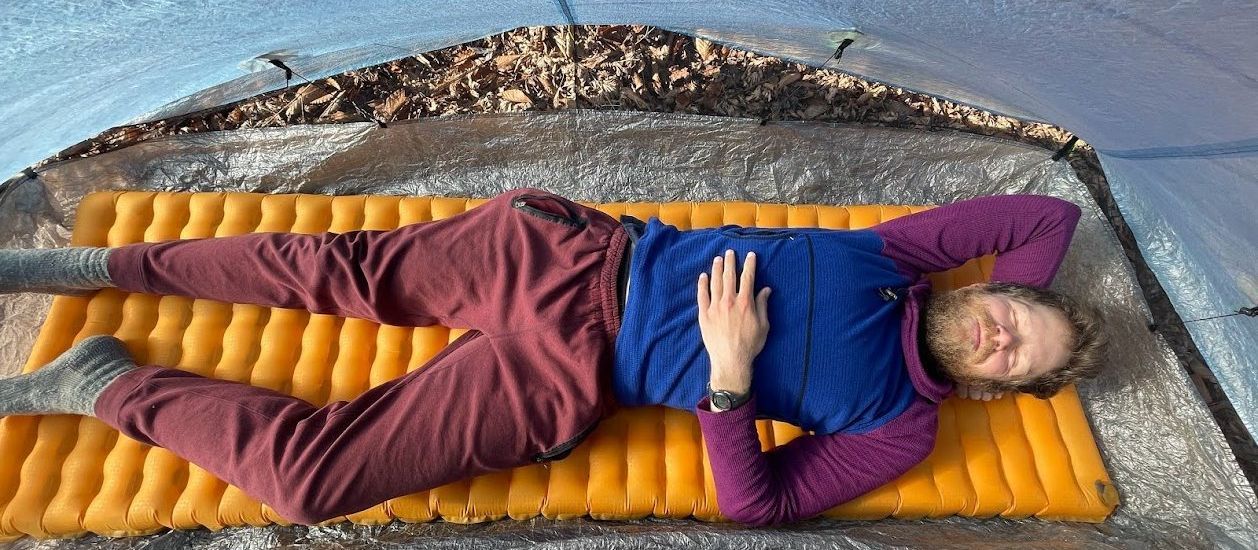
Foam vs. inflatable: Foam sleeping pads are the least expensive and are very durable, so your minimal up-front investment will almost certainly last for years. They are not as warm or as comfortable as inflatable pads, and they weigh a lot in relation to their low R-value.
R-value: This is a measure of the pad’s warmth/insulation ability. Foam pads and summer weight inflatables have R-values around 2—enough to keep you warm in summer and moderate spring/fall conditions, but not adequate for cold sleepers or true shoulder season/winter conditions. An R-value of 4 is comfortable for most thru-hikers across a range of conditions, and an R-value of 6 or more (the high end for backpacking sleeping pads) is a good choice if you run cold or plan to camp in wintry conditions.
Length: Regular-size pads are typically around 72 inches long by 20 or 21 inches wide. Short or three-quarter length pads are around 60 inches long and weigh less since they use less material. Tall hikers can simply put extra clothing and gear (or even their entire backpack) underneath their lower legs, where they hang off the end of the pad. Many inflatable pads come in a rectangular or mummy configuration. The tapered shape of a mummy pad uses less material and weighs less than a rectangular pad.
Ultralight sleeping pads by budget:
- NEMO Switchback (14.5 oz)
- Therm-a-Rest ZLite Sol (14 oz)
- Sea to Summit Ultralight Insulated Air (16 oz)
- Uberlite (9 oz)
- XLite (12 oz)
- XTherm (15 oz)
- NEMO Tensor Insulated (14.5 oz)
Supplemental pad: Many hikers use a thin foam pad, such as Gossamer Gear’s 1/8-inch Thinlight Pad (2.7-3.3 oz) , beneath their inflatable to boost the R-value and prevent popping.
READ NEXT – The Best Sleeping Pads for Thru-Hiking

Altra Lone Peak 6.
It’s said that a pound of weight on the feet is equivalent to five pounds on the back in terms of energy expenditure. Trail runners weigh less than boots. They’re also more breathable and dry more quickly. For all these reasons, they have eclipsed boots in popularity among thru-hikers. There isn’t much variability in price and weight within the boot and trail runner categories, respectively, so hikers looking to save weight will get the most bang for their buck by switching from any boot to any trail runner.
(For those who like a little more stability in their footwear, low-top hiking shoes or high-top trail runner adaptations are a good compromise.)
Are waterproof shoes worth it? We generally don’t reccomend waterproof shoes because, when they inevitably do get wet, they take much longer to dry than standard hiking footwear. That being said, waterproof shoes can shine in cold, wet weather—late winter or early spring on the Appalachian Trail is a great example of prime waterproof shoe weather.
Note on camp shoes: Camp shoes are very much a luxury item, so the simplest and lightest solution here is to simply not bring them. Particularly if you wear quick-drying, breathable trail runners, you simply may not need an extra pair of shoes just to wear around camp for a few hours per day (at most). However, if you really want a change of shoes, a pair of $5 flip-flops or significantly primer (but more durable) Xero sandals will do the trick.
Ultralight trail runner recommendations:
- Brooks Cascadia (Women’s – 18 oz | Men’s – 19 oz)
- Salomon XA Pro 3D V8 (Women’s – oz | Men’s – 24 oz)
- Altra Lone Peak ( Women’s – 18 oz | Men’s – 21 oz)
- Altra Olympus ( Women’s – 18 oz | Men’s – 22 oz)
- La Sportiva Bushido II (Women’s – 18 oz | Men’s – 21 oz)
- Hoka ONE ONE Speedgoat ( Women’s – 17 oz | Men’s – 20 oz)
- Hoka ONE ONE Challenger ATR ( Women’s – 18 oz | Men’s – 20 oz)
- Inov-8 Trailfly G 270 ( Women’s – 19 oz | Men’s – 19 oz)
- Topo Ultraventure ( Women’s – 17 oz | Men’s – 21 oz)
^Not separated by budget because most trail runners cost about the same.
Ultralight boot/hiking shoe recommendations (for those who want more stability):
- Altra Lone Peak Mid (Women’s – 24 oz | Men’s – 30 oz)
- Hoka ONE ONE Speedgoat Mid ( Women’s – 23 oz | Men’s – 25.5 oz)
- Merrell Moab 2 Ventilator Hiking Shoes ( Women’s – 28 oz | Men’s – 31 oz)
- Keen Targhee Vent Hiking Shoes ( Women’s – 25 oz | Men’s – 30 oz)
Ultralight camp shoes by budget:
Low: No camp shoes at all, also the lightest option; foam flip flops High: Xero shoes (Women’s – 8.6 oz | Men’s – 10.8 oz)
Insoles: Many hikers find aftermarket insoles, especially Superfeet , more comfortable than the flimsy ones that come standard in most hiking shoes.
Gaiters: Gaiters are optional, but they are excellent for keeping sand, pebbles, and other trail debris out of your shoes for a minimal weight penalty (and a maximal fashion statement).
- Dirty Girl Gaiters
- Altra Trail Gaiters
- The Best Trail Runners for Thru-Hiking
- Gear Wars: Trail Runners vs. Boots
Base Layers
As with most apparel on this list, the ultralight solution isn’t necessarily to wear lighter clothing but rather to carry less. Limit yourself to one set of hiking base layers and (at most) one set of camp base layers. Many ultralighters don’t even bring a change of clothes for camp.
Consider the temperature when packing clothes. In summer, you might hike in a thin T-shirt or sun hoodie and shorts (nice and light), while in winter, you would need thicker fabrics. Those who run warm will always have an edge in the ultralight department since they’ll be able to get away with less material.
Base layers by budget:
- Patagonia Capilene
- REI Midweight Synthetic
- Smartwool Intraknit
- Icebreaker Merino
Summer hiking shirt recommendations (because you don’t ALWAYS need a base layer)
- Jolly Gear Triple Crown Button Down Sun Hoodie (8.5 oz men’s medium)
- Mountain Hardwear Crater Lake Sun Hoodie Women’s (4.2 oz) | Men’s (4.2 oz)
- Columbia PFG Tamiami Women’s (weight unavailable) | Men’s (9.6 oz)
- Outdoor Research Echo Sun Hoodie Women’s (2.3 oz) | Mens’ (4.3 oz)
- Smartwool Merino Sport 150 Tech T-shirt Women’s | Men’s (weights unavailable)
- Patagonia Capilene Cool Trail Shirt Women’s (weight unavailable) | Men’s (5.3 oz)
- Any activewear shirt

Enlightened Equipment Torrid Jacket . Photo by Owen Eigenbrot.
A hiking fleece or insulated (puffy) jacket will serve as your mid-layer. Some hikers opt to carry both, but the ultralight solution is to just pack one or the other. Fleeces are more durable and better suited to active wear, but puffies, whether down or synthetic, tend to have a better warmth-to-weight ratio.
Ultralight fleeces by budget:
- Decathlon Quechua MH120 Women’s (9.5 oz) | Men’s (12 oz)
- Lightheart Gear Fleece Hoodie (Unisex – 10 oz)
- Mountain Hardwear Microchill Women’s (8.2 oz) | Men’s (5.9 oz)
- Senchi Designs Lark Hoodie (Unisex – 5 oz)
- Rab Alpha Flash Women’s (7 oz) | Men’s (9.6 oz)
- Mammut Aconcagua Women’s (9.3 oz) | Men’s (11.3 oz)
Ultralight puffies by budget:
- Decathlon Forclaz Trek 100 Women’s (9.7 oz) | Men’s (10.2 oz)
- REI 650 Down Jacket Women’s (10.8 oz) | Men’s (11 oz)
- Enlightened Equipment Torrid Apex Pullover Women’s (7.5 oz) | Men’s ( 8.5 oz)
- Montbell Superior Down Parka Women’s (7.7 oz) | Men’s (8.7 oz)
- Montbell Plasma 1000 Women’s (4.1 oz) | Men’s (4.7 oz)
- Mountain Hardwear Ghost Whisperer UL Women’s (6.2 oz) | Men’s (6.7 oz)
- Patagonia Micro Puff Women’s (7.3 oz) | Men’s (8.3 oz)
- The Best Down Jackets for Thru-Hiking
- The Best Synthetic Jackets for Thru-Hiking
- The Best Hiking Fleece Jackets
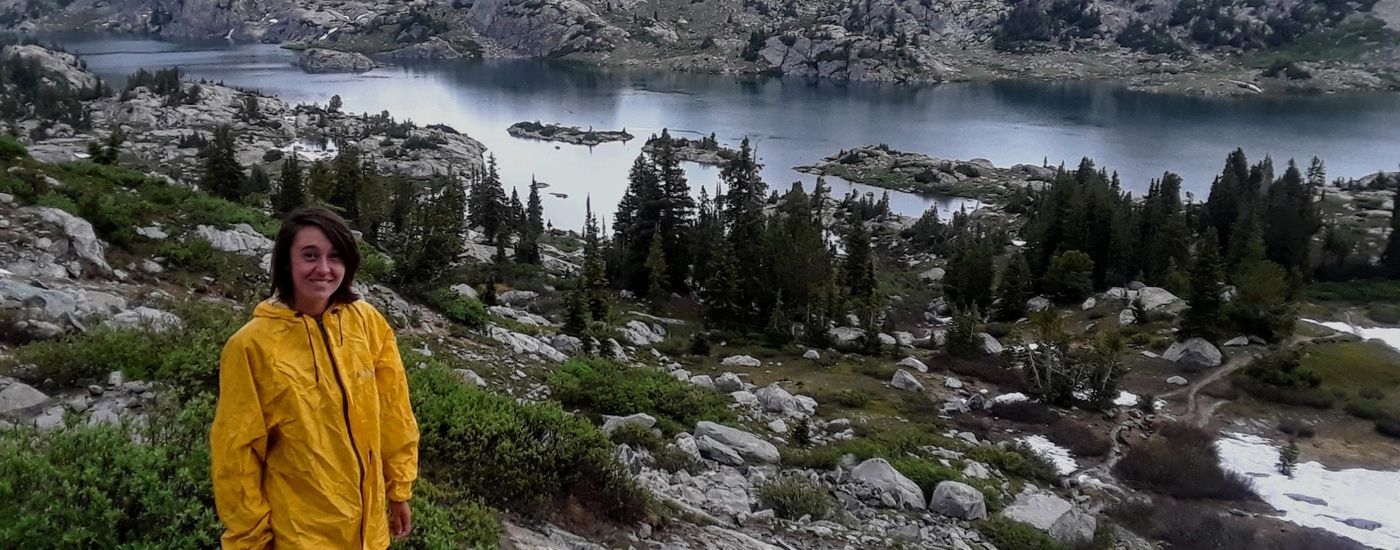
Frogg Toggs . Photo via Eloise Robbins.
A good rain jacket will keep you warm in cold, driving rain, even if it doesn’t keep you dry (because sweat is a thing). For most thru-hikers, rain pants are unnecessary, but a rain jacket is non-negotiable. You don’t have any vital organs in your legs, after all, and you can typically keep them warm simply by hiking.
Eliminating bulky, heavy rain pants is a no-brainer for an ultralight backpacking gear list, although you should bring them on winter expeditions for added warmth and safety. If you want some protection for your lower half in three-season conditions, a rain skirt or a pair of ultralight wind pants (see next section) are more breathable alternatives to rain pants.
Ultralight rain jackets by budget:
- Frogg Toggs UltraLite2 ( 5.8 oz measured weight for men’s small)
- LightHeart Gear Rain Jacket (Unisex – 6 oz )
- Outdoor Research Helium Rain Jacket Women’s (5.6 oz) | Men’s (6.3 oz)
- Zpacks Vertice Women’s (5.1 oz) | Men’s (6.5 oz)
- Enlightened Equipment Visp Women’s (5.3 oz) | Men’s (5 oz)
- Montbell Versalite Women’s (5.8 oz) | Men’s (6.4 oz)
- The Best Rain Jackets for Thru-Hiking
- Why $20 Frogg Toggs Are the Ideal Thru-Hiking Rain Gear
Lighter and more breathable than rain gear, a wind jacket and pants add little weight or bulk to your pack and provide a significant boost in warmth if needed. Because waterproof gear is also windproof, dedicated wind gear is definitely a luxury, and the ultralight-est decision would be to do without. However, for those who run cold or venture out in unpredictable high mountain conditions, they provide a nice bit of added safety and warmth.
Ultralight wind gear by budget:
Low: none; just use your rain jacket instead High:
- Montbell Tachyon parka (2.5 oz) and pants (2 oz)
- Enlightened Equipment Copperfield Wind Shirt (2 oz) and Pants (1.3 oz)
Socks and Undies
Again, it’s not about choosing a pair of socks that’s three grams lighter than the competition so much as it’s about limiting the number of pairs you bring. It’s a good idea to have one backup pair for hiking for the sake of blister/infection prevention, so we’ll endorse the concept of an extra pair even in an ultralight gear list. You only need one pair of camp socks at most, for a grand total of two or three pairs.
Sock recommendations:
- Darn Tough Micro Crew
- Smartwool Hiking Socks
- Farm to Feet Hiking Socks
- Injinji Toe Socks
Underwear: Many hikers simply go without—after all, do you really need them?—but this is a personal choice determined largely by your comfort level and tendency to chafe.

Underwear by budget:
Low: None, just go commando High: Ex Officio Give-n-Go
Low: Any sports bra that already works well for you High:
- Icebreaker Sprite merino sports bra
- Patagonia Barely
Hiking Bottoms
Shorts are obviously lighter and more breathable than pants and are undoubtedly more popular among thru-hikers. However, pants protect you more from sun, bugs, cuts and scrapes, and cold weather.
Hiking bottoms by budget:
- Any pair of athletic shorts/tights
- Patagonia Baggies Women’s (5 oz) | Men’s (7 oz)
- Prana Halle / Stretch Zion pants
- Fjallraven Abisko trail tights
- Purple Rain Adventure Skirt (5.7 oz)
Dark horse candidate: Hiking dress. Fewer moving parts, fewer ounces, infinite joy. As a bonus, any synthetic dollar store dress will work fine.
Gloves and Warm Hats
Gloves: Most hikers find that a pair of merino or synthetic liner gloves will suffice for most conditions.
An added pair of rain mitts (2 oz) can help coldfingers to continue functioning in cold rain or when filtering water on a winter morning. Like a rain jacket, rain mitts provide a significant boost in warmth all on their own. You can also use dish gloves as a budget-friendly alternative.
Hats: Any wool or synthetic beanie will do. If your mid-layer jacket has a hood and you run warm, you may get away without a hat altogether.
Sun Protection

Photo by Owen Eigenbrot.
First, ask yourself what kind of sun exposure you expect on your upcoming hike. You won’t need much sun protection in the AT’s green tunnel, for instance, but you better be prepared to pull out the big guns for the PCT’s desert section.
Basic sun protection:
- Polarized sunglasses (any—don’t have to be expensive) and
- Trucker or ball cap paired with a sun hoodie, buff , or bandana to protect ears and neck or
- Full brim hat to protect same
- Small sunscreen (may be necessary on very sunny hikes)
- Optional: sun gloves
- Optional: chrome sun umbrella (6.6 oz)
Pro tip: Forget the expensive sunglasses case: an empty Crystal Light container is both cheaper and lighter.
Stuff Sacks
The ultralight solution is to not use stuff sacks—just pack your clothing, sleeping bag, etc. loose inside the pack. The pack will load better this way anyway, as your soft goods will fill any awkward gaps. To ensure that your gear stays dry in wet weather, line the entire main compartment of the backpack with a large trash compactor garbage bag.
For a little more organization and rain protection, you can use large ziplock bags in place of stuff sacks.
Stuff sacks by budget:
Low: None, ziplock bags High: Sea to Summit Ultrasil dry bags (0.7 – 2.3 oz) , Zpacks DCF dry bags (0.5 – 1.1 oz)
Cooking Gear

Photo by Sage Friedman on Unsplash.
The ultralight solution is to go stoneless and cold soak your meals. Going stoveless saves you the weight of the stove, fuel, and possibly pot, but if you’re just carrying fresh foods that don’t need to rehydrate (tortillas, cheese, etc.) in place of freeze-dried or dehydrated dinners, you won’t save much (if any) weight because those foods tend to weigh more.
Those who like a hot meal or their morning coffee can still go ultralight while carrying a full stove and fuel setup. Learning strategies to maximize fuel efficiency (heating fuel with your body heat before using, cooking in sheltered areas, etc.) will help you save fuel weight between resupplies.
Minimalist canister stoves are among the most popular lightweight options, but clunkier integrated systems (such as Jetboils) are still viable because their weight accounts for not only the stove but also the integrated pot and windscreen. Integrated stoves are also more fuel-efficient.
Alternative fuel stoves: Alcohol and solid fuel stoves are almost always the lightest options have their own drawbacks. Alcohol stoves are often not very fuel efficient, so you end up carrying more fuel, while solid fuel stoves tend to leave a residue on the bottom of your pot. Alternative fuel stoves also lack an on/off valve, which is a requirement in many fire-prone areas of the US west.
Ultralight stoves by budget:
- BRS 3000T (0.9 oz)
- DIY Super Cat Stove (<0.5 oz)
- SnowPeak Litemax (1.9 oz)
- Soto Amicus (2.9 oz)
- Jetboil Stash (7.1 oz)
- MSR PocketRocket (2.6 oz)
Windscreen: A piece of aluminum foil will suffice for most setups.
Lighter: Even if your stove has an igniter, you should always bring a mini Bic lighter just in case. Piezo igniters are extremely unreliable.
Ultralight pots by budget:
- Toaks Light Titanium Pot (2.6 oz)
- Sea to Summit X-Pot 1.3L Kettle (6.5 oz)
- MSR Titan Kettle (4.2 oz)
- Vargo Bot ( 4.8 oz ; also useful for cold soaking or as water bottle)
- Evernew Pot ( 1.7 – 4.6 oz )
Ultralight spoons by budget:
Note: don’t bother with forks or sporks; you don’t really need tines and they’re too much of a liability. Long-handle spoons are the way to go whenever possible, as they’re much more functional in freeze-dried food packs.
- Wendy’s spoon
- Toaks Titanium Long Handle Spoon (0.7 oz)
- Sea to Summit Alpha Light Long Spoon (0.4 oz)
Overnight food storage:
You must secure your food and other smellable items overnight to protect them from wildlife. This is both for your sake and that of the animals. Bear canisters are heavy and uncomfortable, but they are required in some areas. An Ursack is a much lighter alternative to a canister in areas where bears are active, but canisters aren’t required. In areas with a lower risk of human-wildlife encounters at campsites, a regular waterproof bag hung from a tree branch will suffice. Click here to read more about how to do a proper bear hang.
- 40-plus feet of paracord (3 oz) and
- Small rock bag (0.17 oz) for throwing cord and
- Ultralight dry bag (1.2 oz) or Ursack (7.6 oz) or
- Zpacks bear bagging kit (3.4 oz) (all of the above in one UL package) or
- Bear canister (low budget: BV500 (40 oz) , high budget: Wild Ideas Berikade (28-36 oz)*
*Not IGBC-compliant , might not be acceptable in some places.
READ NEXT – The Best Stoves for Thru-Hiking
Trekking Poles

Gossamer Gear LT5 Trekking Poles . Photo by Owen Eigenbrot.
While some hikers choose to forego trekking poles, most long-distance hikers use them. They save your knees on the downhills (to say nothing of your face should you accidentally stumble) and give you extra power on the climbs. As a bonus, you can use them to set up your ultralight tent.
Carbon fiber vs. aluminum: Carbon fiber poles are lighter than aluminum but also much more expensive. Carbon fiber poles are also more brittle: they tend to snap under stress, whereas aluminum pole are more likely to bend.
Cork vs. foam grips: Cork grips theoretically reduce the likelihood of blisters on your hands, but they also absorb salt that attracts sodium-craving critters at night. Foam grips can leave a black residue on your hands but are more economical.
Ultralight trekking poles by budget:
- Leki Legacy Lite (18 oz)
- REI Trailbreak (17 oz)
- Black Diamond Trail Ergo (18 oz)
- REI Flash Carbon (13.6 oz)
- Gossamer Gear LT5 (9.8 oz)
- Black Diamond Alpine Carbon Cork (17.1 oz)
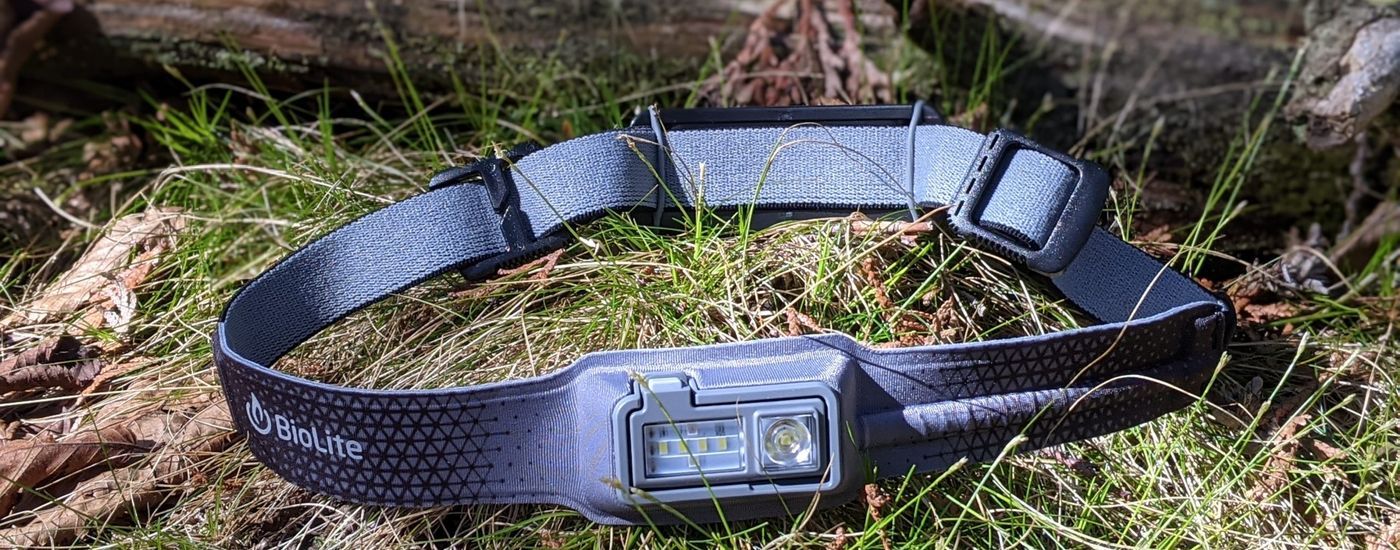
Biolite Headlamp 330 . Photo by Eloise Robbins.
Pay attention to battery life, lumens, red light, and locking features when shopping for a headlamp. Hikers who rarely night hike won’t need as big of a battery or as much light output as those who regularly take to the trail when it’s dark out.
Some headlamps have rechargeable batteries, saving you the weight of extra AAAs if you already carry a battery bank for your phone and other electronics.
Another way to reduce the weight of your headlamp is to remove the heavy head strap and replace it with a loop of lightweight shock cord.
Ultralight headlamps by budget:
- Nitecore NU25 (1.9 oz)
- Coast FL1R (1.1 oz)
- Petzl Actik Core (2.6 oz)
- Biolite Headlamp 330 (2.4 oz)
- Black Diamond Spot 400 (2.7 oz)
READ NEXT – The Best Headlamps for Thru-Hiking
Water Purification
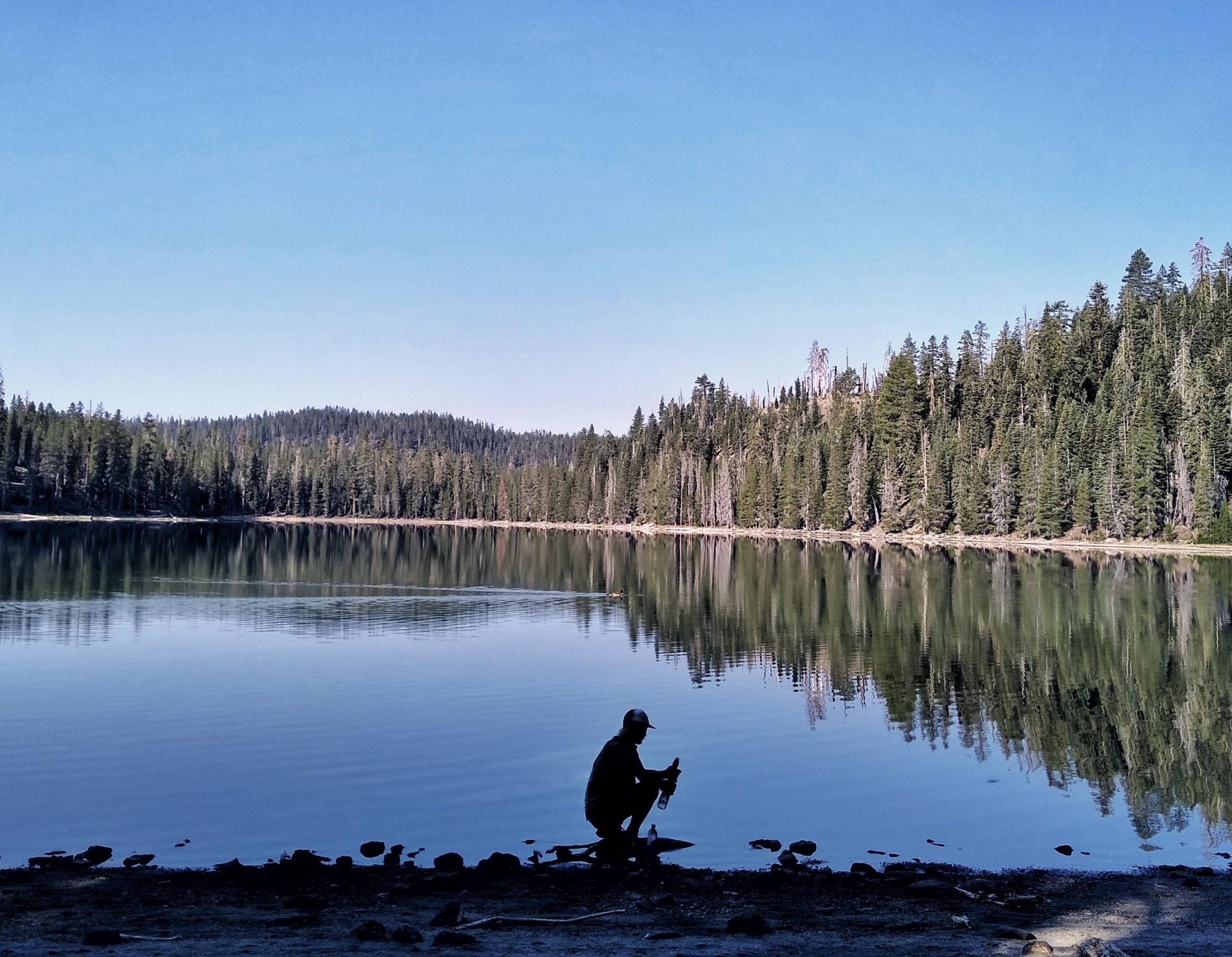
Photo by J Taylor Bell.
Avoid heavy, cumbersome pump filters, as well as elaborate UV setups unless you’re winter camping or have good reason to believe there may be viral pathogens in your water sources (typically not an issue in North America). It’s worth noting that none of the listed options remove pollutants such as heavy metals or farm runoff.
The ever-popular Katadyn BeFree and Sawyer Squeeze are both affordable, lightweight, and effective.
Chemical purification drops/tablets are also viable options, but they take time to work and are more expensive in the long run since you have to continue buying more.
Note on the Sawyer line of water filters: although the traditional Sawyer Squeeze isn’t the lightest filter in the lineup—that honor belongs to the Mini—it is the most reliable in terms of flow rate and cloggability (new word?).
Ultralight water purification by budget:
- Aquamira droplets (3 oz when full)
- Sawyer Squeeze (3 oz)
- Bleach in an eyedrop bottle
- Katadyn BeFree (2.3 oz)
- Platypus Quickdraw (3.4 oz)
Water Containers
Leave the heavy-ass Nalgenes and tiresome Camelbaks at home and just stick with a couple of one-liter Smartwater bottles, which you can replace every so often in town. Smartwaters mate with the Sawyer Squeeze, are relatively durable for disposable bottles, and weigh next to nothing. The only time you might want a Nalgene is on a winter hike, as the more durable Nalgene can be filled with boiling water to make a hot water bottle for your sleeping bag at night.
The most ultralight water system would consist of one water purification system (chemicals or a device like the Squeeze or BeFree) and two Smartwaters—one of which you designate as a “dirty” or collection bottle.
Optional: one or two collection bags like the Evernew (1.5 oz) or Cnoc Vecto (2.6 oz) —these add weight but make collecting and squeezing dirty water much easier, and you can preserve both of your Smartwaters as clean water reservoirs. An extra collection bag or two also expands your water carrying capacity for long, dry stretches.
Optional Part Two: If you use the Sawyer Squeeze, the double-female Sawyer cleaning coupling (0.2 oz) can mate your Squeeze to your clean water reservoir for a leak-free gravity filtration system.
READ NEXT – Katadyn BeFree vs. Platypus Quickdraw vs. Sawyer Squeeze
First Aid / Emergency Kit
Your first aid kit should contain a spread of basic medical supplies without going overboard. Ideally, your first aid supplies should all fit inside a snack-size ziplock bag.
First Aid / Emergency:
- Ibuprofen/Acetominophen
- Antidiarrheal
- Antihistamine (diphenhydramine)
- Assorted bandaids
- Triple-antibiotic ointment
- Alcohol prep pads
- Leukotape (blister prevention)
- Prescription medications
- Mini Bic lighter (if not already included in cooking kit)
- Sewing needle (wrap in tape to keep from stabbing)
- Duct tape or Tenacious Tape
- DCF repair tape (if you have DCF gear)
- Superglue or Aquaseal
- Inflatable sleeping pad patch (comes standard with most pads)
People like to make fun of backpackers for sawing their toothbrushes in half, but hear me out—it really does make sense, if only because you don’t need an ungainly seven-inch handle messing up the dimensions of your toiletries bag.
As a backpacker, you will stink and be disgusting no matter what. Beyond basic hygiene, there’s not much point to bringing lots of toiletries. Leave the baby wipes and deodorant at home.
- Floss (doubles as strong thread for gear repairs)
- Keychain hand sanitizer
- SPF lip balm
- Menstrual supplies: tampons and/or menstrual cup (e.g. Diva cup)
- Extra hair ties
Poopin’ and Peein’ Supplies

- Toilet paper and ziplock bag to pack out used TP or
- Culo Clean (0.4 oz) backcountry bidet
Trowels by budget:
Low: Snow stake (1 oz) ; trekking pole or ice axe tip High: The Deuce (0.6 oz)
Female urination:
- Pstyle pee funnel ( 0.8 oz ; optional)
- Pee rag: bandana or Kula cloth (0.4 oz)

Garmin inReach Mini (2020 version). Photo by Hugh Owen.
Many long-distance trail guides are now available in the FarOut smartphone app, adding nothing to your pack. However, even if this is the case (and especially if it isn’t), it’s always a smart idea to have a secondary, hard-copy method of navigation. This could mean a map and compass (our compass recommendation: Suunto M-3 D Leader Compass (1.6 oz) or a trail-specific guidebook.
Thru-hikers using a paper guidebook can just carry a small handful of relevant pages at one time and mail future page bundles ahead to themselves. Discard pages after you’ve finished them.
GPS Devices
GPS devices that are functional for navigation are typically larger, heavier units such as the Garmin GPSMAP 66i. Most thru-hikers and backpackers prefer to stick with smaller, lighter units. Although they have less navigation capability, they can still help hikers to “stay found” via features like two-way satellite communication, tracking, and SOS. GPS smartphone apps such as Gaia GPS, Caltopo, and Avenza are weightless and, frankly, easier to use than navigation-enabled GPS devices.
Ultralight GPS recommendations:
- ZOLEO Satellite Communicator (5.3 oz)
- Garmin inReach Mini (3.5 oz)
- Spot Gen 4 (5 oz)
Seasonal Gear
You won’t need all of this gear on every hike—it depends on the region and season in which you’re hiking.
- Insect headnet (1.3 oz) (depends on trail and season)
- Bug spray (Deet, picaridin, or Lemon oil of eucalyptus)
- Microspikes
- Bear Spray (11 oz – only necessary in grizzly country)
Microspike recommendations:
- Kahtoola MICROspikes (11 oz)
- Hillsound Trail Crampons (16 oz)
Ice axe recommendations:
- CAMP Corsa (7 oz)
- Black Diamond Raven (16-17 oz)
- Grivel G1 (16 oz)
- Black Diamond Whippet pole * (16 oz)
*trekking pole with ice axe attachment; approximates the function of a real ice axe
Miscellaneous
- Wallet (credit card, ID, insurance card, cash in Ziplock or DCF )
- Mini Swiss Army Knife (0.7 oz)
Common Add-Ons and Luxury Items
Going ultralight doesn’t mean you can’t bring any luxury items—it just means you should be judicious in what you choose to bring. All of the items on this list are extras. Once you have your main setup wired together and know how much it weighs, you can pick and choose a few luxury items to round out your pack.
- Camp shoes (see footwear section)
- Camp pillow (2.7 oz)
- Sit pad (1.1 oz)
- Cork massage ball (1.4 oz)
- Battery bank (6.3 oz) and charging cables
- Notebook (2.1 oz) and pencil
Featured image: Graphic design by Chris Helm ( @chris.helm ).

This website contains affiliate links, which means The Trek may receive a percentage of any product or service you purchase using the links in the articles or advertisements. The buyer pays the same price as they would otherwise, and your purchase helps to support The Trek's ongoing goal to serve you quality backpacking advice and information. Thanks for your support!
To learn more, please visit the About This Site page.

We are the word nerds of The Trek who want nothing more than to infuse some hiking and backpacking joy into your day.
Comments 15
I’ve seen this a few times. Why do you say bear spray is only necessary in Grizzly country? Has nobody been attacked by a black bear? I’ve been charged by a black bear sow myself… Bear spray stopped her cold.
Any reason Cedar Ridge Outdoors quilts aren’t in this list? Their Helium weighs less than 16oz for a true 20 degree quilt. Seems fitting since this is supposedly the ultimate UL backpacking list.
I’m not sure what hammocks you’re using, but my complete hammock set up weighs 36oz which inludes the hammock, tarp with tieouts, stakes & snakeskins, and tree straps.
Yeah right out the gate I could tell the author’s SUL chops were going to be lacking when they said “right out the gate you can forget the hammock…” Really? A 7 oz Hummingbird with a 2 oz full strap system, AND you can totally ditch the weight sleeping pad, or even an underquilt, if you sleep in a pea-pod bag the hammock threads through. Blows my mind how out of touch with reality some ground-bound hikers can be.
Thanks for your insight. I was wondering about the hammock comment, too.
What Do You Think? Cancel reply

Item added to your cart
Gear guides.
- Ultralight Backpacking Gear
- Best Ultralight Backpacks
- Best Ultralight Sleeping Bags
- Best Ultralight Tents
- Best Camp Shoes
- Best Down Jackets
- Best Rain Jackets
- Best Minimalist Sandals
Tips and How-To's
- Ultralight Backpacking Tips
- Animal Tracks ID Guide
- Contour Lines and Topo Maps
- How to Read Trail Signs
Food and Water
- Backpacking Food Ideas
- Backpacking Meal Recipes
- Best Meal Replacement Powders
- How Many Calories Do I Burn Backpacking?
- The Triple Crown of Hiking
- Appalachian Trail Map
- Gifts for Hikers
- What is Naked Hiking?
Ultralight Backpacking Gear List | 8 lb Base Weight (Full Comfort)
An overview of ultralight, an ultralight backpacking gear list and breakdown..

© Cara Dixon
WEIGHT BREAKDOWN
Base Weight: 8.07 lbs Shelter + Pack + Sleep System + Kitchen + Water Storage + Packed Clothing + Electronics + First Aid Kit + Extras
Consumables: 7 lbs Toiletries + Food + Water + Stove Fuel
Worn Weight: 2.99 lbs Worn Clothing + Footwear + Accessories
TOTAL WEIGHT: 18.06 lbs

Shelter is often the first thing people think about when they think about backpacking. Your shelter is part of your “big three” - shelter, pack, and sleep system. These are the heaviest items and often the first items targeted when trying to go ultralight.
Shelters include a tent, tarp, hammock, or bivy. If you want to get your shelter system even lighter, go for a non-freestanding tent . These tents rely on your trekking poles for their support.
Additionally, some hikers choose to carry a footprint to protect the bottom of their tent from abrasion in rockier areas and protect in wet conditions.
A thin plastic drop cloth is cheap, light, and surprisingly durable. I’ve been using the same piece of plastic for 100+ nights!
Recommended:
- Zpacks Hexamid (11.9 oz) : Made with super light and durable Dyneema fabric and a generous 47” peak height the this tent is worth getting a little spendy on. Note this is a non-freestanding and requires trekking poles to set up. The listed weight includes 8 titanium stakes.
- Big Agnes Fly Creek HV UL1 (27.0 oz) : Ligthweight and durable tent for those that prefer the stability of a freestanding tent.
- Tyvek or 2mm painter’s drop cloth (1.0 oz) : A piece of either of these will work well as a footprint.

Packs come in many shapes, sizes and capacities. As one of your big three items, aim for two pounds (or less!) for weight. Ultralight packs generally have a simple design, keeping the feature list, and therefore the weight, to a minimum.
Aim for 36 to 60 liter of capacity. You’ll need more capacity for longer trips or if you need to carry additional items like a bear canister.
Many ultralight packs are frameless. If you go this route make sure not to exceed the maximum recommended weight otherwise it will become uncomfortable to carry.
Speaking of comfort, choose a pack that is the correct torso length, is breathable, and has a cushioned back panel.
Adding a pack liner like a thin trash compactor bag keeps your gear dry.
- Red Paw Packs Front Range 40L (10.4 oz)
- Gossamer Gear Murmur (12.5 oz) : This pack keeps the design simple and weight low (36L capacity). The removable back panel doubles as a seat pad, a nice bonus.
- SWD Long Haul (32.5 oz) : If you need more space or prefer an internal frame, the SWD Long Haul has a generous 60 liters of capacity.
- Trash compactor bag (0.5 oz) : A trash compactor bag is an inexpensive, easily replaceable option for keeping moisture out of your pack.
Sleep System
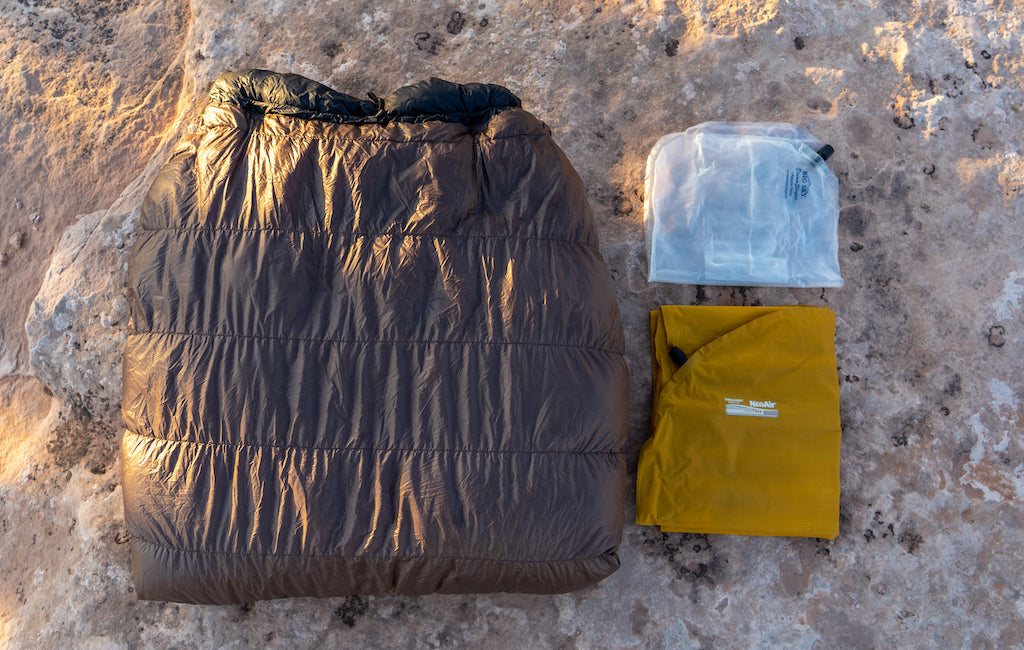
Your sleep system makes up the last of your big three. Sleeping bags come as either traditional bags or quilts. Quilts work like a quilt on your bed laying over the top of you. They don’t go all the way around you like a traditional sleeping bag. This saves both weight and space.
For fill, down feathers are lighter and more compact than synthetic fill, but more expensive. A higher temperature rating will be lighter but less versatile. For me, a 30-degree bag is a sweet spot between weight and warmth for most three-season conditions.
When choosing a sleeping pad , focus on both comfort and insulation. Inflatable pads provide the most comfort but are prone to punctures. Foam pads are foolproof but bulky to carry. Insulation is measured in R-value. The higher the R-Value the more insulation the pad provides. For three-season backpacking, target an R-Value between 2.0 and 4.0.
A pillow can be a specialized item or simply some clothes stuffed into a stuff sack.
- Katabatic Palisade (18.4 oz)
- Enlightened Equipment Revelation 30F (16.9 oz) : A great price for the featherlight weight, the Revelation is a stalwart in the ultralight community.
- NeoAir XLite (12.5 oz) : The NeoAir is a go-to ultralight inflatable sleeping pad with great comfort and R-value.
- Big Sky Dream Sleeper (2 oz)
- Hyperlite Stuff Sack Pillow (1.2 oz) : One of my personal favorites. Works as a stuff sack by day and a fleece-lined pillow at night.
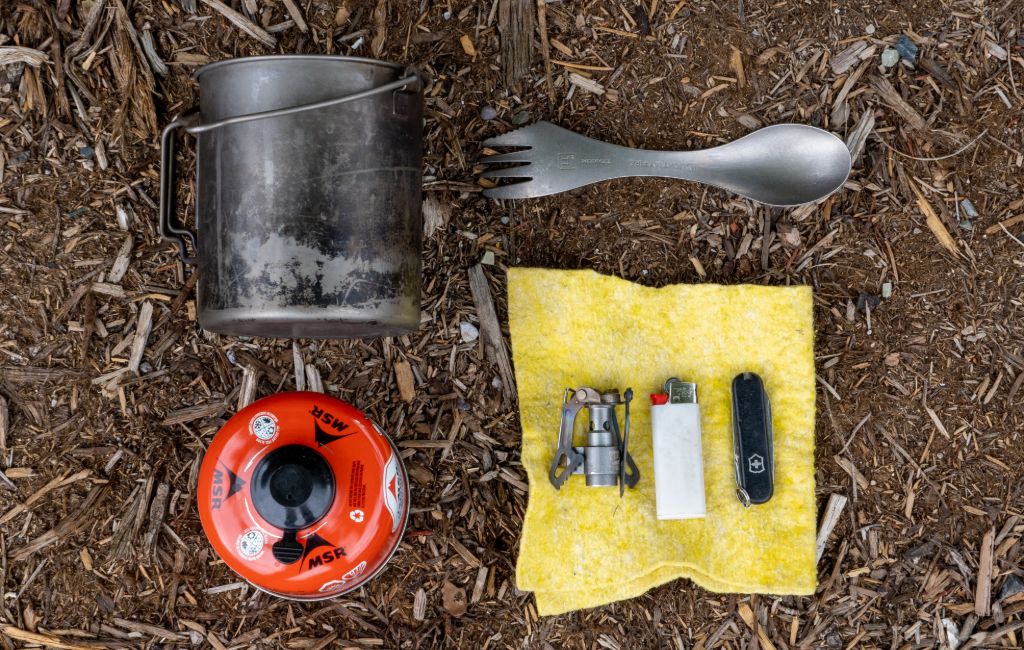
Your camp kitchen is customizable depending on the type of food you like to eat on the trail. If you enjoy spending time cooking at camp it may take up more weight. If you’re trying to shave weight you might opt to go stoveless (or you could order a bunch of these meals :) ).
The best stove is a simple canister stove. These stoves are light, provide a stable cooking surface and boil water quickly. They are easy to attach and use with any pot. Alcohol stoves have been a popular ultralight DIY stove for years. However, due to increasing wildfire danger in the west, they are often banned during peak season. Best to steer clear.
For a pot and a spork look for lightweight materials like titanium. A larger knife is only needed if you plan on doing a lot of chopping or slicing. If not, skip this and use the small knife on your multitool.
- BRS 3000T (1 oz)
- SnowPeak GigaPower (4.2 oz) : The GigaPower is a durable stove designed to pack down small and provide superior stability for your pot.
- Toaks Titanium 750 ml (3.9 oz) : A favorite functional pot, Toaks Titanium’s shape and handles allow it to double as a pot and a mug.
- Light My Fire Spork (1.1 oz)
- Sea to Summit Spork (0.5 oz) : Hard to top the functionally, weight, and durability of this classic spork design.
- Victorinox Classic SD (0.7 oz)
- Knife/Multitool Leatherman CS (1.4 oz) : The small knife on the Leatherman CS works well for basic slicing.
- Bic Mini (0.5 oz) : Easy to use even when wet and found nearly everywhere this is an essential item to pack for cooking and as an emergency fire starter.
- Nano Packtowl (0.4 oz) : Pro tip: Cut the Nano Packtowl in half to make a 5” by 7” dishcloth.
Water Filtration and Storage
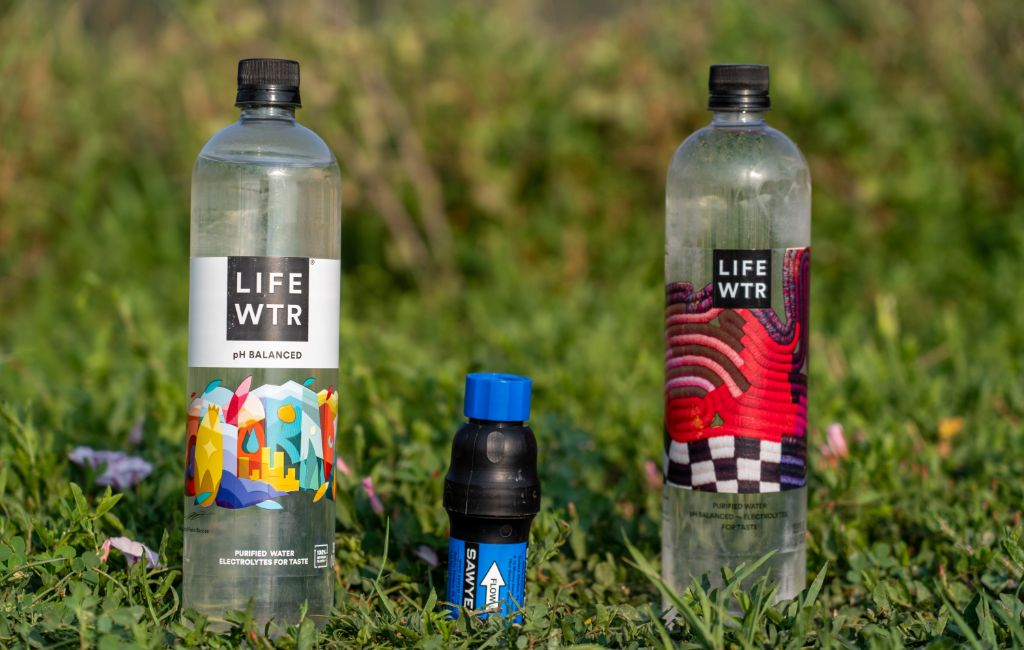
In the backcountry, it’s imperative that you can filter water along the trail. A good water filter will be easy to use, clean, and have a fast flow when filtering. It’s also best practice to have a backup method of purification in case your filter breaks. This can be boiling over your stove or carrying a few purification tabs , like Aquatabs, for emergencies.
It’s important to have enough water storage in case water is scarce or you need to make a dry camp. It also is nice at camp to limit the number of trips back and forth to your water source. A collapsible bladder is light and packs down small when not in use. For drinking on the trail, leave your bulky Nalgene at home, a lightweight plastic water bottle will do.
- Sawyer Squeeze (3 oz)
- BeFree Katadyn 1 Liter (2.3 oz) : The Katadyn BeFree works fast and doubles as a way to carry an extra liter of water if needed.
- Life Water Bottle x2 (2.4 oz)
- Smartwater Bottle 1 Liter (1.2 oz) : Smartwater Bottles are ubiquitous in the ultra community. Their slim design fits easily in the side pocket of any pack.
- Platypus 2 Liter (1.3 oz) : The Platypus bladder folds down to practically nothing and is great to have when you need extra water storage.
Packed Clothing
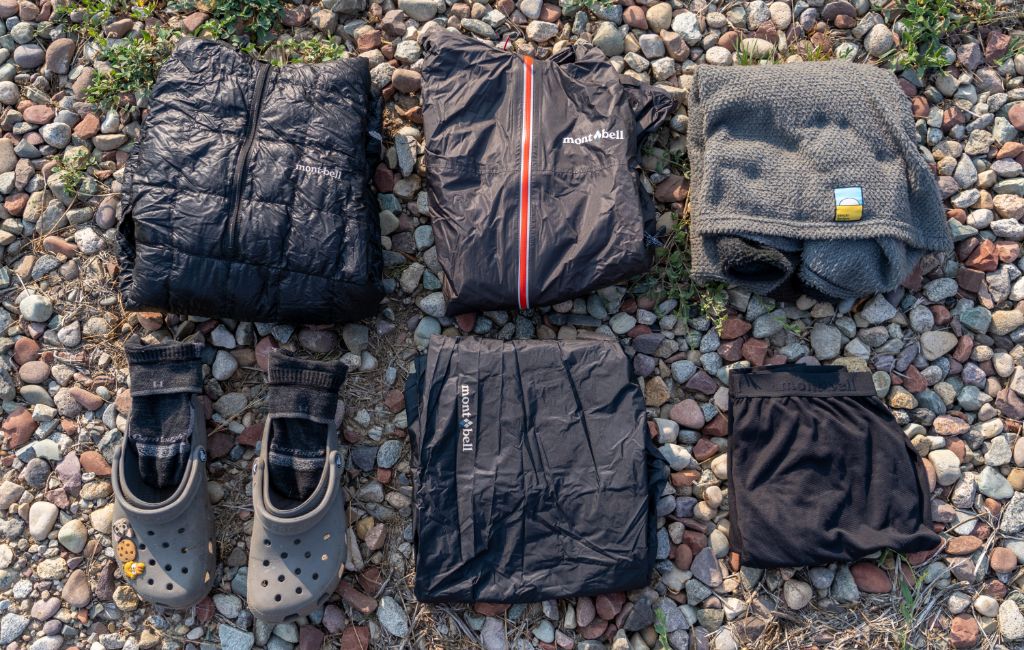
When making the transition to ultralight, group your clothes into two categories: Hiking and Packed. Packed clothing, aka camp clothes, are the clothes that stay in your pack while you hike. The idea behind the ultralight clothing strategy is your warmer packed layers stay dry for use at camp or while sleeping and only your hiking clothes are worn out in the elements.
Weather can change quickly on the trail. Always having dry layers to change into is important. If you don’t it can lead to hypothermia. The exception to this rule is your rain gear . Rain gear is considered packed gear because you normally don’t hike in it. However, if it’s raining or windy by all means hike in it!
It’s also a good rule to pack only synthetic or wool materials. No cotton. Cotton takes a long time to dry and doesn’t keep you warm when wet as wool does.
- Montbell Versalite (6.4 oz)
- Rain Jacket Outdoor Research Helium ll (6.4 oz) : Ultralight with excellent ability to repel water and wind.
- Montbell Plasma (4.8 oz) : One of the lightest down jackets available, cut to fit under other layers.
- Senchi Designs Alpha Hoodie (3.1 oz)
- Icebreaker Lightweight Wool (5.3 oz) : The Icebreaker lightweight top is great for sleeping and for chilly nights at camp.
- Montbell Zeoline Lightweight (4.4 oz)
- Minus 33 Lightweight Wool (6.0 oz) : Comfortable 100% merino wool bottoms.
- Starter Athletic Briefs (2.5 oz) : After hiking all day it’s nice to have a dry pair of underwear to change into.
- Darn Tough Quarter Hiker (2.3 oz) : Not only are they super comfy, but Darn Tough’s lifetime warranty is also the real deal.
- Crocs Sandals (10.6 oz)
- Xero Shoes Genesis Sandals (6.0 oz) : Extra shoes can be optional depending on how much time you have at camp. If you pack camp shoes, the Xero Shoes are light and can be hiked in if needed.
Electronics
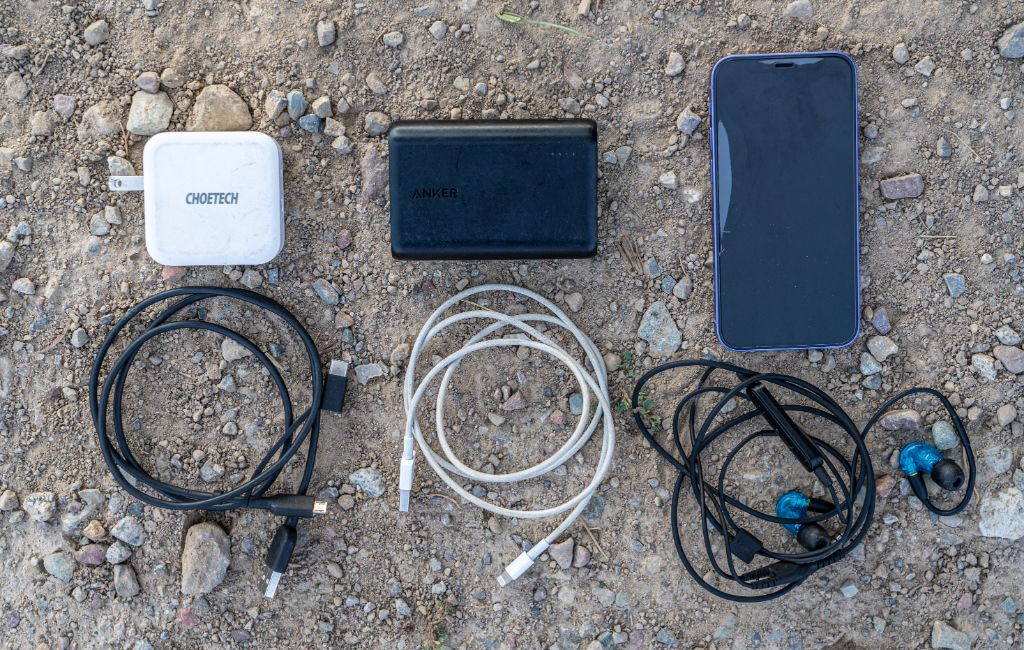
The main item here is your phone. Your phone is the new multitool. It serves as a GPS, map set, camera, backup headlamp, a source of entertainment, and more. It even works as a phone if you have service! On a shorter trip, you might be able to get away with one charge. On a longer trip or if you are a heavy phone user packing an extra battery is critical. This is especially true if your phone is your only source of maps.
Cold weather can drain a phone’s battery faster than normal, always make sure to pack enough juice. Don’t forget to bring a charging cable and a set of headphones too. If your trail passes through a campground with power, bring a USB Wall Adaptor. Never turn down the chance for free power!
- iPhone 12 Mini (4.8 oz) : All the benefits of the latest iPhone in a small package and game-changing camera with night mode.
- iPhone Lightning to USB (0.6 oz) : Bring the USB version of the lightning cable, it’s more standard on external batteries and in trail towns.
- Choetech 2 port quick charge (4.2 oz)
- USB Wall Adaptor (0.7 oz) : Standard USB wall Aadaptor.
- Battery Anker Portable Charger (6.3 oz) : The small compact Anker will do about 1.5 charges (larger options available).
- Shure SE215 (1.1 oz)
- Yurbuds (1.2 oz) : The Yurbuds are designed for workouts, ideal for use in the tent or on the trail.

Here are a few items that don’t fit neatly into our other categories.
Stuff sacks are used to keep your equipment dry. They are great for organizing your food, camp kitchen, and clothes. They are also good if your sleeping bag or inflatable mattress doesn’t come in a waterproof stuff sack.
Gallon ziplock bags work well for organizing gear but are less durable over the course of a long trip. I generally use them for storing gear that is ok if it gets slightly damp. Create a simple hiker wallet in a small ziplock that includes ID, credit card, and some cash.
A separate headlamp keeps your hands free around camp and saves precious phone batteries. Make sure to test the batteries before hitting the trail. Nothing is worse than getting to camp to find dead batteries in your headlamp.
Earplugs block out snoring hikers, loud weather, and noisy woods.
- Hyperlite Mountain Gear DCF (0.8 oz)
- Granite Gear 16L x 2 (2.0 oz) : Durable, waterproof stuff sacks.
- Sandwich ziploc and Gallon ziploc (0.2 oz) : Snap lock closures work better than slide locking which is prone to failing.
- Nemo Wallet (0.8 oz)
- Wallet License, Credit Card, $50 cash (0.4 oz): Store these items in a small ziplock bag.
- Nitecore NU25 (1 oz)
- Petzl E+Lite (1.0 oz) : Ultralight and ultra-bright, the Petzl E+Lite lasts for up to 95 hours.
- Ear Plugs Foam (0.1 oz)
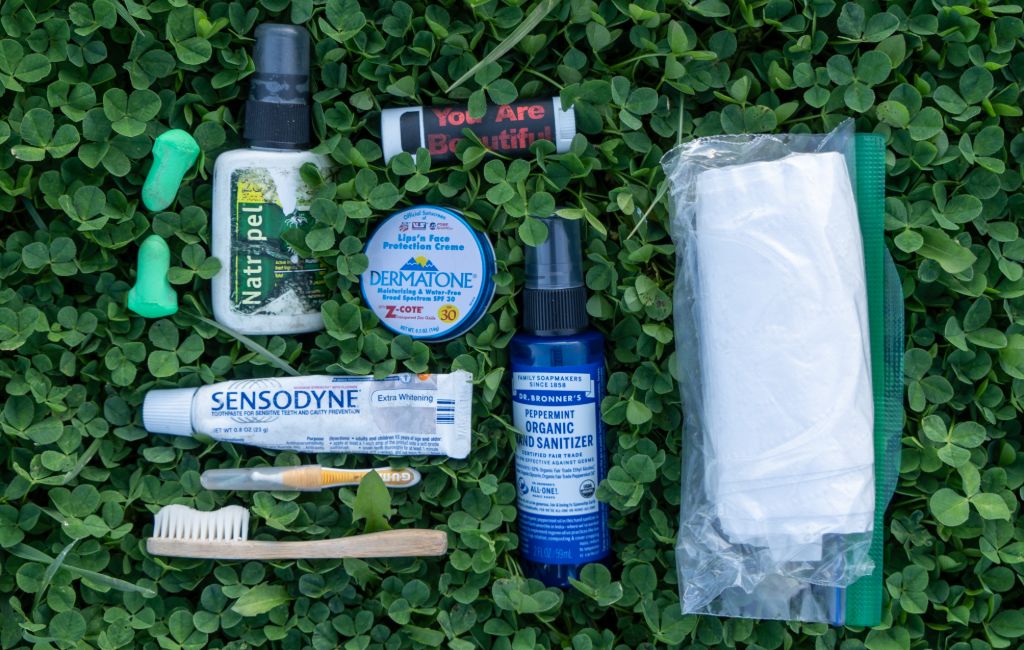
This category is largely up to you. The items you bring will be tailored to the trail you are hiking.
If you’re in the desert you might bring more sunscreen and skip the bug spray. If you’re in a temperate rainforest you might do the opposite.
Some hikers take soap, some don’t. If you bring soap make sure it is biodegradable and you follow Leave No Trace principles when using it. Follow LNT principles for how you dispose of your biodegradable toilet paper as well.
For hikers who get periods, packing a Diva Cup is a convenient, lightweight, no waste alternative to tampons or pads.
- Woobamboo Toothbrush (0.6 oz) : Saw the handle in half, drill holes in it. Do what you need to do to save the grams.
- Sensodyne Toothpaste (2.6 oz)
- Natrapel bug spray (3.4 oz)
- 100% DEET Mini (0.5 oz) : 100% DEET works well or there are non-toxic options available too.
- Joshua Tree Stick (0.4 oz)
- CeraVe SunStick (0.5 oz) : Stick sunscreen is less messy than cream and easy to apply.
- Biodegradable Toilet Paper (0.1 oz)
- Dr. Bronners Hand Sanitizer (2 oz)
First Aid Kit

Please don’t skimp on a first aid kit. Pack what you need and what makes you comfortable, both mentally and physically. There is a lot of room for flexibility here. If you have known medical issues, like allergies or a bum knee, don’t leave out items that will make your trip more comfortable or save your life.
Bringing a small multitool helps cut tape and bandages to fit your wound. And having the tweezers is nice for splinters or the stinger of a bee.
Our list below is a bare minimum, make sure to read our full article on how to construct a lightweight and versatile first aid kit.
Personally, when I make my first aid kit I don’t pay too much attention to the weight. I’d rather have peace of mind than save a few grams.
- 4 Ibuprofen Pills (0.0 oz) : I like to take enough to have approx one dose per day.
- 4 Imodium Pills (0.0 oz) : When you need it, you don’t want to be without it.
- Wound Cleaning 2 Antiseptic Wipes (0.1 oz) : Sterilizes and cleans wounds.
- Blister Prevention/ Bandage Leukotape - 12" strip (0.2 oz) : Magical tape for blisters, wounds, and securing injuries.
- Knife/Multitool Leatherman CS (1.4 oz) : I love having the small scissors and tweezers for first aid, it even has a small knife.
Worn Clothing

This is the clothing you will wear during the day when hiking. For three-season hiking keep it light and breezy. Synthetic materials are preferred as they dry off quickly after a long day of sweating. Wool is also good. Don’t bring cotton, it dries slowly and won’t keep you warm if wet.
Buffs are an awesome multi-purpose piece of gear that can be used to protect your head from the sun or to keep you warm.
If you’re hiking in open sunny terrain, consider bringing a wide-brimmed hat .
Pants vs shorts are largely a matter of personal preference. Pants will keep your legs protected if you’ll be encountering a lot of brushy trails or bushwhacks. Shorts are super breathable on hot hikes.
I prefer a long sleeve top because it means less need for slathering on the sunscreen. The key idea here is to hike in what’s comfortable for you.
- Ball Cap (0.6 oz)
- Half Buff Headwear (0.6 oz) : Light and versatile, a buff can be used morning, day, and night.
- Montbell Cool Hoodie (6.6 oz)
- Columbia Long Shirt (7.2 oz) : An inexpensive lightweight top that dries quickly.
- R-Gear 5 pocket (6.3 oz)
- Running Shorts (3.5 oz) : In warm weather, lightweight running shorts can’t be beaten.
- 2UNDR Night Shift (4 oz)
- Starter Athletic Briefs (2.5 oz) : Starter Athletic briefs are quick-drying underwear with enough coverage to prevent chafing.
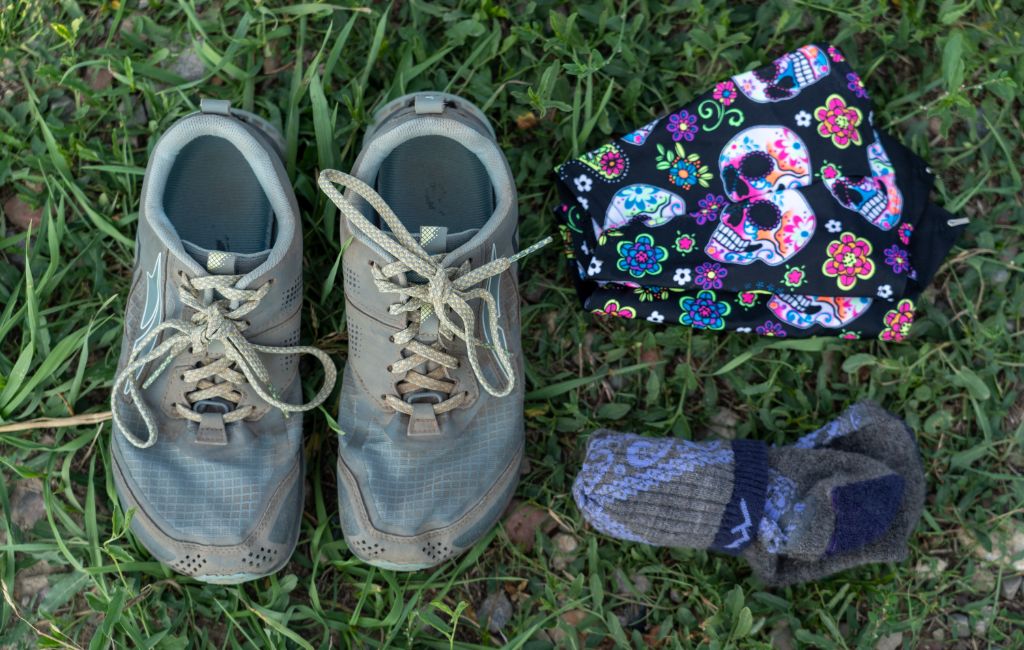
You’ll be on your feet most of the day, make sure you set off with a comfortable pair of shoes. Trail runners provide a great middle ground between running shoes and hiking boots. They also dry off faster and are more breathable for hot or wet conditions. On longer hikes, especially thru-hikes, your feet will swell. When picking shoes look for a wider toe box to counter this.
Hiking socks come in all thicknesses and heights. Depending on the temperatures you might opt for a shorter or longer height. Wool is amazing at being both cooling on hot days and warming on chilly mornings. It also keeps your feet warm when wet.
Gaiters , prevent debris from getting inside your shoes. On long rocky hikes, it means less stopping to get pebbles out of your shoes.
- Altra Lone Peak (20.8 oz) : Altra Lone Peaks are the gold standard for long distance hikers with a wide toe box to allow your feet to breathe.
- Darn Tough Quarter Hiker (2.3 oz) : Darn Tough’s comfy wool socks come with a great lifetime warranty.
- Dirty Girl Gaiters (1.5 oz) : Dirty Girl gaiters are fast drying and light due to their thin fabric. They come in a myriad of funky designs.
Consumables
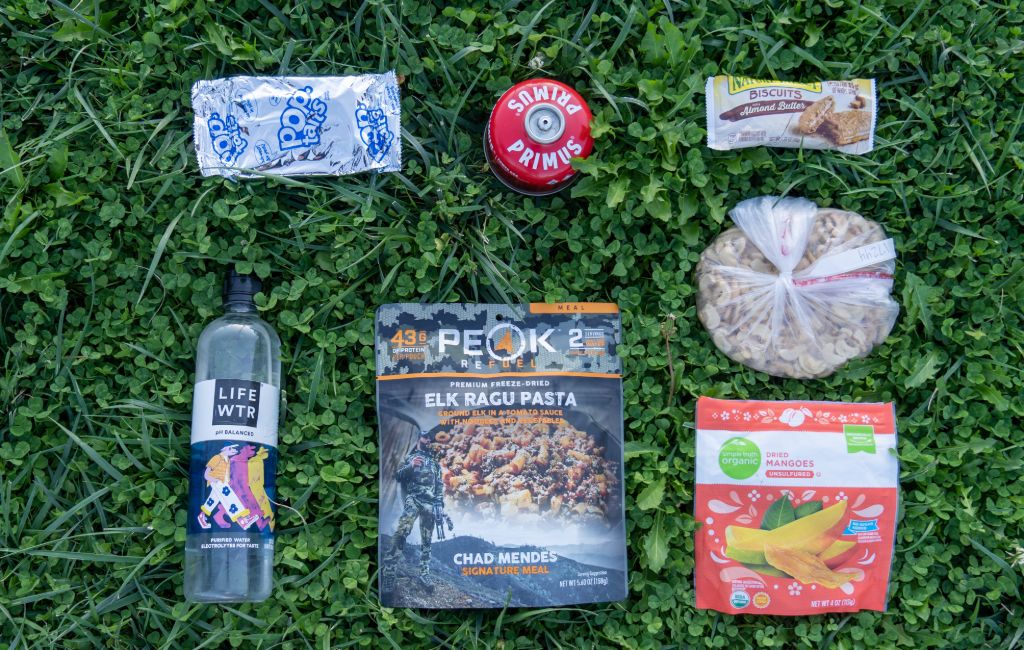
The definition of what constitutes a consumable can get murky, especially when trying to outdo a fellow hiker's base weight. The generally agreed on consumable items are food, water, and fuel.
Plan on at least a pound and a half of food per day of nutritious food. You should be able to pack enough calories, fat, and protein in this weight to keep you going on the trail.
If I’m hiking in areas of abundant water, I generally carry about half a liter. In drier climates, you’ll need more . A small 3.5 ounce canister of fuel is enough for a short to medium trip to rehydrate meals and make the morning coffee.
- Food 1.50 lbs x 3 days (72.0 oz)
- Life water/Smart water (17.6 oz)
- MSR Small Canister (3.9 oz)
Accessories
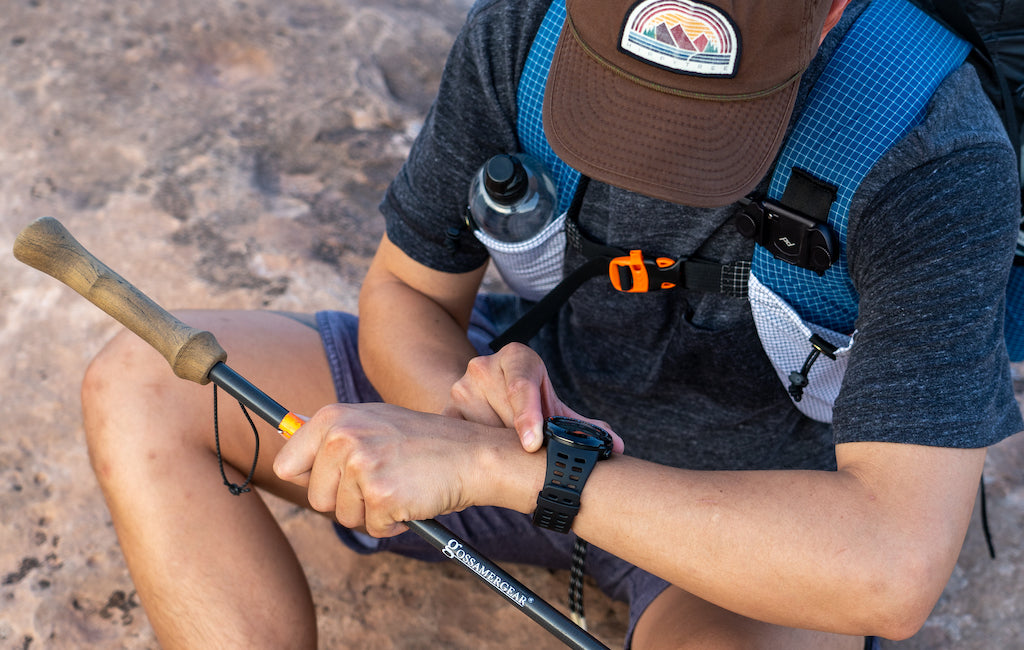
Another two popular worn items are trekking poles and a watch . Trekking poles can help alleviate strain on the joints on long days. They also provide balance on slippery surfaces, steep slopes, and river crossings. If you have a non-freestanding tent you’ll need to carry one or two trekking poles to pitch your tent.
Wearing a watch in the backcountry is handy for being able to know the time without having to check your phone. Not checking your phone means less wasted battery. A watch also helps easily and quickly track pace and estimate miles hiked.
- Gossamer Gear LT4S w/ strap. (5.5 oz each) : Gossamer Gear’s crazy light poles are strong and competitively priced.
- Casio F91W-1 (0.8 oz) : A waterproof digital watch with a backlight makes checking the time easy.
*Potential Items Not Included in List (either luxury or conditional): Bear Protection ( canister , spray ), Book, Bug Netting, Fire Starter Kit, Ice Axe, Journal, Microspikes , Nailclipper, Navigation (compass, maps), Rain pants , Satellite Messenger , Sleeping Bag Liner , Sock Liners , Trowel, Winter Clothing (gloves, balaclava ).
See the complete gear list on Packfire.com .
What's Considered Base Weight?
Base weight is the weight of the gear in your pack that doesn’t change over the course of your trip. It includes items like your tent, sleeping bag, headlamp, etc. It doesn't include consumables like toothpaste, food, or water. Neither does it include anything you wear while hiking.
Base weight doesn’t count consumables, the items that fluctuate depending on the length of your trip. Items like water, food, and fuel. Base weight also doesn’t count your worn and carried items. Items like clothes, shoes, or trekking poles.
The reason we calculate base weight separately is to compare your standard gear from a trip to trip. Base weight shouldn’t change much for an overnight or a week-long trip. This gives us a good metric to use to reduce pack weight.
Want to nerd out with your base weight? Packfire is an online tool that works like a spreadsheet to itemize your hiking gear list.
Some photos in this post were taken by Jonathan Davis ( @meowhikes )

About Justin Sprecher
About greenbelly.
After thru-hiking the Appalachian Trail, Chris Cage created Greenbelly to provide fast, filling and balanced meals to backpackers. Chris also wrote How to Hike the Appalachian Trail .

- Choosing a selection results in a full page refresh.

17 Top Ultralight Packing List Items for 2024 + What to Wear & NOT To Bring

Packing light for a vacation is one of the best ways to save money, time, and effort. But it’s much easier said than done. The minute you begin, you compile a list of everything you think you need and before you know it, your full-sized suitcase is packed to the brim.
Luckily, no matter where you’re headed, we’ve compiled an ultralight packing list that will help you pick and choose what to bring when you’re looking to travel with the bare minimum. Additionally, you’ll also find sections on what to wear when traveling ultralight , what NOT to bring and answers to FAQs.
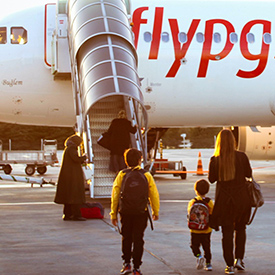
What to Pack for Ultralight Travel – 17 Essentials
1. packing cubes.
Packing cubes are the ultimate lifesaver when it comes to packing light. They not only save room in your suitcase but they also compartmentalize your belongings so you know exactly where everything is. This 5-piece set comes with multiple different sizes, separate laundry bags, and even notecards where you can jot down exactly what is in each cube.
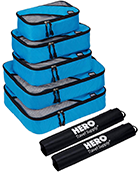
View on Amazon.com ➜
2. Jet Lag Relief
Jet lag can quickly ruin the first few days of a vacation. Rather than exploring a new city, you’ll likely end up asleep in your hotel room, wasting precious time. This homeopathic jet lag relief helps relieve those symptoms and will have you walking off the plane feeling refreshed and ready to go. The best part? Because it has natural ingredients, there are no side effects.
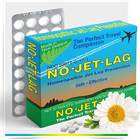
3. Virtual Private Network (VPN)
I know what you’re thinking. Why would a virtual private network (VPN) be on an ultralight packing list? During a trip to Paris, I had my credit card information stolen and I learned the hard way that a VPN is essential for all travel. It gives you an added layer of security so that you can keep all of your passwords and personal information safe while using a public Wi-Fi network. The last thing you need on your vacation is your identity stolen.

View NordVPN.com Options ➜
4. Solid Shampoo
Bottles of shampoo and conditioner are not only heavy but they take up a lot of space. Using a shampoo bar not only saves room but it also prevents spills, allows you to go through TSA, and is more environmentally friendly. This Love Beauty and Planet bar is a 2-in-1 shampoo and conditioner bar that is vegan, paraben-free, and cruelty-free. One use and your hair will be softer than ever.
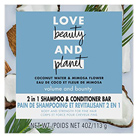
5. Lifestraw Water Bottle
Depending on where you are vacationing, you may not always have access to clean drinking water. LifeStraw water bottles are BPA free and include a filter which helps filtrate bacteria, parasites, and chlorine. It’s great for backpacking, camping, and overall travel. Bringing a water bottle while traveling is always a smart choice but this ensures that you’ll always have control over your drinking water.
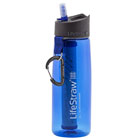
6. Universal Power Adapter
If you’re traveling internationally, you’re going to need an adapter for your electronics. With universal adaptability, you’ll be covered in over 100 destinations all over the world. From Greece to New Zealand to China, you’ll be able to charge your phone, laptop, cameras, etc. This one also happens to come with a lifetime replacement guarantee so you’ll never get stuck without one!
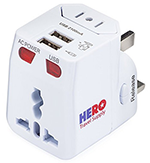
7. Lipstick-Sized Phone Charger
When packing light, the smaller, the better. We use our phones constantly when traveling to find the best places to eat and to get around so why not keep it charged at all times? This lipstick-sized charger packs a punch and will get your device charged on the go.

8. Neck Wallet
This hands-free compact travel pouch is perfect for long days at the airport or wandering around cities where pickpocketing may be common. It helps conceal your passport, IDs, credit cards, cash, and cell phone. Keep it around your neck when you want your valuables in one secure place that is still easily accessible.
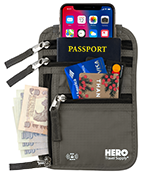
9. Activated Charcoal
One of the best parts of traveling is getting to try all of the different cuisines. However, foods from around the world don’t always agree with us. If you get a bout of food poisoning, taking these activated charcoal tablets will help absorb the toxins and help remedy your upset stomach. With no side effects, these tablets will have you up on your feet again in a matter of hours rather than days.

10. Windproof Travel Umbrella
During my years of travel, I’ve come across many rainy days and I have been left very unprepared. There’s nothing that will ruin your day like getting caught in the rain when you have activities planned. Bringing this portable windproof travel umbrella will ensure that you’ll stay dry and still be able to enjoy your vacation.
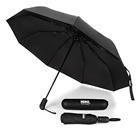
11. Foldable Daypack
Whether you’re going hiking or you’re just looking for a good lightweight travel backpack, this foldable daypack is ideal for holding all of your essentials. Resistant to water and wear-and-tear, use it to hold clothes, a water bottle, charger, laptop, and anything else you may need while traveling the world.
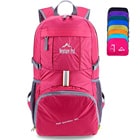
12. Travel Insurance
Travel insurance may seem like a silly thing that isn’t too important but having it not only gives you peace of mind but also keeps you protected in the chances that something goes wrong. It covers the cost of your luggage if it goes missing, your flights if a cancellation occurs, and most importantly, your medical bills should you get injured or in an accident. As a family, we don’t travel without it. We recommend TravelInsurance.com because their site makes it easy to compare policies from top companies to find the best option for you and your travel plans.

Compare policies at TravelInsurance.com ➜
13. Carry-On Suitcase
Good luggage is arguably one of the most important things to have. Every traveler should have a good carry-on suitcase as well as a full-sized bag. For traveling light, you’ll want a sturdy carry-on suitcase like this one. It’s not only light and expandable but it is extremely durable.

14. Deodorant Wipes
When out wandering the streets of a city or sitting by the lake, getting sweaty and smelly is inevitable. There’s nothing worse than worrying about your body odor while you are out in public or with friends and family. Instead of stressing about it too much, throw these wipes in your bag and use them whenever you feel yourself getting a little warm. I love these because they are plant-based, aluminum-free, and contain aloe vera juice to help your skin stay hydrated.
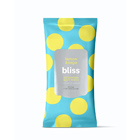

15. Mesh Slip-On Water Shoes
If your travels involve hiking, camping, or swimming, I highly recommend getting a good pair of water shoes. They help protect you from muddy terrain and rocky sea floors all while being extremely breathable and giving you excellent traction. They are also quick to dry and very easy to clean.

16. Swimsuit Coverup
Swimsuit coverups are a must-have for tropical getaways. After a dip in the ocean or pool, you can quickly throw it on and head to lunch. It’s fashionable, comfortable, and dries quickly so you won’t be stuck in a cold dress while eating. Plus it comes in multiple different colors and it takes up little to no space in your suitcase.
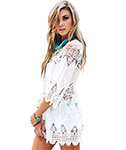
17. Gorgeous Dress
I always recommend bringing at least one nice outfit for your trip. There’s a good chance you are going to want go to a nice dinner or grab cocktails and your everyday sundress isn’t going to cut it. This wide-leg jumpsuit is the perfect combination of classy and sexy. It hugs all the right places and its high quality for a low price tag.

Other Ultralight packing items not to forget
- Neck pillow
- Eyeglasses Contacts
- Toiletry bag
- Hand sanitizer
- Feminine products
- Antitch cream
- Healthy snack
What to Wear for Ultralight Travel
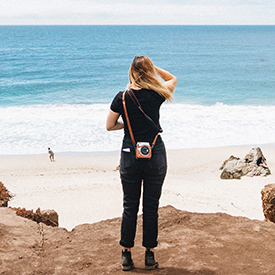
Below is a sample women’s clothing list. (All items link to Amazon.com for your convenience).

As I mentioned earlier, women are going to want to pack versatile staple pieces that you can mix and match throughout your trip. Ideally, you’ll keep things casual while bringing one formal option if you choose to go out for dinner and drinks. Layering pieces such as tank tops and cardigans are the way to go when staying light.
Below is a sample men’s clothing list. (All items link to Amazon.com for your convenience).

Much like what women should wear, men should focus on being comfortable and airy while bringing layers in case the weather is cold. T-shirts, pants that you can dress up or dress down, button-ups, and comfortable shoes are key. I like flannels if there’s a slight breeze because they keep you covered while not weighing you or your bag down.
What NOT to Pack for Ultralight Travel
1. don’t bring books.
Let’s face it, as wonderful as it is to read a book during a quiet moment of vacation, they tend to take up a lot of space and weight quite a lot. That doesn’t mean that you have to give up reading altogether. Stick to using something like a Kindle or an iPad where you can read e-books.
2. DON’T PACK Camera Gear
I love taking photos during my travels and looking back at the photos later on. Unfortunately, camera gear is extremely heavy and most of it is unnecessary. If you’re looking to shed a few pounds off your suitcase, ditch the gear for the time being. Bring just the camera alone and I guarantee you’ll still be able to get the perfect shot.
3. DON’T TAKE Too many shoes and clothes
You’re probably reading this and thinking, “well duh” but you would be surprised at how easy it is to overpack. Ideally, you want less than a week’s worth of clothes. This means 1-2 pants, 1-2 dresses, a couple of t-shirts, and one jacket (lightweight or heavy depending on the season).
4. DON’T BRING a Laptop
Your laptop is another heavy electronic that you can most likely pass on. If you’re working while on your trip that is one thing but if you’re just looking to use it for things like Netflix, stick to a tablet that is much lighter and much smaller.
5. DON’T PACK Uncomfortable Footwear:
When packing light, you’ve got to make every item count. This is especially true when it comes to your shoes. Only bring 1-2 pairs that you know you can wear in almost every situation. Whether it’s hiking, swimming, sightseeing, or a night out, comfortable and versatile shoes are the name of the game.
6. DON’T TAKE Formal Attire
Unless you’re planning on spending most of your time at high-end restaurants and gatherings, you only need one formal outfit. Women, keep your formal outfit to one piece (such as a nice dress) as it will take up less space. Men, you’ll likely already have jeans or a nice pair of pants packed so bring along one extra button-up shirt.
Packing Ultralight FAQs
1. how do i pack everything into a carry-on.
There are a couple of different techniques that you can use to help make the most of your carry-on. You can army roll your shirts , army roll your jeans use compression bags or use packing cubes .
2. How can I fold clothes to make them smaller?
I highly recommend checking out Youtube when it comes to finding ways to fold clothes to make them smaller. Marie Kondo has a great video on some techniques you can use!
3. How many shirts and pants should I bring with me?
There is no right or wrong number when it comes to how many items you should bring. For an ultralight packing list, I’d recommend staying anywhere from 3-4 shirts (both long-sleeved and short-sleeved) and 3-4 pairs of pants (both shorts and jeans).
4. Why should I pack light?
Packing light is a habit that I think everyone should get into. It not only helps you from overpacking but it also helps you save money. Many airlines offer extremely affordable flights but make you pay for bags. That can set you back $25-$100 depending on the airline! Having a carry-on versus a checked bag also ensures that you won’t lose your luggage and it saves you time once you arrive at your destination. While everyone is waiting at the carousel for their bags, you’ll be heading to your hotel to get your vacation started.
5. What are easy ways to make my bag lighter?
One of the easiest ways to make your bag lighter is to wear any heavy pieces while you travel. For example, if you need a heavy winter coat during your stay, wear it on the plane.
If you must check a bag, put some of your heavier items (such as jeans or a pair of shoes) into your carry-on. This will help you from ever having overweight luggage.
6. Is a minimal packing list sufficient?
Minimal is the way to go when it comes to an ultralight packing list. This means packing nothing but basics that you know will still help you remain stylish but will also keep costs and weight down.
7. What are the best bags to use for lightweight travel?
If you’re looking to go ultralight, a sturdy duffle bag or small hardcover carry-on is the way to go. This still gives you plenty of room to bring along a backpack or purse if flying.

Join the Community!
Subscribe to our newsletter to join the thousands of other travelers, hikers, backpackers, and van lifers who receive new content notifications, detailed trip reports, in-depth product reviews, and helpful gear recommendations every month., latest posts.

Hiker Profile: Jonny Waldman (Founder of Mayfly Ultralight)
APRIL 29TH, 2024 BY TPL STAFF

Skiing in Japan: When/Where to Go & What to Expect in 2024
APRIL 10TH, 2024 BY CU FLESHMAN

TOM BIHN Techonaut 30 Review: An Elite Travel Backpack?
APRIL 2ND, 2024 BY NOEL KRASOMIL

Backpack Fabrics: Understanding Nylon, Cotton, DCF & More
MARCH 30TH, 2024 BY NOEL KRASOMIL

Traveler Profile: Tanner Cibula (Backpacker, Traveler, Survivalist)
MARCH 23RD, 2024 BY TPL STAFF

Colorado Trail Gear List: Checklist + Tips for CT Thru-Hikers
MARCH 16TH, 2024 BY NOEL KRASOMIL

12 Road Trip Tips for a Safe & Memorable Journey
MARCH 14TH, 2024 BY NOEL KRASOMIL

What is Backpacking, Exactly? Hiking/Camping vs. Travel/Urban
MARCH 11TH, 2024 BY NOEL KRASOMIL

Zpacks 8.5’ x 10’ Tarp Review: The Ultralight Tarp to Carry?
FEBRUARY 23RD, 2024 BY ALEX CHOI

Thru-Hiking 101 [Tips, Planning, Gear, FAQs & More]
FEBRUARY 2ND, 2024 BY CU FLESHMAN
Popular Posts

12 Top Personal Item Bags & Underseat Luggage in 2024
TRAVEL · GEAR

How to Start a Travel Blog: Travel, Create (& Get Paid!)
BLOGGING · GUIDES

How to Become a House Sitter (& Find Long-Term Jobs)
TRAVEL · RESOURCES

My Exhausting 20,000 Steps a Day Challenge (30 Days)
HIKING · JOURNAL

49 Must-Have Van Life Essentials to Elevate Your Gear Game

Travel Savings 101: How I Stashed Money for Long-Term Travel
TRAVEL · TIPS · JOURNAL

12 Best Minimalist Barefoot Sandals for Running & Hiking
HIKING · GEAR

My Ultralight Minimalist Travel Packing List for 2024

The Best Minimalist Backpacks for Modern One-Bag Travel

Van Life: 13 Good, Bad & Strange Realities of Living in a Van
Travel Tips & Gear Guides

Ideal 10-Day Colorado Road Trip Itinerary (Ideas, Costs & Map)
TRAVEL · GUIDES · UNITED STATES

My Ultimate Carry-On Packing List for One Week or More

My 10-Day Vietnam Motorbike Road Trip (Route + Itinerary)
TRAVEL · JOURNAL · VIETNAM

11 Packable Travel Hats for Men [Crushable & Stylish]

Traveling Sucks (Sometimes): My 12 Worst Travel Stories
TRAVEL · JOURNAL

16 Tried-And-True Travel Shoes (for Walking All Day)

Unreal Chengdu Street Food Marathon: 32 Snacks, 10 Hours
TRAVEL · JOURNAL · CHINA

7 Best Titanium Water Bottles [Lightweight & Durable]

Hanoi in One Day: A 24-Hour Guide (Tips, Costs & Itinerary)
TRAVEL · GUIDES · VIETNAM

How to Pack Light & Travel with Less (Like a Pro)
TRAVEL · TIPS
Hiking & Backpacking

8.2 lb Ultralight Backpacking Gear List [Updated for 2024]

How to Hike the ‘O’ Circuit in Torres del Paine, Patagonia
HIKING · GUIDES · CHILE

11 Best Ultralight Tents for Backpacking & Thru-Hiking

20 Tips for Hiking the Appalachian Trail from an AT Thru-Hiker
HIKING · TIPS · USA

9 Best 0-Degree Sleeping Bags for Winter’s Cold Weather

How to Hike Patagonia's Huemul Circuit (Without a Guide)
HIKING · GUIDES · ARGENTINA

The Top Wool Hiking Socks for All-Season Comfort

Hiking the Laugavegur Trail: 7 Lessons I Learned the Hard Way
HIKING · JOURNAL · TIPS · ICELAND

16 Stellar Hiking Hats for Men, Women & Hikers of All Stripes

Get Paid to Hike: 10 Hiking Jobs to Make Money on the Trail
HIKING · RESOURCES

Welcome to The Packable Life
Hey, i’m noel.
I’m a minimalist traveler, ultralight backpacker, and camper van dweller who believes the right gear and packing list can elevate life on the go. I pack as little as possible and believe that mobility is freedom.
In 2017, I quit my restaurant job to travel to far flung destinations, backpack scenic trails, and cruise around in my camper van . A year later, I started this blog to share my experiences with the world.
Here you’ll find trip guides, gear recommendations, tips and advice, and useful resources . My goal is to help you pack lighter, explore more, and maximize your time on the road and in the backcountry.
- Hiking Shoes
- Hiking Boots
- Hiking Sandals
- Trail Runners
- Base layers
- Hiking Shirts
- Fleece Jackets
- Softshell Jackets
- Rain jackets
- Down Jackets
- Hiking Pants
- Hiking Shorts
- Base Layers
- Rain Jackets
- Hiking Bras
- Baby Carriers
- Cookware Sets
- Water Filters
- Water Purifiers
- Sleeping Bags
- Sleeping Pads
- Hiking Poles
- GPS Devices
- Solar Chargers
- Dive Regulators
- Dive Computers
- Dive Watches
- Dive Wetsuits
- Dive Gloves
- Dive Lights
- Dive Knives
- Spearfishing Wetsuits
- Spearfishing Masks
- Spearfishing Fins
- Spearfishing Watches
- Freediving Wetsuits
- Freediving Masks
- Freediving Fins
- Freediving Watches
- Sit On Top Kayaks
- Inflatable Kayaks
- Fishing Kayaks
- Tandem Kayaks
- Touring Kayaks
- Kayak Paddles
- Kayak Seats
- Kayak Roof Racks
- Kayak Carts
- Stand Up Paddle Boards
- Touring SUPs
- Inflatable SUPs
- Fishing SUPs
- SUPs For Yoga
- SUPs For Surfing
- SUP Paddles
- Climbing Boots
- Belay Devices
- Climbing Shoes
- Women's Climbing Shoes
- Bouldering Shoes
- Approach Shoes
- Climbing Pants
- Bouldering Pants
- Mountain Bikes for Men
- Mountain Bikes for Women
- MTB Handlebars
- Bike Saddles
- Bike Computers
- Bike Lights
- MTB Jackets
- Bike Helmets
- Bike Packing Gear
- Fat Biking Gear
- Ski Bindings
- Ski Helmets
- Ski Goggles
- Ski Jackets
- Snowboarding Bindings
- Snowboarding Boots
- Snowboard Helmets
- Snowboard Goggles
- Snowboard Pants
- Snowboard Jackets
- Snowshoe Poles
- Avalanche Beacons
- Avalanche Probes
- Avalanche Shovels
- Ski Backpacks
- Surfboards For Beginners
- Surfboards For Kids
- Surfboard For Small Waves
- Soft Top Surfboards
- Foam Surfboards
- Body Boards
- Boogie Boards
- Kiteboarding Kites
- Kitesurfing Boards
- Kiteboarding Harnesses
- Surfing Wetsuits
- Men's Rash Guards
- Women's Rash Guards
- Board Leashes
- DLSR Travel Cameras
- Mirrorles Travel Cameras
- Point and Shoot Travel Cameras
- Fuji Travel Lenses
- Nikon Travel Lenses
- Tripods for Travel
- DLSR Landscape Cameras
- Mirrorles Landscape Cameras
- Point and Shoot Landscape Cameras
- Fuji Landscape Lenses
- Nikon Landcape Lenses
- Canon Landcape Lenses
- Tripods for Landscape Photo
- Wildlife Cameras
- Wildlife Lenses
- Wildlife Tripods
- Wildlife Monopods
- Birdlife Cameras
- Birdlife Lenses
- Surfboards For Small Waves
The Complete Ultralight Backpacking Gear List
Are you ready to lose all that weight and enter the fast-paced world of ultralight backpacking ? Can you see yourself gliding elf like through the wilderness, carrying only what is essential? But how do you know if the items on your ultralight backpacking gear list are essential, or just dead weight ?
Here at The Adventure Junkies, we understand the minimalist’s dilemma: How do you balance gear-weight -loss with the human need for a bit of comfort on the trail? Turns out, it’s easier than you might think.
There are a lot of gear out there designed specifically for ultralight backpackers, and replacing just a few big items will help you slim down quickly. We’ve put together this gear list to help you decide what to keep and what to replace, and whether to pack it in or leave it behind.
[thrive_leads id=’59716′]
HOW TO USE THIS PACKING LIST
Before we discover the essentials of packing for an ultralight backpacking adventure, here’s a run down on how to get the most out of this list. Next to each item you will see a few categories. Here’s what they mean.
PURPOSE: What the gear is designed for, and why you would consider taking it with you.
ESSENTIAL ITEM: It’s difficult to know if you’re going to need something, so sometimes you end up throwing in everything. This is the opposite of what ultralight backpacking is about.
In this world, every ounce of weight must prove itself worthy. We’ve whittled it all down to what we consider to be the bare essentials, but these will always vary according to where you’re going, and when.
PRICE RANGE: While ultralight gear is typically pricier than standard backpacking equipment, that doesn’t mean you have to spend a fortune to lighten your load. Note that all price ranges are listed in US dollars.
LOOK FOR: Some quick tips on how to choose the best gear.
OUR PICK: Our choice based on the value and quality of the item.
LEARN MORE: A full article on how to choose that particular piece of gear and the best models of the year.
1. CARRYING
45-55l backpack.
Check out the latest price on: Amazon | REI
PURPOSE: Carrying all of your stuff into and out of the wilderness.
ESSENTIAL ITEM?: Yes
PRICE RANGE: $170-$500
LOOK FOR: Ultralight packs typically weigh no more than 2.5 lbs.
OUR PICK: Osprey Exos 48
LEARN MORE: Best Hiking Backpacks of the Year >>
PURPOSE: Keeps your pack dry in the rain.
ESSENTIAL ITEM?: Only if you expect rain
PRICE RANGE: $30-$60
LOOK FOR: Durable and fits your pack
OUR PICK: Osprey Ultralight Rain Cover
LEARN MORE: Best Backpack Rain Covers of the Year >>
PURPOSE: Keeps important items dry.
ESSENTIAL ITEM?: Depends on your needs.
PRICE RANGE: $15-$50
LOOK FOR: Waterproof and roomy
OUR PICK: Outdoor Research Ultralight Dry Bag
[thrive_leads id=’56126′]
2. SLEEPING
Sleeping bag.
PURPOSE: Keeps you warm and comfortable while sleeping.
PRICE RANGE: $200-$500
LOOK FOR: Sufficient temperature rating for climate, small pack size and ultralight weight — under 2 lbs.
OUR PICK: Sea To Summit Spark SP II
LEARN MORE: Best Sleeping Bags of the Year >>
SLEEPING BAG LINER
PURPOSE: Adds extra warmth to sleeping bag.
ESSENTIAL ITEM?: No
PRICE RANGE: $30-$100
LOOK FOR: Comfortable material
OUR PICK: Sea To Summit Reactor Thermolite Liner
LEARN MORE: Best Sleeping Bag Liners of the Year >>
SLEEPING PAD
Check out the latest price on: Amazon
PURPOSE: Provides warmth and cushioning.
PRICE RANGE: $50-$400
LOOK FOR: Ultralight, comfort, small pack size.
OUR PICK: OutdoorsmanLab Ultralight Sleeping Pad
LEARN MORE: Best Sleeping Pads of the Year >>
PURPOSE: Protects you and your gear from the elements.
ESSENTIAL ITEM?: Depends on your preference.
PRICE RANGE: $50-$150
LOOK FOR: Durable, ultralight and small pack size.
OUR PICK: Aqua Quest Guide Tarp
LEARN MORE: Best Backpacking Tarps of the Year >>
PURPOSE: Sleeping and staying out of the elements.
PRICE RANGE: $150-$400
OUR PICK: Hennessy Explorer Ultralight
LEARN MORE: Best Camping Hammocks of the Year >>
PURPOSE: Sleeping, storing gear and staying out of the elements.
PRICE RANGE: $200-$800
LOOK FOR: Ultralight, small pack size, suitable size for number of people, suitable for climate.
OUR PICK: Nemo Dagger 2P Ultralight Tent
LEARN MORE: Best Backpacking Tents of the Year >>
3. NAVIGATING
PURPOSE: Finding where you are going
PRICE RANGE: $15-$200
LOOK FOR: Easy to use
OUR PICK: Suunto M3
LEARN MORE: Best Hiking Compasses of the Year >>
MAP & TRAIL GUIDES
PURPOSE: Finding where you are going.
PRICE RANGE: $5-$20
LOOK FOR: Durable & easy to read.
OUR PICK: National Geographic
PURPOSE: Keeps your map handy and dry.
PRICE RANGE: $20-$50
LOOK FOR: Waterproof
OUR PICK: Aqua Quest Trail Map Case
PURPOSE: Navigation
LOOK FOR: Easy to use and long battery life.
OUR PICK: Garmin GPSMAP 64st
LEARN MORE: Best Hiking GPS Devices of the Year >>
Photo by istockphoto.com/portfolio/littlew00dy
BACKPACKING STOVE
PURPOSE: Cooking food
PRICE RANGE: $50-$300
LOOK FOR: Ultralight and reliable
OUR PICK: Jetboil MiniMo
LEARN MORE: Best Backpacking Stoves of the Year >>
PURPOSE: Runs your stove.
PRICE RANGE: $10-$30
LOOK FOR: Works with your stove.
OUR PICK: JetBoil Jet Power
PURPOSE: Lighting your stove.
LOOK FOR: Ultralight and reliable.
OUR PICK: MSR Strike Igniter
PURPOSE: Eating
LOOK FOR: Ultralight and durable
OUR PICK: Light My Fire Titanium Spork
COOKWARE & DISHES
PURPOSE: Cooking and eating.
ESSENTIAL ITEM?: Cookwear Yes, Dishes No
PRICE RANGE: $20-$200
LOOK FOR: Ultralight, durable and versatile.
OUR PICK: GSI Minimalist
LEARN MORE: Best Backpacking Cookware Sets of the Year >>
[thrive_leads id=’54645′]
5. EATING & DRINKING
PURPOSE: Fueling your body.
PRICE RANGE: $1-$10 Per Person
LOOK FOR: Sufficient calories, taste
OUR PICK: Mountain House Freeze Dried Food
LEARN MORE: Best Freeze Dried Food Packages of the Year >>
PRICE RANGE: $1-$5
LOOK FOR: Fruits, nuts, peanut butter.
OUR PICK: Cliff Bars
WATER FILTER
PURPOSE: Clean water
ESSENTIAL ITEM?: Yes, if you’re going somewhere with water.
PRICE RANGE: $20-$100
LOOK FOR: Ultralight and easy to use.
OUR PICK: MSR Trailshot Microfilter
LEARN MORE: Best Backpacking Water Filters of the Year >>
WATER PURIFIER
PURPOSE: Purify water
ESSENTIAL ITEM?: Yes, if your’e going somewhere with water.
PRICE RANGE: $10 -$50
OUR PICK: SteriPen Ultra
LEARN MORE: Best Backpacking Water Purifiers of the Year >>
WATER BLADDER
PURPOSE: Carrying Water
ESSENTIAL ITEM?: Yes, If You’re Going Somewhere Without Water
LOOK FOR: Fits Inot Your Pack & Holds Enought Water
OUR PICK: CamelBak Antidote
6. CLOTHING FOR HOT WEATHER
Hiking shirt.
PURPOSE: Wicking Sweat, Blocking Sun, Covering Upper Body
ESSENTIAL ITEM: Yes
PRICE RANGE: $15-$80
LOOK FOR: Comfort, Fit, UPF
OUR MEN’S PICK: Ex Officio Sol Cool
OUR WOMEN’S PICK: Icebreaker Tech Lite
LEARN MORE: Best Hiking Shirts of the Year >>
QUICK DRY SHORTS OR PANTS
PURPOSE: Block Sun, Wicking Sweat, Covering Lower Body
LOOK FOR: Comfort, Fit & UPF
OUR MEN’S PICK: Prana Stretch Zion Shorts
OUR WOMEN’S PICK: Prana Tess Shorts
LEARN MORE: Best Hiking Shorts of the Year >> | Best Hiking Pants of the Year >>
WICKING UNDERWEAR
PURPOSE: Keeping You Comfortable And Dry Beneath Your Clothes
PRICE RANGE: $10-$50
LOOK FOR: Comfort, Fit & Quick Dry Material
OUR MEN’S PICK: ExOfficio Men’s Give-and-Go
OUR WOMEN’S PICK: Icebreaker Sprite Hot Pants
LEARN MORE: Best Hiking Underwear of the Year >>
Photo by istockphoto.com/portfolio/redwedge
7. CLOTHING FOR COLD WEATHER
Thermal base layer.
PURPOSE: Keeps Your Upper Body Warm & Dry
OUR MEN’S PICK : Arc’teryx Phase AR LS
OUR WOMENS PICK: Arc’teryx Phase SV
LEARN MORE: Best Base Layers of the Year >>
THERMAL LEGGINGS
PURPOSE: Keeps Your Lower Body Warm & Dry
LOOK FOR: Confort, Fit & Quick Dry Material
OUR MEN’S PICK: Arc’teryx Phase AR Bottom
OUR WOMEN’S PICK: Icebreaker Oasis
LEARN MORE: Best Long Johns of the Year >>
FLEECE JACKET
PURPOSE: Keeps You Warm In Camp And On The Trail
PRICE RANGE: $50-$250
LOOK FOR: Comfort. Warmth & Fit
OUR MEN’S PICK: Arc’teryx Fortrex Hoodie
OUR WOMEN’S PICK: Arc’teryx Fortrez Hoodie
LEARN MORE: Best Fleece Jackets of the Year >>
PURPOSE: Keeps Your Head Warm
LOOK FOR: Comfort, Warmth & Fit
OUR PICK: Icebreaker Pocket Hat
PURPOSE: Keeps Your Hands Warm
PRICE RANGE: $10-$40
OUR MEN’S PICK: Outdoor Research Versaliner
OUR WOMEN’S PICK: Outdoor Research Versaliner
LEARN MORE: Best Hiking Gloves of the Year >>
8. RAIN GEAR
Waterproof rain jacket.
PURPOSE: Keeps Your Upper Body Dry In The Rain
PRICE RANGE: $100-$400
LOOK FOR: Fit, Waterproof Material, Pockets
OUR MEN’S PICK: Outdoor Research Helium II
OUR WOMEN’S PICK: Outdoor Research Helium II
LEARN MORE: Best Rain Jackets of the Year >>
WATERPROOF RAIN PANTS
PURPOSE: Keep Your Lower Body Dry In The Rain
LOOK FOR: Fit, Waterproof Material
OUR MEN’S PICK: Outdoor Research Helium
OUR WOMEN’S PICK: Outdoor Research Helium
LEARN MORE: Best Rain Pants of the Year >>
WATERPROOF GLOVES
PURPOSE: Keep Your Hands Warm and Dry In Rain
LOOK FOR: Comfort, Waterproof Material
OUR MEN’S PICK: Outdoor Research Arete
OUR WOMEN’S PICK: Outdoor Research Arete
9. FOOTWEAR
Trail runners.
PURPOSE: Encase Your Feet So You Can Hike
LOOK FOR: Light, Durable, Comfortable
OUR MEN’S PICK: Merrill Grassbow Air
OUR WOMEN’S PICK: Merrill Grassbow Air
PURPOSE: Camp Shoes & Walking Through Water
ESSENTIAL ITEM?: Only If Your’e Hiking Through Water
LOOK FOR: Light, Comfortable & Durable Straps
OUR MEN’S PICK: Chaco Classic Sport
OUR WOMEN’S PICK: Chaco Classic Sport
LEARN MORE: Best Hiking Sandals of the Year >>
PURPOSE: Protect Your Feet
PRICE RANGE: $10-30
LOOK FOR: Comfort & Appropriate For Your Shoe
OUR MEN’S PICK: Darn Tough Vermont Socks
OUR WOMEN’S PICK: Darn Tough Vermont Socks
LEARN MORE: Best Hiking Socks of the Year >>
PURPOSE: Help Prevent Blisters
LOOK FOR: Comfort & Fit
OUR PICK: Inji Liner Toe Socks
PURPOSE: Keep Rocks and Stickers Out Of Your Trail Runners
LOOK FOR: Ultralight & Durable
OUR PICK: Outdoor Research Sparkplugs
LEARN MORE: Best Hiking Gaiters of the Year >>
10. PERSONAL ITEMS & ACCESSORIES
- Trekking Poles
- Toilet Paper
- Toiletries Bag
- Biodegradable Soap
- Hand Sanitizer
- Outdoor Journal
- Zip-Lock Bags
- First-Aid Kit
- Solar Charger
- Credit Card
For more of our top hiking & backpacking gear recommendations, check out these popular buyer's guides:
Best Hiking Backpacks
Best Backpacking Tents
Best Backpacking Sleeping Bags
Best Backpacking Sleeping Pads
Best Backpacking Stoves
Best Hiking Boots For Men ( and Women )
Best Hiking Shoes For Men ( and Women )

HappyLuxe Blog
Ultimate Ultralight Travel Packing List For Female Adventurers
Are you a female adventurer looking to embark on your next travel expedition? If so, you’ll need the ultimate ultralight packing list to ensure a hassle-free and enjoyable journey. This article will guide you through the essentials of clothing, footwear, toiletries, electronics, travel documents, entertainment items, snacks, and sustainable products that are perfect for your adventure.
When it comes to clothing essentials, think versatile and lightweight options that can be mixed and matched effortlessly. Don’t forget about comfortable footwear and accessories like hats and sunglasses to protect yourself from the elements. Toiletries should be compact yet comprehensive enough for all your personal care needs.
In today’s digital age, electronics and gadgets are a must-have when traveling . From smartphones to portable chargers, we’ve got you covered with the latest tech recommendations. And of course, don’t leave home without your important travel documents and money.
To keep boredom at bay during long journeys or downtime at your destination, pack some entertainment and recreation items such as books or travel-friendly games. Plus, we’ll provide suggestions for snacks and food options that are easy to carry while being nutritious.
Lastly, we’ll explore sustainable and eco-friendly products that align with your adventurous spirit while minimizing environmental impact.
With these tips in mind for efficient packing and organization techniques tailored specifically for female adventurers like you – get ready to conquer new horizons!
Clothing Essentials
You’ll want to pack versatile and lightweight clothing essentials that will keep you comfortable and stylish throughout your adventures.
When it comes to creating the ultimate ultralight travel packing list for female adventurers, a minimalist approach is key. Start by investing in packing cubes to save space and organize your belongings efficiently in your carry-on luggage.
For clothing, focus on pieces that are lightweight, easy to mix and match, and made from quick-drying materials. Opt for breathable tops like tank tops or t-shirts that can be layered with a lightweight cardigan or jacket when needed. Pack a couple of versatile dresses that can transition from day to night effortlessly.
When it comes to bottoms, choose lightweight shorts or pants that are comfortable for long walks yet stylish enough for a nice dinner out. Leggings are also a great option as they can be worn alone or layered under skirts or dresses.
Don’t forget about swimwear! A minimalist packing list should include one swimsuit that you love and feel confident in. Look for options made from quick-drying materials so you can wear them multiple times without worrying about dampness.
Remember, the goal is to pack light while still having everything you need. By following this ultralight travel packing list for women, you’ll be well-prepared for any adventure that comes your way!
Best Overall Travel Pillow
Tranquil ease travel pillow, journey in comfort.
Tranquil Ease Travel Pillow – Tailored for Restful Travels, Hypoallergenic Material, Easily Portable – Experience Blissful Relaxation On-the-Go

Footwear and Accessories
Make sure to pack lightweight shoes and accessories that’ll enhance your comfort and style while exploring.
When it comes to footwear, a pair of flip flops is essential for casual strolls on the beach or around town. They take up minimal space in your bag and are perfect for hot weather destinations.
For more active adventures, consider packing a pair of hiking boots that provide support and traction on rough terrains.
Accessories can make a big difference in your travel experience. A day bag is crucial for carrying your essentials like a water bottle, snacks, camera, and maps. Look for one that’s compact yet spacious enough to hold all your belongings comfortably.
And don’t forget to pack a bathing suit if you plan on taking a dip in the ocean or relaxing by the pool.
As for clothing accessories, bring along a rain jacket that can double as a windbreaker during cooler evenings. This versatile piece will keep you dry in unexpected downpours while still being lightweight enough to fit into your ultralight travel packing list.
Remember to stick with minimalist packing tips when choosing accessories like hats or scarves. Opt for items that can be worn with multiple outfits and serve both fashion and practical purposes.
By carefully selecting the right footwear and accessories, you can stay comfortable, stylish, and prepared for any adventure while keeping your luggage light and efficient.
Toiletries and Personal Care Items
Don’t forget to pack your essential toiletries and personal care items for a refreshing and comfortable travel experience. When it comes to minimalist travel, having a well-thought-out packing list is key.
Since you’re aiming to travel with just a carry-on and keep things light, it’s important to choose wisely which toiletries you bring along. Start by considering the size of the containers. Opt for travel-sized bottles or decant your favorite products into smaller ones. This will help save space in your bag while still ensuring you have everything you need. Don’t forget basics like toothpaste, toothbrush, and floss.
A good rule of thumb is to stick with multi-purpose items. For example, instead of bringing separate shampoo and body wash bottles, consider using a 2-in-1 product that can serve both purposes. This way, you’ll be able to cut down on the number of items in your toiletry bag.
If you’re worried about not having enough clothes during your trip, remember that hotel rooms usually provide body washes and shampoos as part of their amenities. This means you can use these products instead of carrying extra ones with you.
Lastly, don’t forget about any personal care items that are important to you such as contact lens solution or specific skincare products. Pack them in small containers or sample sizes whenever possible.
By following these tips, you’ll be able to create a compact toiletries kit that fits easily into your bag while still allowing for a refreshing and comfortable journey ahead!
Electronics and Gadgets
When it comes to packing for your trip, don’t forget to consider the essential electronics and gadgets you’ll need. While traveling light is key, there are a few items that can make your journey more convenient and enjoyable.
First, make sure you have a reliable carry-on suitcase with plenty of compartments to keep your electronics organized. This will prevent any damage during transit and save you from rummaging through your bag at security checkpoints.
One pair of headphones is a must-have for any traveler. Whether you want to listen to music or watch movies on the plane, having a good pair of headphones will ensure a comfortable journey.
Additionally, don’t forget to pack a portable charger for your electronic devices. This way, you won’t have to worry about finding an outlet at the airport or during layovers.
If you’re planning on documenting your adventures with photos and videos, bring along just what you need: a lightweight camera or smartphone with a high-quality camera feature. You’ll capture beautiful memories without adding extra weight to your luggage.
Lastly, consider bringing a universal adapter so that you can charge your devices no matter where in the world you go. It’s always handy to have one in case the hotel doesn’t provide adapters.
Remember these packing tips when it comes time for your next trip!
Travel Documents and Money
Before embarking on your next adventure, it’s crucial to ensure you have all the necessary travel documents and money in order to have a smooth and stress-free journey.
When it comes to travel documents, make sure you have a valid passport with at least six months of validity remaining. Check if you need any visas or permits for the countries you plan to visit and make copies of these important documents to keep them safe. It’s also a good idea to have digital copies stored securely in the cloud.
In terms of money, consider carrying a mix of cash and cards. Notify your bank about your travel plans so they don’t flag your transactions as suspicious. Carry small amounts of local currency for immediate expenses upon arrival, but rely on cards for larger purchases or emergencies. A travel wallet with multiple compartments can help keep everything organized.
Additionally, having travel insurance is highly recommended. It can provide coverage for medical emergencies, trip cancellation or interruption, lost baggage, and more. Research different insurance options and choose one that suits your needs.
Remember, proper preparation with travel documents and money will give you peace of mind throughout your journey, allowing you to fully immerse yourself in new experiences without unnecessary worries.
Safety and Emergency Supplies
Now that you’ve got your travel documents and money sorted, let’s talk about safety and emergency supplies.
As a savvy female adventurer, it’s important to be prepared for any situation that may arise during your travels. Whether you’re exploring bustling cities or venturing into the great outdoors, having the right gear can make all the difference.
First and foremost, consider investing in a sturdy lock for your luggage. This will not only give you peace of mind but also act as a deterrent to potential thieves. Additionally, carrying a portable door alarm can provide an extra layer of security when staying in unfamiliar accommodations.
When it comes to emergency supplies, a basic first aid kit is essential. Make sure it includes band-aids, antiseptic wipes, pain relievers, and any personal medications you may need. It’s also wise to pack a small flashlight with spare batteries in case of power outages or navigating dark areas at night.
Furthermore, don’t forget about personal safety items like pepper spray or a personal alarm. These can help ward off potential threats and give you added confidence while exploring new places.
Remember, being prepared is key when it comes to staying safe on your adventures. So take the time to pack these essential safety and emergency supplies before embarking on your next journey.
Camping and Outdoor Gear
Let’s talk about the essential gear you’ll need for camping and outdoor adventures. When it comes to packing for your ultimate ultralight travel, it’s important to choose versatile items that are both lightweight and practical.
Firstly, a reliable tent is a must-have for any outdoor enthusiast. Look for one that’s easy to set up and pack away, while also providing sufficient protection from the elements.
A lightweight sleeping bag and sleeping pad are also crucial for a good night’s sleep under the stars.
Next, consider investing in a compact camping stove and cookware set. These’ll allow you to prepare hot meals during your outdoor expeditions without weighing you down. Don’t forget to pack some essential utensils like a knife, spoon, and fork.
For those who enjoy hiking or trekking, sturdy yet comfortable hiking boots are indispensable. Opt for waterproof ones that provide excellent traction on different terrains. Additionally, don’t forget to bring along a reliable backpack with ample storage space for all your gear.
Lastly, remember to pack appropriate clothing layers suitable for various weather conditions. Lightweight rain gear, thermal base layers, and breathable shirts are among the essentials.
By having these camping and outdoor essentials in your packing list, you’ll be well-prepared to embark on incredible adventures while keeping things light and enjoyable!
Health and Wellness Essentials
A key component of a memorable outdoor experience is taking care of your health and wellness while exploring nature. When you’re out in the wilderness, it’s important to prioritize your well-being so that you can fully enjoy your adventure.
To ensure you stay healthy on your travels, there are a few essential items you should include in your packing list.
First and foremost, don’t forget to bring sunscreen with a high SPF rating. Protecting your skin from harmful UV rays is crucial, especially when spending long hours outdoors.
Additionally, pack a basic first aid kit containing band-aids, antiseptic wipes, pain relievers, and any necessary prescription medications.
Staying hydrated is also vital for maintaining good health during outdoor activities. Carry a reusable water bottle or hydration pack to ensure you have access to clean drinking water at all times. It’s also a good idea to bring some electrolyte tablets to replenish lost minerals during strenuous hikes or hot weather.
Lastly, remember to pack insect repellent to ward off pesky bugs and reduce the risk of bites or stings. Look for one with DEET or another recommended ingredient for maximum effectiveness.
By prioritizing your health and wellness with these essential items, you’ll be well-prepared for any outdoor adventure that comes your way. So go ahead and explore nature confidently knowing that you’ve taken steps to take care of yourself along the way!
Entertainment and Recreation Items
Don’t forget to bring some fun and games along with you on your outdoor adventure! While it’s important to pack light, that doesn’t mean you have to sacrifice entertainment. There are plenty of compact and lightweight options for keeping yourself entertained during downtime.
One must-have item is a deck of cards. Whether you’re playing solitaire or enjoying a game of poker with fellow adventurers, cards are a versatile and timeless source of entertainment. They take up minimal space and can provide hours of fun.
If card games aren’t your thing, consider bringing a small travel-sized board game. There are many options available that come in compact sizes without compromising on gameplay. From classic favorites like chess and checkers to modern strategy games, there’s something for everyone.
For those who enjoy reading, an e-reader is a great addition to your packing list. It allows you to carry multiple books in one lightweight device, saving valuable space in your backpack.
Lastly, don’t forget about outdoor activities like frisbee or a portable hammock. These items can provide hours of enjoyment while taking advantage of the natural beauty around you.
Remember, while exploring the great outdoors is the main goal, having some entertainment options will enhance your experience and make downtime more enjoyable. So pack wisely and have fun!
Snacks and Food Options
If you’re craving a delicious and convenient treat while on your outdoor adventure, consider packing some tasty snacks and food options. Having the right fuel can make all the difference when it comes to keeping up your energy levels and enjoying your trip to the fullest.
When choosing snacks for your ultralight travel packing list, opt for lightweight options that are easy to pack and won’t take up too much space in your bag. Granola bars, trail mix, and dried fruit are all excellent choices. They provide a good balance of carbohydrates, protein, and healthy fats to keep you going throughout the day.
For longer trips or when you need a heartier snack, consider packing some instant noodles or dehydrated meals. These are quick and easy to prepare with just hot water, making them perfect for a hot meal on the go.
Don’t forget about hydration! Pack some electrolyte powder or drink mixes to add flavor and replenish lost nutrients after physical activity. Staying hydrated is essential for maintaining optimal performance during your adventures.
Remember to pack these snacks in resealable bags or containers to keep them fresh and prevent any unwanted spills in your backpack. Having a variety of tasty snacks at hand will help satisfy cravings while providing nourishment for your body during those long days exploring the great outdoors.
Sustainable and Eco-Friendly Products
Consider incorporating sustainable and eco-friendly products into your outdoor adventure, such as biodegradable camping gear and reusable water bottles, to minimize your impact on the environment.
When it comes to packing for your ultimate ultralight travel, choosing sustainable options can make a big difference. Look for camping gear made from biodegradable materials like bamboo or hemp, which not only reduce waste but also offer durability and functionality.
Investing in a reusable water bottle is another great way to be eco-friendly while on the go. Opt for stainless steel or glass bottles that are free from harmful chemicals like BPA. These bottles aren’t only better for the environment than single-use plastic alternatives but also keep your drinks cool and refreshing during those long hikes.
For personal hygiene products, consider switching to eco-friendly options like bamboo toothbrushes, natural soaps, and biodegradable wet wipes. These alternatives are often made from organic materials and break down more easily compared to their conventional counterparts.
Additionally, don’t forget about sustainable food storage solutions! Instead of relying on disposable plastic bags or containers, opt for reusable silicone bags or beeswax wraps. These items are lightweight, easy to clean, and can help you reduce waste while keeping your snacks fresh.
By consciously selecting sustainable and eco-friendly products for your outdoor adventures, you can enjoy nature while minimizing harm to the environment. Happy trails!
Tips for Efficient Packing and Organization
Now that you’ve learned about sustainable and eco-friendly products for your ultimate ultralight travel packing list, it’s time to dive into some tips for efficient packing and organization.
We all know that feeling of frustration when we can’t find what we’re looking for in our stuffed backpacks or suitcases. But fear not, because with a few simple tricks, you’ll be able to pack like a pro and stay organized throughout your adventures.
Firstly, consider using packing cubes or compression bags to maximize space and keep your belongings neatly separated. These handy tools not only help you fit more items into your bag but also make it easier to locate specific items without having to rummage through everything.
Another helpful tip is to roll your clothes instead of folding them. This technique not only saves space but also minimizes wrinkles, allowing you to look fresh wherever you go. Additionally, remember to pack versatile clothing pieces that can be mixed and matched for different outfits, saving both space and laundry time on the road.
Lastly, make use of any empty spaces in your bag by filling them with smaller items such as socks or underwear. This not only helps utilize every inch of available space but also adds extra cushioning for fragile items.
By following these efficient packing and organization tips, you’ll be well-prepared for any adventure that comes your way while keeping your belongings easily accessible. So get ready to hit the road with confidence knowing that everything is perfectly packed and organized!
Frequently Asked Questions
What are some tips for staying safe while traveling alone as a female adventurer.
To stay safe while traveling alone as a female adventurer, always trust your intuition, research your destination beforehand, avoid isolated areas at night, and be aware of your surroundings. Stay confident and prepared for any situation that may arise.
Are there any specific health concerns or considerations for female travelers?
When traveling as a female, it’s important to be aware of specific health concerns. These may include maintaining good hygiene, staying hydrated, carrying necessary medications, and being knowledgeable about the local healthcare facilities.
How can I maintain a sustainable and eco-friendly lifestyle while traveling?
Maintain an eco-friendly lifestyle while traveling by making small changes: use a reusable water bottle, bring your own toiletries in refillable containers, carry a tote bag for shopping, and support local sustainable businesses.
What are some essential safety and emergency supplies to pack for outdoor adventures?
Pack essential safety and emergency supplies for outdoor adventures. Include items like a first aid kit, headlamp, whistle, compass, and emergency blanket. These tools can help you stay prepared and safe in case of unexpected situations.
Can you provide any tips for efficient packing and organization to maximize space in my luggage?
To maximize space in your luggage, roll your clothes instead of folding them. Use packing cubes to separate items and keep them organized. Utilize empty spaces like shoes for small items.
Now that you have your ultimate ultralight travel packing list for female adventurers, you can hit the road with confidence and ease.
Remember to pack versatile clothing essentials that can be mixed and matched, choose comfortable footwear and accessories, and don’t forget your toiletries and personal care items.
Stay connected with your electronics and gadgets, keep your travel documents and money secure, and bring along some entertainment options for those long journeys.
Don’t forget to pack sustainable products to help reduce your environmental impact.
With these tips in mind, happy travels!
Similar Posts

Tips For Traveling On A Budget: Save Money
Are you dreaming of traveling the world but worried about the cost? Don’t let a tight budget hold you…

Traveling On A Budget: Expert Tips For Affordable Adventures
Are you dreaming of embarking on exciting adventures around the world, but worried about breaking the bank? Don’t fret!…

Travel The Us On A Budget: Expert Tips For Affordable Adventures
Looking to explore the larger cities in the United States without breaking the bank? You’re in luck! In this…

Travel To Hawaii On A Budget: Insider Tips For Affordable Adventures
Are you dreaming of a tropical getaway to Hawaii, but worried about breaking the bank? Well, worry no more!…

Travel To Greece On A Budget: Insider Tips For Affordable Adventures
Are you dreaming of exploring the stunning landscapes, rich history, and vibrant culture of Greece? Well, good news! You…

Ultimate Solo Travel Packing List For Female Adventurers
Are you a female adventurer ready to embark on a solo travel journey? Packing for such an adventure can…
On Packing Light: The Complete One-Bag Packing List
A one-bag packing list designed for indefinite travel across multiple climates and locations.
This page covers my complete minimalist, one-bag packing list. I'll share my thoughts, gear recommendations, and why it's always better to travel with just a small backpack.
Across the last few years, I've traveled to more than 20 countries, from short-term trips to being on the road for 58 weeks straight. Over the years, I've slowly optimized and refined my kit list and strategy, doing extensive research and reviews to find the best gear. On almost every trip I take, this is exactly what I bring.
Before we get into the full list, let's start with a few general thoughts.
- There might be a few definitions of "one-bag" travel. For me, it's a backpack with 45 liters or less of capacity. Sure, a rolling suitcase or a large hiking backpack technically qualifies as "one-bag," but those aren't really in the ethos of ultralight or minimal packing.
- You don't need any of the gear here. You already have everything you need to go out and explore in your closet. Don't let the gear listed here make you think you need to buy it, or you won't have the "optimal" experience. That's all bullshit, and none of it really matters. That said, all the gear I mention here has been (and is continuously) curated over years of trial and error, and it'll serve you well. If no product is explicitly mentioned, that probably means I haven't really found a need to upgrade what's already in my closet.
- You don't need as much as you think. If you are questioning if you need it or not, you probably don't. There might be times when you think you wish you had a certain item, but those thoughts tend to melt away when you're on the road.
- Packing for two weeks is the same as packing for two years - you'll inevitably have to do laundry. No need to pack 365 pairs of underwear.
The Daily Carry
The things that are on my person at all given times.
iPhone - I'm too deep in the Apple ecosystem at this point. I always go for the largest size and the Pro model. It's the tool I'm interacting with the most on the road, so the larger screen size, battery, and camera are all incredibly important. The leather cases from NOMAD are fantastic.
Saddleback Front Pocket Wallet - I bought this wallet years ago based on a recommendation from a friend. Ten years or so later, this thing is still going strong (it even looks/feels better). Always opt for a front pocket wallet to avoid any pickpockets. I've never really done the travel wallet (moneybelt?) that straps to my body, but it's probably not a bad idea.
Schwab Bank Debit Card - Another recommendation from a friend years ago. Schwab isn't a typical bank; they're a brokerage first, but they still offer checking and savings accounts. Because of that, they are more or less an online bank and they don't have many physical locations or any ATMs. The upside though is that they'll reimburse you for any ATM fees worldwide , so you never have to worry about paying $5 extra to take out some cash. Better yet, there aren't any fees or account minimums, and the customer service is awesome.
American Express Platinum - There are so many folks out there who do good overviews of all the credit cards and how to play the airline/hotel points games. I wouldn't call myself an expert, but I dabble enough to be fairly knowledgeable. I think that around 2014 or so, playing the points game started becoming a worse and worse deal for consumers. Still, it makes sense to have a travel-focused credit card. I opt for the American Express Platinum because I'm based out of Seattle, and there's a Centurion Lounge here - they're easily the best lounges out there. The Chase Sapphire Reserve is another good option, and it is actually easier to justify the high cost of the annual fee. There's also a case for having both. Either way, make sure you actually use the points all these cards give you before they get devalued. Don't count on your Amex being accepted by stores/restaurants outside the U.S. Always keep a Visa or Mastercard handy. I only really use the Amex for buying big-ticket travel items - flights, hotels, Airbnb, trains, etc.
The Travel Backpack
The natural first inclination is to reach for the biggest hiking backpack possible. Resist the temptation. Unless you're doing a specific backpacking trip, leave the 70-liter Osprey bag at home. Those types of bags are just not great if you're doing anything other than hiking - you'll take too much shit, and you'll never be able to find it. You'll also stand out like a backpacker/tourist immediately. Maybe that's okay with you, but I prefer to be a bit more incognito.
Look for something under 45 liters in capacity, which is the maximum legal carry-on size for U.S.-based airlines. But even at 45-liters, the backpack will get pretty heavy, so I'd recommend the ~35-liter range.
The Minaal 2.0 - I have tested many, many backpacks, but I always end up coming back to the Minaal 2.0 (they have a 3.0 version now). It just feels right . It's the perfect combination of size, comfort, and design. Even when fully packed out, the Minaal carries well enough that I can walk around a city for hours without any issues or fatigue. I also have good spatial awareness when carrying the Minaal; it doesn't sit too far off my back, which is extremely helpful for small or crowded spaces.
Maybe the biggest benefit of the Minaal 2.0 is that, in a pinch, you can fit it under the seat in front of you. An absolute game changer when you're flying a budget carrier or are the last person on the plane, you'll never be stressed about overhead bin space (aka time for one more drink at the lounge).
The Peak Design 45L Travel Backpack is fantastic if you need something bigger. It's well built and works great as a daily carry option at your destination - it can collapse down to 35 liters. My only qualm with this bag is it's pretty heavy, and the straps aren't the best, so when you have it packed out, it can get pretty uncomfortable.
Whichever bag you choose, packing cubes are a must. Most bag manufacturers will make packing cubes designed for their bags. You don't necessarily have to choose those, but they tend to work better. The Minaal packing cubes fit the bag perfectly and are incredibly lightweight. Packing cubes also act as a limiter for your clothes - once those are filled, that's all you can bring. Don't bother with the packing cubes that zip down and compress your clothes; you'll just be adding more weight to the pack.
I'd also recommend a packable backpack or tote that you can use as a daily carry option when you're walking around (groceries, computer, notebook, etc.). The Peak Design Packable Tote is fantastic.
Electronics
Macbook Pro - Many days are spent in coffee shops grinding away, especially when I'm traveling indefinitely. I currently have the 14″ Macbook Pro M1 Max, which is a great combination of power and size. If I weren't working, I'd probably take an iPad or nothing at all.
Charging Cables - Now that the iPhone uses USB-C, I'm finally close to getting my dream of USB-C everything. However, sadly all USB-C cables are created equal. To make it easy, I just picked up a few Thunderbolt-4 grade cables . In any case, whether it's USB-A, USB-C, Micro-USB, or lightning cables, make sure you get extra-long cables or extension cords. You never know when the plug or outlet will be inconveniently placed in the back corner of the Airbnb.
Noise Cancelling Headphones - I'm not the biggest audiophile in the world. Don't get me wrong, I love music, but can I distinguish the technical differences between the latest Bose and Sony headphones? Sadly, no, I can't. There are many audio-specific reviews to help you guide your choice, but I picked up the Sony WH1000XM4 on sale a while ago, and they're great. If you're not taking a long flight, noise-canceling earbuds like the AirPods Pro might work well and save you some space (I take both).
Headphone Splitter - For sharing a movie or podcast with a partner or friend. I don't bother with the Bluetooth ones.
Travel Adapter - These are always frustrating because they're so damn bulky. I like the EPICKA Universal Travel Adapter . It's well-built and has both USB-C and USB-A options.
Kindle Paperwhite - I'd prefer physical books, but e-readers are just too convenient. Alternatively, I've surprisingly enjoyed the reading experience from the Libby app if you don't like eReaders but still want the convenience.
Portable Charger - Never fear about running out of juice. It's by far one of the most used accessories on this list. There are many options out there, but this one from Anker works pretty well.
Travel Better.
Sign up for more gear reviews, field tests, and updates from The Grog.
No spam. Unsubscribe anytime.
Pants (x2) - The Outlier Slim Dungarees are by far the most comfortable and versatile pants I've ever worn. They toe the line of chinos/jeans very nicely and can take on anything. On a trip to Iceland , I accidentally sprayed myself with gasoline (long story) and was able to get it out of the Slim Dungarees when I got back. They're breathable to keep you cool in the summer but thick enough to keep you warm in winter. They come at a steep price point but are worth every penny. The other pants I bring are the Western Rise Evolution 2.0 , which are just as capable as the Outlier pair.
Underwear (x5) - Depending on how long you're traveling, you'll probably do laundry in the sink at some point, so having underwear that dry fast will be critical. The ExOfficio Give-N-Go boxer briefs are the best, hands down.
Socks (x5) - I only take wool socks these days. A nice mix of heavy and lightweight wool will get the job done. Basically, all of my socks are from Smartwool or Darn Tough . Don't sleep on compression socks , either.
T-Shirts (x4) - I take about four T-shirts with me, most of them are Merino wool, which are great wrinkle-free travel clothes options. I've been really happy with the ones from Unbound Merino . I use basic colors like navy, black, and grey to keep it simple and easy to mix and match. They are also great base layers for hiking and backpacking.
Long-Sleeve Shirt / Sweater (x2): This might not need to come depending on the weather throughout your trip, but having at least one light long-sleeve layer is helpful. Right now, I have a black Smartwool Quarter-Zip and a green sweater from Unbound Merino (use "GROG10" for 10% off your order).
Shorts (x2): Two pairs of shorts used for everyday wear, workouts, and swimming. I'm a big fan of the Myles Everyday Short .
Insulated Jacket - Patagonia Nano Puff , hands down the most comfortable jacket I've ever owned. It also does a great job of keeping you warm and works well layering under another shell.
Rain Jacket - I have a simple REI rain shell (that they don't make anymore) that I travel with. It's pretty cheap, no fuss, and easy to pack down. If you're looking for something a little more durable, try the Patagonia Houdini or Montbell Versalite. The important part is that it can pack down to almost nothing.
Shoes (x2) - Shoes are easily the most challenging part of one-bag packing, especially if traveling across multiple climates. I always bring a pair of boots, and I'll try to bring a pair of trainers if it's a longer trip. The Lems Boulder Boots are the best lightweight, waterproof boots I've ever used. I've put those things through so much, and they're still going strong. I also love the Vivobarefoot Primus Lite III – they pack so small and can be used to work out and walk around in.
This section can range pretty widely since many toiletries are very personal to how you take care of yourself. But this is an area that can end up taking up a lot of space and add some weight to your bag. Try to go as generic as you can, avoiding brand names as much as possible - most of this stuff can be found at pharmacies or other stores around the world.
Toiletry Kit - The Matador Flatpack series is excellent.
Panasonic MultiShape - An excellent toothbrush/beard trimmer combo. What a world we live in.
Melatonin - I'm a horrible sleeper, so occasionally, I need something to help put me out for a night, especially when traversing different time zones.
Argan Oil - Hair and face moisturizer (you can usually find this in any city, too).
General items:
- Deodorant - I love Native deodorant and essentially refuse to use anything else. It's the only natural deodorant I've found that doesn't irritate me and actually works. I actually have packed a few of these at a time, depending on how long I'm on the road.
- Nail Clippers
- Cotten swabs
Medicine/First Aid - Most of the time, I don't take much outside of Ibuprofen/Naproxen. But for any extended travel, I'd definitely bring some antibiotics. You can usually pick some up over the counter in other countries (foreign pharmacies are great), but you can also ask your doctor beforehand.
Aeropress Go - If, like me, you require coffee to function, this will save you a ton of money. It's probably one of the more luxurious items I pack, but it's absolutely worth it. The Aeropress is indestructible and makes the best damn cup of coffee - you'll never rely on the coffee machines from the hotel, hostel, or Airbnb. I've even used it in an airport (ask for hot water). The one trouble is the filters, which you run the risk of running out of, but odds are you'll come across a hipster coffee shop that sells them.
Beanie - Only necessary if you're going to a colder destination. Get a wool one for extra warmth.
Bucket Hat - Something packable and with decent sun protection.
Gloves - Don't judge me for wearing fingerless gloves. Those touch-screen-compatible gloves never work well.
Sunglasses - You will inevitably lose these, but Knockarounds are cheap enough to thrash around but offer good sun protection protection.
Jump Rope - Even when you're not traveling, jump rope is one of the most effective cardio workouts you'll get. It weighs practically nothing and can be packed anywhere.
Turkish Towel - You want something that will dry quickly; there's nothing worse than putting a wet towel into your backpack. Please don't bother with microfiber towels; they're made with synthetic fibers (plastic) that are prone to pick up odors and smells. Turkish towels are made from long fiber cotton that dries quickly and doesn't stink.
Notebook + Pen - Pick up some Field Notes notebooks . Keep one on you and a couple in your backpack.
Sleep Mask + Ear Plugs - Undoubtedly the most underrated piece of equipment on this list. I've had my fair share of hostel experiences that were successfully remedied with these. Hell, even if you're not doing any hostel budget traveling, these things can come in handy.
Water bottle - I go with a simple 32 oz Hydro Flask .
Airalo - Affordable and reliable eSIMs .
Maps.me - Sometimes Google/Apple Maps won't cut it (in places like Albania, for instance). Maps.me is a good option for offline maps; try and download them ahead of time when you have reliable WiFi.
WhatsApp - As much as I don't really love using Facebook products, everyone in the world, both people and businesses, use WhatsApp.
Google Translate - Better than the Apple translation app. The only thing that drives me nuts is sometimes, even when the language is downloaded, the app tries to use data/WiFi to translate. Why Google, why.
Libby - A surprisingly great reading experience for ebooks and magazines from your local library.
Splitwise - If you're traveling with a group, this will be immensely helpful to track and share expenses.
Overcast - The best podcast app around.
CurrencyConverter - If you travel across multiple countries, it's hard to keep track of all the different exchange rates. I've had a decent experience with this app, and I don't think it's stealing my data.
Final Thoughts
Everyone is different, so what works for me might not work for you. It might even take one or two trips to find the right balance between how you travel and what you're comfortable with. That said, I've found the above sufficient for me to pack indefinitely across all climates. Hopefully, this gives you a place to start and the courage to venture into the one-bag way of life.
What am I missing? What products should I check out? I'd love to hear your recommendations and kit list!
- Share on Twitter
- Share on Facebook
- Share on LinkedIn
- Share on Pinterest
- Share via Email

Skylar Renslow
I mostly walk around, take pictures, and write things.
The Daily Grog Newsletter
Join the newsletter to receive the latest updates in your inbox.
Related Posts
A minimal packing list for women.
Whether you're planning a trip for 10 days or over a year, this packing list has you covered.
The Able Carry Max Backpack Review
The Able Carry Max is a great choice for shorter one-bag trips or as a supplemental pack for those of you who travel with checked luggage.
Western Rise Evolution 2.0 Pant Review
If you're looking for one pair of pants to choose for your carry-on, you'd be hard-pressed to find a better option than the Western Rise Evolution Pant 2.0. If you were to pick one and only one pair of pants to bring with you on a trip, these would handle whatever you throw at them.

- All Shelters
- Ultralight Tents
- Ultralight Tarps

Ultimate Guide to Ultralight Shelters
- All Backpacks
- Pack Volume

Ultimate Guide to Ultralight Backpacks
- All Umbrellas
- Reflective Umbrellas
- Ultralight Umbrellas

Ultimate Guide to Hiking Umbrellas
- Accessories

All Products

Read Our Story
- Shelter Overview
- 1 Person Shelters
- 2 person Shelters
- Shelter Accessories
- Shop All Shelters
- Gatewood Cape
- Deschutes Tarp
- Shop All Backpacks
- Backpack Overview
- Backpack Accessories
- 30L Backpacks
- 50L+ Backpacks
- Backpacking
- Thru Hiking
- Pack Rafting
- Shop All Umbrellas
- Why Hiking Umbrellas?
- Silver Shadow
- Silver Shadow Carbon
- Silver Shadow Mini
- Rain Walker SUL
- Cooking & Hydration
- Pack Accessories
- Travel Bags
- Pack Organization
- Repair Tools
- Repair Guide
- Warehouse Sale
- Shipping & Returns
- Ambassadors
Cookie policy
We use cookies and similar technologies to provide the best experience on our website. Refer to our Privacy Policy for more information.
Your cart is empty
Thinking Ultralight: A Beginner's Guide on UL Packing by Brandon Armstrong
May 22, 2024
By Ben Kirkland
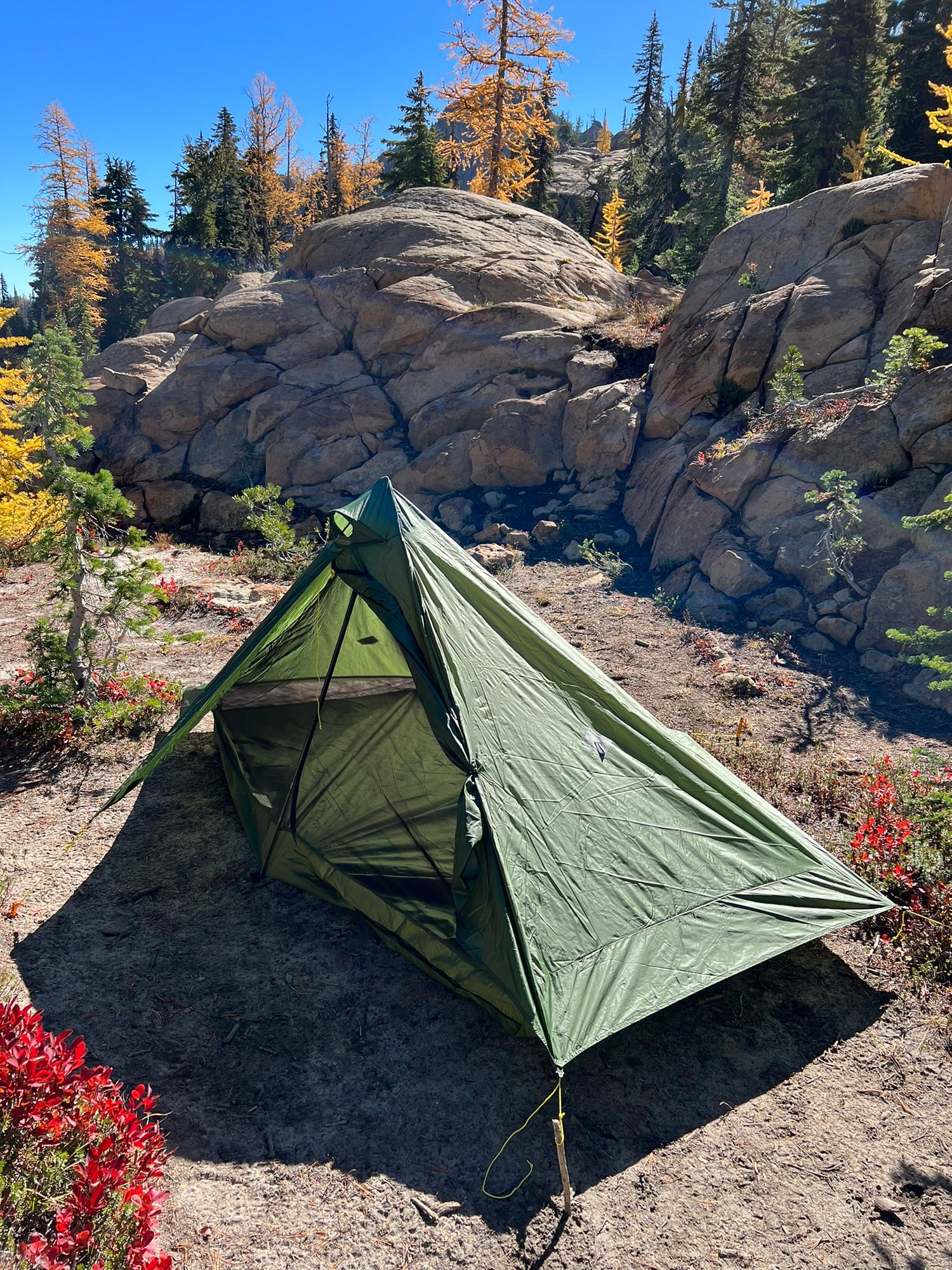
Thinking Ultralight: A Beginners Guide on UL Packing
Ultralight backpacking is an approach to hiking and camping that emphasizes carrying the lightest and simplest gear safely possible. This philosophy extends beyond merely reducing pack weight—it's about enhancing the freedom and joy of your hiking experience. Achieving an ultralight pack means meticulously scrutinizing each item, prioritizing essentials, and ensuring that every piece of gear justifies its presence by serving multiple purposes. Here’s an in-depth guide to embracing ultralight backpacking, tailored for both novices and seasoned adventurers looking to lighten their load.
The Core Principle: Use It or Lose It
The foundation of ultralight backpacking is simple yet profound: if you don't use it, don't bring it. This mantra encourages you to carry only what is necessary for your safety, comfort, and the objectives of your trip. Essential items like a tent, sleeping bag, and water filter are indispensable, but every other item should earn its place in your pack. This principle forces you to evaluate the true utility of each piece of gear, leading to more informed and selective packing choices.

Multipurpose Gear: The Ultralight Backbone
In the realm of ultralight backpacking, gear that serves multiple functions is gold. For example, instead of packing a simple pocket knife, opt for a lightweight multi-tool that includes a knife along with pliers, scissors, and other useful tools. This approach reduces redundancy and saves precious ounces. The key is to find gear that can perform more than one job effectively, thus allowing you to streamline your pack without compromising on functionality.
Small Things Add Up: The Art of Elimination
After covering the essentials, it's easy to start adding "just in case" items. However, these small additions can quickly compound, significantly increasing your pack weight. It's crucial to critically assess each item's necessity. While it's natural to want amenities that make the trail life more comfortable, weigh the value of each against its impact on your total pack weight. Sometimes, a simple alternative, like substituting a bulky hiking chair for a lightweight sitting mat, can provide comfort without the weight penalty.
Reflective Gear Analysis: Learning from Experience
A vital aspect of ultralight backpacking is the continuous evaluation of your gear based on real-world use. Take note of what items you actually use versus those that remain untouched. If you find, for example, that your tent feels disproportionately heavy, investigate why. Is it designed for more people than you typically hike with? Could a lighter, one-person tent serve your needs? By reflecting on your gear's utility and comfort after each trip, you can make targeted adjustments to further reduce your base weight.

The "Less is More" Philosophy
Ultralight backpacking thrives on the philosophy of "less is more." Every item in your pack should serve a purpose, and if it can fulfill two or more roles, even better. An exemplary piece of multipurpose gear is the Six Moon Designs Gatewood Cape, which doubles as a rain poncho and a tent shelter. This innovative thinking not only saves weight but also simplifies your packing list, making your backpack lighter and your trek more enjoyable.
Investing in Ultralight Gear
Transitioning to an ultralight setup often requires an initial investment, particularly in the "big three" items: shelter, sleeping system, and backpack. Ultralight versions of these essentials can be more expensive but are significantly lighter and just as durable as their heavier counterparts. When budgeting for gear, consider the long-term benefits of reduced pack weight, such as increased mileage and decreased fatigue, which can vastly improve your hiking experience.
The Weight Awareness Journey: A Crucial Step for Beginners
For those new to the ultralight backpacking philosophy, a common oversight is neglecting the weight of each item when purchasing gear. It's easy to focus on features, brand reputation, or even the aesthetic appeal of gear without considering its weight. However, in the realm of ultralight backpacking, every ounce matters. Here's how to integrate weight awareness into your gear selection process and why sometimes spending more can mean carrying less.

Embrace Weight Awareness from the Start
The first step towards ultralight backpacking is developing an acute awareness of the weight of every item you plan to bring. This means looking beyond the marketing and focusing on the specifications. Weight should be a primary factor in every gear decision you make. Begin by weighing your current gear and understanding the total weight you're starting with. This baseline will be invaluable as you seek to lighten your load.
The Investment in Lightweight Gear
One of the key insights for beginners is that reducing pack weight often involves investing in specialized ultralight gear. While ultralight items can come with a higher price tag, the weight savings they offer can significantly enhance your backpacking experience. For example, ultralight sleeping bags using advanced down or synthetic materials can halve the weight of traditional sleeping bags without sacrificing warmth.
Cost vs. Weight: Finding Your Balance
The decision to invest in ultralight gear is a personal one, often influenced by budget constraints. However, it's important to consider the long-term benefits of carrying less weight. Reduced fatigue, increased distance covered, and a more enjoyable hiking experience can justify the initial investment. If budget is a concern, prioritize weight savings on the "big three" items: shelter, sleeping system (sleeping bag and pad), and backpack, as these typically account for the majority of pack weight.

Making Informed Choices
Before making a purchase, thoroughly research products to ensure they meet your needs in terms of both weight and functionality. Read reviews, compare products, and consider the environments in which you'll be using the gear. Sometimes, a slightly more expensive item that offers a significant weight reduction can be a smarter long-term investment, enhancing both your enjoyment and performance on the trail.
The Role of Innovation and Technology
The ultralight backpacking community is constantly benefiting from advancements in materials and design. Manufacturers are innovating with lighter and stronger materials, offering gear that challenges the traditional trade-off between weight and durability. Keeping informed about these innovations can help you make choices that align with your ultralight goals without compromising on quality or safety.
Integrating Weight Awareness into Your Ultralight Journey
Developing a keen awareness of weight and making informed gear choices are fundamental steps in your ultralight backpacking journey. As you gain experience, you'll refine your ability to assess gear not just by its weight but by its utility, durability, and how well it fits your specific needs. Remember, the goal of ultralight backpacking is not merely to minimize weight for its own sake but to enhance your freedom and enjoyment of the wilderness. By carefully selecting gear that offers the best balance of weight, function, and cost, you can create a backpacking setup that's not only ultralight but also perfectly tailored to your adventures.

A Journey of Continuous Improvement
Adopting an ultralight backpacking approach is a journey of continuous learning and adaptation. With each trip, you gain insights into what gear is essential, what can be left behind, and what could be replaced with a lighter alternative. This process is not about reaching a definitive end point but about evolving your gear setup to maximize your enjoyment and engagement with the wilderness.
Ultralight backpacking is a transformative practice that challenges you to rethink what you need to thrive in the outdoors. By emphasizing careful gear selection, multipurpose items, and ongoing reflection on your experiences, you can significantly lighten your load. This, in turn, opens up new possibilities for adventure, allowing you to travel further, faster, and with greater ease. Whether you’re a seasoned hiker looking to shed pounds from your pack or a newcomer eager to start on the right path for your gear, practicing ultralight is always a good idea.
Reading next
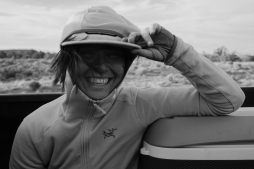
Your Guide to Hitchhiking by Jada Lippincott
Leave a comment
This site is protected by reCAPTCHA and the Google Privacy Policy and Terms of Service apply.
Free Shipping on Orders $150+
Lifetime Product Support
100% Satisfaction Guarantee
All Life is an Experiment
Ultralight travel packing list: 10 countries, one 7kg bag.

I’ve been bouncing around Asia and the Indian subcontinent for almost two years now, with a pack that weighs in at 15 pounds (7kg). This minimalist travel setup has served me well through monsoon season, snow and ice, storms, jungles, mountains and deserts alike.
As the stamps have accumulated in my passport, I’ve road-tested various types of gear, and switched out almost all of my initial travel kit. At the time of writing, I’ve managed to get my core packing list down to less than 50 items in total.
This is possibly straying into obsessive freak territory, and most people will do just fine taking a less extreme approach. The point of this list is to serve as a counterweight to all the hilariously bad backpacking guides out there, which imply you will meet some terrible fate in Scary Foreign Lands – possibly torn apart by a pack of ferocious timber wolves – if you don’t bring at least 16 pairs of undies and an emergency life raft and a year’s supply of wolf repellent.
Before we get into the packing list, let’s run through the general principles of minimalist travel:
1. If in doubt, leave it out
No traveler in the history of the universe – vertebrae creaking and grinding under the yoke of their ridiculous 80L pack – has ever said, ‘Boy, I wish I brought more stuff!’ When you first leave home you might feel like Elon Musk on a voyage to the alien planet Mars, but it turns out that the concept of “shops” has made it to overseas places too. If you do end up needing something, you can almost certainly buy it on the road, and often for next to nothing.
2. Invest in quality gear
Whenever I try and pinch pennies on the things I use every day, I always end up regretting it. Get yourself outfitted with a small amount of high quality gear to begin with, then supplement it with cheap disposable stuff as required.
3. Accumulate over time
If you can’t afford good stuff, just pick it up over time. It’ll take a while to figure out your preferences anyway – my list is still a work-in-progress, and I’m continuously optimising it as I go.
4. Multi-purpose everything
Pick neutral colours and styles. When every bottom pairs with every top, it means you can squeeze the maximum number of different outfits out of the minimum number of clothing items. Ideally you should be equally comfortable wearing each ensemble in a bar, an airport, or trekking through the jungle. In the same spirit, try and get multiple uses out of a single item – e.g. a scarf is also a spare towel/sarong/sleep mask/garrote.
5. It’s not a competition
If you’re traveling for a really long time, you’re definitely going to want more than the bare basics listed below. I tend to buy a bunch of household stuff when I’m going to settle somewhere for a few months, then give it away or sell it when I leave. I stashed a guitar, yoga mat, and a few extra clothes in Chiang Mai, Thailand for a while, and have a similar cache at my parents house in New Zealand. Remember, there’s no trophy for being the most hardcore minimalist.
Onward to the list! (or use these links to navigate to a particular section)
Backpack – Clothing – Accessories – Toiletries – Health – Electronics – Apps

Pack selection is crucial. If you have a big bag, you’re guaranteed to fill it up with junk. If you have a small bag, you’ll be forced to pack more thoughtfully. The sweet spot is anything carry-on sized, which is up to 45L or so (twice my current capacity). That way you get to skip checked luggage queues and fees, can keep it with you at all times, and always find stuff easily, among other benefits . As a rule of thumb, ask yourself whether you could walk around comfortably carrying the pack (I like to think of this as Super Hans’ Law):

I used the Macpac Kahu 22L for the first 18 months, then traded it with a friend for the slightly more spacious 26L Osprey Pixel pictured above (1). It’s still not perfect for my needs, but I’ve got my eye on a new Macpac model which looks like it might just be The One.
Heres’ what to look for in a pack:
- Water resistant fabric
- Metal, lockable zippers
- Sturdy haul loop
- Not too touristy-looking
- Flat compartment for documents and/or laptop
- Hip belt (if you’ll be hiking)
- Drink bottle pouch, clips to hang stuff on
2. Flat panel dry bag
Dry bags are handy for quarantining laundry/smelly clothes, protecting valuables from boats/dives/rain, and as a mini daypack for when you’re out and about. They weigh virtually nothing, and take up almost no room. I got this FeelFree one with a flat panel, because it sits more snugly against my torso.
3. Combination padlock
Not all hostels provide locks, and you’ll also want some security when you’re on night buses or trains. I have a TSA approved lock in case I ever need to check the bag in. A padlock doesn’t stop someone from taking off with the whole pack, which is where a bike lock comes in handy (thread it through the haul loop and attach it to a pole/bed frame/sturdy thing).
Clothing (lower body)

1. Macpac/Icebreaker merino underwear x 2-3
Merino wool is expensive, but worth every penny. This is going to be a recurring theme, so I’ll get it out of the way now: This stuff is woven with some sort of black magic. It doesn’t smell. It’s super light. If you air it out, or hang it in the sun, it’s back to new. If you wash it in the sink, it dries overnight. I’ve alternated between the same two pairs of briefs for almost the entire trip. With cotton undies, that would be exactly as disgusting as it sounds. With merino, I promise you it’s not. Macpac and Icebreaker are both excellent brands.
2. Merino socks x 2
Same goes with the socks. I don’t wear shoes that often, so two pairs is more than enough. It is quite a revelation to realise you will never wear smelly cotton gym socks again.
3. Adidas Climalite shorts
Are they casual streetwear? Swimming trunks? Gym shorts? All three, of course! I like the Climalite fabric , but anything that ticks the above boxes will do the trick.
4. Short pants
Right now I have el cheapo cotton ones, but I’m hoping to get my hands on these (you guessed it) merino blend bad boys from Icebreaker. Make sure the colour you choose matches all your shirts. I like bone grey, although no-one should be taking fashion advice from me.
All the packing list guides will tell you that jeans were created by the Devil himself as a ploy to ruin the lives of backpackers: Denim is made of cotton, it’s heavy, and it’s no good in hot climates. Honestly, I think I’m siding with Lucifer on this one. Is there any more comfortable, all-round versatile item of clothing on the planet than blue jeans? You can dress them down with a t-shirt and flip-flops, or dress them up with a button-down shirt. Everyone in India quite happily wears jeans without collapsing from heat exhaustion. You can blend in anywhere with jeans, whereas the six billion pockets on your daggy travel pants basically scream “HI I’M A TOURIST!”. There’s no getting round the fact that they are rather bulky, so I just make sure to wear them whenever I’m flying.
Alternative: If anyone knows of any ‘travel pants’ that aren’t ugly as sin, let me know. I’m also thinking about getting some tailor-made linen chinos, which I’ll report back on later.
Clothing (upper body)
1. icebreaker short sleeve t.
Merino blah blah, you get it by now. Versatile enough to wear in any context, from a social thing to a hike to the gym to walking down the street. When you’re cold, it keeps you warm. When you’re warm, it keeps you cool. I usually cycle through a cheap cotton t-shirt on the side for a bit of variety too.
2. Icebreaker long sleeve T
This is useful as a base layer for warmth. If I pair it up with my other merino shirt, then it’s really toasty (this is what I did in the Himalayas). It’s still lightweight enough to wear casually, and doesn’t look like some sort of weird fetish sports clothing.
3. Oxford shirt
It’s useful to have at least one dress shirt for meetings, applying for visas, and other semi-formal occasions. The blue Oxford button-down is a great all-rounder. At one point I had a polyester blend from Pierre Cardin which didn’t need ironing, but I’m still on the lookout for the perfect travel shirt.
4. Shell jacket
Depending on where you’re going you won’t need a jacket at all – I didn’t have one for most of my time in Southeast Asia, and just used a plastic poncho when it rained. I bought this alleged “North Face” jacket for $12 in Nepal, and it’s since come in handy quite a few times. It’s only got a thin shell, but it cuts the wind and rain while providing a bit of warmth.
5. Sleeveless T (not pictured)
For the gym, or just whenever it’s too hot to wear a proper shirt. Mine is stained from full moon party glo-paint, Holi colours, and has many other fascinating burns and holes, but I just realised I’ve lost it somewhere. RIP.
Footwear and accessories
1. jandals (flip-flops).
This is what I wear 90 per cent of the time. You can wear jandals anywhere, as I think Ed and I have proved beyond a shadow of doubt . When they’re not in use, they’re easy to hook onto my pack. I don’t buy fancy brands because it’s too heartbreaking to lose them, but I do make sure to get ones with a bit of arch support.
2. Timberlands (or similar)
One of the biggest challenges in minimalist packing is getting down to a single pair of shoes. It’s a hell of a hard task finding something you can wear to a club, to the gym, on a hike, and on a motorbike, but I think I’ve almost cracked the code: Leather and water-resistant, with good grip, without looking too goofy. Chukka boots, Timberlands, or even boat shoes might fit the bill. The raised heel is useful for weightlifting, there’s decent tread and a bit of ankle support for hiking, and they pair up well with blue jeans. If you like jogging, I don’t know what to tell you (except may God have mercy on your soul).
3. Light scarf
Someone gave me this scarf in Thailand. I’ve since used it as a makeshift blanket, sarong, beach towel, dust mask, curtain, and sometimes to keep my neck warm.
4. Baseball cap
Loops onto the top of my pack when not in use. If I didn’t have long hippie hair to protect my neck I’d probably get one of those cool Legionnaire-style hats with the bumflap.
5. Sunglasses
I destroy or lose sunglasses constantly, so I usually go for ones which actually do have UV protection, while still being as cheap as possible.
6. Beanie (not pictured)
Plain black, cotton. I almost never need it, but when I do, I’m glad it’s there.
Toiletries and miscellaneous
1. macpac microfibre travel towel.
Rolls down really small, and dries easily. Still going strong after several hundred uses.
2. Toiletries bag
Some people have those cool ones with all the compartments but mine’s just a freebie from some airline. There’s nothing wildly exciting here – nail clippers, toothbrush and paste, razor, no-handle hair-brush, roll-on deodorant.
3. Potions and lotions
I’ve never had to buy soap because you get a million free ones from hotels. I use regular soap (or shampoo) to wash my clothes in the sink when there’s no machine. My beauty regime is pretty much nonexistent, although I do carry sunscreen (SPF 30+, travel size) and usually bug spray.
4. Wahl travel trimmer
Honestly not very powerful, but it is incredibly light, and only uses a single AA battery. There’s a guide for different lengths so you can trim your beard or unmentionables just the way you like, or use the bare blade for a dry shave.
5. Money and passport
Passports are generally deemed quite useful for international travel. I always keep a stash of US dollars on me, and at least two credit/debit cards, preferably from different banks.
6. Pen and notebook
Always handy, especially for filling out forms ahead of time.
Health and fitness
Pack of cards.
I mostly do calisthenics (bodyweight exercise) to keep fit, which works great for travel because it requires no equipment. With a bit of imagination, a pack of cards becomes a portable pocket-sized gym . I also use it for brain training (memorizing a shuffled deck as fast as possible) and occasionally even play cards with it.
Resistance band
For stretching and mobility work. Takes up almost no room.
A few painkillers and antihistamines, iodine, plasters, tape, tiger balm. Again, you can buy this sort of stuff anywhere, and put together a proper kit if and when it’s required.
Electronics
1. acer chromebook r11.
While the obvious choice of travel computer tends to be the Macbook Air, I don’t need that level of functionality, or want to carry around something so expensive for no good reason. The R11 weighs 2.7 pounds, costs less than $300, and is good for anything up to basic video editing. It has a 360 degree touchscreen so I can use it as a tablet to read on, or watch movies, and an epic battery life of 10 hours plus. I frickin’ love this thing.
2. Kindle Paperwhite
I pick up actual books and trade them with friends as often as possible, but they’re too heavy to carry around. E-readers kind of suck in comparison, but the Kindle is growing on me. The battery lasts weeks, so you can use it instead of wasting precious phone or battery on 16 hour bus journeys. They’re also a vastly better experience than trying to read books on a phone or computer. Make sure you get one with a backlit display, like the Paperwhite, so you can read in any conditions.
3. Moto E4 Plus
This thing has a mega battery that lasts for two full days . It’s impossible to overstate how revolutionary that is while traveling. I laugh heartily at my iPhone-toting friends who are constantly desperate for a charger. The Moto family are the best budget Android phones on the market, but they do take shitty photos (this is a feature not a bug for me, because it forces me to use my actual camera).
4. Sony RX 100 II
This little beauty takes crazy good photos for its tiny size, with a massive sensor and a full range of manual and automatic settings. If I wasn’t travelling I might get a DSL, but it would be a close call. The RX series are the best point-and-shoots on the market (there’s also a Mark III , IV , and V , all of which are under $1000, with specs that are starting to put DSLs to shame).
5. Jaybird X2 sports headphones
After doing a ton of research, I decided that noise-cancelling wasn’t worth it for the rare occasions it’d be really handy (like on planes). Instead, the passive benefits of in-ear seem to be the way to go. I use the Jaybirds for calisthenics, which means they have to stay in when I’m upside down, and resist sweat. They have solid battery life, and are really comfortable, with a whole range of wings and buds to suit your earhole. I also keep a wired pair of generic earbuds around for when I’ve run out of juice.
6. Universal adapter
I’m pretty sure this generic adapter cost me all of three dollars, and it hasn’t failed me so far. Super handy.
7. USB charger
There’s no point carrying four separate chargers and cables for my Kindle, phone, headphones, and camera. Instead I have a couple of cables between them and just alternate, or plug into my laptop and use it as a power bank.
Travel apps and services
Download an entire country or regional map, then navigate offline without any WiFi or data. Usually comparable quality with Google Maps, and sometimes even better.
Uber and Grab (Asia)
A great alternative to price-gouging local transport cartels, with GPS pickup and dropoff, and linked to your card so you don’t have to mess around with cash. In Asia, I prefer Grab over Uber. They’re trying so hard to acquire users that the promo codes are super generous, to the point where I almost never actually paid for a ride.
Sign up with this link and get $5 off your first Uber. Download Grab for iOS or Android .
Transferwise
I use Transferwise to move money from home to my Thai bank account, as well as to pay people in foreign currencies. Not only does this eliminate ATM fees, I get the actual mid-market exchange rate instead of getting ripped off by brokers.
Couchsurfing
I’ve had a great time hosting fellow travelers. Tinder is another good way to meet new people (seriously). I’ve written a whole article on making friends as a solo traveler which will be up on the blog soon.
- This is always going to be a work-in-progress. I’ll keep the page updated as I come across better equipment and fill the remaining gaps in my list.
- This list is biased towards warm climates, because I personally hate the cold. Yes, I’ve been across the Himalayas, but I bought some fuzzy pants and gloves, and was hiking all day to keep warm anyway. For a really savage winter, you’ll want a proper coat, sweater, maybe some thermal underwear, a thicker scarf, etc.
- This list is obviously very male-centric, because I can only speak to my own experience. One of my nomadic lady friends is even more hardcore than me about this sort of thing, and has promised to share her own packing list soon – watch this space!
Enjoyed this article? You might also like:
Not sure what the future holds get your copy of optionality now..

Any updates ?
thank you Richard, this will help me a lot
What a nice post! <a href=” https://targethandshooters.com/product/beretta-92fs/ “>beretta 92fs for sale</a> Thanks a lot for this Blog commenting sites list that is very helpful for every newbie like me. Getting this post I benefited. Please keep it up.
The advancement of technology has positively influenced the growth of businesses all over the planet. With the help of modern technologies like websites and mobile applications, every firm can sell its products or services online without hassle. We, QuikieApps,<a href=”https://ammoranger.com/product/federal-premium-gold-medal-berger-ammunition-6-5-creedmoor-140-grain-hollow-point-boat-tail/”>Federal Premium Gold Medal Berger</a> have acquired recognition and reputation through the reliance of our respected clients as the top Web development company in Bangalore, India, USA, UK, Dubai. Adapting the dynamic technology of the web and mobile applications <a href=”https://ammoranger.com/product/federal-varmint-ammunition-6-5-creedmoor-95-grain-hornady”>Federal Varmint Ammunition 6.5 Creedmoor</a> is the first step to success in this modish and competitive world.
Wow, great article for people traveling in Asia and the way you portrayed journey preparation, it’s just awesome. Also this is very important, thanks for this content.
I pack the bag very well before any trip but while heading back there not much space available in the bag. LOL.
Sachin wants advice on travel with a pet – what sort of pet, a hamster or a Great Dane?
Tell us more and we will try to help. My partner and I recently made a cross country trip from East Java to West Java with two cats, and if anybody can survive that, they (and we) deserve a medal!!
What a superb article on Ultralight Travel Packing List :O i never imagined this information can be so useful! I found that all your articles are also amazing, I would feel so happy share it with others!
I try to carry minimum articles. Well, thanks for this post it is really helpful.
This is a great list to begin reducing the weight of travel bag. Thanks for the tips. But I am planning to have my pet with me while travelling. It will be great if you update the tips for those who have pets 🙂 Looking forward to update.
It was an amazing read. Thank you very much for sharing this article. I’ve bookmarked it.
Great article. Thanks for sharing this article with us. I really appreciate your hard work.
Thanks For Sharing and Your writing style has been Superb. <a href=”maps.google.com/url?sa=t&url=http%3A%2F%2Fshop2baby.com/best-little-angel-diapers-medium-size-under-650/”>Little Angel Diapers medium Size</a>
I think we can also carry a sleeping bag with us for sure 🙂
Thanks for these tips as I’ll be traveling to some historic places soon.
Nice way to represent information about such an useful product. priority product for those who love travelling.
PC build Guide and Electronics Gadgets Review
Great Article! Very informative post, thanks for sharing valuable content.
This article really good written, made feel crazy for effective travel packing.
I am thinking of skipping toiletries and confirm with hotel in advance if they will be providing toiletries.
Nice Article
Check out Eddie Bauer Guide Pro pants are the best. Perfect for comfortable travel, light, look great, awesome for hiking/nice events/anything!
Nice Post. Excellent Work.
Your blog is so good and informative. Keep up the good work.
Great Job! I really like your post. Thanks for sharing.
Thanks for taking the time to share with us. But some how we will forget something needed.
This is really well written and researched article. Nice one mate..!!
You ought to be a part of a tournament for one of the most effective blogs over the internet. Let me recommend this web site! best backpacks for law school
First of all, I really appreciate the way you packed your traveling bag. Your post will gonna inspire other travelers for their tours. Thank you for sharing this helpful post with us.
Perfect Article, with a lot of useful informations. My favourite merino items are made by Zajo. It’s a slovakian brand (i’m from Hungary, so it is created by in my neighbour), really good queality. I travel a lot, and the merino is the perfect choose in every season or weather. 🙂
Thank you for sharing some helpful information! ^_^
Thanks for including a piece of advice from the mind of a crack-addled maniac.

I’ll tell you what…that crack is really more-ish.
Thanks admin for sharing this informative article.
Are you still going strong with the packing? I’m also getting in to the ultralight packing on my one-year trip around Asia. Do you have an updated version or is this still your latest?
All the best,
Hey Eli, I’ve made a few changes to the way in which I travel – might write another post at some point. For backpacking-style trips, I still use pretty much the exact same set-up.
Traveling packing is a very important part because the things we need are to be remembered. I will use these tips for my traveling trip. I am going to next week in Manali so I will use your tips. Thanks for sharing such a useful post.
I am reaching out to give you heads up for your website and the excellent content you are posting.
Hey, great article about traveling needs. I plan on traveling soon so I got myself a cabin bag from online. Can you please write something about Cabin Bags like pros and cons.
Hello Richard M. I came across your blog by chance and if you are still hanging around in India, I have an offer for you if you are still looking to upgrade your backpack. You’ve mentioned that you’re keen on a Macpack, but hear me out.
I have a Minaal Carry-on 2.0 which I bought via Kickstarter in 2016 for travels just like you do. Since then I’ve upgraded to an Osprey and I’m looking for a good person who would be interested in taking care of the Minaal and make full use of it. It’s in impeccable condition, sparingly used. Originally, I paid $249 USD, but I’m willing to negotiate some.
What is a Minaal Carry-on? https://www.minaal.com/products/minaal-carry-on-bag I’m in Kolkata, West Bengal.
Hey Uday, just saw your comment. I’m not in India any more sorry – the Minaal looks like a great bag though.
Man I found your blog 2-3 days back and I’m considering to go with your idea of packing but I might need few more stuff so I’m planning to go with a 40L backpack Thanks man for sorting this out so nicely 🙂
The men’s ABC pant from LuLu lemon is an amazing travel pant that has taken over my jeans and is super light. Worth the look
this post is awesome and very informative, thank you you think i could fit all this into a duffle bags?
Hi, I really like the Prana Brion pants. Extremely comfortable and lightweight, but also very tough. They use a high amount of nylon, but Prana has figured out how to make these pants look casual and not as though I’ve been wearing them for two months. Best of all, they don’t make the swishing sound that almost all travel pants do. And they’re under €100.
Love this. I can say I will very likely be following a similar list thanks to you. If you haven’t heard of the brand Lulu Lemon you should check them out. Their ABC pants are a treat!! The definition of comfort in a dress up/down pant. I’m still struggling on footwear myself, seeing as my trip will include Peru, India and then Europe (Amsterdam to start). I need something wearable to potentially work in a dressy location while being tough enough for Peru and India. Thanks for your work Richard!
For some reason I didn’t think Lulu Lemon made clothes for blokes, thanks for the tip Dexter. Your trip sounds awesome – have fun!
What’s the reason you wouldn’t use barefoot shoes like five fingers? They’re ultralight, durable and suitable for hiking. I’m traveling in 3 months and considering some of those instead of heavy boots.
Mostly just aesthetics, I guess. Maybe I ought to give them a try, but I can’t help but feel the Vibrams in particular are an abomination unto God.
I had both a G.P. doctor, and a Podiatrist (foot specialist) doctor at McCormick Hospital in Chiang Mai, Thailand tell me NOT to wear socks and shoes in the hot tropics if at all possible, but to go barefoot, in a good pair of sandals. Not flip flops, because flip flops cause things like “hammer” toe, don’t have proper arch support, and cause other bad problems in the long run, like Achilles tendonitis for instance. They’re okay for a short time on the beach or around a pool for an hour or so. But for all day walking, your body will thank you for proper sandals with arch support and heal strap.
I got a good pair of Teva Holliway sandals with good arch support and proper heal strap. They feel much better on my feet.
Why no socks and shoes in the hot tropics? In the tropics, socks and shoes are actually detrimental to foot hygiene. Because in socks and shoes in the hot tropics, your feet are bundled up in cloth and shoes, and it’s a hot, dark, sweating moist, breeding ground for bacteria.
Barefoot in sandals, your feet are exposed to the air and sun for quick evaporation and exposed to the air for quick drying, much less bacteria growing and reproducing. Your feet will actually stink a lot less. Also less chance of an infection taking hold in your feet. It’s bacteria growth and fast bacteria reproduction from hot sweaty moisture being cooped up in socks and shoes that caused bacteria and stink.
Today, I only wear socks and shoes if I am in a country that is very cool or cold, and it’s snowy wintertime. Otherwise.. barefoot indoors, and barefoot in sandals outdoors.
My feet are happy now. 🙂
Hey Robert, thanks for the thoughtful comment. I pretty much never wear shoes in the tropics either – bare foot as much as possible, and flip-flops the rest of the time (I have a pair with a little bit of structural support built in, but yeah, sandals would no doubt be better).
Have you looked into wool and prince for oxford or any button down shirt? They’re all made out of merino wool, have several that I use for travel and love them. Also a good alternative to jeans are outlier pants, have a couple pairs, they pack smaller and still give you a similar look.
It’s funny isn’t it? I almost always lose my tank TOP before anything else!
Check out Outlier Slim Dungarees as a denim alternative. They’re super comfortable and look just like jeans.
- Skip to primary navigation
- Skip to main content
- Skip to primary sidebar
Her Packing List

Pack Light. Travel Confidently.
Light packing tips, gear and inspiration!
Make a List
Carry-on-only packing made easy.
Travel Confidently
Our best travel planning insight!
Join an HPL Program
Need more help? Let us be your guide.

“Love HPL! I found it when preparing for my first solo overseas adventure at 18, and it’s given me the tools to go carry on only for every trip in the past 6 years!” —Emily Craddock
“I used to have a huge suitcase. When I discovered Her Packing List, I learned so many tips and even found out about handy products that I use in my everyday life. Since then, I’ve backpacked Europe- twice! I never could’ve done that with my bulky luggage in my pre-HPL days.” —Jessica Lippe, JessicaLippe.com
“I relied heavily on Her Packing List for a three-week trip through Italy. My family of five was able to travel carry-on only. The staff at the Rome airport actually commented that they couldn’t believe how little baggage we had!” —Jennifer Leon
“Her Packing List shaped the way I travel and inspired me to pack smarter.” —Sarah, Seattle to Unknown Podcast
“I love the Facebook group. Connecting with fellow travelers makes it easy to get recommendations for places to stay, restaurants to eat at, people and places to avoid, and more. There’s definitely a lot of camaraderie among women who travel!” —Emily Gitelman, @emilygitelman
“HPL has been there as I’ve grown from a naive and nervy first-time solo traveller to a seasoned and confident lightweight backpacker. This is the first place I come to when I’m planning a trip. I know that a whole community of travel-loving gal pals has been there before me!” —Charlie Murrell-Edwards, Lessons in Transience
“Her Packing List empowered me to start packing less so I could travel stress-free more!” —Keri Mau, kerimau.com
Where are you going next?
- Ivory Coast
- Sierra Leone
- South Africa
- Dominican Republic
- Puerto Rico
- Czech Republic
- The Netherlands
- United Kingdom
- Cook Islands
- New Zealand
- Papua New Guinea
See Posts about Your Destination
Packing Light

No Comments
The Best Australian Travel Gear to Help You Pack Light

20 Comments
Top Travel Dresses for Every Trip + How to Pack Them Right

14 Comments
How to Successfully Travel with Contact Lens Solution

18 Comments
The Best Convertible Travel Clothing for Women: Pack Less & Do More

The 32L Zuca Pro Carry-on Suitcase: You Can Actually Sit on It

How Much Money Can You Save Packing Personal Item Only?
Packing lists.

Ultimate Female Travel Packing List for Amsterdam

35 Comments
Pack Light for Paris in Spring: One Woman’s Essential Packing List

Ultimate Female Packing List for Spain in Spring

Ultimate Female Packing List for Japan (in Spring)

Ultimate Female Packing List for Transylvania in Early Spring

Ultimate Female Travel Packing List for Austin in Spring
Trip planning.

Staying Connected: How to Use Your Phone While Traveling Abroad

43 Essential Apps You Need When Traveling

11 Comments
Female Travel Safety Advice: Listen or Ignore?

15 Small Splurges with Priceless Safety Perks

First Timer’s Guide to Public Transportation

Pre-travel Checklist: Last minute things to remember before traveling
About her packing list.
Her Packing List is the premier site for female packing and travel gear advice. Targeted to low-key female travelers, we help you pack what you need and leave what you don’t.
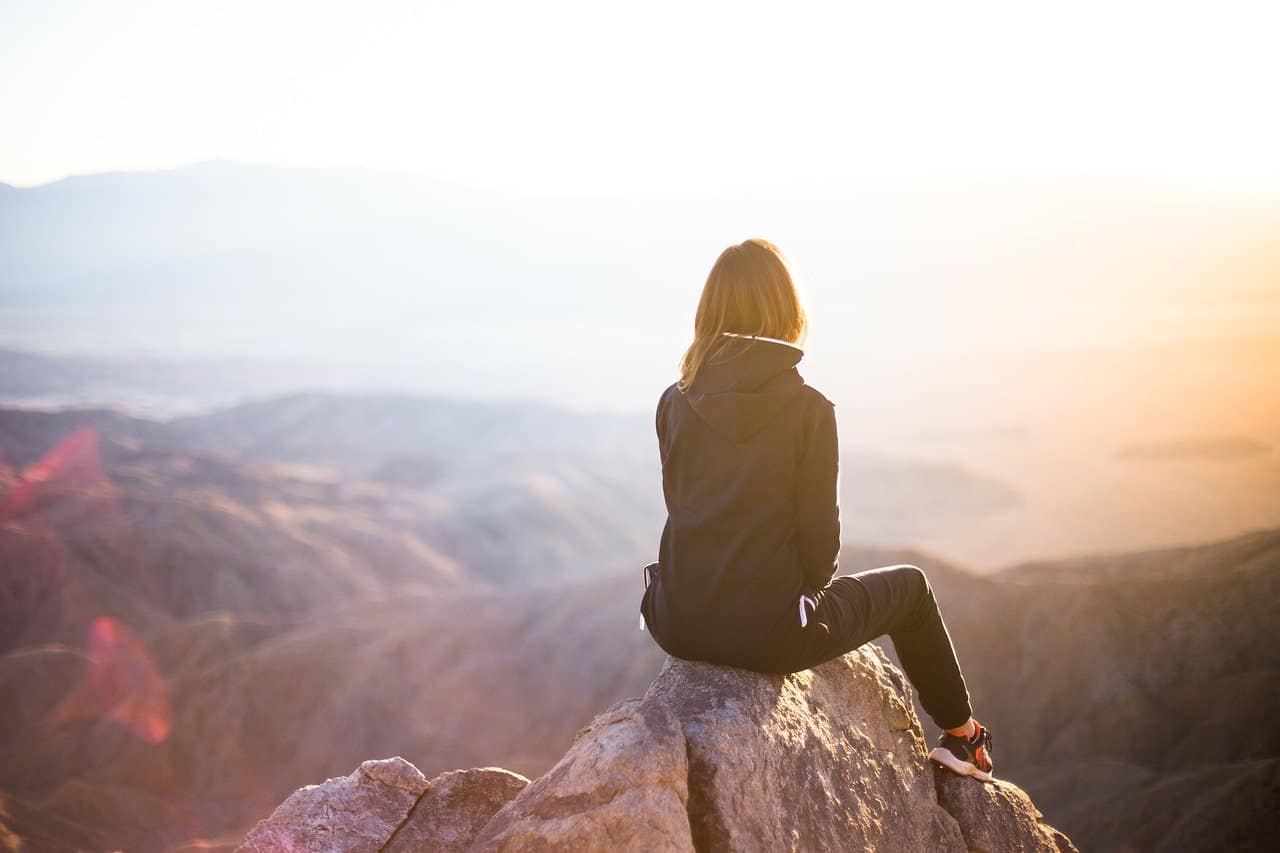
Minimalist Packing List for Females Traveling to Europe
My introduction to traveling minimally started on my first backpacking trip to Germany, the Czech Republic, and Hungary when I was just 17 years old! Truth be told, half of what I was carrying never got worn or used. Since then, I’ve learned quite a lot and have been working on creating this minimalist packing list for females going abroad!
Of course, your packing list is going to vary immensely based on where in Europe you are traveling, what season it will be when you’re there, and how long you’re going for, but for the most part, the lists below are comprehensive and will ensure you have a successful trip!
Use the table of contents below to direct your search based on the length of your travel. Ultralight travel will include day trips to new cities, overnight travel focuses on weekend trips, and long-term travel will be for trips that are two weeks or longer.
I have also included some helpful minimalist packing tips at the end of this post to answer all of your grueling questions.
I hope this guide makes the packing a breeze for your next European getaway so you can just sit back and focus on all of the adventures yet to come!
Happy Travels!
Get My FREE Ebook! Transformed by Travel: the risks & rewards of backpacking Europe (a life-changing journey)
What should a girl have in her toiletry bag.

Alright, ladies… you can’t bring 3 different mascaras because they “help your lashes” if you’re trying to pack minimally.
This minimalist packing list for females is intended to be just that. MINIMAL . When it comes to toiletries, only back the basics…
This means shampoo and conditioner , deodorant , toothpaste and a toothbrush , chapstick , moisturizer , a razor , some dental floss , face wash , and body wash . You could even go as far as just using the hotel soap as body wash to save your bag even more room.
If you feel like you would really like to have some makeup with you, I get it. I do too! But, only bring along some mascara and maybe one lipstick . Just enough to tie your outfits together and make you look like you didn’t just drag two suitcases off a plane ( am I right? )
Don’t go overboard with palettes of eye shadow, foundation, etc. The truth is you won’t need it, and chances are they’re going to get broken up from all the moving around and spill all over your other products. Been there, done that. Instead, opt to pack minimally !
How do you Become a Minimalist Packing Queen?

When it comes to being the king or queen of packing minimally, it’s imperative that you actually follow this minimalist packing list for females (boys, you too)!
You need to really think about your priority items and make room for them right off the bat. Then, lay out everything else that you might bring and decide if you actually need , or just want the items.
If you can’t think of a definite situation that is guaranteed to happen where you’ll need the item, then don’t pack it. Once you have everything you actually need sorted, then take a look at how much room you have left in your bag .
If you have room leftover, you can consider packing one or two items that you wanted to bring originally or leave the room available for souvenirs, etc.
If you have no room left, then you may want to consider taking out an item or two so you have room for anything you may want to buy while you’re traveling.
It’s a long, drawn-out, “unpack and repack” process, but you’ll be grateful that you didn’t overpack!
Minimalist Packing List for Females: Ultralight Travel

It’s always so exciting when visiting a new city! Paris , London , the countryside of Ireland, no matter where you’re going you can almost guarantee that you’re not going to need much if you’re only traveling for the day.
That’s why I created this ultralight travel packing list ! I want to prevent you from having to go back to your hotel in the middle of sightseeing to grab something you couldn’t carry or from carrying far too much and ending up with an aching back.
Trust me, I’ve done both, and neither are fun and both end in frustration.
So, check out my ultralight travel packing list below and keep an eye out for my special links! If you see something you like that you might want to include on your next vacation, the link will bring you to the right spot (usually Amazon).
To start off this ultralight travel packing list, you’ll need a day backpack . I use the Osprey Fairview 40 and absolutely love it! It has two buckles, one for the chest and a padded one for the waist to keep the weight evenly distributed on your back and hips.
It has plenty of compartments and is large enough to hold everything I need for the day (I’ll tell you more about this below) without being too bulky. The back also has two security straps to deter pickpocketers.

Once you have a good day bag, you’re ready to start packing!
Even if you are only planning on traveling for the day, it’s important to be prepared. Nobody likes having to run back to their hotel room to get a jacket because it got cold outside.
So, follow this list carefully and ensure that whatever day bag you use has the capacity of carrying what you’ll need it to while still being comfortable.
One other thing I want to mention is what resource you get your water from… while many European countries do provide clean drinking water, there are also many who do not.
I love my LifeStraw Reusable Water Bottle because it filters any outside chemicals, bacteria, and other stuff you definitely shouldn’t be drinking. It allows me to omit buying single-use plastic water bottles and brings me ease of mind knowing I won’t get sick from filling up my bottle in a hotel sink if I need to.

Even if you aren’t traveling to Europe, this water bottle is great to have no matter where you are in the world!
Minimalist Packing List for Females: Overnight Travel

Have you ever decided to book a long weekend trip and then realized you only knew how to pack for either one day or one week? Me too!
I would either end up re-wearing the same clothes for two of the days or I would end up carrying 4 pairs of shoes for a 3-day trip. But, luckily, I have finally found the perfect in between overnight packing list for females that I’m sure you’ll find useful on your next weekend getaway!
The list below focuses on packing for a European destination in the spring, summer, or fall for a long weekend. Of course, you may need a warmer jacket in the fall than in the summer, but you’ll still need a jacket nevertheless.
Bear in mind when you will be traveling and check the weather before you leave for your trip.
Now, you may be thinking, “ what about my hair styling tools?! ”
Forget about them . Most hotels provide a hairdryer and you won’t need a hair straightener or a curling iron if you’re trying to pack minimally. They take up a lot of room in your bag, add a lot of weight to your back, and are often only used once or twice over the weekend. So, leave them at home!
Also, if you are traveling with any medical prescriptions, you may need to have a doctor’s note to accompany the bottle. In most cases, all of the information that TSA will need will be listed on the bottle itself, but for some, a doctor’s prescription and approval for travel will be required.
As for the battery pack, I use this Ultra Compact Portable Charger .

It’s lightweight, has a very long-lasting battery so you can charge while on-the-go without having to worry about it dying quickly, and has several charging ports so you can charge your phone and camera (if applicable) at the same time.
Minimalist Packing List for Females: One Week Travel

Many of my trips started out around 4 days (2 days per city) and then gradually grew over time to one week, and I have found that this has been the easiest to pack for.
One week trips became the most common for me as I started traveling abroad more and more, so this is where I found myself almost always having the right items with me. I got really good at estimating exactly what I would need for the trip and figuring out how long I could go without doing laundry… but still have clean clothes.
If that doesn’t make sense to you yet, don’t worry, it will! The more trips you go on, the more this will make sense.
I’m excited to offer you this list since I have been editing it for years and it is finally ready to be shared! Keep in mind, you’ll still need to pay attention to your destination, the season, and the weather before packing.
Also, if you enjoy buying clothing as souvenirs when you’re on the road, be sure to keep some space open for things that you buy.
For example, if I know I’ll be traveling for about 2 weeks and will need 5 or 6 t-shirts, I’ll only pack 4 and then buy one while traveling.
This not only gives you an excuse to buy an awesome souvenir but also ensures that you’ll have the room available to bring it back with you!
Similar to the overnight travel packing list, this week-long travel packing list doesn’t include any hair styling items.
If you absolutely need them, try to choose just one and remember that most hotels have hairdryers in the room. If you are traveling with someone else who also uses the item or product, ask if they would be willing to share it with you so you don’t end up traveling with two of the same thing.
The items above are what I would bring along for a week-long trip to Europe in the shoulder season months. But, if you’re traveling in the dead of summer , you will probably want another bathing suit and you can omit one of the sweaters (not both!)
Minimalist Packing List for Females: Long Term Travel

When I first started my long haul backpacking trips, I was carrying a 65-liter Osprey Backpack on my back that nearly ended my trip early… I truly thought I needed everything in my wardrobe and I couldn’t survive without “the essentials”.
Don’t get me wrong, I truly love that backpack for hiking and shorter trips (one-week trips were perfect!), but carrying it for weeks on end was not enjoyable.
Not to mention, it never fit above my head or under the seat on trains or buses, so I always had to keep it on my lap. Not exactly how I pictured my trip going…
If this sounds familiar to you, I’m sure you’re wondering what you should ** actually ** include in your minimalist packing list for females.
Check out the list below and cross-check what I’ve mentioned and what you have. I’ve made it super simple and included links for company-specific items that have changed my traveling for the better, and that I think will do the same for you!
The packing list above has been created for trips taking 2 weeks or longer . Now, you’re probably starting to realize that it’s not super different from the one-week packing list, and that’s because it would be impossible to carry 14+ different outfits with you while traveling.
If you’re trying to pack minimally, chances are you won’t be checking a bag on your flights. So, in order to do that, you won’t be able to pack enough different clothing for 2+ weeks of traveling anyway!
Instead, you’ll need to find accommodations that have laundry services available.
Trust me when I say that spending the few extra dollars it will cost you to do laundry is far better of an option than carrying around two weeks worth of belongings everywhere you go!
Minimalist Packing Tips

Whether this is your first time attempting to pack minimally or your hundredth, there are a few tips I want to share with you that might make your packing experience go a little bit easier.
✔️ First off, use packing cubes .
I personally love my Veken ones since they come in fun colors and are a bit more durable than other brands. They also provide a shoe bag to prevent your dirty shoes from touching your clean clothes!
Packing cubes make it super simple to keep your clothes and shoes neat and orderly. I can’t even begin to tell you how many times I haven’t used packing cubes and my clothes ended up in a jumbled mess on the floor of a hotel room…
✔️ Next tip, roll your clothes before putting them in your packing cubes.
This saves space and prevents them from getting wrinkled.
✔️ Also, try to plan out your outfits ahead of time.
You might be asking yourself, “how am I supposed to know what I’ll want to wear each day?”, and the good news is you don’t have to! Simply create the outfits ahead of time, then mix and match when you get there.
Keep in mind that if you’re traveling for 7 days, you won’t need 7 pairs of pants. Simply choose 2 or 3 pairs that work well with your tops.
This will help you to prevent overpacking and will save you time when getting ready each day.
✔️ Also, pack your toiletries in these TSA-approved reusable bottles .
They’re refillable, easy to clean, and you can always guarantee they’re not going to get thrown away at security for being over the ounce limit.
✔️ I also use one of these clear TSA-approved travel bags so I don’t have to waste a quart-sized plastic bag whenever I travel.
✔️ If you must pack a pair of larger hiking boots or a winter jacket, wear them on the plane.
Yes, it will be a pain to take everything on and off going through security, but it will save you loads of room in your bag and can even save you from getting charged for your bag being over the weight limit.
✔️ Lastly, simplify your lifestyle.
I know that is easier said than done, but you don’t need two different types of shampoo, several different brands of mascara, or several different hair brushes for styling.
These things may be convenient and enjoyable to use at home, but I promise they will only add to the weight on your back and will likely end up getting forgotten about when they fall to the bottom of your bag.
Instead, focus on the adventures that lie ahead and don’t get caught up in always looking your best while traveling because, to be frank, other travelers truly don’t care what you look like!
Other Items To Consider Bringing With You

Depending on how long you plan on traveling for and if you plan on doing some backpacking (solo or with someone else), there are some other useful items that I can recommend to you!
- A Diva Cup – BPA-free reusable menstrual cup
- Travel-Sized First Aid Kit – fits easily in any bag or purse and is good for on-the-go first aid
- Hanging Toiletry Bag – is stylish and keeps everything up off the floor or counters (perfect for when staying places that may not be so clean)
- Himawari Backpack – I LOVE this backpack. It’s simple, affordable, stylish, durable, and has a built-in charging station for my phone on the inside. It also has plenty of compartments that can hold my laptop and important travel documents. If you’re looking for a high-quality, affordable day bag then this is it!
- A Safety Lock – an extra line of security to deter pickpockets and to lock up a locker or door when traveling solo

I hope this minimalist packing list for females helps guide you to a more enjoyable and relaxing vacation with everything you need for a successful trip!
During times of Covid-19, you will also need to remember to travel with masks and possibly proof of vaccination and/or a negative Covid-19 test result. To check your destination’s travel requirements, click here .
Other Helpful Resources
✔️ European Honeymoon Itinerary: 9 Incredible Options for 1 Week, 2 Weeks, + 1 Month ✔️ Backpacking Europe Routes for 2 Weeks: Routes & Tips ✔️ The Ultimate Europe Bucket List: 101 Experiences to Have in Europe ✔️ The Top 40 Hidden Gems in Europe To Visit in 2024 ✔️ How to Plan a Trip to Europe in 9 Easy Steps (with Sample Itineraries!) ✔️ 30+ Best Places to Visit in Europe in December ✔️ 73 Best Places to Visit in Europe in January 2024 ✔️ 25 Best Places in Europe for New Years Celebrations ✔️ 30+ BEST Places to Visit in Europe in March 2024 ✔️ 30+ BEST Places to Visit in Europe in April 2024 ✔️ Is Azerbaijan in Europe? The Facts for 2024 ✔️ Is Norway in Europe? Norway & the EEA EFTA States ✔️ Is Denmark in Europe? The EU, the Danish Krone, & Its Territories Explained
And if you made any purchases through the links I have provided, thank you! I may make a small commission off of these purchases, but there will never be any extra cost to you.
I only recommend items that I personally use and have enjoyed along my travels, so don’t worry, I wouldn’t try to sell you anything not worth buying.
As always, happy travels! Emily
Get $20 Off Your First Away Purchase!
Away Luggage is one of the leading brands in the travel industry – get your new suitcase for $20 off and a lifetime guarantee!
Hey there! I'm Emily Concannon, a seasoned globetrotter who has backpacked her way across over a dozen European countries, immersing myself in the diverse cultures, languages, and cuisines of the region.
My passion for travel transcends personal experiences; I've spent years learning how to transform my globetrotting knowledge into personalized itineraries for fellow travelers worldwide.
With a tally of 26 countries (and counting!) under my belt, my day job involves extensive research on different countries which often leads me to booking a new adventure every chance I get!
Get Daily Travel Tips & Deals!
By proceeding, you agree to our Privacy Policy and Terms of Use .
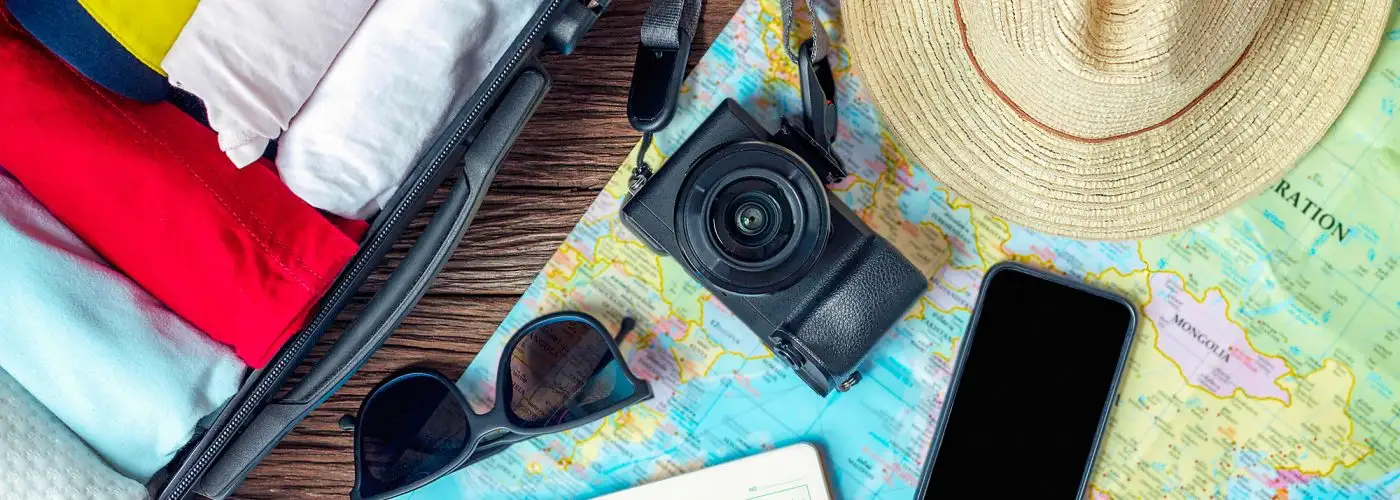
The Ultimate Packing List
Christine Sarkis
Ashley Rossi
There's a 95 percent chance Senior Editor Christine Sarkis is thinking about travel right now. Follow her on Instagram @postcartography and Twitter @ChristineSarkis .
Christine Sarkis is an SATW-award-winning journalist and executive editor at SmarterTravel. Her stories have also appeared on USA Today, Conde Nast Traveler, Huffington Post, and Business Insider. Her advice has been featured in dozens of print and online publications including The New York Times , Conde Nast Traveler , and People magazine. She has also shared travel tips on television and radio shows including Good Morning America, Marketplace, and Here & Now. Her work has been published in the anthologies Spain from a Backpack and The Best Women's Travel Writing 2008 . She is currently working on a travel memoir.
The Handy Item I Always Pack : The Trtl Pillow . It's easy to pack and comfortable, and makes it so I can actually sleep on flights.
Ultimate Bucket List Experience : Seeing the Aurora Borealis from the comfort of somewhere warm, like a glass igloo or hot spring.
Travel Motto : Curiosity is an amazing compass.
Aisle, Window, or Middle Seat : Aisle all the way.
Email Christine Sarkis at [email protected] .
Ashley Rossi is always ready for her next trip. Follow her on Twitter and Instagram for travel tips, destination ideas, and off the beaten path spots.
After interning at SmarterTravel, Ashley joined the team full time in 2015. She's lived on three continents, but still never knows where her next adventure will take her. She's always searching for upcoming destination hotspots, secluded retreats, and hidden gems to share with the world.
Ashley's stories have been featured online on USA Today, Business Insider, TripAdvisor, Huffington Post, Jetsetter, and Yahoo! Travel, as well as other publications.
The Handy Item I Always Pack : "A reusable filtered water bottle—it saves you money, keeps you hydrated, and eliminates waste—win-win."
Ultimate Bucket List Experience : "A week in a bamboo beach hut on India's Andaman Islands."
Travel Motto : "Travel light, often, and in good company."
Aisle, Window, or Middle Seat : "Window—best view in the house."
Travel Smarter! Sign up for our free newsletter.
Packing mishaps range from inconvenient (heading to the Caribbean without a swimsuit) to disastrous (discovering you left the country without your wallet), but most are preventable. We’ve created this ultimate packing list to help you pack well every time.
The Ultimate Packing Checklist
To see the ultimate packing list, scroll down the page or click here for an editable PDF version that you can save or print out. To customize the list, simply download or print it, then edit for your specific needs. You can also download the editable, mobile-friendly checklist here .
Clothes to Pack
- Dress Shirts
- Casual Shirts
- Sweatshirts
- Laundry Kit
- Leisure Shoes
- Hiking Boots
- Dress Shoes
- Collapsible Tote
Shop Our Clothing Packing List
Toiletries to Pack
- Dental Floss
- Conditioner
- Styling Tools
- Facial Cleanser
- Face Lotion
- Moisturizer
- Contact Lenses
- Contact Solution
- Shaving Supplies
- Makeup Remover
- Menstrual Products
- Birth Control/Medication
- Nail Clippers
- Hand Sanitizer
- First-Aid Ointment
- Insect Repellent
- Pain Relievers
Shop Our Toiletries Packing List
Miscellaneous Items
- Laptop/Tablet
- Film/Memory Card
- List of Medications
- Banking Contacts/Information
- Electronic Chargers
- Emergency Contacts
- Copy of Passport
- Plug Adapter
Shop Our Miscellaneous Items List
What to Pack in Your Carry-on
- Books or E-Books
- Travel Blanket
- Travel Pillow
- Disinfecting Wipes
- Change of Clothes
- Empty Water Bottle
- In-Flight Medications
- Passport/Visa/ID
- Credit/ATM cards
- Insurance Cards
- Maps/Directions
Shop Our Carry-On Essentials List
Packing Tips for Clothes and Other Items
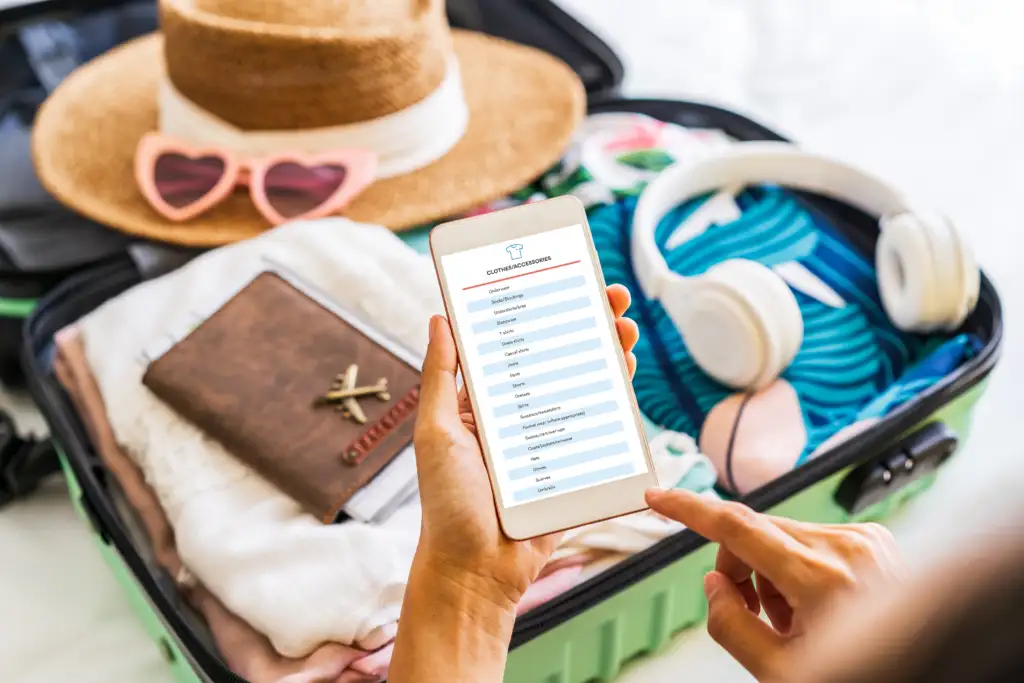
When packing for a vacation the most important things to keep in mind are the length of your trip, the weather, and any non-standard clothing or gear you might need.
Your first step when packing is to decide if you’ll be checking a bag or only taking a carry-on and then curate the amount of clothing you’ll need based on that decision. Typically, you should avoid checking a bag in situations where you have a layover since the likelihood of your bag going missing goes up with every connection . You might also want to avoid checking a bag if you absolutely need items in your bag on arrival—for example, if you’re going on a cruise.
If you’re packing more minimally, focus on packing layering clothes in more neutral colors. That’s not because we don’t like fun colors and patterns; it just means that neutral-colored clothing is more versatile, so you can wear these items more than once when you’re tight on space.
How to Pack in Just a Personal Item Sized Bag
Also invest in clothing that does double duty, like multi-use wraps , crushable hats , self-cooling and heating fabrics like merino wool layers , bug-repellent clothing , wrinkle-resistant shirts, quick-drying activewear and undergarments, casual sneakers, UPF-proof clothing , and compressible jackets … just to name a few. Look toward popular athleisure brands like Lululemon , prAna , and Athleta for comfortable yet stylish travel clothing.
When curating your packing list, you should keep in mind the length of your trip and decide on quantities from there. For a shorter trip (three to five days), you can probably manage with the following: one pair of underwear and socks per day, one pair of pajamas, one to two dressier outfits, one to two activewear or athleisure outfits, one to two casual outfits, and one to two pairs of shoes. For a longer trip (over a week), you can manage with one pair of underwear and socks per day, two pairs of pajamas, three dressier outfits, three to four casual outfits, two pairs of shoes, and two activewear or athleisure outfits.
And if you’re able to do laundry on your vacation, you can probably manage with even fewer items. Just don’t forget to pack a travel laundry kit .
Scrubba Untouched Review
Also make sure to bring along accessories like a money belt, scarf or sarong (can be used for things like an airplane blanket , coverup at the beach, or to throw over your dress on a cool evening), and a collapsible tote or day bag for any extra items you might acquire on your travels. If traveling to a city or destination that is prone to pickpocketing, make sure to pack some pickpocket-proof clothing and gear .
Depending on the type of trip you’re going on, you may need to invest in some special travel gear. We’ve tested out everything from waterproof baby carriers to interchangeable heels , so you can trust our recommendations. If you’re headed out on an organized group tour , you’ll most likely get a packing list from the tour provider, which should make your trip planning easier. If not, do your research online (one tip is to look at locations on Instagram and see what people are wearing) and consult this story for other handy lists of tips.
For more active trips, make sure you have a sturdy pair of hiking boots, quick-drying clothing, a day pack, snacks, and any necessary equipment. Check out our specific packing lists for hiking trips and camping trips .
The 5 Most Crowded National Parks (and Where to Go Instead)
Another type of trip that you may need to pack slightly specific items for is a cruise . Make sure you pack non-standard items like seasickness remedies, formal wear, dress shoes, and your bathing suit. Beach vacations also require different items like water shoes, towels, sunscreen, and maybe even snorkel gear. Luckily for you, we also have a specific cruise packing list and a beach vacation packing list .
Lastly, you need to consider the weather. For warm-weather destinations like jungles and Caribbean islands, you can obviously skip the coats and gloves, but if you’re headed out on a ski vacation then you’ll need a whole slew of things like goggles, a neck gaiter, snow boots, and more. But don’t worry, we’ve got you covered with a specific Caribbean vacation packing list , a Mexico vacation packing list , and even a ski trip packing list .
The Best Ski Hotels in the US
To help keep things organized, we love using packing cubes and/or compression sacks. They’re especially useful for when you’re traveling to multiple destinations in one trip.
Wondering how to pack all of your items? Enter the great debate of the rolling vs. folding method! While this is definitely a personal preference, we put two editors to the test to find out which method is in fact, more space-saving. Watch the video below to see the answer.
How to Pack Toiletries and Medications
Whether it’s important medication or your favorite lipstick, forgetting any type of toiletry can range from being mildly inconvenient to becoming a serious problem. For toiletries, make sure to pack your essentials, like medication, contacts, and any other items that you might not be able to purchase or replace during your travels. (Put them in your carry-on bag, not your checked suitcase.) However, if you forget items like a toothbrush or razor, you can typically call the front desk at the hotel for a spare.
We also recommend traveling with some type of a travel first-aid kit , which includes items like tweezers, first-aid ointment, bandages, travel-sized hand sanitizer, sunscreen, and insect repellent. Make sure to check TSA guidelines if you’re traveling with medication , as well as the policies and regulations at your destination.
Packing Tips for Everything Else …
Traveling without tech items like your phone, laptop, tablet, or camera can be a major bummer. For those traveling abroad, you’ll also want to remember to pack electronic adapters and converters . Other tech-related items for photographers to pack are a sturdy camera bag , backup batteries, and memory cards, as well as lens cleaner. And don’t forget smartphone essentials like a backup charger, waterproof case if you’re headed out on the water, and a phone stand or tripod for photos.
A travel packing tip we’ve learned the hard way? Travel with a copy of your passport, credit card, and bank contacts, as well as a list of medications and your emergency contacts.
If you are traveling abroad, we have an entire checklist for you, but the most important thing to note here is your passport and visas . Make sure that your passport is up to date, has as least six months of validity, and has enough blank pages for any stamps. Another tip for international travel? Give yourself plenty of time to apply for any visas that you might need and to arrange for a visit to a travel clinic if any special medications or vaccines are needed. You should also familiarize yourself with any remaining COVID-19 travel restrictions at your destination.
There are also some items that you may not think to pack, but should, like an electronic tracker , duct tape , toilet paper, a decoy wallet, or a whistle.
The 10 Best Expandable Suitcases
What to Always Pack in Your Carry-on Bag
In case you’re separated from your checked bag or other items, you should always make sure that you have your ID, wallet, house keys, medications, valuables, camera, phone, laptop, tablet, pen, cash and cards, glasses, and copy of your itinerary with you on the plane.
Other items that you might want to have handy with you include entertainment for your flight, comfort-promoting items like a blanket or pillow, as well as an empty water bottle to fill up post-security (here is a list of our favorites ), a change of clothes (just in case your luggage is lost or delayed), snacks, and gum.
If you’re looking to pack carry-on only, you guessed it: We also have a separate packing list and tips for that, as well as the best bags to use for carry-on only .
What to Pack to Stay Healthy While Traveling
The pandemic has significantly changed the way we travel and, by extension, the items we prioritize in our luggage. While many destinations have loosened or entirely lifted COVID-19 restrictions, some venues and events may still require a mask or proof of vaccination/negative COVID test to enter. Plan ahead to see if any activities on your itinerary have restrictions in place.
Sanitizing wipes and hand sanitizer , while always a good idea to have on hand at the airport , have become absolute carry-on musts. Wiping down areas like your tray table, airplane seat armrest, and hotel television remote can spare you from a variety of common travel bugs.
Editor’s note: This story was originally published in 2013. It has been updated to reflect the most current information. Ashley Rossi contributed to this story.
All of the products featured in this story were hand-selected by our travel editors. Some of the links featured in this story are affiliate links, and SmarterTravel may collect a commission (at no cost to you) if you shop through them.
You Might Also Like:
We hand-pick everything we recommend and select items through testing and reviews. Some products are sent to us free of charge with no incentive to offer a favorable review. We offer our unbiased opinions and do not accept compensation to review products. All items are in stock and prices are accurate at the time of publication. If you buy something through our links, we may earn a commission.
Top Fares From

Don't see a fare you like? View all flight deals from your city.
Today's top travel deals.
Brought to you by ShermansTravel
Greece: 9-Nt, Upscale Athens, Mykonos, Santorini...
Infinity Worldwide Vacations

5-Star, All-Inclusive Exploration Small-Ship Cruises w/Up...
Swan Hellenic

Ohio: Daily Car Rentals from Cincinnati

Trending on SmarterTravel

Best Lightweight Packing Cubes to Organize Travel Necessities
Shop on Backcountry
Shop on Amazon
Shop on REI
Best overall packing cube
Eagle creek pack-it isolate cube.
- Two-sided packing cube
- Anti-odor properties
- Machine-washable and water-resistant
- Lifetime manufacturer’s warranty
- Less-structured shape than some
One of the conundrums of travel is separating dirty clothes from clean. The Eagle Creek Isolate Cube is one of the best packing cubes for travel because it has an internal divider that allows you to sort the contents: One side is designed to breathe (and let odors out), and the other side protects clean clothes from the transfer of the not-so-fresh scent of dirty laundry. The fabric's anti-microbial treatment helps eliminate pesky smells from lingering after you unpack.
Shop on Macy's
Shop on Samsonite
Best budget packing cube
Samsonite compression packing bags.
- A steal at $20
- Airtight and watertight
- Can also be used to store out-of-season clothes in your closet
- Might overly compress items and make bags heavier than expected
- Requires a vacuum to re-pack compactly
If you're looking for a way to save some cash on your travel accessories and pack up to twice as much on your next trip, look no further than these compression packing bags from Samsonite . They serve the same purpose as packing cubes when it comes to organizing luggage but can be compacted down, thanks to a design that lets you use a vacuum to remove the air from around clothing. Get them in a well-priced 12-pack that includes four sizes: pouch, carry-on, checked-suitcase and large packing-cube size.
Shop on Luggage Online
Best see-through packing cube
Eagle creek pack-it reveal cube.
- Mesh design for visibility and breathability
- Available in three colors
- Less structured shape than some
Eagle Creek makes our list twice because this brand is one of the originators of the packing cube concept. The Eagle Creek Reveal Cube features a mesh window on one side, so you can eyeball what's packed inside without unzipping. It also allows air to circulate. You might not remember which cube has toiletries and which has your favorite pajamas , so this option gets rid of the guessing game.
Shop on Osprey
Best lightweight packing cube
Osprey ultralight packing cube set.
- Lightweight fabric design
- Convenient double zipper pullers
- J-zip design only opens on two sides
Even if you're not schlepping your bags across continents, keeping bags as lightweight as possible just makes sense. You never know if you'll have to rush through the airport or need assistance with placing your carry-on in the overhead bin. That's why the Osprey Ultralight cube set is a solid choice: Each cube weighs less than 3 ounces.
Shop on Roam
Best luxury packing cube
Roam luggage packing pods.
- Customized design for different packing needs
- Lifetime warranty
- 100-day free trial
- Pricier than most packing cubes
These modular packing pods by Roam have many thoughtful design elements that make them well worth their higher-than-most price tag. The set of four includes multiple pods: one that's waterproof for toiletry storage, one fleece-lined with pockets for jewelry and two standard cubes for clothing. You can also pick among three color options.
Shop on Bagsmart
Shop on Walmart
Best packing cubes for weekends
Bagsmart expandable packing cubes.
- Some options available in a six-piece set
- I.D. tag pocket for easy organization
- Waterproof fabric
- Two-way zipper
- 4,300 Amazon ratings and a 4.6-star average
- Stitching is a bit unbalanced
This set of Bagsmart packing cubes let you pack more with less space. The double zippers expand to fit your clothes, socks and undergarments, then compress down to save space. Use these for a weekend camping trip or short flight when space is as a premium.
Verified purchaser Hunter Antal writes, "As someone who is a big-time overpacker, I've genuinely lost sleep over how I was going to make it work. Cue compression packing cubes! I'm genuinely very impressed by the quality of both the zippers and the cubes themselves."
What to consider when buying packing cubes
When you're deciding on the best packing cubes to buy, consider things like material, zippers and construction. Some people like lightweight fabric when every ounce counts, while others prefer something sturdier that keeps clothes neatly folded and organized throughout a trip. If long-term durability is a top concern, you probably want to stick with tried-and-true brands that are known for their quality.
Types of packing cubes
- Lightweight packing cubes: Lightweight fabric minimizes weight in your luggage.
- Compression packing cubes: These compress the contents via an extra zipper or the use of a vacuum, which saves space in your luggage.
- Waterproof packing cubes: These protect your belongings from moisture.
- Mesh packing cubes: A mesh front panel lets you see the contents without having to open the cube.
- Cubes with multiple compartments: These offer more opportunities for organization with separated internal spaces.
Why you should trust us
I have been a writer for many years and covered a wide range of topics. I love to help my readers by providing answers and solutions to life's complicated questions. I have also been published in Wired, Parade, Bon Appétit, Self, The Independent, Women’s Health, HuffPost and Insider.
How we found the best packing cubes
Neatly packing your suitcase can set you up for a great trip. As shopping experts, we made sure to find the best packing cubes available. We start with the research and reporting basics—what the packing cubes are made of, what they look like and how much they cost—to ensure that we're only recommending the buys worth your time and money. Then, we research the features that speak to the packing cube's quality (such as the seams and zippers), taking advice from industry insiders and category experts on what makes a product a smart value (or worthy of a splurge). Finally, we comb through user reviews to see how real people interact with these packing cubes and if they stand up to real-life use during travel.
Are packing cubes worth it?
Packing cubes are worth it because they provide more options than single-compartment packing and can suit any budget. They keep clothes organized so you can quickly locate socks and t-shirts when you unpack. Frequent travelers swear by packing cubes to save suitcase space.
How to use packing cubes?
Use packing cubes to organize your belongings and to save space. Organize by color, style, occasion, clothing type—whatever makes the most sense to you and your needs.
How many packing cubes do I need?
The number of cubes you need depends on the trip and your packing style. Spread out everything on your packing list so you can see what you have to determine how many cubes to get. You can also take measurements inside your suitcase, backpack or duffel and buy cubes that fit snugly in your bag.
Do packing cubes wrinkle clothes?
Any time clothes are packed tightly, they risk wrinkling, though most users report that clothes get less wrinkled in cubes. You can try the clothes rolling method or pack Downy Wrinkle Releaser to smooth and freshen up your clothes when you reach your destination.
The post Best Lightweight Packing Cubes to Organize Travel Necessities appeared first on Reader's Digest .
This article may contain affiliate links that Microsoft and/or the publisher may receive a commission from if you buy a product or service through those links.


IMAGES
VIDEO
COMMENTS
Left pocket - Sunglasses, pens (2x), and Prometheus flashlight. Right pocket - Cables, chargers, adapters, headphones, memory cards (4x) Bottom compartment - Rain jacket, Wool Buff, and sleep mask. The best travel backpacks allow you to keep the most frequently used items in the most accessible locations.
Ultralight Travel Guidelines. One Bag: You only need one carry-on sized backpack. 45L is the max size that most budget airlines will allow but experienced one-baggers opt for around 22L-40L. Keep Weight Down: 22lbs (10kg) is the max carry-on weight for most budget airlines. However, 22lbs is kind of heavy for a small backpack so we suggest keeping your load to around 15lbs.
Ultimate ultralight travel packing list. March 28, 2013 - by SnarkyNomad. Quite a few times I've heard backpackers complain about weight limits or maximum bag allowances on airlines. They haul 40-pound monstrosities that limit how comfortable they are, how fast they can run to catch the train, and how often they have to take a taxi because ...
Written by Brooke. I run the show at Her Packing List and love packing ultralight. In fact, I once traveled for 3 entire weeks with just the contents of a well-packed 12L handbag. When I'm not obsessing over luggage weight, I'm planning adventures or just snuggling with my pet rabbit, Sherlock Bunz.
This setup includes everything on my minimalist packing list except for my laptop, keyboard, mouse, carrying case, and cold-weather clothing. I can travel in mild-to-warm climates and take professional-quality photos and videos with this setup. No Camera Gear (Four Season) Weight of Backpack: 16.1 lb | 7.2 kg.
For hikers, ultralight traditionally means keeping your base weight below 10 pounds (about 4.5 kilos). For travel, we generally need a bit more gear. Mostly clothing. Most airlines allow up to a 22 pound (10 kilos) bags as a carry-on. The bag must measure less than 45 linear inches (115 centimeters).
Rules for minimalist travel. You can pack light by following a few simple principles: 1. Pack the must-haves, not the nice-to-haves. If you're in any way nervous about your trip, you can quickly end up packing ever more things just because 'more stuff' feels somehow comforting. But resist this urge to be overprepared!
A cornerstone of ultralight travel is expert-level organization. The most common approaches to packing include folding, rolling, and compressing, which involves placing folded clothing in a sturdy ...
Regardless of the length of your journey, embracing a minimalist approach and packing smartly with this ultralight travel packing list and tips will enhance your travel experience. Less stuff, lighter gear, and a minimalist travel mindset will make your adventures more memorable. Have an amazing next trip! 🌎 ️
Most of the tents listed below are one-person models, but a few popular two-person shelters, such as the Zpacks Duplex and Big Agnes Fly Creek, have also been included. Ultralight trekking pole tents by budget: Low: Six Moon Designs Lunar Solo (26 oz) Durston X-Mid (31 oz)*. Medium: Gossamer Gear The One (18 oz)
Optimize your hiking. Equal parts backpacking food and ultralight gear. Get epic tips, guides and how-to's in your inbox every two weeks. Nothing more. The Ultimate Ultralight Backpacking Gear List and FAQs for the Gram Counters. Base Weight: 8.07 lbs · Consumables: 7 lbs · Worn Weight: 2.99 lbs.
What to Pack for Ultralight Travel - 17 Essentials. 1. Packing Cubes. Packing cubes are the ultimate lifesaver when it comes to packing light. They not only save room in your suitcase but they also compartmentalize your belongings so you know exactly where everything is.
In terms of warmth-to-weight, the Plasma 1000 down jacket is second-to-none. By utilizing insanely efficient 1000-fill down as an insulator, Montbell has raised the bar for all premium ultralight down jackets. Gear nerds, rejoice, as it simply doesn't get better than this. Weight: 8.8 oz | 250 grams.
Welcome to The Packable Life Hey, I'm Noel! I'm a minimalist traveler, ultralight backpacker, and camper van dweller who believes the right gear and packing list can elevate life on the go. I pack as little as possible and believe that mobility is freedom. In 2017, I quit my restaurant job to travel to far flung destinations, backpack scenic trails, and cruise around in my camper van.
Depends on your preference. PRICE RANGE: $200-$800. LOOK FOR: Ultralight, small pack size, suitable size for number of people, suitable for climate. OUR PICK: Nemo Dagger 2P Ultralight Tent. LEARN MORE: Best Backpacking Tents of the Year >>. 3.
When choosing snacks for your ultralight travel packing list, opt for lightweight options that are easy to pack and won't take up too much space in your bag. Granola bars, trail mix, and dried fruit are all excellent choices. They provide a good balance of carbohydrates, protein, and healthy fats to keep you going throughout the day. ...
On Packing Light: The Complete One-Bag Packing List. A one-bag packing list designed for indefinite travel across multiple climates and locations. This page covers my complete minimalist, one-bag packing list. I'll share my thoughts, gear recommendations, and why it's always better to travel with just a small backpack.
May 22, 2024. By Ben Kirkland. Thinking Ultralight: A Beginners Guide on UL Packing. Ultralight backpacking is an approach to hiking and camping that emphasizes carrying the lightest and simplest gear safely possible. This philosophy extends beyond merely reducing pack weight—it's about enhancing the freedom and joy of your hiking experience.
Ultralight Travel Packing List: 10 Countries, One 7kg Bag. I've been bouncing around Asia and the Indian subcontinent for almost two years now, with a pack that weighs in at 15 pounds (7kg). This minimalist travel setup has served me well through monsoon season, snow and ice, storms, jungles, mountains and deserts alike.
**To see my ULTRALIGHT PACKING LIST, visit: https://herpackinglist.com/ultralightThis is how I packed my handbag with all the things necessary for 3 weeks o...
About Her Packing List. The best travel gear and ultralight packing advice for women. Get all of your ultimate packing checklists, gear guides, and trip prep tips in ONE place! Carry-on-only, minimalist, personal-item-only packing for solo, group, and backpacking adventures.
Bring a mix of short-sleeved and long-sleeved shirts or blouses. Shirts with long sleeves that roll up easily can double as short-sleeved. Look for a wrinkle-camouflaging pattern or fabric. Synthetic-blend fabrics (such as Coolmax or microfiber) usually dry overnight. Lightweight, light-colored clothes are more comfortable in very hot weather.
After years of traveling across Europe, and around the world for that matter, I have created this ultimate minimalist packing list for females! This guide has been fully designed to ensure women can travel minimally and with less effort, so I have included an ultralight travel packing list as well as an overnight travel packing list and a long-term travel packing list!
For a longer trip (over a week), you can manage with one pair of underwear and socks per day, two pairs of pajamas, three dressier outfits, three to four casual outfits, two pairs of shoes, and ...
The Ultimate Beach Vacation Packing List. Sunscreen's a given, but it's not the only necessity. By Madison Flager and Meaghan Kenny. May 21, 2024. Brandon Cormier/Unsplash. All products featured ...
Samsonite Compression Packing Bags© via merchant. Eagle Creek Pack It Reveal Cube© via merchant. Osprey Ultralight Packing Cube Set© via merchant. Roam Luggage Packing Pods© via merchant ...